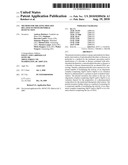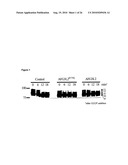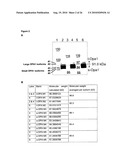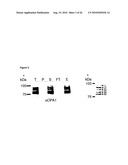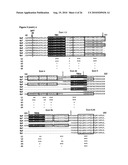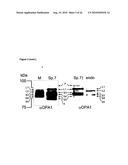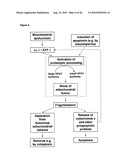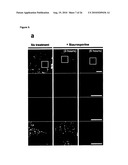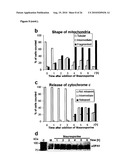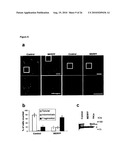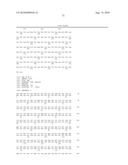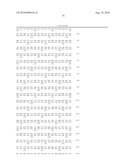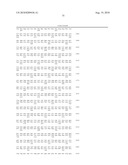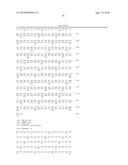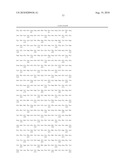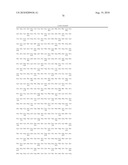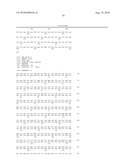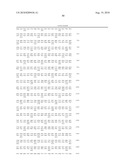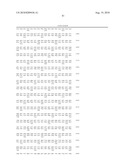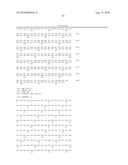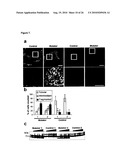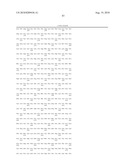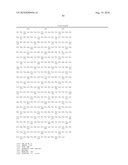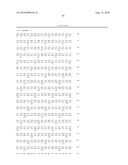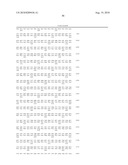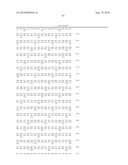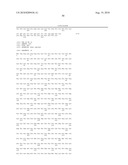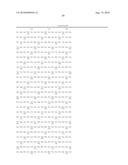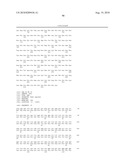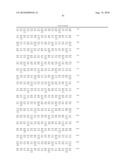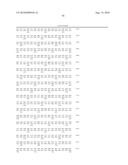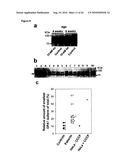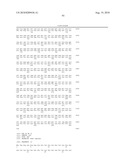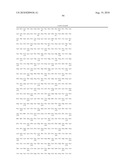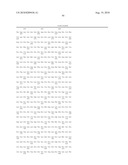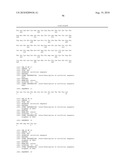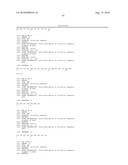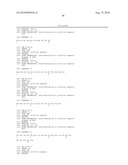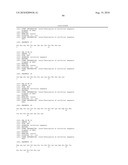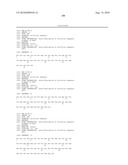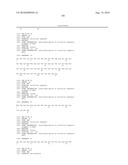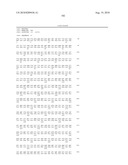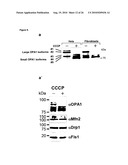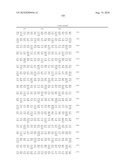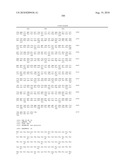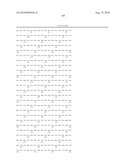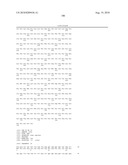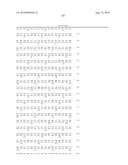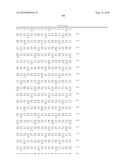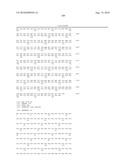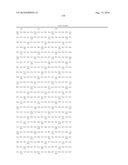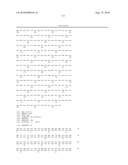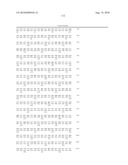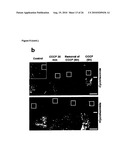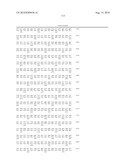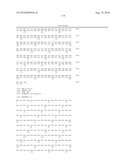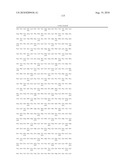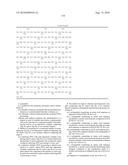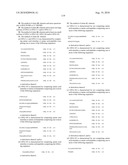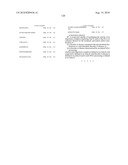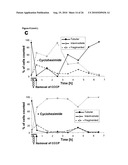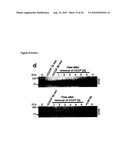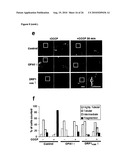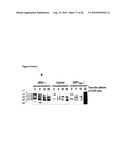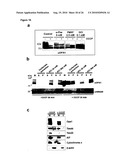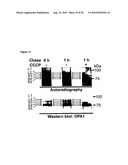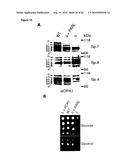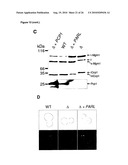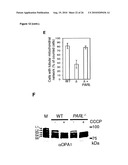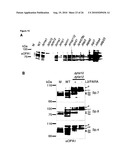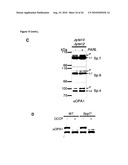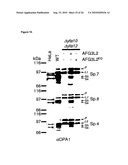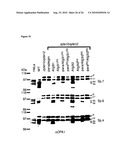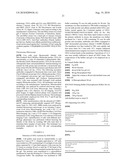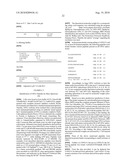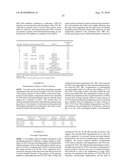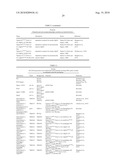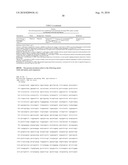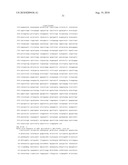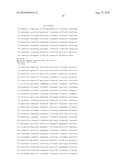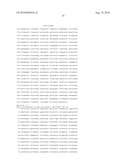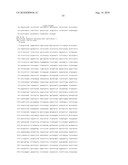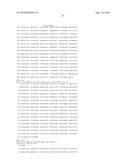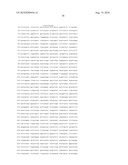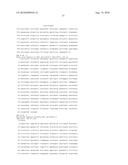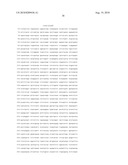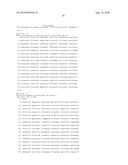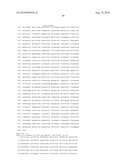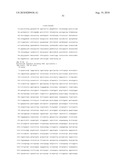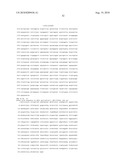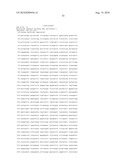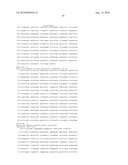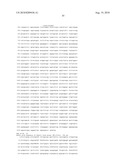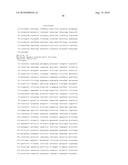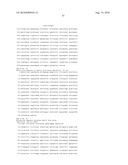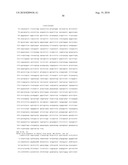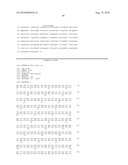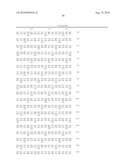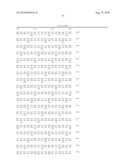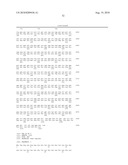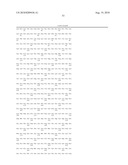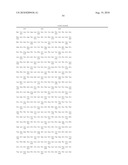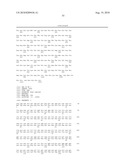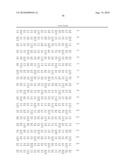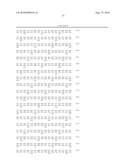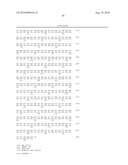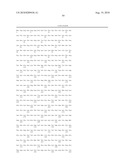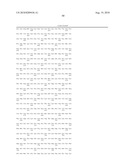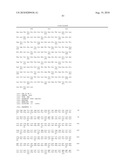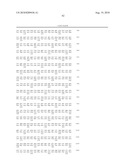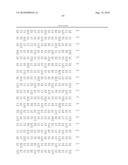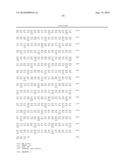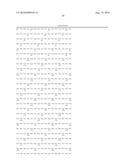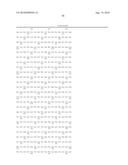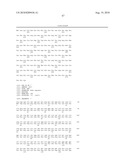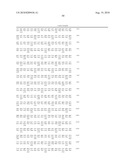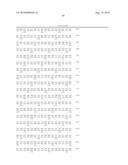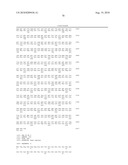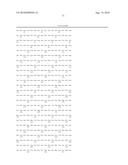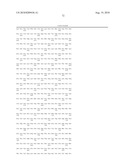Patent application title: METHOD FOR TREATING DISEASES RELATED TO MITOCHONDRIAL DYSFUNCTION
Inventors:
Andreas Reichert (Frankfurt Am Main, DE)
Stéphane Duvezin-Caubet (Pessac, FR)
Stéphane Duvezin-Caubet (Pessac, FR)
Johannes Wagener (Munchen, DE)
Michael Zick (Germering, DE)
Thomas Langer (Koln, DE)
Mirko Koppen (Koln, DE)
Walter Neupert (Germering, DE)
IPC8 Class: AA61K39395FI
USPC Class:
4241721
Class name: Drug, bio-affecting and body treating compositions immunoglobulin, antiserum, antibody, or antibody fragment, except conjugate or complex of the same with nonimmunoglobulin material binds eukaryotic cell or component thereof or substance produced by said eukaryotic cell (e.g., honey, etc.)
Publication date: 2010-08-19
Patent application number: 20100209436
Claims:
1. (canceled)
2. A method for the treatment, prevention and/or amelioration of(i) a disorder or disease correlated with mitochondrial dysfunction or a mitochondrial disorder or disease; or(ii) a disorder or disease characterized by an altered OPA1 processing,wherein said method comprises the administration to a patient in need of medical intervention a pharmaceutically active amount of a compound capable of modulating the activity of an oligomeric complex comprising Afg 3l1 and/or Afg 3l2 or (a) variant(s) thereof.
3. Method of screening for a compound capable of modulating the activity of an oligomeric complex comprising Afg 3l1 and/or Afg 3l2 or (a) variant(s) thereof comprising the steps of(a) contacting OPA1 with said oligomeric complex comprising Afg 3l1 and/or Afg 3l2 or (a) variant(s) thereof in the presence of said compound to be screened for under conditions allowing OPA1 processing to occur; and(b) evaluation whether OPA1 processing is altered compared to a control, where OPA1 and said oligomeric complex comprising Afg 3l1 and/or Afg 3l2 or (a) variant(s) thereof are contacted in the absence of said compound to be screened for under conditions allowing OPA 1 processing to occur.
4. The method of claim 2, wherein said oligomeric complex comprising Afg 3l1 and/or Afg 3l2 or (a) variant(s) thereof comprises a polypeptide selected from the group consisting of:(a) a polypeptide comprising an amino acid sequence as depicted in SEQ ID NO 38, 40 or 42;(b) a polypeptide comprising an amino acid sequence encoded by a nucleic acid molecule as depicted in SEQ ID NO 37, 39 or 41;(c) a polypeptide comprising an amino acid sequence encoded by a nucleic acid molecule encoding an amino acid sequence as depicted in SEQ ID NO 38, 40 or 42;(d) a polypeptide comprising an amino acid sequence having at least 50% sequence identity to the polypeptide of any one of (a) to (c);(e) a polypeptide comprising an amino acid sequence encoded by a nucleic acid molecule having at least 50% sequence identity to the nucleic acid molecule as defined in any one of (b) to (c);(f) a polypeptide comprising an amino acid sequence encoded by a nucleic acid molecule hybridizing under stringent conditions to the complement stand of a nucleic acid molecule as defined in any one of (b) to (c); and(g) fragment of a polypeptide of any one of (b) to (f).
5. The method of claim 2, wherein said oligomeric complex comprising Afg 3l1 and/or Afg 3l2 or (a) variant(s) thereof is a homo-oligomeric complex or a hetero-oligomeric complex.
6. The method of claim 5, wherein said hetero-oligomeric complex comprises paraplegin or a variant thereof.
7. The method of claim 2, wherein said compound capable of modulating the activity of an oligomeric complex comprising Afg 3l1 and/or Afg 3l2 or (a) variant(s) thereof is a compound obtained by a method comprising the steps of(a) contacting OPA1 with said oligomeric complex comprising Afg 3l1 and/or Afg 3l2 or (a) variant(s) thereof in the presence of said compound to be screened for under conditions allowing OPA1 processing to occur; and(b) evaluation whether OPA1 processing is altered compared to a control, where OPA1 and said oligomeric complex comprising Afg 3l1 and/or Afg 3l2 or (a) variant(s) thereof are contacted in the absence of said compound to be screened for under conditions allowing OPA1 processing to occur.
8. The method of claim 2, wherein said compound capable of modulating the activity of an oligomeric complex comprising Afg 3l1 and/or Afg 3l2 or (a) variant(s) thereof is or comprises an agonist or antagonist of the activity of an oligomeric complex comprising Afg 3l1 and/or Afg 3l2 or (a) variant(s) thereof.
9. The method of claim 2, wherein said compound capable of modulating the activity of an oligomeric complex comprising Afg 3l1 and/or Afg 3l2 or (a) variant(s) thereof is or comprises an agonist or antagonist of the activity of an oligomeric complex comprising Afg 3l1 and/or Afg 3l2 or (a) variant(s) thereof, wherein said antagonist is a molecule selected from the group consisting of:(a) a binding molecule that binds to/interacts with the oligomeric complex comprising Afg 3l1 and/or Afg 3l2 or (a) variant(s) thereof as defined in claim or binds to/interacts with a nucleic acid molecule encoding ((a) subunit(s) of) the oligomeric complex comprising Afg 3l1 and/or Afg 3l2 or (a) variant(s) thereof as defined in claim 2;(b) a nucleic acid molecule capable of introducing an insertion of a heterologous sequence or a mutation into a nucleic acid molecule encoding ((a) subunit(s) of) the oligomeric complex comprising Afg 3l1 and/or Afg 3l2 or (a) variant(s) thereof as defined in claim 2 via in vivo mutagenesis;(c) a nucleic acid molecule capable of reducing the expression of mRNA encoding ((a) subunit(s) of) the oligomeric complex comprising Afg 3l1 and/or Afg 3l2 or (a) variant(s) thereof as defined in claim 2 by cosuppression; and(d) a low molecular weight compound or a small molecule.
10. The method of claim 9, wherein said binding molecule is selected form the group consisting of antibodies, affybodies, trinectins, anticalins, aptamers, PNA, DNA or RNA.
11. The method of claim 2, wherein said compound capable of modulating the activity of an oligomeric complex comprising Afg 3l1 and/or Afg 3l2 or (a) variant(s) thereof is or comprises an agonist or antagonist of the activity of an oligomeric complex comprising Afg 3l1 and/or Afg 3l2 or (a) variant(s) thereof, wherein said antagonist is a molecule selected from the group consisting of:(A) a binding molecule that binds to/interacts with the oligomeric complex comprising Afg 3l1 and/or Afg 3l2 or (a) variant(s) thereof as defined in claim 2 or binds to/interacts with a nucleic acid molecule encoding ((a) subunit(s) of) the oligomeric complex comprising Afg 3l1 and/or Afg 3l2 or (a) variant(s) thereof as defined in claim 2;(B) a nucleic acid molecule capable of introducing an insertion of a heterologous sequence or a mutation into a nucleic acid molecule encoding ((a) subunit(s) of) the oligomeric complex comprising Afg 3l1 and/or Afg 3l2 or (a) variant(s) thereof as defined in claim 2 via in vivo mutagenesis;(C) a nucleic acid molecule capable of reducing the expression of mRNA encoding ((a) subunit(s) of) the oligomeric complex comprising Afg 3l1 and/or Afg 3l2 or (a) variant(s) thereof as defined in claim 2 by cosuppression; and(D) a low molecular weight compound or a small molecule,wherein said binding molecule is selected from the group consisting of:(i) an antibody that binds to the polypeptide or the nucleic acid molecule selected from the group consisting of:(a) a polypeptide comprising an amino acid sequence as depicted in SEQ ID NO 38, 40 or 42;(b) a polypeptide comprising an amino acid sequence encoded by a nucleic acid molecule as depicted in SEQ ID NO 37, 39 or 41;(c) a polypeptide comprising an amino acid sequence encoded by a nucleic acid molecule encoding an amino acid sequence as depicted in SEQ ID NO 38, 40 or 42;(d) a polypeptide comprising an amino acid sequence having at least 50% sequence identity to the polypeptide of any one of (a) to (c);(e) a polypeptide comprising an amino acid sequence encoded by a nucleic acid molecule having at least 50% sequence identity to the nucleic acid molecule as defined in any one of (b) to (c);(f) a polypeptide comprising an amino acid sequence encoded by a nucleic acid molecule hybridizing under stringent conditions to the complement stand of a nucleic acid molecule as defined in any one of (b) to (c); and(g) fragment of a polypeptide of any one of (b) to (f).or to ((a) subunit(s) of) the oligomeric complex comprising Afg 3l1 and/or Afg 3l2 or (a) variant(s) thereof as defined in claim 2;(ii) an antisense nucleotide sequence that hybridizes to the nucleic acid molecule as defined in (i);(iii) a siRNA that interacts with the nucleic acid molecule as defined in (i);(iv) an aptamer that binds to the polypeptide or the nucleic acid molecule as defined in (i) or to ((a) subunit(s) of) the oligomeric complex comprising Afg 3l1 and/or Afg 3l2 or (a) variant(s) thereof as defined in claim 2; and(v) ribozyme that interacts with the nucleic acid molecule as defined in (i).
12. The method of claim 2, wherein said compound capable of modulating the activity of an oligomeric complex comprising Afg 3l1 and/or Afg 3l2 or (a) variant(s) thereof is or comprises an agonist or antagonist of the activity of an oligomeric complex comprising Afg 3l1 and/or Afg 3l2 or (a) variant(s) thereof, wherein said agonist is a molecule selected from the group consisting of:(A) a polypeptide as defined in (a)-(g) or a nucleotide sequence comprising a nucleic acid molecule as defined in (a)-(g);(a) a polypeptide comprising an amino acid sequence as depicted in SEQ ID NO 38, 40 or 42;(b) a polypeptide comprising an amino acid sequence encoded by a nucleic acid molecule as depicted in SEQ ID NO 37, 39 or 41;(c) a polypeptide comprising an amino acid sequence encoded by a nucleic acid molecule encoding an amino acid sequence as depicted in SEQ ID NO 38, 40 or 42;(d) a polypeptide comprising an amino acid sequence having at least 50% sequence identity to the polypeptide of any one of (a) to (c);(e) a polypeptide comprising an amino acid sequence encoded by a nucleic acid molecule having at least 50% sequence identity to the nucleic acid molecule as defined in any one of (b) to (c);(f) a polypeptide comprising an amino acid sequence encoded by a nucleic acid molecule hybridizing under stringent conditions to the complement stand of a nucleic acid molecule as defined in any one of (b) to (c); and(g) fragment of a polypeptide of any one of (b) to (f),(B) a binding molecule as defined in any one of claims 9, 10 and 11 (a) and (d) being an agonistic binding molecule; and(C) a low molecular weight compound or a small molecule.
13. The method of claim 2, wherein said activity of an oligomeric complex comprising Afg 3l1 and/or Afg 3l2 or (a) variant(s) thereof is a protease activity.
14. The method of claim 2, wherein said activity of an oligomeric complex comprising Afg 3l1 and/or Afg 3l2 or (a) variant(s) thereof is an m-AAA protease activity.
15. The method of claim 2, wherein said activity of an oligomeric complex comprising Afg 3l1 and/or Afg 3l2 or (a) variant(s) thereof is proteolytic cleavage of OPA1.
16. The method of claim 15, wherein said proteolytic cleavage of OPA1 leads to OPA1 processing.
17. The method of claim 2, wherein said OPA1 processing is characterized by (a decrease of) a certain amount of at least one large isoform of OPA1, (an increase of) a certain amount of at least one small isoform of OPA1 and/or (a decrease of) a certain ratio of at least one large versus at least one small isoform of OPA1 (compared to a control/standard).
18. The method of claim 2, wherein said altered OPA1 processing is characterized by an altered (decrease of a) certain amount of at least one large isoform of OPA1, an altered (increase of a) certain amount of at least one small isoform of OPA1 and/or an altered (decrease of a) certain ratio of at least one large versus at least one small isoform of OPA1 compared to a control/standard.
19. The method of claim 2, wherein said disorder or disease is selected from the group consisting of premature ageing, cardiomyopathy, a respiratory chain disorder, mtDNA depletion syndrome, myoclonus epilepsy, ragged-red fibers syndrome (MERRF), myopathy encephalopathy lactic acidosis, stroke-like episodes (MELAS) and optic atrophy.
20. The method of claim 17, whereby a large isoform of OPA1 has an apparent molecular weight of more than about 91 kD and whereby a small isoform of OPA1 has an apparent molecular weight of less than about 91 kD, said molecular weights being determined by SDS-PAGE analysis; and/orwhereby a large isoform of OPA1 has an apparent molecular weight of more than about 95 kD and whereby a small isoform of OPA1 has an apparent molecular weight of less than about 95 kD, said molecular weights being determined by mass spectrometry.
21. The method of claim 17, wherein said at least one large isoform of OPA1 comprises two isoforms (OPA1-L1 and OPA1-L2) and/or wherein said at least one small isoform of OPA1 comprises three isoforms (OPA1-S3, OPA1-S4 and OPA1-S5).
22. The method of claim 21, wherein said at least one large isoform of OPA1 comprises an isoform having an apparent molecular weight of about 97 kD (OPA1-L1) or an isoform having an apparent molecular weight of about 92 kD (OPA1-L2), said molecular weights being determined by SDS-PAGE analysis.
23. The method of claim 21, wherein said at least one small isoform of OPA1 comprises an isoform having an apparent molecular weight of about 88 kD (OPA1-S3), an isoform having an apparent molecular weight of about 84 kD (OPA1-S4) or an isoform having an apparent molecular weight of about 81 kD (OPA1-S5), said molecular weights being determined by SDS-PAGE analysis.
24. The method of claim 21, wherein said at least one large isoform of OPA1 comprises an isoform having an apparent molecular weight of about 104 kD (OPA1-L1) or an isoform having an apparent molecular weight of about 99 kD (OPA1-L2), said molecular weights being determined by mass spectrometry.
25. The method of claim 21, wherein said at least one small isoform of OPA1 comprises an isoform having an apparent molecular weight of about 92 kD (OPA1-S3), an isoform having an apparent molecular weight of about 89 kD (OPA1-S4) or an isoform having an apparent molecular weight of about 87 kD (OPA1-S5), said molecular weights being determined by mass spectrometry.
26. The method of claim 21, whereinsaid OPA1-L1 has an apparent molecular weight of about 97 kD,said OPA1-L2 has an apparent molecular weight of about 92 kD,said OPA1-S3 has an apparent molecular weight of about 88 kD,said OPA1-S4 has an apparent molecular weight of about 84 kD, and/orsaid OPA1-S5 has an apparent molecular weight of about 81 kD,said molecular weights being determined by SDS-PAGE analysis; orwhereinsaid OPA1-L1 has an apparent molecular weight of about 104 kD,said OPA1-L2 has an apparent molecular weight of about 99 kD,said OPA1-S3 has an apparent molecular weight of about 92 kD,said OPA1-S4 has an apparent molecular weight of about 89 kD, and/orsaid OPA1-S5 has an apparent molecular weight of about 87 kD,said molecular weights being determined by mass spectrometry.
27. The method of claim 20, wherein said SDS-PAGE is a 10% SDS-PAGE.
28. The method of claim 20, wherein said mass spectrometry is MALDI-MS or LC-MS/MS.
29. The method of claim 20, wherein said at least one large isoform of OPA1 is OPA1-L1 and/or OPA1-L2.
30. The method of claim 18, wherein said at least one small isoform of OPA1 is OPA1-S3, OPA1-S4 and/or OPA1-S5.
31. The method of claim 21, wherein(a) OPA1-L1 and OPA1-L2 are characterized by comprising amino acid stretches or amino acid peptides comprising one or more of the following sequences: TABLE-US-00015 YLILGSAVGGGYTAK; (SEQ ID No: 17) TFDQWK; (SEQ ID No: 18) DMIPDLSEYK; (SEQ ID No: 19) WIVPDIVWEIDEYIDFEK; (SEQ ID No: 20) LAPDFDK; (SEQ ID No: 21) IVESLSLLK; (SEQ ID No: 22) ALPNSEDLVK; (SEQ ID No: 23) DFFTSGSPEETAFR; (SEQ ID No: 24) TRLLKLRYLILGS; (SEQ ID No: 25) and FWPARLATRLLKLRYLILGS (SEQ ID NO: 35)
or derivatives thereof;(b) OPA1-S3 is characterized by comprising amino acid stretches or amino acid peptides comprising one or more of the following sequences: TABLE-US-00016 IVESLSLLK; (SEQ ID No: 22) DFFTSGSPEETAFR; (SEQ ID No: 24) GLLGELILLQQQIQEHEEEAR; (SEQ ID No: 26) AAGQYSTSYAQQK; (SEQ ID No: 27) and IDQLQEELLHTQLK (SEQ ID No: 28)
or derivatives thereof;(c) OPA1-S4 is characterized by comprising amino acid stretches or amino acid peptides comprising one or more of the following sequences: TABLE-US-00017 GLLGELILLQQQIQEHEEEAR; (SEQ ID No: 26) AAGQYSTSYAQQK; (SEQ ID No: 27) and IDQLQEELLHTQLK (SEQ ID No: 28)
or derivatives thereof; and/or(d) OPA1-S5 is characterized by comprising amino acid stretches or amino acid peptides comprising the following sequence: TABLE-US-00018 IDQLQEELLHTQLK (SEQ ID No: 28)
or derivatives thereof.
32. The method of claim 21, wherein(a) OPA1-L2 is characterized by not comprising amino acid stretches or amino acid peptides comprising one or more of the following sequences: TABLE-US-00019 GLLGELILLQQQIQEHEEEAR; (SEQ ID No: 26) and AAGQYSTSYAQQK; (SEQ ID No: 27)
or derivatives thereof; and/or(b) OPA1-S3 is characterized by not comprising amino acid stretches or amino acid peptides comprising one or more of the following sequences: TABLE-US-00020 YLILGSAVGGGYTAK; (SEQ ID No: 17) TFDQWK; (SEQ ID No: 18) DMIPDLSEYK; (SEQ ID No: 19) WIVPDIVWEIDEYIDFEK; (SEQ ID No: 20) LAPDFDK; (SEQ ID No: 21) ALPNSEDLVK; (SEQ ID No: 23) FWPARLATRLLKLRYLILGS; (SEQ ID NO: 35) and TRLLKLRYLILGS (SEQ ID No: 25)
or derivatives thereof;(c) OPA1-S4 is characterized by not comprising amino acid stretches or amino acid peptides comprising one or more of the following sequences: TABLE-US-00021 YLILGSAVGGGYTAK; (SEQ ID No: 17) TFDQWK; (SEQ ID No: 18) DMIPDLSEYK; (SEQ ID No: 19) WIVPDIVWEIDEYIDFEK; (SEQ ID No: 20) LAPDFDK; (SEQ ID No: 21) IVESLSLLK; (SEQ ID No: 22) ALPNSEDLVK; (SEQ ID No: 23) DFFTSGSPEETAFR; (SEQ ID No: 24) FWPARLATRLLKLRYLILGS; (SEQ ID NO: 35) and TRLLKLRYLILGS (SEQ ID No: 25)
or derivatives thereof; and/or(d) OPA1-S5 is characterized by not comprising amino acid stretches or amino acid peptides comprising one or more of the following sequences: TABLE-US-00022 YLILGSAVGGGYTAK; (SEQ ID No: 17) TFDQWK; (SEQ ID No: 18) DMIPDLSEYK; (SEQ ID No: 19) WIVPDIVWEIDEYIDFEK; (SEQ ID No: 20) LAPDFDK; (SEQ ID No: 21) IVESLSLLK; (SEQ ID No: 22) ALPNSEDLVK; (SEQ ID No: 23) DFFTSGSPEETAFR; (SEQ ID No: 24) TRLLKLRYLILGS; (SEQ ID No: 25) GLLGELILLQQQIQEHEEEAR; (SEQ ID No: 26) and AAGQYSTSYAQQK; (SEQ ID No: 27)
or derivatives thereof.
33. A compound capable of modulating the activity of an oligomeric complex comprising Afg 3l1 and/or Afg 3l2 or (a) variant(s) thereof for the treatment, prevention and/or amelioration of(i) a disorder or disease correlated with mitochondrial dysfunction or a mitochondrial disorder or disease; or(ii) a disorder or disease characterized by an altered OPA1 processing,wherein said oligomeric complex is defined as in claim 2, said compound is defined as in claim 2, said disorder or disease is defined as in claim 2 and/or said OPA1 processing is defined as in claim 2.
Description:
[0001]The present invention relates to means and methods for therapeutic
intervention of mitochondrial disorders or diseases, in particular to a
method for the treatment, prevention and/or amelioration of a disorder or
disease correlated with mitochondrial dysfunction, a mitochondrial
disorder or disease or a disorder or disease characterized by an altered
OPA1 processing. Thereby, a pharmaceutically active amount of a compound
capable of modulating the activity of an oligomeric complex comprising
Afg3l1 and/or Afg3l2 or (a) variant(s) thereof is administered to a
patient in need of medical intervention. The present invention also
relates to the use of an oligomeric complex comprising Afg3l1 and/or
Afg3l2 or (a) variant(s) thereof for the preparation of a pharmaceutical
composition for the mentioned therapeutic intervention. The present
invention further relates to a method of screening for a compound capable
of modulating the activity of an oligomeric complex comprising Afg3l1
and/or Afg3l2 or (a) variant(s) thereof comprising the use of OPA1.
[0002]Mitochondria form large networks of interconnected tubules that are maintained by balanced fission and fusion events (Nunnari 1997 Mol Biol Cell 8, 1233-1242; Okamoto 2005 Annu Rev Genet. 39, 503-536). The morphology and ultrastructure of mitochondria depend on the tissue, on the physiological condition of the cell, and in particular on the functional status of mitochondria. Dynamic processes associated with mitochondria are apparently crucial for the cell, e.g. in apoptosis (Frank 2001 Dev Cell 1, 515-525; Karbowski 2002 J Cell Biol 159, 931-938; Lee 2004 Mol Biol Cell 15, 5001-5011; Jagasia 2005 Nature 433, 754-760). Likewise, formation of dendritic spines and synapses (Li 2004 Cell 119, 873-887; Verstreken 2005 Neuron 47, 365-378) and functional complementation of mitochondrial DNA (mtDNA) mutations by content mixing (Nakada 2001 Nat Med 7, 934-940; Ono 2001 Nat Genet. 28, 272-275) depend on dynamics of mitochondria. On the other hand, vast morphological alterations of mitochondria have been reported to occur in human disorders. Impairment of mitochondrial fusion or fission is causative of various neurodegenerative diseases such as Charcot-Marie-Tooth disease type 2A and 4A, and optic atrophy type 1 (Alexander 2000 Nat Genet. 26, 211-215; Delettre 2000 Nat Genet. 26, 207-210; Zuchner 2004 Nat Genet. 36, 449-451; Niemann 2005 J Cell Biol 170, 1067-1078). One key player in regulating dynamic changes of mitochondrial morphology is the protein OPA1 which is required for mitochondrial fusion (Olichon 2003J. Biol. Chem. 278, 7743-7746; Cipolat 2004 Proc Natl Acad Sci USA 101, 15927-15932). Mutations in the OPA1 gene cause autosomal dominant optic atrophy type I, a prevalent hereditary neuropathy of the optic nerve (Alexander loc cit; Delettre 2000 loc cit). Downregulation of OPA1 leads to fragmentation of mitochondria, mitochondrial dysfunction, altered maintenance of mtDNA, altered mitochondrial inner membrane morphology and increased propensity for apoptosis (Olichon 2003 loc cit; Griparic 2004 J Biol Chem 279, 18792-18798; Lee loc cit; Arnoult 2005 J Biol Chem 280, 35742-35750; Chen 2005 J Biol Chem 280, 26185-26192). Eight alternatively spliced mRNAs transcribed from the OPA1 gene were reported (Delettre 2001 Hum Genet. 109, 584-591; Olichon 2002 FEBS Lett 523, 171-176; Satoh 2003 Biochem Biophys Res Commun 300, 482-493) resulting in five apparent isoforms of the OPA1 protein (Delettre 2001 loc cit; Olichon 2003 loc cit; Duvezin-Caubet 2006 J Biol. Chem. 281(49):37972-9; Ishihara 2006 Embo J 25, 2966-2977; Olichon 2007 Cell Death Differ 14(4):682-92). There is evidence suggesting that OPA1 undergoes limited proteolysis. Dissipation of the mitochondrial membrane potential induces a fast and specific proteolytic conversion of larger OPA1 isoforms into smaller ones accompanied by a simultaneous fragmentation of mitochondria (Duvezin-Caubet loc cit; Ishihara loc cit). Proteolysis of OPA1 is observed in patients and in various model systems of human disorders associated with mitochondrial dysfunction (Duvezin-Caubet loc cit). It was further shown that mitochondrial dysfunction leads to OPA1 processing, inhibition of mitochondrial fusion, and therefore to segregation of damaged mitochondria from the network of intact mitochondria (Duvezin-Caubet loc cit). Thus, even of the fact that OPA1 processing apparently has a key role in regulating mitochondrial morphology, it is eventually not clear which proteases are indeed involved in this process. Apparently contradicting results have been reported in this respect, as PARL, a mitochondrial rhomboid protease, as well as paraplegin, a subunit of the m-AAA protease, were proposed to be involved in cleaving OPA1 (Cipolat 2006 Cell 126 163-175; Ishihara loc cit). PARL appears to be an obvious candidate for OPA1 processing as its ortholog, Pcp1, was shown to process the ortholog of OPA1, Mgm1, in baker's yeast (Herlan 2003 J Biol Chem 278, 27781-27788; McQuibban 2003 Nature 423, 537-541; Sesaki 2003 Biochem Biophys Res Commun 308, 276-283; Herlan 2004 J Cell Biol 165, 167-173). Deletion of PARL in Drosophila led to fragmentation of mitochondria (McQuibban 2006 Curr Biol 16, 982-989). Moreover, PARL is a critical regulator of OPA1-dependent cristae remodeling during apoptosis, a process that is accompanied by the accumulation of small amounts of a soluble form of OPA1 in the intermembrane space (Cipolat loc cit; Frezza 2006 Cell 126 177-189). Other observations, however, challenged the requirement of PARL for OPA1 processing. Deletion of PARL in mouse did not have an obvious effect on mitochondrial morphology (Cipolat loc cit). Further, cleavage of OPA1 has recently been linked to the hetero-oligomeric m-AAA protease (Ishihara loc cit), an ATP-dependent metalloprotease in the inner membrane of mitochondria (Atorino 2003 J Cell Biol 163, 777-787). Ishihara and colleagues (loc cit) observed impaired OPA1 processing in human cells upon downregulation of paraplegin, a subunit of the m-AAA protease, but not when PARL was downregulated: Notably, deletion of paraplegin is causative for axonal degeneration in hereditary spastic paraplegia (Casari 1998 Cell 93, 973-983) and leads to the accumulation of aberrant mitochondria in a paraplegin-deficient mouse model (Ferreirinha 2004 J Clin Invest 113, 231-242).
[0003]The technical problem underlying the present invention is the provision of suitable means and methods for therapeutic intervention against mitochondrial dysfunction and diseases or disorders related thereto. In particular, means and methods for the treatment, prevention and/or amelioration of mitochondrial dysfunction and diseases or disorders related thereto are of need.
[0004]The solution to the above technical problem is achieved by providing the embodiments characterized in the claims.
[0005]The present invention solves the above identified technical problem since, as documented herein below and in the appended examples, it was surprisingly found that OPA1 upon expression in yeast is cleaved by oligomeric m-AAA protease complexes comprising murine or human Afg3l1 and/or Afg3l2 subunits at high efficiencies.
[0006]Thus, in a first main aspect, the present invention relates to a method for the treatment, prevention and/or amelioration of [0007](i) a disorder or disease correlated with mitochondrial dysfunction or a mitochondrial disorder or disease; or [0008](ii) a disorder or disease characterized by an altered OPA1 processing, wherein said method comprises the administration to a patient in need of medical intervention a pharmaceutically active amount of a compound capable of (specifically) modulating the activity of an oligomeric complex comprising Afg3l1 and/or Afg3l2 or (a) variant(s) thereof.
[0009]From the prior art, it was known that PARL is able to cleave Mgm1, the yeast ortholog of OPA1 (McQuibban loc cit). Moreover, it has been suggested that a soluble OPA1 isoform generated by PARL cleavage in low amounts might be responsible for the anti-apoptotic effects of OPA1 (Cipolat loc cit). It was further demonstrated in the prior art that that OPA1 processing was weakly affected upon downregulation of the m-AAA protease subunit paraplegin in HeLa cells (Ishihara loc cit). In the same context, it was inter alia emphasized that the function of the ATPase family gene 3-like 2 (Afg3l2), a gene related to the paraplegin gene, remains unknown, since hints have been found that Afg3l2 is not involved in OPA1 processing (Ishihara loc cit).
[0010]In distinct differences to and against obvious conclusions to be drawn from the prior art, it was shown herein that the rhomboid-like protease PARL does not cleave OPA1 upon expression in yeast. Particularly, it was demonstrated that none of the OPA1 splice variants investigated was converted to smaller isoforms in the presence of proteolytically active PARL.
[0011]The main inventive merit of the present invention was the identification of a protease capable of efficiently cleaving, and therefore processing, OPA1, namely an oligomeric protease complex comprising Afg3l2 and/or Afg3l1.
[0012]As described herein and documented in the appended examples, OPA1 processing in yeast was reconstituted and in parallel the OPA1 processing process was analyzed in PARL and paraplegin-deficient mammalian cell lines for this purpose. The corresponding results demonstrate that PARL can functionally substitute for the yeast rhomboid Pcp1, consistent with an earlier report (McQuibban loc cit), but does not affect OPA1 processing. The corresponding results further demonstrate that mouse and mammalian m-AAA proteases mediate OPA1 cleavage when expressed in yeast. Thereby, it was surprisingly found that OPA1 processing can be effected by (homo-)oligomeric m-AAA proteases comprising Afg3l1 and/or Afg3l2 at high efficiency and to a lower extent by hetero-oligomeric, paraplegin-containing, m-AAA proteases
[0013]Without being bound by theory, this may be due to different substrate specificities of these different proteolytic complexes. Possibly, OPA1 cleavage by homooligomeric m-AAA proteases may rationalize efficient OPA1 processing particularly in paraplegin-deficient cell lines.
[0014]In addition to this, the present invention is, inter alia, based on the following particular findings:
[0015]Mass spectrometric characterization of OPA1 isoforms revealed their formation by alternative splicing and proteolytic processing in HeLa cells. Moreover, yeast was also established as a valid model system for the analysis of OPA1 processing. Using this system, it was particularly demonstrated that OPA1 is recognized and cleaved in the inner membrane by m-AAA proteases, particularly by (homo-)oligo-meric m-AAA protease complexes comprising Agf3l1/2.
[0016]As one particular aspect, it was found that certain OPA1 processing products are preferentially formed depending on the splice variant analyzed and on the subunit composition of the m-AAA protease. It was known that the expression of m-AAA protease subunits varies in different murine tissues (Koppen 2007 Mol Cell Biol. 27(2):758-67). Without being bound by theory, it is therefore conceivable on the basis of the teaching provided herein that hetero-oligomeric forms of m-AAA proteases are crucial for OPA1 processing in some tissues and not in others. Tissue-specific differences in the subunit composition of m-AAA protease isozymes as well as in the expression of OPA1 isoforms could explain why deficiencies in paraplegin in mouse and human do result in cell type specific mitochondrial defects.
[0017]In view of the different efficiencies of OPA1 processing by m-AAA proteases composed of different subunits, it is, without being bound by theory, conceivable that variation in the assembly of m-AAA proteases allows adjusting OPA1 processing and thereby mitochondrial dynamics to different needs in different tissues. Moreover, the m-AAA protease may play additional roles during OPA1 cleavage which cannot be carried out by, for example, PARL. The m-AAA protease is known to mediate the ATP-dependent dislocation of proteins from the membrane to allow their complete proteolysis in a hydrophilic environment (Leonhard 2000 Mol Cell 5, 629-638). Interestingly, the ATP-dependent membrane dislocation of cytochrome c peroxidase by the m-AAA protease in yeast was recently found to facilitate maturation by the rhomboid protease Pcp1 (Tatsuta 2007 Embo J 26, 325-335). However, as OPA1 is not recognized and cleaved by PARL in yeast, the results provided herein do not favor such a functional interplay between both rhomboid and AAA proteases during OPA1 processing in mammalian mitochondria. In contrast to the situation in yeast, where short forms of the OPA1 ortholog, Mgm1, are formed during biogenesis (Herlan loc cit), in mammalian cells preexisting large forms of OPA1 can be rapidly converted to small forms, e.g. upon dissipation of the membrane potential across the inner membrane (Duvezin-Caubet loc cit). The latter appears to be the consequence of a signaling pathway induced by mitochondrial dysfunction. Possibly, this mechanism has evolved only in higher organisms and depends on the m-AAA rather than the rhomboid protease as it allows for fast adaptation of mitochondrial morphology.
[0018]In view of the findings made in context of this invention, an oligomeric complex comprising Afg3l1 and/or Afg3l2 or a variant(s) thereof, as well as compound capable of (specifically) modulating the activity thereof, are particularly promising candidates for therapeutic intervention with respect to disorders or diseases correlated with mitochondrial dysfunction or mitochondrial disease and disorders characterized by an altered OPA1 processing, respectively.
[0019]Furthermore, based on the findings provided herein, it is also envisaged to take advantage of a compound capable to modulate fusion or fission of mitochondria within the mitochondrial network. For example, such a compound may be one that alters a given status quo of OPA1 processing, like, e.g. an agonist or antagonist as definded herein, or OPA1 itself or a variant or derivative thereof or (an) OPA1 isoform(s) or (a) variant(s) or (a) derivative(s) thereof.
[0020]In a second main aspect, the present invention relates to the use of a compound capable of modulating the activity of an oligomeric complex comprising Afg3l1 and/or Afg 3l2 or (a) variant(s) thereof for the treatment, prevention and/or amelioration of [0021](i) a disorder or disease correlated with mitochondrial dysfunction or a mitochondrial disorder or disease; or [0022](ii) a disorder or disease characterized by an altered OPA1 processing.
[0023]Particular disorders or diseases to be therapeutically intervened, e.g. to be treated, ameliorated and/or prevented in context of the present invention may, as non-limiting examples, be neurological disorders (e.g. Alzheimer's disease, bipolar disorders, stroke, Charcot-Marie-Tooth disease, ALS or Parkinson's disease), myopathies (e.g. general myopathy, Ataxia, infantile myopathy, atrophies, ocular myopathy, motor neuron disorders, general encephalomyopathy, Leigh-Syndrom, MELAS (myopathy encephalopathy lactic acidosis and stroke-like episodes), MERRF (myoclonic epilepsy with ragged-red fiber disease) or optic atrophy type 1), metabolic disorders (e.g. diabetes or obesity), infection disorders (e.g. bacterial, fungal or viral infections), neoplastic disorders or cancers, ischemias, oxidative damages, and the like.
[0024]Further disorders or diseases correlated with mitochiondrial dysfunction or mitochondrial disorders or diseases to be treated (in vivo or in vitro) by the means and methods provided herein are given herein below.
[0025]Out of these diseases, premature ageing, cardiomyopathy, a respiratory chain disorder, mtDNA depletion syndrome, myoclonus epilepsy, ragged-red fibers syndrome (MERRF), myopathy encephalopathy lactic acidosis, stroke-like episodes (MELAS) and optic atrophy are particularly intended to be treated ameliorated and/or prevented in context of the present invention.
[0026]In addition or in iteration to the above, further clinical and/or pathological situations correlated with mitochondrial dysfunction or characterized by an altered OPA1 processing and hence, intended to be therapeutically intervened in context of this invention, are given in the table below.
TABLE-US-00001 Ageing; in particular pathological and/or pre-mature aging Alzheimer's disease Amyotrophic lateral sclerosis (ALS) Apoptosis Ataxia Autism Barth syndrome, (familial) Bipolar disorder Cancer (e.g. renal cell and colorectal carcinoma, early liver, protasta, breast, bladder, primary lung, head and neck tumours, astrocytomas, adenocarcinomas in Barrett's esophagus) Cardiomyopathy Charcot-Marie-Tooth disease type 2a Charcot-Marie-Tooth disease type 4a Congenital lactic acidosis Crohn disease Deafness Diabetes Diabetic sensory neuropathy Encephalomyopathy Endotoxemia External ophthalmoplegia (e.g. PEO) Friedreich's ataxia Hepatopathy (e.g. defects in SCO1) Hepato-cerebral form of mtDNA depletion syndrome Hereditary sensory neuropathy Hereditary spastic paraplegia Infantile encephalopathy Infantile myopathy Infectious diseases Inflammatory diseases Ischemia-reperfusion injury/Hypoxic damage/Oxidative damage Kearns-Sayre syndrome Lactic acidosis Leber's hereditary opticus neuropathy (LHON) Leigh's syndrome Leukodystrophy Mohr-Tranebjaerg-syndrome Metabolic disorders (e.g. defective glucose and fatty acid metabolism) Mitochondrial neurogastrointestinal-encephalomyopathy Motor neuron disorders mtDNA depletion syndrome Myoclonus epilepsy and ragged-red fibers syndrome (MERRF) Myopathy Myopathy encephalopathy lactic acidosis and stroke-like episodes (MELAS) Myositis Neurodegenerative disorders (e.g. autosomal dominant optic atrophy, Charcot-Marie-tooth disease, Wolf-Hirschhorn syndrome, ALS) Non-alcoholic fatty liver disease Obesity Ocular myopathy Optic atrophy type 1 Paraganglioma (e.g. defects in complex II/SDH) Parkinson's disease Pearson's syndrome respiratory chain disorder Rhabdomyolysis Schizophrenia Sideroblastic anemia Stroke Tubulopathy (e.g. defects in BCS1L) Viral and bacterial infections Wolfram syndrome
[0027]However, the disorders or diseases to be medically intervened in context of this invention are not strictly construed to the disorders described above.
[0028]It is of note that the present invention is particularly useful in the treatment, prevention and/or amelioration of a disease or disorder described herein before any clinical and/or pathological symptoms are diagonosed or determined or can be diagnosed or determined by the attending physician. Thereby, prior to the herein disclosed medical interventions, particular advantage can also be taken of the means and methods disclosed in PCT/EP2007/004466 (EP-attorney docketing no.: M1590 PCT S3; claiming priority to U.S. 60/801,484) for determining the susceptibility for, predisposition for or the presence of a corresponding disorder or disease. Therefore, the present invention is particularly useful in early treatment and/or amelioration and hence, prevention of the diseases or disorders described herein.
[0029]In a third main aspect, the present invention relates to a method of screening for a compound capable of modulating the activity of an oligomeric complex comprising Afg3l1 and/or Afg3l2 or (a) variant(s) thereof comprising the steps of [0030](a) contacting OPA1 with said oligomeric complex comprising Afg3l1 and/or Afg 3l2 or (a) variant(s) thereof in the presence of said compound to be screened for under conditions allowing OPA1 processing to occur (herein referred to as "test sample"); and [0031](b) evaluation whether OPA1 processing is altered compared to a control, wherein OPA1 and said oligomeric complex comprising Afg 3l1 and/or Afg3l2 or (a) variant(s) thereof are contacted in the absence of said compound to be screened for under conditions allowing OPA1 processing to occur (herein referred to as "control sample").
[0032]The herein disclosed method of screening may further comprise the step of determining the extent of OPA1 processing in the test sample and in the control sample and/or the step of comparing the corresponding results from the test sample with those of the control sample. Thereby, if the extent of OPA1 processing in the test sample differs from that of the control sample, the compound to be screened for is considered to be a modulator of an "oligomeric complex comprising Afg3l1 and/or Afg3l2 or (a) variant(s) thereof", i.e. a "compound capable of modulating the activity of an oligomeric complex comprising Afg3l1 and/or Afg3l2 or (a) variant(s) thereof" in accordance with the present invention.
[0033]If the extend of OPA1 processing in the test sample exceeds that of the control sample, the compound screened is considered to be an "agonist" of said oligomeric complex in accordance with the present invention. If the extend of OPA1 processing in the test sample falls short of that of the control sample, the compound screened is considered to be an "antagonist" of said oligomeric complex in accordance with the present invention.
[0034]For example, the control sample takes advantage of cells where OPA1 and (a) subunit(s) of the oligomeric complex is present (e.g. expressed), like those referred to in FIG. 15 and the corresponding Examples.
[0035]The term "conditions allowing OPA1 processing to occur" means that OPA1, i.e. one or more of its spliceforms, can be proteolytically cleaved to form one or more of the OPA1 isoforms, whenever an agent/compound capable to cleave OPA1, i.e. capable to trigger OPA1 processing, is present. In other words, said "conditions" are such that said agent/compound capable to cleave OPA1 is active.
[0036]Examples of systems exhibiting the above-mentioned "conditions" are provided herein and in the appended examples, e.g. in form of the cells defined and described herein. Particularly, these cells are the HeLa cells and the yeast cells provided herein and referred to in the appended examples, particularly the HeLa and yeast cells as referred to in FIG. 15 and the corresponding example.
[0037]In view of the above, it is evident for the skilled person that in context of the method of screening provided herein OPA1 and/or the herein defined oligomeric complex or (a) subunit(s) thereof is, for example, intended to be expressed in cells like the ones provided and described herein, i.e. in cells providing the above-mentioned "conditions".
[0038]Subsequently, these cells may then be contacted with the compound to be screened in a manner that the oligomeric complex (contacted with OPA1) can get into contact with the compound to be screened. The skilled person is aware how this can be achieved. For example, the compound to be screened can be taken up into the cells expressing OPA1 and/or the oligomeric complex or (a) subunit(s) thereof (e.g. by corresponding carriers or shuttle systems or by endocytosis; or due to the membrane permeability of the compound to be screened).
[0039]Moreover, the compound to be screened can be driven into the cells by corresponding known methods (e.g. intracytoplasmic injection or electroporation). Moreover, cell free (expression) systems or in vitro (expression/translation) systems can be employed in context of the method of screening provided herein (e.g. cell free (expression) systems generated from the cells provided herein and referred to in the appended examples) and the compound to be screened can be added to these cell free (expression) systems.
[0040]In general, the term "oligomeric complex comprising Afg3l1 and/or Afg3l2 or (a) variant(s) thereof" as described and defined in context of this invention (also referred to herein as "oligomeric complex") refers to a certain kind of protease, particularly a certain kind of m-AAA protease (matrix-ATPase family associated with various cellular activities; Marchler-Bauer 2007 Nucleic Acids Res. 35 D237-40; http://www.ncbi.nlm.nih.gov/Structure/cdd/cddsrv.cgi?uid=63893; pfam00004). The meaning of the term "m-AAA protease(s)" is well known in the art (see above). It is further known in the art that m-AAA proteases are an assembly of several subunits, i.e. proteinaceous subunits. There is particular evidence that m-AAA proteases are an assembly of 6 subunits building a hexamer. Two of these hexamers are discussed to be further aggregated to a superior complex.
[0041]In accordance with this, the term "oligomeric" as used herein means comprising or assembled by more than one subunits. The number of the subunits comprised in an "oligomeric complex" as defined herein may be at least 2, at least 3, at least 4, at least 5, at least 10, at least 12, at least 18 or at least 24. However, a preferred "oligomeric complex" in accordance with the present invention comprises 6 subunits (including for example Afg3l1 one subunit and Afg3l1, Afg3l2, or paraplegin as another subunit). However, as mentioned above, also an "oligomeric complex" comprising another number of subunits is generally envisaged to be employed in context of the present invention. In a non-limiting example, an "oligomeric complex" may comprise at least 3 subunits, for example, paraplegin and at least two other subunits being Afg3l1 and/or Afg3l2.
[0042]It is of note that at least one subunit comprised in the herein defined oligomeric complex must be proteolytically active regardless whether the remaining subunits are. Otherwise said oligomeric complex would not be proteolytically active. Irrespective whether active or not, all subunits, however, must be assembly competent with respect to said oligomeric complex.
[0043]According to the present invention, it is the main feature of the "oligomeric complex" to comprise at least one subunit being Afg3l1 or a variant thereof or Afg3l2 or a variant thereof. Further subunits making said "complex" being an "oligomeric complex" in accordance with this invention may be any kind of subunit of an m-AAA protease. As mentioned, non-limiting examples of subunits of an m-AAA protease are Afg3l1 or variants thereof, Afg3l2 or variants thereof and paraplegin or variants thereof.
[0044]From the above, it is evident that the herein described "oligomeric complex" can be a homo-oligomeric complex or a hetero-oligomeric complex. It is preferred in context of the present invention that the herein described "oligomeric complex" is a homo-oligomeric complex. Such a homo-oligomeric comprises either Afg3l2 or Afg3l1 subunits. However, also a hetero-oligomeric complex is envisaged to be employed in context of the present invention. Among the possible hetero-oligomeric complexes envisaged to be employed in context of the present invention those are preferred, which comprise Afg3l2 and Afg3l1 subunits. Less preferred are complexes comprising Afg3l2 or Afg3l1 and a further subunit, like, for example paraplegin.
[0045]The meaning of the terms "Afg3l1" and "Afg3l2" and "paraplegin" is well known in the art and is, if not explicitly prescribed differentially, used accordingly in context of the present invention. "Afg3l1" and "Afg3l2" are known to be abbreviations of ATPase family gene 3-like 1 and ATPase family gene 3-like 2 and are used accordingly. In context of this invention, these terms are likewise used to refer to the corresponding nucleotide sequences (e.g. the genes) as well as to the corresponding polypeptides (e.g. the polypeptides encoded by said genes).
[0046]It is known in the art that Afg3l1 originates from mouse (examples of database entries: NM--054070 for the nucleotide sequence and NP--473-411 for the amino acid sequence), that paraplegin originates form human (database entry: NM--003119 (isoform 1) and NM--199367 (isoform 2) for the nucleotide sequences and NP--003110 (isoform 1) and NP--955399 (isoform 2) for the amino acid sequences) and that Afg3l2 denotes two homologues from human (examples of database entries: NM--006796 for the nucleotide sequence and NP--006787 for the amino acid sequence) and mouse (examples of database entries: NM--027130 for the nucleotide sequence and NP--081406 for the amino acid sequence).
[0047]In addition to the above proteins it is generally intended that the herein described "oligomeric complex" may comprise other m-AAA subunits, for example m-AAA subunits originating from organisms different from mouse or human. Such different organisms are, for example, other mammals, like, for example, rat, rabbit, goat, sheep, pig, monkey etc.
[0048]However, the herein described "oligomeric complex" comprises m-AAA subunits originating preferably form mouse, more preferably from human. The terms "m-AAA subunit" as well as "Afg3l1", "Afg3l2" and "paraplegin" are used correspondingly in context of this invention.
[0049]It is generally intended herein that the meaning of the terms "Afg3l1", "Afg 3l2" and "paraplegin" as used herein not only encompasses Afg3l1, Afg3l2 and paraplegin itself, but also variants thereof, for example variants thereof as described and defined herein. Thereby, it is of note, that these "variants" may differ from Afg3l1, Afg3l2 and paraplegin itself only to such an extent that the herein defined "oligomeric complex" is still active when comprising at least one of said variants (for example beneath paraplegin, Afg3l1 or Afg3l2 itself as the other subunit).
[0050]In a specific embodiment of this invention, the oligomeric complex as defined and described herein comprises a polypeptide selected from the group consisting of: [0051](a) a polypeptide comprising an amino acid sequence as depicted in SEQ ID NO 38, 40 or 42; [0052](b) a polypeptide comprising an amino acid sequence encoded by a nucleic acid molecule as depicted in SEQ ID NO 37, 39 or 41; [0053](c) a polypeptide comprising an amino acid sequence encoded by a nucleic acid molecule encoding an amino acid sequence as depicted in SEQ ID NO 38, 40 or 42; [0054](d) a polypeptide comprising an amino acid sequence being homologous to the polypeptide of any one of (a) to (c); [0055](e) a polypeptide comprising an amino acid sequence encoded by a nucleic acid molecule being homologous to the nucleic acid molecule as defined in any one of (b) to (c); [0056](f) a polypeptide comprising an amino acid sequence encoded by a nucleic acid molecule hybridizing (under stringent conditions) to the complement stand of a nucleic acid molecule as defined in any one of (b) to (c); and [0057](g) fragment of a polypeptide of any one of (b) to (f).
[0058]The polypeptides as defined in (d) to (g) and the nucleic acid molecule as defined in (c) to (g) are, for example, "variants" in accordance with the present invention.
[0059]"Homologous" or "homology" as used in context of this invention, for example, means at least 50%, at least 60%, at least 70%, at least 80%, at least 85%, at least 90%, at least 95%, at least 98% or at least 99% identical on the level of the amino acid or nucleic acid sequence. Thereby, the higher values of percentage are preferred.
[0060]It is of note that the meaning of the terms "nucleic acid molecule", "nucleic acid sequence" or "nucleotide sequence", and the like, as used herein are well known in the art and, for example, comprise DNA (e.g. cDNA or gDNA) and RNA (e.g. mRNA or siRNA).
[0061]The term "variant(s)" of the subunits comprised in the "oligomeric complex" is also intended to encompass "(a) fragment(s)" of said subunits (or of the mentioned variants thereof). Thereby, the term "fragment(s)" means amino acid stretches of at least 50, at least 100, at least 150, at least 200, at least 300, at least 500 or at least 700 amino acids of the "subunits" defined herein, or nucleotide stretches of at least 150, at least 300, at least 450, at least 600, at least 900, at least 1500 or at least 2100 nucleotides of the corresponding nucleic acid sequences defined herein.
[0062]In context of the present invention the meaning of the mentioned term "variant(s)" also encompasses conservative amino acid exchanges and further known modifications.
[0063]In the context of the present invention the term "hybridizing" means that hybridization can occur between one nucleotide sequence and another (complementary) nucleotide sequence. Thereby, the term "hybridization" means hybridization under conventional hybridization conditions, preferably under stringent hybridization conditions. Such conditions are, for instance, described in Sambrook and Russell (2001), Molecular Cloning: A Laboratory Manual, CSH Press, Cold Spring Harbor, N.Y., USA. In an especially preferred embodiment, the term "hybridization" means that hybridization occurs under the following conditions:
TABLE-US-00002 Hybridization buffer: 2 × SSC; 10 × Denhardt solution (Fikoll 400 + PEG + BSA; ratio 1:1:1); 0.1% SDS; 5 mM EDTA; 50 mM Na2HPO4; 250 μg/ml of herring sperm DNA; 50 μg/ml of tRNA; or 0.25 M of sodium phosphate buffer, pH 7.2; 1 mM EDTA 7% SDS Hybridization temperature T =60° C. Washing buffer: 2 × SSC; 0.1% SDS Washing temperature T =60° C.
[0064]As mentioned, it is particularly intended that a "variant" as defined herein still maintains the function(s) of the herein defined oligomeric complex comprising said "variant" or still has the function of the polypeptide (or the corresponding encoding nucleic acid molecule) from which it derives.
[0065]An example of a function of said oligomeric complex is the capability to cleave OPA1 proteolytically. Further examples of such functions are given herein-below.
[0066]An example of a function of said polypeptide is the capability to assemble to an m-AAA protease complex, e.g. to an oligomeric complex as defined herein.
[0067]The oligomeric complex as described and defined herein is intended to have protease activity, particularly m-AAA protease activity. In accordance with the findings provided herein and in the appended examples, the preferred activity/function of the herein defined oligomeric complex is the proteolytic cleavage of OPA1. This proteolytic cleavage particularly leads to OPA1 processing.
[0068]The meanings of terms like "OPA1", "OPA1 processing", "proteolytic cleavage of OPA1", "large/small OPA1 isoforms", and the like, are known in the art (Ishihara loc cit; Duvezin-Caubet loc cit) and can also be deduced from PCT/EP2007/004466 (EP-attorney docketing no.: M1590 PCT S3; claiming priority to U.S. 60/801,484). Moreover, the corresponding definitions given herein-below, apply here mutatis mutandis.
[0069]As mentioned above, a "compound" to be employed, i.e. to be administered, in context of this invention can be any compound "capable of (specifically) modulating the activity of an oligomeric complex comprising Afg3l1 and/or Afg3l2 or (a) variant(s) thereof".
[0070]In one specific embodiment, such a "compound" is intended to be a compound screened for by the corresponding method of screening of this invention.
[0071]Generally, it is intended herein that a "compound capable of modulating the activity of an oligomeric complex comprising Afg3l1 and/or Afg3l2 or (a) variant(s) thereof" as employed herein is or comprises an agonist or antagonist of the activity of an oligomeric complex comprising Afg3l1 and/or Afg3l2 or (a) variant(s) thereof.
[0072]The definitions of the term "activity" given herein-above apply here, mutatis mutandis.
[0073]In a specific embodiment of this invention an "antagonist" is a molecule compound selected from the group consisting of: [0074](a) a binding molecule that (specifically) binds to/interacts with the oligomeric complex comprising Afg3l1 and/or Afg3l2 or (a) variant(s) thereof as defined herein or (specifically) binds to/interacts with a nucleic acid molecule encoding ((a) subunit(s) of) the oligomeric complex comprising Afg3l1 and/or Afg3l2 or (a) variant(s) thereof as defined herein; [0075](b) a nucleic acid molecule capable of specifically introducing an insertion of a heterologous sequence or a mutation into a nucleic acid molecule encoding ((a) subunit(s) of) the oligomeric complex comprising Afg3l1 and/or Afg3l2 or (a) variant(s) thereof as defined herein via in vivo mutagenesis; [0076](c) a nucleic acid molecule capable of specifically reducing the expression of mRNA encoding ((a) subunit(s) of) the oligomeric complex comprising Afg3l1 and/or Afg3l2 or (a) variant(s) thereof as defined herein by cosuppression; and [0077](d) a low molecular weight compound or a small molecule, for example being capable of inhibiting the activity of the oligomeric complex comprising Afg3l1 and/or Afg3l2 or (a) variant(s) thereof as defined herein.
[0078]Non-limiting examples of a binding molecule as employed in context of this invention are is selected form the group consisting of antibodies, affybodies, trinectins, anticalins, aptamers, PNA, DNA or RNA, and the like.
[0079]Based on prior art literature, the person skilled in the art is familiar with obtaining specific binding molecules that may be useful in the context of the present invention. These molecules are directed and bind/interact specifically to or specifically label the oligomeric complex as defined herein or nucleotide sequences encoding (a) subunit(s) thereof. Non-limiting examples of suitable binding molecules may be selected from aptamers (Gold, Ann. Rev. Biochem. 64 (1995), 763-797)), aptazymes, RNAi, shRNA, RNAzymes, ribozymes (see e.g., EP-B1 0 291 533, EP-A10 321 201, EP-B1 0 360 257), antisense DNA, antisense oligonucleotides, antisense RNA, siRNA, antibodies (Harlow and Lane "Antibodies, A Laboratory Manual", CSH Press, Cold Spring Harbor, 1988), affibodies (Hansson, Immunotechnology 4 (1999), 237-252; Henning, Hum Gene Ther. 13 (2000), 1427-1439), lectins, trinectins (Phylos Inc., Lexington, Mass., USA; Xu, Chem. Biol. 9 (2002), 933), anticalins (EPB1 1 017 814), and the like.
[0080]For example, such binding molecules may, inter alia, be selected from the group consisting of: [0081](a) an antibody that specifically binds to the polypeptide or the nucleic acid molecule as defined herein-above or to ((a) subunit(s) of) the oligomeric complex comprising Afg3l1 and/or Afg3l2 or (a) variant(s) thereof as defined herein; [0082](b) an antisense nucleotide sequence that specifically hybridizes to the nucleic acid molecule as defined herein-above; [0083](c) a siRNA that specifically interacts with the nucleic acid molecule as defined herein-above; [0084](d) an aptamer that specifically binds to the polypeptide or the nucleic acid molecule as defined herein-above or to ((a) subunit(s) of) the oligomeric complex comprising Afg3l1 and/or Afg3l2 or (a) variant(s) thereof as defined herein; and [0085](e) a ribozyme that specifically interacts with the nucleic acid molecule as defined herein-above.
[0086]A binding molecule (for example an antibody) to be employed in context of this invention may, for example, (specifically) bind to a particular epitope of the herein defined (subunit(s) of) the oligomeric complex comprising Afg3l1 and/or Afg3l2 or (a) variant(s) thereof. Preferably, this particular epitope is essential for the activity of said complex, like, for example, an epitope comprising the active center of said complex. Moreover, such an epitope may, for example, comprise the consensus amino acid sequence of the metal binding site. This consensus amino acid sequence may, for example, be HEXXH, wherein X is any amino acid.
[0087]Further examples of epitopes to which the binding molecule to be employed in context of this invention is intended to particularly bind to are epitopes comprising the following amino acid stretches or variants thereof:
1. An amino acid stretch as disclosed in Atorino (loc cit) of the AFG3L2 gene product (amino acids 413-828 or nucleotides 413-828 of the corresponding gene).2. The carboxyterminal-peptide of the subunit of the oligomeric complex as defined herein (for example the 15 .sup.+/.sub.-1-3 C-terminal amino acids).3. Amino acids 121 to 139 of murine paraplegin (C-PEDDEEEKRRKEREDQMYR), amino acids 90 to 103 of Afg3l2 (C-KEAVGEKKEPQPSG) and amino acids 104 to 118 (C-NAGPGGDGGNRGGKG) or amino acids 771 to 785 (C-WNKGREEGGTERGLQ) of Afg3l1.
[0088]In this context, it is to be understood that the person skilled in the art is, based on the teaching provided herein, readily in a position to deduce (further) amino acid stretches/peptides being specific for (a particular subunit of) the oligomeric complex defined herein and therefore, representing an "epitope" as employed herein.
[0089]The antibody useful as a binding molecule in context of the present invention (commonly known as therapeutic antibody) can be, for example, polyclonal or monoclonal. The term "antibody" also comprises derivatives or fragments thereof which still retain the binding specificity. Techniques for the production of antibodies are well known in the art and described, e.g. in Harlow and Lane "Antibodies, A Laboratory Manual", CSH Press, Cold Spring Harbor, 1988. These antibodies can be used as particular binding molecules defined herein. Surface plasmon resonance as employed in the BIAcore system can be used to increase the efficiency of phage antibodies which bind to an epitope of the polypeptide/complex employed in this invention (Schier, Human Antibodies Hybridomas 7 (1996), 97-105; Malmborg, J. Immunol. Methods 183 (1995), 7-13). Accordingly, also phage antibodies can be used in context of this invention.
[0090]The present invention furthermore includes the use of chimeric, single chain and humanized antibodies, as well as antibody fragments, like, inter alia, Fab fragments. Antibody fragments or derivatives further comprise F(ab')2, Fv or scFv fragments; see, for example, Harlow and Lane, loc. cit. Various procedures are known in the art and may be used for the production of such antibodies and/or fragments. Thus, the (antibody) derivatives can be produced by peptidomimetics. Further, techniques described for the production of single chain antibodies (see, inter alia, U.S. Pat. No. 4,946,778) can be adapted to produce single chain antibodies to polypeptide(s) as defined in context of this invention. Also, transgenic animals may be used to express humanized antibodies against the polypeptides/subunits/complexes as described herein. Most preferably, the antibody to be employed in context of this invention is a monoclonal antibody. For the preparation of monoclonal antibodies, any technique which provides antibodies produced by continuous cell line cultures can be used. Examples for such techniques include the hybridoma technique (Kohler and Milstein Nature 256 (1975), 495-497), the trioma technique, the human B-cell hybridoma technique (Kozbor, Immunology Today 4 (1983), 72) and the EBV-hybridoma technique to produce human monoclonal antibodies (Cole, Monoclonal Antibodies and Cancer Therapy, Alan R. Liss, Inc. (1985), 77-96). Techniques describing the production of single chain antibodies (e.g., U.S. Pat. No. 4,946,778) can be adapted to produce single chain antibodies to OPA1 or OPA1 isoforms. Accordingly, in context of the present invention, the term "antibody molecule" relates to full immunoglobulin molecules as well as to parts of such immunoglobulin molecules. Furthermore, the term relates, as discussed above, to modified and/or altered antibody molecules, like chimeric and humanized antibodies. The term also relates to monoclonal or polyclonal antibodies as well as to recombinantly or synthetically generated/synthesized antibodies. The term also relates to intact antibodies as well as to antibody fragments thereof, like, separated light and heavy chains, Fab, Fab/c, Fv, Fab', F(ab')2. The term "antibody molecule" also comprises bifunctional antibodies, trifunctional antibodies and antibody constructs, like single chain Fvs (scFv) or antibody-fusion proteins.
[0091]Non-limiting examples of a low molecular weight compound or a small molecule to be employed as "antagonists" herein are any protease inhibitors or metal chelators (like, for example, EDTA) capable of inhibiting, preferably specifically inhibiting, the activity of the oligomeric complex described herein.
[0092]Particularly, metalloprotease inhibitors (like ortho-phenantrolin, DCI, and the like) are intended to be employed as low molecular weight compound or a small molecule in context of the present invention.
[0093]A further low molecular weight compound or a small molecule as employed in context of this invention may, for example, be a nucleotide analogon, like, for example, ATPγS, and the like.
[0094]As mentioned, in one particular embodiment, the "antagonist" to be employed is a nucleic acid molecule that leads to a reduction or depletion of the activity of the oligomeric complex defined herein via in vivo mutagenesis. Thereby, without being bound by theory, an insertion of a heterologous sequence or a mutation into a nucleotide sequence encoding a subunit of said complex, leads to a reduction of the amount of said subunit and hence, to a reduced expression of the intact complex. Generally, methods of "in vivo mutagenesis" (also known as "chimeroplasty") are known in the art. In such methods, a hybrid RNA/DNA oligonucleotide (chimeroplast) is introduced into cells (WO 95/15972; Kren, Hepatology 25 (21997), 1462-1468; Cole-Stauss, Science 273 (1996), 1386-1389). Without being bound by theory, a part of the DNA component of the RNA/DNA oligonucleotide is thereby homologous to a nucleotide sequence occurring endogenously in the cell and encoding a corresponding protein, but displays a mutation or comprises a heterologous part which lies within the homologous region. Due to base pairing of the regions of the RNA/DNA oligonucleotide which are homologous to the endogenous sequence with these sequences, followed by homologous recombination, the mutation or the heterologous part contained in the DNA component of the oligonucleotide can be introduced into the cell genome. This leads to a reduction of the activity, i.e. expression, of the gene, into which the heterologous part or the mutation has been introduced.
[0095]In view of the above, it is clear that the nucleic acid molecule causing in vivo mutagenesis may comprise a heterologous sequence or a sequence carrying a mutation flanked by parts of a nucleotide sequence encoding a subunit of the oligomeric complex defined herein.
[0096]In a further particular embodiment of the invention, the "antagonist" to be employed is a nucleic acid molecule that leads to a reduction or depletion of the activity of the oligomeric complex defined herein by a cosuppression effect. "Cosuppression effect" means that the synthesis of a nucleotide sequence, particularly of an RNA, in a living cell reduces the expression of a gene being homologous to said nucleotide sequence. The general principle of cosuppression and corresponding methods are well known to the person skilled in the art and are described, for example, in Pal-Bhadra (Cell 90, 1997), 479-490) and Birchler (Nature Genetics 21 (1999), 148-149). In a particular embodiment, the nucleic acid molecule causing a cosuppression effect comprises a nucleotide sequence encoding a subunit of the oligomeric complex defined herein or a fragment of said nucleotide sequence.
[0097]In another specific embodiment of this invention an "agonist" is a molecule selected from the group consisting of: [0098](a) a polypeptide as defined herein above, for example a subunit of the herein defined oligomeric complex or said oligomeric complex itself, or a nucleotide sequence comprising a nucleic acid molecule as defined herein above, for example a nucleic acid molecule encoding a subunit of the herein defined oligomeric complex; [0099](b) a low molecular weight compound or a small molecule, for example being capable of enhancing the activity of the oligomeric complex comprising Afg3l1 and/or Afg3l2 or (a) variant(s) thereof as defined herein; and [0100](c) a binding molecule as defined herein, wherein said binding molecule is agonistic with respect to the activity of the oligomeric complex as defined and described herein (for example an agonistic antibody or agonistic aptamer).
[0101]Particularly, a low molecular weight compound or a small molecule as employed in context of this invention may be a compound/molecule having a molecular weight of less than about 2500 g/mol, preferably less than about 1500 g/mol, more preferably less than about 1000 g/mol and most preferably less than about 500 g/mol.
[0102]The skilled person is readily in the position to find out whether a certain binding molecule as defined herein is agonistic (for example an agonistic antibody or agonistic aptamer) or antagonistic (for example an antisense nucleotide sequence, siRNA or ribozyme)
[0103]Based on the findings provided herein, it is envisaged in one embodiment of this invention that particular such oligomeric complexes are administered, the subunit composition of which varies dependent on the tissue affected by the disease or disorder to be addressed, i.e. dependent on cell type specific mitochondrial defects. In other words, based on the teaching provided herein, the subunit composition of the oligomeric complex may be adjusted to (a) particular tissue(s) affected by a disorder or disease described herein.
[0104]It is envisaged herein that the compound to be administered in accordance with this invention may, optionally, comprise a pharmaceutically acceptable carrier and/or diluent.
[0105]Examples of suitable pharmaceutically acceptable carriers, excipients and/or diluents are well known in the art and include phosphate buffered saline solutions, water, emulsions, such as oil/water emulsions, various types of wetting agents, sterile solutions etc. Compositions comprising such carriers can be formulated by well known conventional methods. The resulting pharmaceutical compositions can be administered to the subject at a suitable dose, i.e. a dose leading to a pharmaceutically active amount of the compound to be employed/used herein at its desired site of effect.
[0106]Administration of the compound to be administered in accordance with the present invention may be effected by different ways, e.g., by intravenous, intraperitoneal, subcutaneous, intramuscular, topical, intradermal, intranasal or intrabronchial administration (for example as effected by inhalation) or by direct administration (for example injection) into a particular tissue or organ.
[0107]The dosage regimen of the compound to be administered in accordance with this invention will be determined by the attending physician and clinical factors. As it is well known in the medical arts, dosages for any one patient depends upon many factors, including the patient's size, body surface area, age, the particular compound to be administered, sex, time and route of administration, general health, and other drugs being administered concurrently. A person skilled in the art is aware of and is able to test the relevant doses, the compounds to be used in terms of the present invention are to be administered in.
[0108]In the context of the invention, it is of note that a preferred subject/patient in the context of the present invention is a mammalian subject/patient, more preferably a primate subject/patient, most preferably a human being, preferably in need of medical intervention, either in form of treatment, prevention and/or amelioration.
[0109]In a particular embodiment, the method for medical intervention provided, and hence the corresponding compound to be administered, are envisaged to be employed in context of gene therapy. This is particularly envisaged, when the "compound" as employed herein is or comprises (a) nucleic acid molecule(s) or is encoded by (a) nucleic acid molecule(s). For example, such corresponding nucleic acid molecule(s) may then be employed in form of an insert comprised in a vector, particularly in an expression vector. Such (expression) vector may particularly be a vector suitable for gene therapy approaches (for example a viral (expression) vector).
[0110]Gene therapy, which is based on introducing therapeutic genes into cells by ex-vivo or in-vivo techniques is one of the most important applications of gene transfer. Suitable vectors, methods or gene-delivering systems for in-vitro or in-vivo gene therapy are described in the literature and are known to the person skilled in the art; see, e.g., Giordano, Nature Medicine 2 (1996), 534-539; Schaper, Circ. Res. 79 (1996), 911-919; Anderson, Science 256 (1992), 808-813, Isner, Lancet 348 (1996), 370-374; Muhlhauser, Circ. Res. 77 (1995), 1077-1086; Onodua, Blood 91 (1998), 30-36; Verzeletti, Hum. Gene Ther. 9 (1998), 2243-2251; Verma, Nature 389 (1997), 239-242; Anderson, Nature 392 (Supp. 1998), 25-30; Wang, Gene Therapy 4 (1997), 393-400; Wang, Nature Medicine 2 (1996), 714-716; WO 94/29469; WO 97/00957; U.S. Pat. No. 5,580,859; U.S. Pat. No. 5,589,466; U.S. Pat. No. 4,394,448 or Schaper, Current Opinion in Biotechnology 7 (1996), 635-640, and references cited therein.
[0111]The nucleic acid molecules and vectors may be designed for direct introduction or for introduction via liposomes, viral vectors (e.g. adenoviral, retroviral), electroporation, ballistic (e.g. gene gun) or other delivery systems into the cell. Additionally, a baculoviral system can be used as eukaryotic expression system for the above-defined nucleic acid molecules. The introduction and gene therapeutic approach should, preferably, lead to the expression of a functional "compound" in accordance with this invention (for example an antisense or siRNA construct), whereby said expressed "compound" is particularly useful in the treatment, amelioration and/or prevention of the diseases or disorders defined herein.
[0112]The term "vector" as used herein particularly refers to plasmids, cosmids, viruses, bacteriophages and other vectors commonly used in genetic engineering. In a preferred embodiment, the vectors of the invention are suitable for the transformation of cells, like fungal cells, cells of microorganisms such as yeast or bacterial cells or animal cells. As mentioned, in a particularly preferred embodiment such vectors are suitable for use in gene therapy.
[0113]In one aspect of the invention, the vector to be employed is suitable for stable transformation of an organism, and hence is an expression vector. Generally, expression vectors have been widely described in the literature. As a rule, they may not only contain a selection marker gene and a replication-origin ensuring replication in the host selected, but also a promoter, for example a promoter as defined herein, and in most cases a termination signal for transcription. Between the promoter and the termination signal there is in general at least one restriction site or a polylinker which enables the insertion of a nucleotide sequence desired to be expressed.
[0114]The DNA sequence naturally controlling the transcription of the corresponding gene/nucleic acid molecule, e.g. the promoter sequence of the LHR gene, can be used as the promoter sequence, if it is active in the selected host organism. However, this sequence can also be exchanged for other promoter sequences. It is possible to use promoters ensuring constitutive expression of the gene/nucleic acid molecule and inducible promoters which permit a deliberate control of the expression of the gene/nucleic acid molecule. Bacterial and viral promoter sequences possessing these properties are described in detail in the literature. Regulatory sequences for the expression in microorganisms (for instance E. coli, S. cerevisiae) are sufficiently described in the literature. Promoters permitting a particularly high expression of a downstream sequence are for instance the T7 promoter (Studier et al., Methods in Enzymology 185 (1990), 60-89), lacUV5, trp, trp-lacUV5 (DeBoer et al., in Rodriguez and Chamberlin (Eds), Promoters, Structure and Function; Praeger, N.Y., (1982), 462-481; DeBoer et al., Proc. Natl. Acad. Sci. USA (1983), 21-25), Ip1, rac (Boros et al., Gene 42 (1986), 97-100). Inducible promoters are preferably used for the synthesis of polypeptides. These promoters often lead to higher polypeptide yields than do constitutive promoters. In order to obtain an optimum amount of polypeptide, a two-stage process is often used. First, the host cells are cultured under optimum conditions up to a relatively high cell density. In the second step, transcription is induced depending on the type of promoter used. In this regard, a tac promoter is particularly suitable which can be induced by lactose or IPTG (=isopropyl-β-D-thiogalactopyranoside) (deBoer et al., Proc. Natl. Acad. Sci. USA 80 (1983), 21-25). Termination signals for transcription are also described in the literature.
[0115]Examples of vectors suitable to comprise the nucleic acid molecule(s) as employed in context of the present invention are known in the art.
[0116]For example, such vectors may be suitable for gene therapy, i.e. the vector of the present invention may also be a gene transfer and/or gene targeting vector. For gene therapy, various viral vectors which can be utilized are, for example, adenovirus, herpes virus, vaccinia, or, preferably, an RNA virus such as a retrovirus. Examples of retroviral vectors in which a single foreign gene can be inserted include, but are not limited to: Moloney murine leukemia virus (MoMuLV), Harvey murine sarcoma virus (HaMuSV), murine mammary tumor virus (MuMTV), and Rous Sarcoma Virus (RSV). A number of additional retroviral vectors can also incorporate multiple genes. All of these vectors can transfer or incorporate a gene for a selectable marker so that transduced cells can be identified and generated.
[0117]Retroviral vectors can be made target specific by inserting, for example, a polynucleotide encoding a sugar, a glycolipid, or a protein. Those of skill in the art will know of, or can readily ascertain without undue experimentation, specific polynucleotide sequences which can be inserted into the retroviral genome to allow target specific delivery of the retroviral vector containing the inserted polynucleotide sequence.
[0118]As mentioned, the meanings of terms like "OPA1", "OPA1 processing" and "proteolytic cleavage of OPA1" are known in the art (Ishihara loc cit; Duvezin-Caubet loc cit) and can also be deduced from PCT/EP2007/004466 (EP-attorney docketing no.: M1590 PCT S3; claiming priority to U.S. 60/801,484). These known definitions apply in context of this invention, if not explicitly defined otherwise.
[0119]In view of this, "OPA1 processing" as defined herein is intended to be characterized by a certain amount of at least one large isoform of OPA1, a certain amount of at least one small isoform of OPA1 and/or a certain ratio of at least one large versus at least one small isoform of OPA1. Thereby, the OPA1 isoforms are formed by proteolytic cleavage of OPA1, i.e. of one or more of the OPA1 spliceforms. Usually, in mammalian cells, "OPA1 processing" usually occurs to a relatively moderate extent, referred to herein as "normal OPA1 processing" or simply "OPA1 processing". In difference to this, "altered OPA1 processing" as defined herein is intended to be characterized by an altered amount of at least one large and/or at least one small isoform of OPA1 and/or an altered ratio of at least one large versus at least one small isoform of OPA1 (due to an altered proteolytic cleavage of OPA1) as compared to a control/standard. "Control/standard" in this context means a physiological condition, where "normal OPA1 processing" or simply "OPA1 processing" occurs (For example in healthy living cells, like the Hela cells or yeast WT cells employed herein).
[0120]Large isoform(s) of OPA1 as defined herein have an apparent molecular weight of more than about 91 kD and small isoform(s) as defined herein have an apparent molecular weight of less than about 91 kD, when said molecular weights being determined by SDS-PAGE analysis, in particular an 10% gel as disclosed herein and described in the appended examples.
[0121]It is evident for the person skilled in the art that also other SDS gels and means (in particular Western-Blot analysis and the like) are useful and envisaged in context of the present invention. It is of note that the herein given value of 91 kD is, accordingly, an illustrative example and the person skilled in the art can also use other means to deduce the identity, amount and/or ratio of the herein described OPA isoforms (e.g. the presence or absence of said OPA1-isoforms) in a given sample to be analysed. For example, said large OPA1 isoforms have an apparent molecular weight of more than about 95 kD or, preferably, of more than about 99 kD and the small OPA1 isoforms have an apparent molecular weight of less than about 95 kD or, preferably, of more than about 99 kD, when said molecular weights being determined by peptide analysis, e.g. mass spectrometry.
[0122]In context of the present invention, "OPA" or "OPA1" means the optic atrophy 1 protein/gene, in particular OPA1 of human origin. Yet, in certain embodiments it is also envisaged that OPA1 of other organisms, e.g. of mouse, rat, pig, dog, bovine species or fruit fly, be assessed in context of this invention. The nucleotide and amino acid sequences of human OPA1, particularly of the eight spliceforms of OPA1, are given in the appended sequence listing and examples.
[0123]It is of note that the nucleotide and amino acid sequences of OPA1 given herein below are not limiting. Accordingly, the term "OPA" or "OPA1" also encompasses OPA1 proteins/genes having amino acid or nucleotide sequences being derivatives of those given sequences.
[0124]In terms of the present invention the term "derivatives" or "derivatives thereof" or "variants" refers to amino acid or nucleotide sequences being homologous to the amino acid or nucleotide sequences shown herein, e.g. those of human OPA1, and/or amino acid or nucleotide sequences as shown herein, e.g. those of human OPA1, but having (a) particular (conservative) amino acid(s) exchanged. For instance, in context of the present invention, "homologous" means that amino acid or nucleotide sequences have identities of at least 50%, 60%, 70%, 80%, 90%, 95%, 98% or 99% to the sequences shown herein, e.g. those of human OPA1, wherein the higher identity values are preferred upon the lower ones.
[0125]As shown herein, upon drug-induced apoptosis, processing of OPA1 and mitochondrial fragmentation preceded cytochrome c release. When the mitochondrial membrane potential was dissipated, processing of OPA1 and fragmentation of mitochondria, but not cytochrome c release was observed. The same phenomenon was observed in cybrid cells from a patient with MERRF syndrome and in mouse embryonic fibroblasts harbouring an error-prone mitochondrial DNA (mtDNA) polymerase gamma, Furthermore, processed OPA1 was observed in heart tissue derived from heart-specific TFAM -/- knockout mice suffering from mitochondrial cardiomyopathy and in skeletal muscle from patients with mitochondrial disorders such as MELAS. Processing of OPA1 was inhibited by addition of ortho-phenanthroline and partially by addition of DCI (3,4-Dichloroisocoumarin) in vivo.
[0126]Recovery of mitochondrial fusion was accompanied by resynthesis of large isoforms of OPA1. Fragmentation of mitochondria could be prevented by overexpressing OPA1.
[0127]This demonstrates that various forms of mitochondrial dysfunction lead to proteolytic processing of OPA1 resulting in impaired mitochondrial fusion and points out to the existence of a pathway in which processing of OPA1 leads to fragmentation of mitochondria. Without being bound by theory, this fragmentation then serves as an early response in order to segregate dysfunctional mitochondria from the network of functional mitochondria.
[0128]These findings demonstrate a proteolytic processing of larger OPA1 isoforms into smaller ones and a corresponding relationship to mitochondrial dysfunction. Accordingly, said processing occurs under various conditions of mitochondrial dysfunction, said dysfunction being linked to a pathological status.
[0129]The processes of mitochondrial damage leading to dysfunction, breakdown of mitochondrial bioenergetic competence and mitochondrial fragmentation are linked through a cascade of reactions. In context of the present invention, inter alia, a central molecular player, namely OPA1, that links changes in mitochondrial morphology with mitochondrial dysfunction was identified. This result is exemplary based on a wide variety of established model systems and patient material for, e.g., MERRF, MELAS, mtDNA depletion syndrome, dilated cardiomyopathy, diseases with respiratory deficiencies, e.g. diseases with respiratory deficiencies of unknown origin and aging.
[0130]Without being bound by theory, it can be deduced how this cascade is organized: Mitochondrial dysfunction leads to impairment of bioenergetic competence of mitochondria. This results in reduced membrane potential and ATP production. In such compromised mitochondria a proteolytic processing of large to small isoforms of OPA1 is activated. As a consequence, fusion of mitochondria is blocked and dysfunctional mitochondria are segregated from the network of intact mitochondria. This in turn triggers further reactions such as removal and degradation of the dysfunctional fragments as reported in several systems (Priault, 2005, Cell Death Differ, online publication, 10 Jun. 2005; Lyamzaev, 2004, Biochem Soc Trans 32, 1070; Skulachev, 2004, Mol Cell Biochem 256-257, 341). A key element of this mechanism is the regulatory inactivation of fusion-promoting OPA1 by proteolytic cleavage.
[0131]It was found in the art that, in contrast to OPA1, in the yeast homolog of OPA1 (Mgm1), lack of either the large or the small isoforms leads to an impairment of mitochondrial fusion (Herlan, 2003, J Biol Chem 278, 27781; Herlan, 2004, J Cell Biol 165, 167; Sesaki, 2003, Biochem Biophys Res Commun 308, 276). Accordingly, it was speculated, that a proper balance of long and short isoforms of Mgm1 is critical for maintainance of tubular mitochondrial morphology and that, in analogy thereto, there is also the possibility that an overexpression of OPA1 can lead to an imbalance in OPA1 isoforms (Chen, 2005, J Biol Chem 280, 26185)
[0132]Yet, based on the teaching provided in context of this invention, mitochondrial dysfunction (or a corresponding mitochondrial disease or disorder) is not merely correlated with decrease of any one of OPA1 isoforms, but with a decrease of particularly the large isoforms, e.g. OPA1#1 (as defined herein) and OPA1#2 (as defined herein), accompanied by an increase of the small isoforms, e.g. OPA1#3 (as defined herein) and OPA1#5 (as defined herein).
[0133]In context of the present invention it was, inter alia, found that the described large and small isoforms of yeast Mgm1 do not correlate to large and small isoforms of OPA1. Accordingly, the above mentioned finding that mitochondrial fragmentation in humans is correlated with a decrease of particularly large isoforms of OPA1 and an an increase of particularly small isoforms of OPA1 was unexpected.
[0134]In yeast, mitochondrial dysfunction causes a deficiency in the import of the Mgm1 precursor. Consequently, formation of the small isoform and mitochondrial fusion are impaired (Herlan, 2004, J Cell Biol 165, 167). In humans, mitochondrial dysfunction is sensed in a different fashion which is independent of protein synthesis and consequently protein import into mitochondria. Still, this leads to the specific, rapid, and intramitochondrial inactivation of the orthologous effector protein, OPA1.
[0135]Taken together, mitochondrial dysfunction leads to or comes along with a rapid conversion of the large isoforms into the small isoforms in humans whereas in yeast this process occurs in the opposite direction (increase of large isoform) and is slow since it requires protein turnover.
[0136]Satoh (2003, Biochem Biophys Res Commun, 300, 482-493) identified 2 OPA1 isoforms in HeLa cells and speculates that their differential association with the inner and outer mitochondrial membrane suggests the different roles of each of these proteins for controlling the mitochondrial morphology. It is not evident from Satoh that a specific pattern of occurrence of different OPA1 isoforms, not to mention the herein described decrease of large accompanied with an increase of small isoforms, correlates with the fragmentation status of mitochondria.
[0137]In context of the present invention, the term "about", with respect to certain given molecular weight values, means +/-3 kD, preferably +/-2 kD, more preferably +/-1 kD, more preferably +/-0.5 kD and most preferably +/-0.1 kD. Moreover, in context of the present invention, it is envisaged that the term "less than about xx kD", for example "less than about 91 kD", "less than about 95 kD" or "less than about 99 kD", also comprises molecular weight values being equal to xx kD, for example equal to 91, 95 kD or 99 kD.
[0138]It is evident for the person skilled in the art that certain given molecular weight values may vary, dependent on the preparational/experimental conditions employed, or, for example with respect to mass spectrometry, dependent on the information content resulting from the preparational/experimental method employed or dependent on an employed modification of the proteins/peptides to be analyzed due to a specific preparational/experimental procedure. It is, for example, known in the art that proteins/peptides to be analyzed via mass spectrometry can be modified, i.e. their theoretical molecular weight can be increased (e.g. by certain chemical modifications) or decreased (e.g. by using (a) certain protease(s)) by a certain value. It is therefore of note in context of the present invention that the molecular weight values given for certain OPA1 isoforms can change, dependent on the particular preparational/experimental conditions employed during the corresponding mass spectrometry experiment (or other methods for determining molecular weights). The skilled person is readily in the position to deduce whether certain changes/differences of given molecular weight values result from the particular preparational/experimental method employed or form a specific composition of the protein/peptide analysed.
[0139]In context of the present invention, the term "isoform" of OPA1 means a certain form of the OPA1 protein. Without bound by theory, an OPA1 isoform derives from (a protein encoded by) any one of spliceforms 1 to 8 of OPA1, e.g. by posttranslational processing (e.g. proteolytical processing). Without bound by theory, said posttranslational processing (e.g. proteolytical processing) leads to a shortened N-terminus of OPA1, particularly of the spliceforms thereof, wherein the C-terminus remains complete. The "isoforms" of OPA1 to be scrutinized in context of the present invention are described herein in more detail. Accordingly, the term "corresponding" in context of OPA1 isoforms and OPA1 spliceforms, e.g. in the term "an OPA1 isoform having an apparent molecular weight calculated from amino acid sequences of the corresponding spliceform(s)", means that the respective OPA1 isoform can be related to or may be derived from said OPA1 spliceform(s). These spliceforms are also described herein below.
[0140]In context of the present invention, the term "spliceform" or "splice variant" of OPA1 means a form of OPA1 that emerges by alternative splicing of the primary transcript transcribed from the OPA1 gene. It is envisaged herein, that the term "spliceform" either refers to the mature transcript generated by alternative splicing, but also refers to the corresponding protein which has been translated from said mature transcript. Accordingly, the term "isoform being derived from (corresponding) spliceform" means that an OPA1 isoform originates from a protein that has been translated from a mature (alternatively spliced) transcript of the OPA1 gene. Thereby, posttranslational processing (e.g. proteolytical processing) of said protein that has been translated from a mature (alternatively spliced) transcript of the OPA1 gene may occur. However, an OPA1 isoform may also directly originate from said protein, without further posttranslational processing. In such specific case, said protein then is said OPA1 isoform.
[0141]At present, 8 spliceforms of OPA1 are known in the art, which emerge by alternative splicing of exon 4, exon 4b and/or exon 5 (see FIG. 3c). The corresponding amino acid sequences of these 8 spliceforms are given in SEQ ID No: 2, 4, 6, 8, 10, 12, 14 and 14 and are partially shown in FIG. 3c. Their corresponding nucleotide acid sequences are given in SEQ ID No: 1, 3, 5, 7, 9, 11, 13 and 15.
[0142]Dependent whether exon 4, exon 4b and/or exon 5 is comprised, the OPA1 spliceforms can be defined by specific amino acid sequences, e.g. by one of the following amino acid sequences:
[0143]EYKWIVPDIVWEIDEYIDFGHKLVSEVIGASDLLLLL (SEQ ID NO: 31) corresponds to the amino acid sequences from exon 3 to exon 4b (lack of exon 4) and is comprised in spliceforms 3 and 6.
[0144]EYKWIVPDIVWEIDEYIDFGSPEETAFRATDRGSESDKHFRK (SEQ ID NO: 32) corresponds to the amino acid sequences from exon 3 to exon 5 (lack of exon 4 and 4b) and is comprised in spliceforms 2 and 4.
[0145]EKIRKALPNSEDLVKLAPDFDKIVESLSLLKDFFTSGSPEETAFRATDRGSESDKHFR K (SEQ ID NO: 33) corresponds to the amino acid sequences from exon 4 to exon 5 (lack of exon 4b) and is comprised in spliceforms 1 and 7.
[0146]GSPEETAFRATDRGSESDKHFRKVSDKEKIDQLQEELLHTQLKYQRILERLEKENKE LRK (SEQ ID NO: 34) corresponds to the amino acid sequences from exon 5 to exon 6 (lack of exon 5b) and is comprised in spliceforms 1, 2, 3 and 5.
[0147]Other amino acid sequences specific for a certain OPA1 spliceform can be derived from the amino acid sequences of the OPA1 spliceforms given herein below.
[0148]Since an OPA1 isoform to be employed in context of the present invention may be derive from one particular OPA1 spliceform, the above mentioned amino acid sequences defining the different OPA1 spliceforms may also be used to determine the identity, amount and/or ratio (e.g. the presence or absence) of a given OPA1 isoform as defined herein. For example, since the present invention provides evidence that OPA1-L1 be derived from spliceform 7 and OPA1-L2 be derived from spliceform 1, OPA1-L1 may, e.g. be characterized in that it comprises the amino acid sequence EKIRKALPNSEDLVKLAPDFDKIVESLSLLKDFFTSGSPEETAFRATD RGSESDKHFRK (SEQ ID NO: 33) and in that it not comprises the amino acid sequence GSPEETAFRATDRGSESDKHFRKVSDKEKIDQLQEELLHTQLKYQRILER LEKENKELRK (SEQ ID NO: 34) and OPA1-L2 may, e.g. be characterized in that it comprises the amino acid sequence EKIRKALPNSEDLVKLAPDFDKIVESLSLLKDFF TSGSPEETAFRATDRGSESDKHFRK (SEQ ID NO: 33) and GSPEETAFRATDRGS ESDKHFRKVSDKEKIDQLQEELLHTQLKYQRILERLEKENKELRK (SEQ ID NO: 34). However, since the OPA1 isoforms to be employed in context of the present invention may derive from the OPA1 splicefroms by (proteolytical) processing, not the complete amino acid sequences as given above, but fragments or derivatives thereof, may be used to determine a certain OPA1 isoform.
[0149]Particularly useful in context of the present invention, and exemplified in the appended examples (e.g. FIG. 2), are SDS-PAGE-gels having a polyacrylamide concentration of 10%. However, it is also envisaged that SDS-PAGE-gels to be employed in context of the present invention have other polyacrylamide concentrations. E.g. said concentrations may be 1%, 2%, 3%, 4%, 5% or 10% higher or lower than that of a 10% SDS-PAGE, e.g. than that of the 10% SDS-PAGE-gel as exemplified herein, but also other concentrations are envisaged. A person skilled in the art is readily in the position to transfer molecular weight values deduced on the basis of an SDS-PAGE-gel having a certain polyacrylamide concentration, e.g. 10% as exemplified herein (e.g. FIG. 2), to molecular weight values deduced on the basis of an SDS-PAGE-gel having a different polyacrylamide concentration. As mentioned above, also other means than direct determination of a given molecular weight from an SDS-PAGE-gel may be used in context of this invention. For example, the appended experimental data provide for corresponding Western-blots.
[0150]The meaning of the term "Mass spectrometry" (MS) is and corresponding methods are known in the art. Particularly useful "mass spectrometry" methods to be employed in context of the present invention, and as exemplified herein (Example 3), are MALDI-MS or LC-MS/MS. Further "mass spectrometry" methods are known in the art and can easily be adapted to the specific needs of the present invention by a person skilled in the art.
[0151]The term "molecular weights being determined by mass spectrometry" means that the apparent molecular weight of a certain OPA1 isoform is determined by performing mass spectrometry analysis on said OPA1 isoform (e.g. as in example 3) and using the results of said mass spectrometry analysis to calculate said apparent molecular weight of said certain OPA1 isoform on the basis of the amino acid sequence of OPA1. Since eight alternative spliceforms exist of OPA1, having different amino acid sequences, the result of said calculation may vary, dependent on the spliceform, the amino acid sequence of which is used for said calculation. Examples of such determination of molecular weights by mass spectrometry are given herein (example 3). The principle of such determination is described in the following:
[0152]First, the amino acid sequences of certain peptide stretches comprised in an OPA1 isoform to be analysed is determined by mass spectrometry (e.g. as in example 3). Second, the resulting amino acid sequences of said peptide stretches are then compared with the amino acid sequences of the eight spliceforms of OPA1. Then, it is determined which certain OPA1 spliceforms comprise the amino acid sequences of said peptide stretches and which do not. Subsequently, of the spliceforms that comprise the amino acid sequences of said peptide stretches, that amino acid sequence it is estimated, which starts with the amino acid sequence of the most N-terminal peptide determined. Last, from said estimated amino acid sequence, the theoretical molecular weight of the respective OPA1 isoform to be analysed is calculated based on the known molecular weights of the amino acid residues comprised.
[0153]It is of note that the so determined theoretical molecular weight may be further increased by the presence of a few further N-terminally located amino acid residues present in the (proteolytically) processed mature OPA1 isoform. The person skilled in the art is readily in the position to determine said slightly increased molecular weight, by taking advantage of the teaching of the present invention. As a non limiting example, the determination of such slightly increased theoretical molecular weight of certain OPA1 isoforms is exemplarily demonstrated in appended example 3
[0154]In context of the present invention, the large isoforms of OPA1 may comprise two isoforms (e.g. OPA1-L1 and OPA1-L2) and the small isoforms of OPA1 may comprise three isoforms (e.g. OPA1-S3, OPA1-S4 and OPA1-S5). However, it is also envisaged that further, possibly existing isoforms may assigned as large or small isoforms in context of the present invention. For instance, it is evident for a skilled person that, e.g., single bands of an SDS-PAGE/Western-blot as exemplified herein, may represent not only one, but several different isoforms and/or that further isoforms, larger or smaller than the particular isoforms defined herein may be present. For example, particularly the band corresponding to OPA1-S4 as defined herein may correspond to (a) further OPA1 isoform(s). Again, the gist of the present invention is based on the fact the determination of "small" versus "large" isoforms is illustrative for mitochondrial dysfunction and corresponding related disorders/diseases. Therefore, further, possibly existing isoforms may, e.g., be detectable by alternative comparable methods known in the art and may also be taken into consideration in the herein provided methods and means. For example, such methods may be SDS-PAGEs taking advantage of gels having very low polyacrylamide concentrations (e.g. 1%, 2%, 3% or 4%) and/or Western-blots taking advantage of radionuclide labelling, e.g. radionucleotide labelling of (secondary) antibodies used in said Western-blots, or other labelling approaches known in the art, e.g. other very sensitive labelling approaches being suitable for the detection of proteins being present in low amount(s)/concentration(s). Moreover, such methods may be a two dimensional gelelectrophoresis methods. These and other alternative methods for detecting isoforms of certain proteins/genes, like OPA1, are known in the art. It is envisaged that such alternative methods may also be employed in context of the present invention.
[0155]However, it is preferred that each single band as evident from the SDS-PAGE analysis as employed and exemplified herein represents one single OPA1 isoform. Accordingly, in one embodiment of the present invention, the two large OPA1 isoforms as defined herein (e.g. OPA1-L1 and OPA1-L2) are represented by two single bands, and the three small OPA1 isoforms as defined herein (e.g. OPA1-S3, OPA1-S4 and OPA1-S5) are represented by three single bands occurring in an SDS-PAGE, e.g. an SDS-PAGE as exemplified herein.
[0156]In context of the present invention, the two large OPA1 isoforms are indicated by numbers 1 and 2, namely 1 for the largest and 2 for the second largest OPA1 isoform. The three small OPA1 isoforms are indicated by numbers 3, 4 and 5, namely 3 for the largest of the three small isoforms, 4 for the second largest of the three small isoforms and 5 for the smallest isoform. The numbering of the OPA1 isoforms to be employed in context of the present invention is also given in the appended examples and corresponding figures, e.g. FIG. 2. In accordance thereto the OPA1 isoforms as employed in context of the present invention are termed as follows: OPA1-L/l1, L/l-OPA1#1, OPA1#1 or L/l1-OPA1 for the largest OPA1 isoform. OPA1-L/l2, L/l-OPA1#2, OPA1#2 or L/l2-OPA1 for the second largest OPA1 isoform. Large isoform(s) in context of the present invention is (are), e.g., OPA1-L1 and/or OPA1-L2. OPA1-S/s3, S/s-OPA1#3, OPA1#3 or S/s3-OPA1 for the largest of the three small OPA1 isoforms. OPA1-S/s4, S/s-OPA1#4, OPA1#4 or S/s4-OPA1 for the second largest of the three small isoforms. OPA1-S/s5, S/s-OPA1#5, OPA1#5 or S/s5-OPA1 for the smallest OPA1 isoform. Accordingly, small isoform(s) in context of the present invention is (are), e.g., OPA1-S3, OPA1-S4 and/or OPA1-S5.
[0157]It is of note that the specific numbering is indicative for the specific OPA1 isoform, and that the additional terming, like "l" for large; "s" for small or "OPA", "OPA1" or "OPA1#" for OPA1 may slightly vary. However the abbreviations "L" or "l" indicate large isoforms and "S" or "s" indicate small isoforms of OPA1.
[0158]In view of the teaching provided herein, also in the appended examples, the OPA1 isoforms employed in context of the present invention are defined as follows:
[0159]In one aspect of the present invention, the term "OPA1 isoform" means a protein encoded by the OPA1 gene, but particularly be derived from at least one of the different spliceforms of OPA1 (e.g. from at least one of spliceforms 1 to 8 as partially depicted in FIG. 3c), e.g. by posttranslational (e.g. proteolytical) processing, wherein said proteins are distinguishable by their molecular weight and/or (a) certain amino acid sequence(s). From the above, it is, inter alia, evident that an "OPA1 isoform" as employed in context of the present invention comprises (an) amino acid stretche(s) which unambiguously characterize it as a polypeptide/protein derived from OPA1. In this context, "derived from OPA1" particularly means encoded by the OPA1 gene and/or generated from OPA1 by the herein described and defined OPA1 processing. Thus, an "OPA1 isoform" as employed can particularly be characterized by (a) certain amino acid stretch(es) of any one of SEQ ID No: 2, 4, 6, 8, 10, 12, 14 or 16 or by (a) certain amino acid stretch(es) encoded by any one of SEQ ID No: 1, 3, 5, 7, 9, 11, 13 or 15.
[0160]In context of the present invention, the term "molecular weight" may, inter alia, refer to the apparent molecular weight. Said apparent molecular weight can be determined by methods known in the art. E.g., said apparent molecular weight can be determined by SDS-PAGE, and, accordingly, also from Western-blots, or can be calculated from the amino acid sequence of OPA1, particularly from the amino acid sequence(s) of the corresponding spliceform(s) by taking advantage of mass spectrometry methods. Examples of the determination of the OPA1 isoforms by using these techniques are given in the appended examples (e.g. example 2/3/11; FIG. 2/3).
[0161]As already mentioned above, in context of the present invention, certain given molecular weight values are apparent molecular weight values. It is envisaged, that the certain molecular weight values given herein may slightly vary, e.g. with respect to the molecular weight of the protein present in vivo. Said variation may by in the range of 5 kD, 4 kD, 3 kD, 2 kD, 1 kD, 0.5 kD, 0.4 kD, 0.3 kD, 0.2 kD or 0.1 kD, whereby the smaller variations are preferred over the larger variations. The definitions given for the term "about" with respect to molecular weight values herein above, apply here, mutatis mutandis.
[0162]In context of the present invention, large isoforms comprise an isoform having an apparent molecular weight of about 97 kD (96.8 kD) (defined as OPA1-L1) or an isoform having an apparent molecular weight of about 92 kD (92.3 kD) (defined as OPA1-L2), said molecular weights being determined by SDS-PAGE analysis. Moreover, in context of the present invention large isoforms comprise an isoform having an apparent molecular weight of about 104 kD (104.0 kD) or, preferably, of about 105 kD (105.1 kD) (defined as OPA1-L1) or an isoform having an apparent molecular weight of about 99 kD (99.2 kD) or, preferably, of about 100 kD (100.0 kD) (defined as OPA1-L2), said molecular weights being determined by mass spectrometry.
[0163]The molecular weight values determined by mass spectrometry of OPA1-L1 and OPA1-L2 are given as averaged values of the four smallest (OPA1-L2) and the four largest (OPA1-L1) molecular weight values of the second column ("l-OPA1#1/#2") of the corresponding table in example 3.
[0164]In this context, it is of note that the present invention provides evidence that OPA1-L1 be derived from spliceform 7 and OPA1-L2 be derived from spliceform 1 or spliceform 4. Accordingly, it is particularly envisaged herein that OPA1-L1 has an apparent molecular weight determined by mass spectrometry of about 105 kD (104.9 kD) or, preferably, of about 106 kD (105.8 kD). OPA1-L2 is particularly envisaged to have an apparent molecular weight determined by mass spectrometry of about 101 kD (100.7 kD) or, preferably, of about 102 kD (101.5 kD), if determined on the basis of spliceform 1. If determined on the basis of spliceform 4, OPA1-L2 is particularly envisaged to have an apparent molecular weight determined by mass spectrometry of about 101 kD (100.8 kD) or, preferably, of about 102 kD (101.7 kD) (see second column ("l-OPA1#1/#2") of the tables in example 3).
[0165]In addition to the above, the large OPA1 isoforms to be scrutinized in context of the present invention, namely OPA1-L1 and OPA1-L2, are characterized by comprising, e.g. as most N-terminal peptides, amino acid stretches or amino acid peptides comprising one or more of the following sequences: YLILGSAVGGGYTAK (SEQ ID No: 17), TFDQWK (SEQ ID No: 18), DMIPDLSEYK (SEQ ID No: 19), WIVPDIVWEIDEYIDFEK (SEQ ID No: 20), LAPDFDK (SEQ ID No: 21), IVESLSLLK (SEQ ID No: 22), ALPNSEDLVK (SEQ ID No: 23), DFFTSGSPEETAFR (SEQ ID No: 24) and TRLLKLRYLILGS (SEQ ID No: 25) and FWPARLATRLLKLRYLILGS (SEQ ID NO: 35), or derivatives thereof.
[0166]It is evident from the teaching provided herein that the large OPA1 isoforms to be scrutinized in context of the present invention, namely OPA1-L1 and OPA1-L2, may (further) be characterized by further amino acid stretches or amino acid peptides of OPA1, or of particular OPA1 spliceforms, e.g. by further amino acid stretches or amino acid peptides of OPA1, or of particular the OPA1 spliceforms, lying more C-terminal to the above mentioned amino acid stretches or amino acid peptides. For instance, said further amino acid stretches or amino acid peptides of OPA1 may, in addition to or instead of the above mentioned sequences, comprise one or more of the following sequences: GLLGELILLQQQIQEHEEEAR (SEQ ID No: 26), AAGQYSTSYAQQK (SEQ ID No: 27) or IDQLQEELLHTQLK (SEQ ID No: 28), or derivatives thereof. However, it is of note that particularly OPA1-L2 does not comprise amino acid stretches or amino acid peptides comprising one or more of the following sequences: GLLGELILLQQQIQEHEEEAR (SEQ ID No: 26) or AAGQYSTSYAQQK (SEQ ID No: 27), or derivatives thereof.
[0167]It is further evident from the teaching provided herein that, the large OPA1 isoforms to be scrutinized in context of the present invention, namely OPA1-L1 and OPA1-L2, may also be characterized by not comprising amino acid stretches or amino acid peptides comprising amino acid stretches of OPA1, particularly of the OPA1 spliceforms, lying more N-terminal to those amino acid peptides comprising amino acid stretches of OPA1, particularly of OPA1 spliceforms, that correspond to the most N-terminal peptides of the large OPA1 isoforms as defined herein, e.g. the peptide TRLLKLRYLILGS (SEQ ID No: 25) (see, e.g. Example 3; FIG. 3).
[0168]Accordingly, the large OPA1 isoforms to be scrutinized in context of the present invention, namely OPA1-L1 and OPA1-L2, are characterized by the feature that their apparent N-terminus correlates to amino acid position 102, preferably to amino acid position 95 of spliceforms 1 to 8 (SEQ ID No: 16, 14, 12, 10, 8, 6, 4 and 2, respectively).
[0169]As mentioned above, evidence is provided herein, that the OPA1 isoform OPA1-L1 be derived from spliceform 7 (SEQ ID Nos: 3/4) and the OPA1 isoform OPA1-L2 be derived from spliceform 1 (SEQ ID Nos: 15/16) or spliceform 4 (SEQ ID Nos: 9/10) of OPA1.
[0170]In context of the present invention, small isoforms comprise an isoform having an apparent molecular weight of about 88 kD (88.1 kD) (defined as OPA1-S3), an isoform having an apparent molecular weight of about 84 kD (84.4 kD) (defined as OPA1-S4) or an isoform having an apparent molecular weight of about 81 kD (80.9 kD) (defined as OPA1-S5), said molecular weights being determined by SDS-PAGE analysis. Moreover, in context of the present invention small isoforms comprise an isoform having an apparent molecular weight of about 92 kD (91.8 kD) or, preferably, of about 96 kD (95.9 kD) (defined as OPA1-S3), an isoform having an apparent molecular weight of about 89 kD (89.2 kD) or, preferably, of about 92 kD (91.8 kD) (defined as OPA1-S4) or an isoform having an apparent molecular weight of about 87 kD (86.8 kD) or, preferably, of about 87 kD (86.8 kD) (defined as OPA1-S5), said molecular weights being determined by mass spectrometry.
[0171]OPA1-S3 is additionally characterized by comprising, e.g. as most N-terminal peptides, amino acid stretches or amino acid peptides comprising one or more of the following sequences: IVESLSLLK (SEQ ID No: 22), DFFTSGSPEETAFR (SEQ ID No: 24), GLLGELILLQQQIQEHEEEAR (SEQ ID No: 26), AAGQYSTSYAQQK (SEQ ID No: 27) or IDQLQEELLHTQLK (SEQ ID No: 28), or derivatives thereof. OPA1-S4 is characterized by comprising, e.g. as most N-terminal peptides, amino acid stretches or amino acid peptides comprising one or more of the following sequences: GLLGELILLQQQIQEHEEEAR (SEQ ID No: 26), AAGQYSTSYAQQK (SEQ ID No: 27) or IDQLQEELLHTQLK (SEQ ID No: 28), or derivatives thereof. OPA1-S5 is characterized by comprising, e.g. as most N-terminal peptides, amino acid stretches or amino acid peptides comprising the following sequence: IDQLQEELLHTQLK (SEQ ID No: 28), or derivatives thereof.
[0172]Moreover, the small OPA1 isoforms to be scrutinized in context of this invention, namely OPA1-S3, OPA1-S4 and OPA1-S5, are characterized by not comprising amino acid stretches or amino acid peptides comprising one or more of the following sequences: YLILGSAVGGGYTAK (SEQ ID No: 17), TFDQWK (SEQ ID No: 18), DMIPDLSEYK (SEQ ID No: 19), WIVPDIVWEIDEYIDFEK (SEQ ID No: 20), LAPDFDK (SEQ ID No: 21), ALPNSEDLVK (SEQ ID No: 23) and TRLLKLRYLILGS (SEQ ID No: 25), or derivatives thereof. It is of note that the small OPA1 isoforms to be scrutinized in context of this invention, namely OPA1-S3, OPA1-S4 and OPA1-S5, are further characterized by not comprising amino acid stretches or amino acid peptides of OPA1, particularly of one of the OPA1 spliceforms, lying more N-terminal to those amino acid peptides comprising amino acid stretches of OPA1, particularly of OPA1 spliceforms, that correspond to the most N-terminal peptides of the small OPA1 isoforms as defined herein (see, e.g. Example 3; FIG. 3).
[0173]Furthermore, OPA1-S5 is characterized by not comprising amino acid stretches or amino acid peptides comprising one or more of the following sequences: GLLGELILLQQQIQEHEEEAR (SEQ ID No: 26) and AAGQYSTSYAQQK (SEQ ID No: 27).
[0174]Accordingly, OPA1-S3 is, inter alia, characterized by the feature that its apparent N-terminus correlates to amino acid position 172 of spliceform 7 (SEQ ID No: 4.
[0175]Furthermore, OPA1-S4 is characterized by the feature that its apparent N-terminus correlates to amino acid position 227 of spliceform 8 (SEQ ID No: 2), to amino acid position 209 of spliceform 7 (SEQ ID No: 4), to amino acid position 191 of spliceform 6 (SEQ ID No: 6) or to amino acid position 173 of spliceform 4 (SEQ ID No: 10). Moreover, OPA1-S5 is characterized by the feature that its apparent N-terminus correlates to amino acid position 270 of spliceform 8 (SEQ ID No: 2), to amino acid position 252 of spliceform 7 (SEQ ID No: 4), to amino acid position 234 of spliceform 6 (SEQ ID No: 6), to amino acid position 233 of spliceform 5 (SEQ ID No: 8), to amino acid position 216 of spliceform 4 (SEQ ID No: 10), to amino acid position 197 of spliceform 3 (SEQ ID No: 12), to amino acid position 179 of spliceform 2 (SEQ ID No: 14) or to amino acid position 215 of spliceform 1 (SEQ ID No: 16).
[0176]It is of note that the molecular weight values of the OPA1 isoforms scrutinized herein which were determined by SDS-PAGE analysis, are given as averaged values corresponding to the molecular weight values of three different isoform bands within an SDS-PAGE/Western-blot (see FIG. 2).
[0177]In context of the present invention it is to be understood that the term "most N-terminal peptide(s)" means (a) peptide(s), e.g. (a) peptide(s) as defined above, that lies in the N-terminal region of the corresponding OPA1 isoform. Preferably, said peptide(s) is (are) the indeed most N-terminal peptide(s), what means that, e.g. when taking advantage of a particular protease during mass spectrometry analysis (e.g. see example 3), no other peptide can be found in the corresponding OPA1 isoform lying in a more N-terminal direction of said peptide. However, it is of note that the N-terminal amino acid(s) of said "most N-terminal peptide(s)" may not be the most N-terminal amino acid(s) of the corresponding OPA1 isoform(s). The most N-terminal amino acid(s) of the corresponding OPA1 isoform(s) may also correspond to a slightly more N-terminal amino acid position of OPA1, particularly of the OPA1 spliceforms. For instance, said slightly more N-terminal amino acid position may be a position lying 1 to 15, preferably 1 to 10, more preferably 1 to 5, more preferably 1 to 4, more preferably 1 to 3, more preferably 1 to 2 or 1 amino acid position(s) in the N-terminal direction of the amino acid sequence(s) corresponding to the "most N-terminal peptide(s)", e.g. the peptides as defined above.
[0178]Since, without being bound by theory, the particular amino acid sequence(s) of the "most N-terminal peptide(s)" as defined herein, e.g., depend(s) on the protease to be employed during mass spectrometry analysis (e.g. see example 3), the amino acid sequence(s) of the "most N-terminal peptide(s)" may slightly vary, e.g. in the above defined ranges in the N-terminal direction (and/or C-terminal direction). The person skilled in the art is readily in the position to figure out said slightly varied amino acid sequence(s) of the "most N-terminal peptide(s)", and accordingly the N-terminal amino acid of the OPA1 isoforms, by taking advantage of the teaching of the present invention, and, e.g., by applying mass spectrometry analysis taking advantage of different proteases, which, e.g. may cut the amino acid strand at different positions. Such mass spectrometry analysis are also envisaged to be employed in context of the present invention.
[0179]In view of the above, it is also of note that the amino acid positions of the different OPA1 spliceforms that correlates to the apparent N-termini of the corresponding OPA1 isoforms given herein above, may slightly vary. For instance, this variation may in the range of 1 to 15 amino acids in the N-terminal direction, wherein the smaller variations within this range are preferred.
[0180]The term "derivatives" or "derivatives thereof" as well as "homologous" as defined herein above, also apply, mutatis mutandis, in context of the peptides shown above, e.g. the peptides comprised in the OPA1 isoforms or the peptides that characterize the OPA1 spliceforms. Moreover, the term "derivatives" or "derivatives thereof" also refers to (a) fragment(s), e.g. (a) fragment(s) of the peptides shown above, e.g. the peptides comprised in the OPA1 isoforms or the peptides that characterize the OPA1 spliceforms. The term "fragment(s)" means amino acid stretches of at least 3, 4, 5, 6, 7, 8, 9, 10, 11, 12, 13, 14, 15, 20, 30, 50, 100 or 150 amino acids. Also amino acid stretches having other numbers of amino acids are envisaged.
[0181]In terms of the present invention the term "derivatives" or "derivatives thereof" also comprises homologies as well as conservative amino acid exchanges and further known modifications.
[0182]In a non-limiting example, it is envisaged in context of the present invention that the identity, amount and/or ratio of the large OPA1 isoforms as defined herein, namely OPA1-L1 and OPA1-L2, can be determined via specific detection of any amino acid stretch of the large OPA1 isoforms lying in N-terminal direction to the amino acid stretches corresponding to the N-terminal amino acids of the "most N-terminal peptide(s)" defined herein of the small OPA1 isoform(s), alternatively and preferred lying in N-terminal direction to the amino acid stretches corresponding to the N-terminal amino acid of the small OPA1 isoforms. In analogy to the above, said amino acid stretch to be detected may be any epitope-bearing portion, or, e.g. any other portion to which a binding molecule as defined herein can bind and said detection may be a detection method as defined and exemplified herein, e.g. a detection method taking advantage of corresponding OPA1 antibodies as defined and exemplified herein, or a detection method taking advantage of other corresponding OPA1 binding molecules as defined herein.
[0183]In another particular embodiments of this invention, it is envisaged to distinguish between various types of mitochondrial dysfunction(s)/disease(s). In particular, it is envisaged to differentiate between mitochondrial dysfunction(s)/disease(s) dependent on depletion of mitochondrial DNA and other types of mitochondrial dysfunction(s)/disease(s). Moreover, a quantitative measure of mitochondrial dysfunction and the employment of a corresponding adapted medical intervention is also envisaged. These embodiments of this invention are also based on the findings provided herein and demonstrated in the appended examples (e.g. example 7), e.g. the findings that certain mitochondrial dysfunction(s)/disease(s) correlate with a particular pattern of large and/or small isoforms of the optic atrophy 1 protein (OPA1), e.g. with a certain ratio of OPA1 isoforms (e.g. a certain ratio of OPA1-S5 compared to all OPA1 isoforms (e.g. see example 7 and corresponding table)). The Person skilled in the art is, based on the teaching of the present invention, readily in the position to figure out (further) particular patterns or corresponding ratios of large and/or small isoforms of the optic atrophy 1 protein (OPA1) being specific for certain types of mitochondrial dysfunction(s)/disease(s).
[0184]In context of the present invention, it is intended that the identity, amount or ratio of large and/or small isoforms of OPA1 is determined by optical, spectrophotometric and/or densitometric measurements or analysis. Such determination methods are well known in the art. A particular choice of such methods is described in the appended examples. For instance, such methods comprise the SDS-PAGE analysis, Western blots, ELISA, RIA, CLIA, IRMA and/or EIA. These and further methods are known in the art and are, e.g., described in "Cell Biology: Laboratory manual 3rd edition" (2005, J. Celis, editor. Academic Press, New York).
[0185]It is also intended that the identity, amount or ratio of large and/or small isoforms of OPA1 is determined by peptide analysis. Again, such peptide analysis methods are well known in the art. For example such peptide analysis methods comprise mass spectrometry methods, like MALDI-MS or LC-MS/MS. The use of these particular mass spectrometry methods are described in the appended examples.
[0186]A person skilled in the art is able to figure out further methods for the determination of the identity, amount or ratio of large and/or small isoforms of OPA1. For examples such methods are array-based protein detection and quantification (e.g. as described in Nettikadan, 2006, Mol Cell Proteomics. 5:895-901), immuno-PCR (IPCR; e.g. as described in Adler, 2005, Adv Clin Chem. 39:239-92; Case, 1997, Biochem Soc Trans. 25:374 S; Guo, 2006, Nucleic Acids Res. 34:e62; lmai, 1996, Tanpakushitsu Kakusan Koso. 41:614-7; Ruzicka, 1993, Science. 260:698-9; Sano, 1992, Science. 258:120-2; Zhou, 1993, Nucleic Acids Res. 21:6038-9), fluorescent immuno-PCR (e.g. as described in Niemeyer, 1997, Anal Biochem. 246:140-5), Immuno-detection amplified by T7 RNA polymerase (IDAT; e.g. as described in Zhang, 2001, Proc Natl Acad Sci USA. 98:5497-502), and quantitative mass spectrometry (e.g. as described in Former, 2006, Mol Cell Proteomics, 5, 608-19; Zhou, 2004, Methods Mol Biol, 261, 511-8).
[0187]The non-limiting results provided herein document the usefulness of the present invention in particular in context of muscular disorders, like MERRF. As mentioned above, MERRF is myoclonic epilepsy with ragged-red fiber syndrome and MERRF patients suffering from severe myopathy. It was demonstrated herein (e.g. example 5), that in a cybrid cell line derived from a MERRF patient, cells showed highly fragmented mitochondria compared to control cells (FIG. 6ab). The fragmentation status of the mitochondria correlates with the pattern of the five detected OPA1 isoforms in a manner that in the MERRF cells large OPA1 isoforms (particularly OPA1-L1 and OPA1-L2) are reduced and the small OPA1 isoforms (particularly the smallest isoform of OPA1, OPA1-S5) are enhanced.
[0188]As detailed herein, one gist of the present invention is based on the finding that a determined reduction of large OPA1 isoforms as described herein (OPA1-L1 and/or -L2) and/or a determined increase of small OPA1 isoforms as described herein (OPA1-S3, -S4 and/or --S5, in particular OPA1-S5) is indicative for the presence of or the susceptibility to a mitochondrial disease/disorder/dysfunction.
[0189]Ratios between large and small OPA1 isoforms can be deduced from the appended examples (e.g. example 7 and 8).
[0190]The ratio between OPA1-S5 and all OPA1 isoforms may vary between 1% and 25%, preferably between 5% and 15%, for healthy patients and between 10% and 75%, preferably between 15% and 60%, for affected patients. For example, said ratio may be 10% +/-1, 2, 3, 4, or 5% (particularly 9.9%) for healthy patients and 25% +/-1, 2, 3, 4 or 5% (particularly 24.9%) for affected patients. Accordingly, the increase of said ratio of affected patients compared to healthy ones may be in the range of 1 to 12 fold, more preferably in the range of 2 to 8 fold, more preferably in the range of 2 to 6 fold and more preferably in the range of 2 to 3 fold or 4 to 5 fold. For example, said increase may be 2.5 fold or 4.4 fold.
[0191]In view of the above, it is envisaged in context of the present invention that, e.g. a ratio between OPA1-S5 and all OPA1 isoforms of more than 10%, preferably of more than 15%, more preferably of more than 20% and most preferably of more than 25% is diagnostic for the "affected patients". It is to be understood that, in context of the present invention, "affected patients" are patients suffering from a susceptibility for, a predisposition for or the presence of a disorder correlated with mitochondrial dysfunction or mitochondrial disease.
[0192]The ratio between OPA1-S4 and all OPA1 isoforms may be 27% +/-1, 2, 3, 4, or 5% (e.g. 27.2%) for healthy patients and 28% +/-1, 2, 3, 4, or 5% (e.g. 28.2%) for affected patients. Accordingly, the increase of said ratio of affected patients compared to healthy ones may be in the range of 1 to 1.5 fold. As mentioned herein above, a decrease of said ratio of affected patients compared to healthy ones, particularly in context of OPA1-S4, is also possible. For example, it is also possible that said ratio does not change between affected patients and healthy ones.
[0193]The ratio between OPA1-S3 and all OPA1 isoforms may be 10% +/-1, 2, 3, 4, or 5% (e.g. 9.9%) for healthy patients and 19% +/-1, 2, 3, 4, or 5% (e.g. 19.2%) for affected patients. Accordingly, the increase of said ratio of affected patients compared to healthy ones may be in the range of 1 to 5 fold, more preferably in the range of 1.5 to 3' fold and more preferably in the range of 1.8 to 2.3 fold. For example, said increase may be particularly 1.9 fold.
[0194]The ratio between OPA1-S3, -S4 and -S5 and all OPA1 isoforms may be 47% +/-1, 2, 3, 4, 5 or 10% (e.g. 47.4%) for healthy patients and be 93% +/-1, 2, 3, 4, 5 or 10% (e.g. 93.0%) for affected patients. Accordingly, the increase of said ratio of affected patients compared to healthy ones may be in the range of 1.5 to 3 fold, more preferably in the range of 1.8 to 2.5 fold and more preferably in the range of 1.9 to 2.2 fold. For example, said increase may be particularly 2.0 fold.
[0195]The ratio between OPA1-S3 and -S5 and all OPA1 isoforms may be 20% +/-1, 2, 3, 4, or 5% (e.g. 20.2%) for healthy patients and between be 65% +/-1, 2, 3, 4, 5 or 10% (e.g. 64.8%) for affected patients. Accordingly, the increase of said ratio of affected patients compared to healthy ones may be in the range of 2 to 5 fold, more preferably in the range of 2.5 to 4 fold and more preferably in the range of 3 to 3.6 fold. For example, said increase may be particularly 3.2 fold.
[0196]In context of values of the ratio of OPA1 isoforms, e.g. the values given above, it is to be understood that within the ranges given for the values, the smaller variations are preferred.
[0197]It is intended that the ratios to be determined in context of the present invention may also differ from the ones exemplified above. As already mentioned above, examples that, in a non limiting manner, describe the evaluation of such ratios are given herein below (e.g. Example 7 and 8).
[0198]Inter alia, in context of the present invention, the term "ratio" or "density ratio", inter alia, refers to a comparison of density values of bands corresponding to OPA1 isoforms, as, e.g., derived from an SDS-PAGE/Western-blot. Methods how such density values can be obtained are known in the art and exemplified in the appended non limiting examples.
[0199]It is to be understood that not only the comparison of small (OPA1-S3, -S4 and/or -S5) versus large isoforms of OPA1 (OPA1-L1 and/or -L2) or small or large versus other or all OPA1 isoforms derived from an individual patient sample or sample to be tested is of relevance with respect to a certain disorder or disease, but that also a comparison to an healthy control or a corresponding standard is of relevance and can, in accordance with the teachings provided herein, be obtained. This applies, mutatis mutantis, for all methods provided herein.
[0200]The person skilled in the art is readily in a position to determine the ratio of individual (or more) OPA1 isoforms as described herein by methods known in the art, like for example densitometric, spectrophotometric, luminescent, autoradiographic or fluorescent quantification methods. Also in this context, methods comprising tests with specific anti-OPA1 isoform antibodies (also specific antibodies against individual OPA1-isoforms as provided herein) are useful. Accordingly, methods, like Western-blot analysis or ELISA/RIA-tests may be employed to determine the OPA1 isoform ratio(s). Corresponding non-limiting examples are illustrated in the appended experimental part.
[0201]One gist of this invention is based on the provision of a distinct composition of molecular markers derived from OPA1, i.e. OPA1 isoforms as defined herein, whereby these molecular markers (namely OPA1-L1, -L2, -S3, -S4, -S5) can be measured and analyzed by means and methods provided herein and wherein the composition of the totality of these molecular markers differ between samples obtained from healthy individuals and samples obtained from individuals suffering from or prone to be suffering from a mitochondrial dysfunction or a disorder correlated with mitochondrial dysfunction(s). The composition of molecular markers provided in context of this invention comprises, inter alia, two large isoforms of OPA1 (OPA1-L1, -L2) and three small isoforms of OPA1 (OPA1-S3, -S4, -S5), whereby in particular the ratio between large and small isoforms differs in samples derived from healthy individuals or controls in comparison to samples derived form patients suffering form the mitochondrial dysfunction/disease or patients susceptible to such a disease ("affected patients"). The corresponding novel and inventive finding relates to the fact that in samples derived from individuals who are susceptible for, have predisposition for or have a disorder correlated with mitochondrial dysfunction or mitochondrial disease, the amount of "large isoforms" (OPA1-L1/-L2) is reduced whereas the amount of "small isoforms" (OPA1-S3, -S4, -S5, in particular OPA1-S3 and -S5 and more particular OPA1-S5 as defined herein) is increased. As documented, herein one measure for the determination the susceptibility for, predisposition for or the presence of a disorder correlated with mitochondrial dysfunction or mitochondrial disease is the amount or ratio of the small isoforms versus the large isoforms. Accordingly, the composition of molecular weight markers as provided herein preferably relates to the OPA1 markers in form of OPA1 isoforms (OPA1-L1, -L2, -S3, -S4, -S5 as defined herein), whereby in particular a ratio of more than 10%, preferably of more than 15%, more preferably of more than 20% and most preferably of more than 25% of OPA1-S5 in the total amount of all isoforms (OPA1-L1, -L2, -S3, -S4 and -S5) (as evaluated in e.g. SDS-gels or Western-blots) is diagnostic for the susceptibility for, predisposition for or the presence of a disorder correlated with mitochondrial dysfunction or mitochondrial disease.
[0202]Accordingly, as a cut-off and -read-out for the evaluation of normal/healthy versus diseased status or susceptibility, the following values can be taken (as non-limiting examples) when for example the five molecular markers as provided herein are analysed in gels (SDS-gels or Western blots derived from said SDS-gels):
[0203]For the ratio between OPA1-S5 and all OPA1 isoforms: More than 10%, preferably more than 15%, more preferably more than 20% and more preferably more than 25%. For the ratio between OPA1-S4 and all OPA1 isoforms: More than 25%, preferably more than 27.5% and more preferably more than 30%. For the ratio between OPA1-S3 and all OPA1 isoforms: More than 10%, preferably more than 15% and more preferably more than 20%. For the ratio between OPA1-S3, -S4 and --S5 and all OPA1 isoforms: More than 50%, preferably more than 70% and more preferably more than 90%. For the ratio between OPA1-S3 and -S5 and all OPA1 isoforms: More than 20%, preferably more than 40% and more preferably more than 60%.
[0204]Therefore, the present invention also describes a distinct composition of molecular markers, e.g. on a Western blot or in an SDS-PAGE, which comprise the following bands on said SDS-PAGE or Western blot or proteins corresponding to said bands: An OPA1-L1 band that has an apparent molecular weight of about 97 kD (96.8 kD), an OPA1-L2 band that has an apparent molecular weight of about 92 kD (92.3 kD), an OPA1-S3 band that has an apparent molecular weight of about 88 kD (88.1 kD), an OPA1-S4 band that has an apparent molecular weight of about 84 kD (84.4 kD), and/or an OPA1-S5 band that has an apparent molecular weight of about 81 kD (80.9 kD), and wherein the OPA1-S5 band comprises more than 15% +/-3%, preferably +/-2%, more preferably +/-1% of the density ratio/amount of the all herein defined bands (OPA1-L1, -L2, -S3, -S4 and -S5). In a sample derived from an healthy individual said density ratio/amount is lower than 15% +/-3%, preferably +/-2%, more preferably +/-1%.
[0205]In context of this invention, the term "density ratio" or "ratio" means the value of measured amount, e.g. of at least one OPA1 isoform compared to at least one other (or also the same, see above) OPA1 isoform, which can be deduced by standard methods known in the art and which are normally based on optical (also computer-assisted, like image analysis software) measurements. These measurements are also described in the appended examples and comprise scanning of western-blots and densitometric analysis using standard image software, densitometry and spectrometry.
[0206]Therefore, it is within the routine skills of the artisan to detect and deduce the individual OPA1 isoforms protein levels (e.g. the optical density ratio), through densitometry, spectrophotometry and the like.
[0207]The present invention is further described by reference to the following non-limiting figures and examples.
[0208]The Figures show:
[0209]FIG. 1: Overexpression of an inactive variant of AFG3L2 partially inhibits proteolytic processing of OPA1 in HeLa cells.
[0210]HeLa cells were co-transfected with a plasmid overexpressing OPA1 splice variant 7 and a plasmid either overexpressing AFG3L2, a proteolytically inactive variant (AFG3L2.sup.E575Q), or a GFP variant addressed to mitochondria (Control). The transfected cells were treated with CCCP (20 μM) as indicated. At the indicated time of treatment, the cells were harvested, washed, lysed and subjected to immunoprecipitation with antibodies raised against OPA1. During these last steps o-phenanthroline and/or EDTA were added in order to stop the processing of OPA1. Elution fractions were subjected to western blot analysis using anti-OPA1 antibodies. The different OPA1 isoforms are indicated by arrows and named L1-, L2-, S3-, S4- and S5-OPA1.
[0211]FIG. 2. Determination of the apparent molecular weight of OPA1 isoforms by 10% SDS-PAGE.
[0212]A, Lane 2, 4, 6: Protein extract from isolated HeLa mitochondria; lane 1: Biorad prestained molecular weight marker; lane 3 PeqLab LMW molecular weight marker; lane 5: Sigma HMW molecular weight marker. Molecular weight of marker proteins (lane 1, 3, 5) is given in kD. OPA1 isoforms with apparent molecular weight larger than 91 kD are defined as large OPA1 isoforms ((l-)OPA1#1 and (l-)OPA1#2). OPA1 isoforms with apparent molecular weight smaller or equal than 91 kD are defined as small OPA1 isoforms ((s-)OPA1#3, (s-)OPA1#4 and (s-)OPA1#5). The dotted white line indicates the 91.0 kD boundary.
[0213]B, Molecular weight of all bands representing OPA1 isoforms (lanes 2, 4 and 6 of A) were calculated from logarithmic regression analysis of migration length versus molecular weight for all shown marker bands (lanes 1, 3 and 5 of A).
[0214]FIG. 3. Identification of OPA1 isoforms by mass spectrometry.
[0215]a, Immunoprecipitation of OPA1 from isolated HeLa mitochondria (15 mg) using anti-OPA1 antibodies. Equal fractions (0.25%) of total mitochondria (T), supernatant (S) and pellet (P) of solubilized mitochondria after clarifying spin, flow through (FT) and 1% of the elution fraction (E) were analyzed by SDS-PAGE and immunoblotting with anti-OPA1 antibodies.
[0216]b, Coomassie stained bands of immunoprecipitated OPA1 isoforms. Each band was separately cut out and used for ESI-LC-MS/MS.
[0217]c, Alignment of N-termini of the eight OPA1 splice variants. MPP cleavage site N-terminal to F88 (Ishihara, 2006, Embo J 25, 2966-2977) is indicated. Vertical dotted lines indicate the exon boundaries. Grey highlighted areas represent hydrophobic stretches called TM1, TM2a and TM2b (Herlan 2004, J Cell Biol 165, 167-173). Boxes represent peptides found by ESI-LC-MS/MS analysis of any of the different immunoprecipitated OPA1 isoforms. The absence (-) or presence (+) of each peptide in different OPA1 isoforms (L1 to S5) is indicated below the alignment. The confidence of peptide identification is indicated by `+++` (excellent), `++` (very good), or `+` (good) based on the number of identifications in separate ESI-LC-MS/MS runs and on the ion score.
[0218]d, OPA1 splice variant 7 (Sp. 7) was expressed in wild type yeast cells (left panel) or was overexpressed in HeLa cells (right panel). Total yeast extracts thereof or mitochondria isolated from HeLa cells (M) were analyzed by western blotting with anti-OPA1 antibodies. Endogenous OPA1 isoforms (endo) in HeLa cell extracts are shown for comparison. Bands are labelled according to apparent corresponding size of OPA1 isoforms in HeLa mitochondria (L1, L2, S3, S4, and S5). Precursor protein (P) and a degradation product (d) are indicated.
[0219]FIG. 4. Model of OPA1-mediated fragmentation of mitochondria in mitochondrial dysfunction and apoptosis.
[0220]Mitochondrial dysfunction as observed in a number of human diseases leads to impairment of bioenergetic competence of mitochondria. The reduction of the membrane potential and/or ATP level in mitochondria leads to a proteolytic breakdown of large isoforms of OPA1 to short isoforms. As a consequence, fusion of mitochondria is blocked, and in the presence of ongoing fission, such mitochondria become fragmented. In this way, dysfunctional mitochondria become segregated from the intact network. This may serve two purposes. First, such dysfunctional mitochondria may be removed from cells by autophagy, a process also termed mitoptosis (Skulachev, 2004, Mol Cell Biochem, 256-257, 341-358). Second, a spatial separation as well as a removal would reduce further damage to non-mutated mtDNA caused by ROS produced by a damaged respiratory chain. This mechanism proposes inactivation of OPA1 as a key regulatory step (grey) in counterselecting against damaged mitochondria within cells. The same regulatory step appears to have an early and essential role in apoptosis (dotted arrow lines). Induction of apoptosis, e.g. by staurosporine, activates the proteolytic cleavage of large isoforms of OPA1 to short isoforms. This leads to a block of mitochondrial fusion and fragmentation prior to cytochrome c release. Later in apoptosis cytochrome c and other proapoptotic factors are released from mitochondria and the membrane potential is reduced, leading to further increase of OPA1 processing and mitochondrial fragmentation before cells finally undergo apoptosis.
[0221]FIG. 5. Mitochondrial fragmentation and alteration of OPA1 protein isoforms precede cytochrome c release in apoptosis.
[0222]HeLa cells were treated with 1 μM staurosporine for the indicated time periods, stained with MitoTracker (red) and with cytochrome c antibodies (green).
[0223]a, Merged (top row; bottom row) or separately green (2nd row) and red (3rd row) confocal fluorescence images. Top, overview (scale bar 20 μm); bottom, indicated box, (scale bar 10 μm).
[0224]b, Cells were classified. Tubular, at least one mitochondrial tubule of 5 μm or more; intermediate, at least one between 0.5 and 5 μm but none more than 5 μm; fragmented, none of more than 0.5 μm in length. A representative experiment out of three is shown.
[0225]c, Cells were classified for cytochrome c release by immunostaining. Not released, completely colocalised with MitoTracker; intermediate, partly co-localised with MitoTracker; and released, not co-localised with MitoTracker.
[0226]d, OPA1 protein isoforms were determined by western blot analysis of total cell extracts. Total cell extracts (C) and isolated mitochondria (M) from untreated HeLa cells were used as controls.
[0227]FIG. 6. MERRF cybrid cells show fragmentation of mitochondria and alterations in OPA1 isoforms.
[0228]MERRF and control cybrid cell lines were cultured, stained either with MitoTracker (red) and immunostained against cytochrome c (green) or with MitoTracker (red) and DAPI (blue).
[0229]a, Merged confocal fluorescence images are shown (1st column: red and green; 2nd column: red and green; 3rd column: red and blue; 4th column: red and blue. Top, overview (scale bar 20 μm); bottom, indicated box, (scale bar 10 μm).
[0230]b, Quantification of mitochondrial morphology in cells: Tubular, at least one mitochondrial tubule of 5 μm or more; intermediate, at least one between 0.5 and 5 μm but none more than 5 μm; fragmented, none of more than 0.5 μm in length. Error bars represent standard deviation of five slides evaluated.
[0231]c, OPA1 isoforms by western blot analysis of total cell extracts. In c, HeLa cell extracts are shown for comparison.
[0232]FIG. 7. Mutator mouse embryonic fibroblasts show fragmentation of mitochondria and alterations in OPA1 isoforms.
[0233]Immortalized mouse embryonic fibroblasts from two control mice and two mutator mice were cultured, stained either with MitoTracker (red) and immunostained against cytochrome c (green) or with MitoTracker (red) and DAPI (blue).
[0234]a, Merged confocal fluorescence images are shown (1st column: red and green; 2nd column: red and green; 3rd column: red and blue; 4th column: red and blue. Top, overview (scale bar 20 μm); bottom, indicated box, (scale bar 10 μm).
[0235]b, Quantification of mitochondrial morphology as in FIG. 6b. Error bars represent standard deviation of five slides evaluated.
[0236]c, OPA1 isoforms by western blot analysis of total cell extracts.
[0237]FIG. 8. Patterns of OPA1 isoforms are altered in tissue samples exemplary of mitochondrial dysfunction.
[0238]a, Western blot analysis of OPA1 isoforms of heart tissue from mice with a heart-specific knock-out of TFAM (TFAM ko) at 4 or 8 weeks age and of control mice.
[0239]b, Homogenates from skeletal muscle biopsies from control individuals (A-D, see Tab. 2) and from patients suffering from respiratory disorders (1-10, see Tab. 2) analyzed by western blotting for OPA1. The smallest form of OPA1, OPA1-S5 ("s-OPA1"), detected is indicated (arrow).
[0240]c, Relative amounts of "s-OPA1" (OPA1-S5) of all OPA1 isoforms determined densitometrically from panel b and from HeLa cells treated or not for 6 h with CCCP (see FIG. 9a, two left lanes).
[0241]FIG. 9. Mitochondrial fragmentation and OPA1 processing after dissipation of the membrane potential are causally linked.
[0242]a, HeLa cells and human fibroblasts were treated with CCCP (20 μM) for 6 h and total cell extracts were subjected to western blotting with OPA1 antibodies. b-d, Cells were treated or not (Control) with CCCP (20 μM) for 30 min, washed, and incubated further with medium lacking CCCP for the indicated time periods or CCCP (20 μM) was left for 6 h. In parallel, these experiments were performed in the presence of cycloheximide (CHX; 175 μg/ml). Cells were stained with MitoTracker (red) and with cytochrome c antibodies (green).
[0243]b, Merged confocal fluorescence images are shown. Top, overview (scale bar 20 μm); bottom, indicated box, (scale bar 10 μm).
[0244]c, Quantification of mitochondrial morphology as in FIG. 6b.
[0245]d, OPA1 isoforms by western blot analysis. Extracts of untreated cells (C) and of cells treated for 6 h with CHX alone (+CHX 6 h) were used as controls.
[0246]e, HeLa cells were transfected with a plasmid expressing mitochondrial GFP (control), or co-transfected with this plasmid and a plasmid expressing either a mouse isoform of OPA1 corresponding to spliceform 1 (OPA1↑), or a dominant negative variant of DRP1 (DRP1.sub.K38E↑). 36 h after transfection, cells were treated with CCCP for 30 min or not, fixed, and immunostained with GFP (green) and cytochrome c antibodies (red). Merged confocal fluorescence images. Left, overview (scale bar 20 μm); right, indicated box (scale bar 10 μm).
[0247]f, Mitochondrial morphology of mitochondrial GFP positive cells was quantified. Cells with at least one highly elongated mitochondrion of more than 10 μm (highly tubular) were quantified in addition to those classes described in FIG. 6b.
[0248]g, Pulse-chase experiment; HeLa cells were transfected as described herein. 24 h after transfection, cells were subjected to radioactive labeling and subsequent CCCP treatment during the chase period as described for FIG. 11. At indicated times after addition of CCCP, cells were washed, harvested, lysed and subjected to immunoprecipitation with antibodies raised against OPA1 in the presence of 5 mM o-phenathroline/10 mM EDTA. OPA1 isoforms in the elution fractions were separated by SDS-PAGE and analyzed by digital autoradiography.
[0249]FIG. 10. Processing and membrane association of OPA1 isoforms.
[0250]a, The protease inhibitor o-phenanthroline (o-Phe) and partially DCI (3,4-Dichloroisocoumarin), but not phenylmethylsulphonylfluoride (PMSF) block uncoupler induced conversion of larger OPA1 isoforms to smaller isoforms. HeLa cells were preincubated for 10 min with or without the protease inhibitors at the indicated concentration before CCCP (20 μM) was added. Cells were further incubated for 25 min before they were harvested, lysed in loading buffer, loaded on a SDS-PAGE, and immunoblotted with OPA1 antibodies.
[0251]a', HeLa cells were treated or not with CCCP (20 μM) for 30 min and total cell lysates were subjected to western blotting with the indicated antibodies.
[0252]b, The larger isoforms of OPA1 behave in salt and carbonate extraction experiments as integral inner membrane proteins, whereas the smaller isoforms behave like peripherally attached proteins. Shorter isoforms remain peripherally attached to mitochondria even after cells were pretreated with CCCP for 30 minutes (right part). Isolated mitochondria from HeLa cells treated with CCCP for 30 minutes (right) or untreated (left) were extracted either with 30 mM or 500 mM KCl after sonication or with 0.1 M sodium carbonate (pH 11). Pellets were recovered by centrifugation (130,000 g, 30 min, 4° C.). 100 μg of mitochondrial proteins were used for extraction and 25% of each pellet (P) and supernatant (S) was analyzed by SDS-PAGE and immunoblotting for the indicated proteins.
[0253]c, OPA1 isoforms remain in the mitochondrial fraction independent of pretreatment of cells with CCCP. In addition, neither degradation nor release of other mitochondrial proteins (Tim44, Tim23, AIF, cytochrome c) was observed. As cytosolic marker protein β-actin was used. Hela cells were treated with CCCP as described in b, and subjected to subcellular fractionation. Equal proportions of the mitochondrial fraction (M) and of the cytosolic fraction (C) are analyzed by SDS-PAGE and immunoblotted with indicated antibodies. In total less material was loaded from the CCCP treated derived fractions.
[0254]FIG. 11. Pulse-chase experiment.
[0255]HeLa cells were subjected to radioactive labeling of newly synthesized proteins. After labeling cells were washed, incubated for the indicated time in the absence of radiolabeled amino acids (chase) either in the presence or the absence of CCCP (20 μM). Cells were lysed at indicated times of chase and subjected to immunoprecipitation with antibodies raised against OPA1. Elution fractions were analyzed by digital autoradiography (top panel) and the same membrane was subjected to western blot analysis using OPA1 antibodies (bottom panel). The different OPA1 isoforms are indicated by arrows and named L1-, L2-, S3-, S4- and S5-OPA1.
[0256]FIG. 12. Processing of OPA1 in yeast does not depend on rhomboid proteases PARL or Pcp1.
[0257](A-E) Functional complementation of Pcp1 by the human mitochondrial rhomboid protease PARL. Wild type (WT) or Δpcp1 (Δ) spores expressing either the human (PARL) or the yeast (PCP1) mitochondrial rhomboid protease were used.
[0258](A) Total cell extracts of the indicated strains expressing OPA1 splice variant (Sp.) 4, 7, or 8 were analyzed by western blotting. For splice variant 8 one band was slightly larger in size than L1 from HeLa mitochondria (not shown) and was therefore labelled L1'. This is consistent with the larger predicted size of the MPP cleaved splice variant 8 as compared to splice variant 7 forming L1.
[0259](B) Growth of indicated strains was tested by drop dilutions on rich media containing indicated carbon sources.
[0260](C) Processing of the two known substrates of Pcp1 was analyzed by western blotting of cell extracts of indicated strains. The bands indicated are the large isoform of Mgm1 (l-Mgm1), the small isoform of Mgm1 (s-Mgm1), a degradation fragment of Mgm1 (f; only in Δpcp1), the mature form of Ccp1 (mCcp1), the intermediate form of Ccp1 (iCcp1; only in Δpcp1). For control anti-Pcp1 immunodecoration is shown. (D and E) Analysis of mitochondrial morphology of the indicated strains expressing a mitochondrial targeted green fluorescent protein (GFP).
[0261](D) Representative images (top, bright field; bottom fluorescence).
[0262](E) Quantification of mitochondrial morphology. Error bars represent the standard deviation (n=3).
[0263](F) Cultured mouse embryonic fibroblasts isolated from Parl.sup.+/+ (WT) and Parl.sup.-/- mice were treated or not with 20 μM carbonyl cyanide 3-chlorophenylhydrazone (CCCP) for 30 minutes. Cell extracts were subjected to western blotting with anti-OPA1 antibodies. HeLa mitochondria (M) were used as a control.
[0264]FIG. 13. OPA1 processing depends on the m-AAA protease.
[0265](A) OPA1 splice variant 7 was expressed in yeast strains bearing deletions of putative or known mitochondrial proteases and in wild type (WT) and analyzed by western blotting. HeLa mitochondria (M) are shown for comparison.
[0266](B) Wild type and Δyta10Δyta12 cells complemented (+) or not (-) with their human orthologs AFG3L2 and paraplegin (L2/PARA) expressing OPA1 splice variant (Sp.) 4, 7, or 8. Total cell extracts and HeLa mitochondria (M) were analyzed by western blotting.
[0267](C) OPA1 splice variants 4, 7, and 8 were expressed in Δyta10Δyta12 with (+) and without (-) PARL. Cell lysates were analyzed by western blotting.
[0268](D) Cultured mouse fibroblasts isolated from Spg7.sup.+/+ (WT) and Spg7.sup.-/- mice were treated or not with 20 μM CCCP. Total cell extracts were subjected to western blotting.
[0269]FIG. 14. OPA1 processing by homo-oligomeric human m-AAA protease complexes in the absence of paraplegin.
[0270]Human OPA1 splice variants (Sp.) 4, 7, or 8 were expressed in wild type (WT) and in Δyta10Δyta12 cells harbouring the human AFG3L2 or the proteolytically inactive variant AFG3L2.sup.E575Q as indicated. Total cell extracts were analyzed by western blotting. HeLa total cell extract was used as reference.
[0271]FIG. 15. OPA1 processing depends on the subunit composition of the murine m-AAA protease.
[0272]OPA1 was expressed in wild type (WT), Δyta10Δyta12 cells, or Δyta10Δyta12 cells harbouring either murine paraplegin (para), Afg3l1, Afg3l2, or their mutant variants paraplegin.sup.E575Q (paraEQ), Afg3l1.sup.E567Q (Afg3l1EQ) or Afg3l2.sup.E574Q (Afg3l2EQ) or combinations of them.
[0273]The Examples illustrate the invention.
EXAMPLE 1
Material and Methods
Cell Culture and Reagents:
[0274]If not described otherwise, HeLa cells, human fibroblasts, immortalised mouse embryonic fibroblast from control (MEF 13, 14) and mutator mice (MEF 2, 7) (Trifunovic, 2004, Nature 429, 417; Trifunovic, 2005, Proc Natl Acad Sci USA 102, 17993), and cybrid cell lines (pT1, pT3) (Chomyn, 1991, Mol Cell Biol 11, 2236) were grown under standard conditions in Dulbecco modified Eagle's medium (DMEM) containing 4.5 g/l glucose and 2 mM L-glutamine supplemented with 10% fetal bovine serum, 50 U/ml penicillin and 50 μg/ml streptomycin. In addition, immortalized mouse embryonic fibroblasts from control (Parl.sup.+/+) and knockout mice (Parl.sup.-/-) were used for this study (Cipolat, Cell 126, 163-175, 2006). Moreover, primary dermal fibroblasts isolated from newborn wild type and Spg7.sup.-/- mice (Ferreirinha, J Clin Invest 113, 231-242, 2004) were employed. Mammalian cells were cultured in Dulbecco modified Eagle's medium (DMEM) containing 4.5 g/l glucose and 2 mM L-glutamine supplemented with 10% fetal bovine serum, 50 U/ml penicillin and 50 μg/ml streptomycin. Cell culture reagents were obtained from PAA laboratories (Colbe, Germany), CCCP, o-phenanthroline and cycloheximide were purchased from Sigma (Germany), DCI from Sigma (Germany), and PMSF from Serva (Germany). The OPA1 plasmid (pMSCV-OPA1) was a kind gift of Luca Scorrano (Padova, Italy) (Cipolat, 2004, Proc Natl Acad Sci USA). The DRP1.sub.K38E N-terminally fused to CFP (pECFP-C1-DVLP.sub.K38E) and mitochondrially targeted GFP (pcDNA3-pOCT:GFP) plasmids were kind gifts of Heidi McBride (Ottawa Heart institute, Canada; Neuspiel, 2005, J Biol Chem, 280, 25060-70; Harder, 2004, Curr Biol, 14, 340-5). Transient transfections of HeLa cells were performed using Metafectene (Biontex Laboratories, Germany). Mitochondria were prepared from HeLa cells by differential centrifugation as described herein following Duvezin-Caubet (loc cit). Transient transfections of HeLa cells were performed using FugeneHD (Roche, Switzerland).
Yeast Plasmids, Strains and Growth Conditions:
[0275]OPA1 splice variants 4, 7 and 8 were amplified from human cDNA and cloned into pYES2 (Invitrogen, USA). All sequences were verified by DNA sequencing. OPA1 splice variant 8 encoded the reported A210V polymorphism (Yao, Mol Vis 12, 649-654, 2006). PARL splice variant 1 was amplified from human cDNA and cloned into pES425#1. Human AFG3L2 together with the ADH1 promoter was subcloned from pRS316-hAFG3L2 (Atorino, J Cell Biol 163, 777-787, 2003) into pRS314 (Sikorski, Genetics 122, 19-27, 1989). PCP1 was amplified from genomic DNA from S. cerevisiae and cloned in pYES2 (Invitrogen, USA). Other plasmids are described in Table 1. For complementation analysis the PCP1/Δpcp1 strain (EUROSCARF, Germany) was transformed with pYES2-PCP1 or pES425-PARL. After sporulation and dissection of tetrads, haploid strains that retained mitochondrial DNA were used for further analysis. Screening of proteases was performed using deletion strains and corresponding wild type cells (BY4742) from BioCat (Open Biosystems, USA) and transformed with pYES2-OPA1 plasmids. Saccharomyces Genome Database (SGD) nomenclature is used throughout. Haploid W303 was used as wild type control elsewhere. All strains used in this study are described in Table 2. Cells were grown under standard conditions (Guthrie, Methods Enzymol 194, 1-270, 1991). Strains expressing OPA1 were cultured using 2% galactose and 0.5% glucose unless indicated differently.
Tissue Samples:
[0276]Heart tissue was obtained from heart-specific TFAM knockout mice as described earlier (Hansson, 2004, Proc Natl Acad Sci USA 101, 3136). Skeletal muscle biopsies were derived from patients diagnosed with respiratory chain disorders or control patients with no such defects (see Tab. 2). Informed consent was given by all patients.
Antibodies for Immunoblotting:
[0277]Anti-OPA1 antibody was affinity purified from a rabbit polyclonal serum raised against the C-terminus of human OPA1 using synthetic peptide: CDLKKVREIQEKLDAFIEALHQEK (SEQ ID No: 29) (Pineda Antikorper-Service, Berlin; BD Biosciences) following Duvezin-Caubet (loc cit). Antibodies against human MIA40 were raised in rabbits using purified MIA40 fused to MBP. Polyclonal rabbit sera against hTim44, and hTim23 were raised in rabbits as described Bauer (1999, J Mol Biol 289(1), 69-82). Antibodies against AIF (goat anti-AIF, D-20:sc-9416, Santa Cruz Biotechnology, USA), rabbit anti-Fis1 sera (IMGENEX), cytochrome c (mouse, clone 7H, 8.2; C12, BD Biosciences), anti-DRP1 (DLP1 clone 8; BD Biosciences) and β-actin (clone AC-15, Sigma, Germany) were used according to the manufacturer's instructions. The anti-Mfn2 serum was a kind gift of Antonio Zorzano (University of Barcelona, Spain). The anti-Mfn2 serum was a kind gift of Antonio Zorzano (University of Barcelona, Spain; Pich Hum Mol Genet. 2005 14(11):1405-1415). Anti-Pcp1 antibodies (Pineda Antikorper-Service, Berlin) were affinity purified from a rabbit polyclonal serum raised against the C-terminus of Pcp1 using the synthetic peptide: CEKQRQRRLQAAGRWF (SEQ ID NO: 36).
Fluorescence Microscopy:
[0278]Live cells were fluorescently labeled with MitoTracker® Red CMXRos (Molecular probes, USA) for mitochondria or with 4',6-diamidino-2-phenylindole dihydrochloride (DAPI; Molecular probes, USA) for the nucleus, subsequently fixed, and permeabilised. Immunostaining was carried out with mouse anti-cytochrome c monoclonal antibody (clone 6H2.B4; BD Biosciences) and chicken anti-GFP antibody (Ayes Lab Inc., USA). The following secondary antibodies conjugated to fluorescent dyes were used: Alexa Fluor® 488 anti-mouse IgG (H+L) (Molecular probes, USA), Cy3-conjugated anti-mouse IgG and Fluorescein (FITC)-conjugated anti-chicken IgG (Jackson Immunoresearch, USA). Cells were mounted with Prolong® Gold antifade reagent (Molecular probes, USA). All treatments were done according to the manufacturers' instructions. Mitochondrial morphology was analysed by confocal microscopy using a Zeiss LSM 510 (Carl Zeiss Microscopy, Jena, Germany) equipped with a 63× objective. For all imaging, 512×512 pixel images of single confocal planes were acquired and processed with the Bitplane Imaris 4 software. This technique was particularly employed for FIGS. 5 to 7 and 9 and the corresponding examples.
[0279]After transformation with the plasmid pVT100U-mtGFP expressing mitochondrially targeted GFP (Westermann, Yeast 16, 1421-1427, 2000) strains were analyzed by standard fluorescence microscopy on an Axioplan 2 microscope (Carl Zeiss MicroImaging, Inc.) with a NA 1.3 oil immersion objective (100×; model Plan-Neofluar; Carl Zeiss MicroImaging, Inc.) and a CCD camera 1.1.0 (Diagnostic Instruments) at RT using Metaview 3.6a software (Universal Imaging Corp.). Quantification of cells with different morphology phenotypes was performed without knowing the identity of the strain by counting 100 cells each time of minimum three samples of each strain. This technique was particularly employed for FIG. 12 and corresponding examples.
EXAMPLE 2
Detection of OPA1 Isoforms by SDS-PAGE
[0280]Cell pellets were lysed in Lammli-buffer 1× and heated for 5 min at 95° C. Samples equivalent to ˜106 cells were loaded on a 10% acrylamid gel (12 cm high×16 cm wide plates separated by 1.5 mm thick spacers). Gels were run for 3.5 hours at constant 30 mA or until the 37 kD band of the BioRad Precision Plus Protein standard reaches the bottom of the gel. The proteins were transferred to a nitrocellulose membrane by semi-dry blotting for 1.5 hours at 200 mA using Tris/glycine buffer. The membrane was incubated in TBS buffer containing 5% non fat milk powder for 30 min. The membrane was then incubated in TBS buffer containing 5% non fat milk powder and affinity purified rabbit OPA1 antibodies (raised against the C-terminal peptide of OPA1: DLKKVREIQEKLDAFIEALHQEK (SEQ ID No: 30)) diluted 1:500 for 1 hour. After three rapid washes to remove the primary antibody in excess, the membrane was further incubated for 1 hour in TBS containing 5% non fat milk powder and secondary antibodies anti rabbit conjugated to HRP (horseradish peroxidase) diluted 1:10,000 (BioRad). The membrane was then washed in TBS, once rapidly, and four more times for 5 min each. ECL reagent (enhanced chemoluminescence reagent) was used to reveal the different OPA1 isoform bands on the membrane. Expositions of 1 to 2 min were usually sufficient to detect all OPA1 forms. The compositions of the buffers and gels to be employed are as follows.
4× Lammli Buffer 100 ml: [0281]8 g SDS [0282]40 ml Glycerin [0283]40 ml 0.6M Tris pH 6.8 [0284]80 mg Bromophenol blue [0285]Adjust the volume to 80 ml with distilled water and then add [0286]β-Mercaptoethanol 20 ml
SDS-PAGE Running Buffer (Electrophoresis Buffer) 10× for 5I:
[0286] [0287]50 g SDS [0288]150 g Tris [0289]720 g GlycineAdd distilled water to reach 5l.
10% Separating Gel (10%):
TABLE-US-00003 [0290]Acrylamide 30%/N,N'-Methylene-bis-acrylamide 0.5% 5.7 ml 1M Tris pH 8.8 6.5 ml Distilled water 4.5 ml TEMED 10 μl 10% APS 100 μl Total (for one gel) 17 ml
Stacking Gel:
TABLE-US-00004 [0291]Acrylamide 30%/N,N'-Methylene-bis-acrylamide 0.5% 17 ml 1M Tris-HCl pH 8.8 6 ml 10% SDS 1 ml Distilled water 76 ml Total (for 20 gels) 100 ml
Store at 4° C. Take 5 ml for one gel.
TABLE-US-00005 [0292] Add 25 μl 10% APS 5 μl TEMED
1× Blotting Buffer:
TABLE-US-00006 [0293] 20 mM Tris 4.84 g 150 mM Glycine 22.52 g 20% Methanol 400 ml 0.08% SDS 1.6 g Total 2 l (adjusted with distilled water)
10×TBS:
TABLE-US-00007 [0294] 100 mM Tris 60.57 g 9% NaCl 450 g Total 5 l (adjusted with distilled water)
[0295]Adjusted to pH 7.4 with HCl.
EXAMPLE 3
Identification of OPA1 Peptides by Mass Spectrometry
[0296]Cells were lysed in lysis buffer (0.5% TritonX100, 150 mM NaCl, 10 mM Tris/HCl pH 7.5, 5 mM EDTA, supplemented with complete protease inhibitor cocktail; Roche, Switzerland) and subjected to standard immunoprecipitation. Thereby, OPA1 isoforms from isolated HeLa mitochondria were immunoprecipitated using an antibody raised against the C-terminal peptide of OPA1 covalently coupled to Sulfo-Link sepharose beads (Pierce, USA) or, alternatively, coupled to Protein A Sepharose CL-4B beads (Amersham Biosciences). If not described otherwise, elution was performed with 1× Lammli-buffer, separated by SDS-PAGE, stained with Coomassie Blue and bands were cut after in-gel digest with trypsin. All bands were clearly identified as derived from OPA1. Cut gel slices from SDS-PAGE were washed 2× with water and 2× with 40 mM ammonium bicarbonate for 30 min each. After 2×5 min treatment with 50% acetonitrile, trypsin (Sequencing Grade Modified, Promega) was added and proteins were digested over-night in 40 mM ammonium bicarbonate at 37° C. while shaking (650 rpm). Peptides were directly analyzed by MALDI-MS or LC-MS/MS. For example, if not described otherwise, peptides were directly analyzed by nano-ESI-LC-MS/MS for which they were separated on a C18 reversed phase column (75 μm i.d.×15 cm, packed with C18 PepMap®, 3 μm, 100 Å by LC Packings) via a linear acetonitrile gradient, MS and MS/MS spectra were recorded on a QSTAR XL mass spectrometer (Applied Biosystems), and analyzed via the Mascot® Software (Matrix Science) using the NCBInr Protein Database.
[0297]The theoretical molecular weight for a corresponding amino acid sequence was calculated using the program "pi_tool" (http://www.expasy.ch/tools/pi_tool.html; Bjellqvist, Electrophoresis 1993, 14, 1023-1031; Bjellqvist, Electrophoresis 1994, 15, 529-539; Gasteiger, 2005, Protein Identification and Analysis Tools on the ExPASy Server, (In) John M. Walker (ed): The Proteomics Protocols Handbook, Humana Press). Thereby, the option "average" regarding the resolution was used.
[0298]In the protein bands corresponding to l-OPA1#1 and #2, as most N-terminal peptides, the following peptides were found, besides various peptides present in all OPA1 spliceforms:
TABLE-US-00008 YLILGSAVGGGYTAK (SEQ ID NO: 17) TFDQWK (SEQ ID NO: 18) DMIPDLSEYK (SEQ ID NO: 19) WIVPDIVWEIDEYIDFEK (SEQ ID NO: 20) LAPDFDK (SEQ ID NO: 21) IVESLSLLK (SEQ ID NO: 22) ALPNSEDLVK (SEQ ID NO: 23) DFFTSGSPEETAFR (SEQ ID NO: 24) (e.g. see FIG. 3c and 3d)
[0299]Accordingly, in large OPA1 isoforms at least the amino acids from position 102 to the most C-terminal amino acid of all OPA1 spliceforms (SEQ ID No:2, 4, 6, 8, 10, 12, 14, 16) are comprised and the theoretical molecular weights vary between 95.7 and 105.9 kD, depending of the corresponding spliceform to be used for molecular weight calculation (see below).
[0300]Based on in silico predictions (prediction of cleavage of the leader sequence by mitochondrial processing peptidase (MPP) using the computer program Mitoprot (Claros, 1996, Eur J Biochem, 241, 779-86)), it was deduced in a first estimation that large OPA1 isoforms already start with amino acid position 95 of all OPA1 spliceforms (SEQ ID No:2, 4, 6, 8, 10, 12, 14, 16), and hence, start with the peptide TRLLKLRYLILGS (SEQ ID NO: 25). According to this finding, the above mentioned theoretical molecular weights are increased by 0.9 kD. However, based on an alternative MPP cleavage site present from amino acid 86 to 88 (Taylor Structure. 2001 Jul. 3; 9(7):615-25), it was deduced that large OPA1 isoforms already start with amino acid position 88 of all OPA1 spliceforms (SEQ ID No:2, 4, 6, 8, 10, 12, 14, 16), and hence, start with the peptide FWPARLATRLLKLRYLILGS (SEQ ID NO: 35). According to this finding, the above mentioned theoretical molecular weights are increased by 1.7 kD instead of 0.9 kD.
[0301]None of the above mentioned peptides were detected in protein bands corresponding to small isoforms of OPA1.
[0302]Further, in l-OPA1#1 but not in l-OPA1#2 the following peptide was found: AAGQYSTSYAQQK (SEQ ID NO: 27).
[0303]From the data provided, it can be deduced that l-OPA1#1 be derived from spliceform 7 and l-OPA1 #2 represents a mixture of two isoforms derived from splice variants 1 and 4.
[0304]In the protein band corresponding to s-OPA1#3, as most N-terminal peptides, the peptides IVESLSLLK (SEQ ID No: 22), DFFTSGSPEETAFR (SEQ ID No: 24), and GLLGELILLQQQIQEHEEEAR (SEQ ID NO: 26) were found. Moreover and inter alia, the peptides AAGQYSTSYAQQK (SEQ ID NO: 27) and IDQLQEELLHTQLK (SEQ ID NO: 28) were found. It was deduced that s-OPA1#3 is derived from spliceform 7 and that the corresponding most N-terminal amino acid is 172 (SEQ ID No: 4), or close-by more N-terminal to this position. The theoretically predicted molecular weight of the s-OPA1#3 is about 95.9 kD.
[0305]In the protein band corresponding to s-OPA1#4, as most N-terminal peptides, the peptides GLLGELILLQQQIQEHEEEAR (SEQ ID NO: 26) and AAGQYSTSYAQQK (SEQ ID NO: 27) were found. Moreover and inter alia, the peptide IDQLQEELLHTQLK (SEQ ID NO: 28) was found. It was deduced that s-OPA1#4 could derive from spliceforms 4, 6, 7, and/or 8 and that the corresponding most N-terminal amino acid is, dependent on the amino acid sequence of the mentioned spliceforms, at position 173 (SEQ ID No: 10), 191 (SEQ ID No: 6), 209 (SEQ ID No: 4) and 227 (SEQ ID No: 2), respectively. The theoretically predicted molecular weight of the s-OPA1#3 is about 91.8 kD.
[0306]In the protein band corresponding to s-OPA1#5, as most N-terminal peptide, the peptide IDQLQEELLHTQLK (SEQ ID NO: 28) was found. It was deduced that s-OPA1#5 could derive from one or more of spliceforms 1 to 8 and that the corresponding most N-terminal amino acid is, dependent on the amino acid sequence of the mentioned spliceforms, at position 215 (SEQ ID No: 16), 179 (SEQ ID No: 14), 197 (SEQ ID No: 12), 216 (SEQ ID No: 10), 233 (SEQ ID No: 8), 234 (SEQ ID No: 6), 252 (SEQ ID No: 4) and 270 (SEQ ID No: 2), respectively.
[0307]The theoretically predicted molecular weight of the s-OPA1#5 is about 86.8 kD.
[0308]Moreover, in none of the small OPA1 isoforms, the peptide LAPDFDK (SEQ ID NO: 21) was found. Accordingly, is can be deduced that the N-terminal amino acid of each s-OPA1 lies within or shortly C-terminal to this sequence. In either case, the N-terminal amino acid of each small OPA1 lies N-terminal to the above described found most N-terminal peptides of each small OPA1 (see above).
[0309]Based on the results from the refinded analyses with respect to the OPA1 peptides determined by the mass spectrometry experiments, for each OPA1 isoform the following theoretically calculated molecular weights and the apparent starting position in the corresponding spliceform of OPA1 (see also the corresponding SEQ ID No) were deduced:
TABLE-US-00009 Isoform (amino acid position start/MW in kD) Spliceform I-OPA1#1/#2 s-OPA1#3 s-OPA1#4 s-OPA1#5 8 88/107.6 x 227/91.8 270/86.8 7 88/105.8 172/95.9 209/91.8 252/86.8 6 88/103.5 x 191/91.8 234/86.8 5 88/103.4 x x 233/86.8 4 88/101.7 x 173/91.8 216/86.8 3 88/99.3 x x 197/86.8 2 88/97.4 x x 179/86.8 1 88/101.5 x x 215/86.8
[0310]To obtain an averaged apparent molecular weight value for either l-OPA1#1 or l-OPA1#2, the four smallest and the four largest molecular weight values of the second column of the above table ("l-OPA1#1/#2") where averaged. Accordingly, for l-OPA1#1 an averaged molecular weight value of 105.1 kD and for l-OPA1#2 an averaged molecular weight value of 100.0 kD was derived.
[0311]Alternatively, based the herein provided evidence that l-OPA1#1 is derived from spliceform 7 and that l-OPA1#2 is derived from spliceform 1 or spliceform 4, for l-OPA1#1 a theoretic molecular weight value of 105.8 kD and for l-OPA1#2 a theoretic molecular weight value of 101.5 kD or 101.7 kD, respectively, was calculated.
[0312]At least five distinct OPA1 isoforms are present in HeLa cells, the two high molecular weight OPA1 isoforms L1 and L2 and three isoforms of lower molecular mass S3, S4, and S5 (Duvezin-Caubet loc cit). To examine to which extent the large and/or small OPA1 isoforms are generated by alternative splicing or limited proteolysis, mitochondria from HeLa cells were isolated and the different OPA1 species were purified by immunoprecipitation (FIG. 3ab). The antibodies used were directed against a C-terminal peptide of OPA1 present in all OPA1 isoforms. The various species were resolved by SDS-PAGE and analyzed by LC-MS/MS spectrometry (FIG. 3d). The most N-terminal tryptic peptide found in L1 and L2 was located a few amino acid residues C-terminal to the cleavage site of the mitochondrial processing peptidase (MPP) between A94 and T95 or, alternatively, N87 and F88 (see above and Ishihara loc cit). Specifically for L1 and L2 a number of peptides were found located C-terminally to the MPP cleavage site (FIG. 3d). These peptides were derived from exon 3 and from alternatively spliced exons 4 and 5b but not from exon 4b. Small OPA1 isoforms (S3 to S5) were lacking increasingly more of these peptides from the N-terminus (FIG. 3d). All S-forms lacked the transmembrane segment TM1. Besides that, numerous peptides corresponding to exon 6-29, which are common to all splice variants, were identified in all isoforms (FIG. 3d and data not shown).
[0313]In order to assign the isoforms to individual splice variants the presence or absence of peptides in the purified isoforms that cover or overlap exons affected by alternative splicing were taken into account. For L1 peptides that all could be derived from splice variant 7 but not from a different splice variant alone were obtained (FIG. 3). The calculated molecular weights of each splice variant when cleaved by MPP are approximately as follows: 101.5 kDa (Sp. 1), 97.4 kDa (Sp. 2), 99.3 kDa (Sp. 3), 101.7 kDa (Sp. 4), 103.4 kDa (Sp. 5), 103.5 kDa (Sp. 6), 105.8 kDa (Sp. 7), and 107.6 kDa (Sp. 8). Thus, as L2 contained the same nine N-terminal peptides as L1 but was smaller in size (FIG. 3ab) it is unlikely to be derived from splice variant 7 or 8. Further, the peptide pattern found for L2 was consistent with splice variant 1 except for one peptide (GLLGELILLQQQIQEHEEEAR (SEQ ID NO: 26)) which could theoretically be derived from splice variants 4, 6, 7 or 8 (FIG. 3c). However, only the predicted size of MPP cleaved splice variant 4 is nearly identical to the one of splice variant 1. Therefore, in HeLa cells L2 most likely represents a mixture of two isoforms derived from splice variants 1 and 4 whereas L1 is derived from splice variant 7 (FIG. 3c). These results are consistent with the high level of expression of these variants in HeLa cells (Satoh, Biochem Biophys Res Commun 300, 482-493, 2003) and the number and size of bands obtained when splice variants 1, 4, and 7 are expressed in mammalian cells (Ishihara, Embo loc cit; Olichon, Cell Death Differ, 2007, 14(4):682-92). S3 contains peptides representing splice variant 7 while S4 contains peptides derived from splice variants 4, 6, 7, or 8, and S5 contains only peptides common to all eight splice variants. In conclusion, these results suggest that S-forms are generated by proteolysis of larger OPA1 isoforms possibly derived from different splice variants.
EXAMPLE 4
The Role of OPA1 During Apoptosis
[0314]In a first approach to study the molecular mechanism of fragmentation of mitochondria in higher organisms, the role of fusion-promoting OPA1 during apoptosis was investigated. The levels of OPA1 isoforms in HeLa cells after induction of apoptosis were determined. Treatment of cells with staurosporine resulted in rapid fragmentation of mitochondria within 2-3 h (FIG. 5ab). This coincided with the disappearance of the two largest OPA1 isoforms and a concomitant increase of small isoforms of OPA1 (FIG. 5d). Release of cytochrome c occurred at markedly later time; only after 5-6 h had more than 50% of cells released cytochrome c (FIG. 5c). Thus, fragmentation during apoptosis occurs earlier than release of cytochrome c and concomitantly with disappearance of larger OPA1 isoforms.
EXAMPLE 5
Determination of OPA1 Isoforms in MERRF Cells
[0315]In a further approach to study the molecular mechanism of fragmentation of mitochondria in human diseases, the role of fusion-promoting OPA1 in a cybrid cell line derived from a MERRF patient suffering from severe myopathy (Chomyn, 1991, Mol Cell Biol 11, 2236) was investigated. The mtDNA in the cell line contained the A8344G mutation in the tRNA.sup.Lys in a nearly homoplasmic (˜98%) manner leading to a substantial impairment of mitochondrial function (Chomyn, 1991, Mol Cell Biol 11, 2236). The cells from the MERRF patient, but not control cells, showed highly fragmented mitochondria (FIG. 6ab). The pattern of the five detected OPA1 protein isoforms was altered in the MERRF cells compared to control cells (FIG. 6c). It appears that in the MERRF cells the larger isoforms are reduced compared to, at least, the smallest isoform of OPA1 (OPA1-S5). As OPA1 is required for mitochondrial fusion the observed loss of large OPA1 isoforms may explain the fragmentation of mitochondria in this model system of mitochondrial dysfunction.
EXAMPLE 6
Determination of OPA1 Isoforms in Fibroblasts of the `Mutator Mouse`
[0316]To further substantiate the findings of Example 5, immortalized mouse embryonic fibroblasts derived from the so-called `mutator mouse` (Trifunovic, 2004, Nature 429, 417; Trifunovic, 2005, Proc Natl Acad Sci USA 102, 17993) were analyzed. This mouse was generated by a homozygous knock-in of a variant of mtDNA polymerase γ resulting in a phenotype of premature aging. The variant enzyme has much reduced proofreading activity and mtDNA accumulates random point mutations at a 3-5 fold higher rate than normal leading to severe mitochondrial dysfunction. Mitochondria were extensively fragmented in mutator but not in control cell lines (FIG. 7ab). The levels of the larger OPA1 isoforms were strongly reduced whereas the levels of the smaller forms were increased in the mutant cells (FIG. 7c). These findings suggest that mutations in mtDNA are causative to changes in OPA1 isoform levels and mitochondrial fragmentation.
EXAMPLE 7
Determination of OPA1 Isoforms in Heart Tissue of TFAM Knockout Mice
[0317]TFAM is an essential mitochondrial transcription factor also required for mtDNA maintenance. A heart-specific knockout of TFAM in mice led to a severe depletion of mtDNA in the heart, resulting in cardiomyopathy and altered mitochondrial morphology (Hansson, 2004, Proc Natl Acad Sci USA 101, 3136). The pattern of OPA1 isoforms in heart tissue of these mice was changed as compared to controls; the abundance of large OPA1 isoforms was reduced whereas that of small isoforms was increased (FIG. 8a). This was even more pronounced at eight weeks compared to four weeks of age (FIG. 8a), consistent with the progression of the cardiomyopathy in those mice (Hansson, 2004, Proc Natl Acad Sci USA 101, 3136). This shows that mitochondrial dysfunction resulting from mtDNA depletion is linked to the reduction of large OPA1 isoforms in the affected tissue. Moreover, the alterations of mitochondrial morphology observed earlier by electron microscopy (Hansson, 2004, Proc Natl Acad Sci USA 101, 3136) are likely due to the shift in the levels of OPA1 isoforms. In addition, it was observed whether alterations in the OPA1 isoform pattern are detectable in patients diagnosed with respiratory chain defects (Tab. 2). Patients 1 to 10 included in this study were previously diagnosed with respiratory chain disorders. All patients suffered from mitochondrial encephalomyopathies or isolated myopathies on the basis of clinical, biochemical, morphological and, in some cases, genetic findings. Skeletal muscle biopsies from patients A to D representing non-mitochondrial disorders served as controls. The activities of the respiratory chain complexes of all control patients were within the normal range. Measurements of rotenone sensitive NADH-ubiquinone oxidoreductase (complex I), succinate-cytochrome c oxidoreductase (complexes II and III) and cytochrome c oxidase (complex IV) were determined spectrophotometrically in skeletal muscle homogenates according to Fischer, 1986, Eur J Pediatr, 144, 441-444, after informed consent was given by the patient. Activities were expressed as units per gram of non-collagenous protein and related to the mitochondrial marker enzyme citrate synthase. A mitochondrial DNA depletion syndrome was diagnosed in patients 1, 4 and 10. In patient 8, a homozygous mutation (G1541A) was identified in the SCO2 gene and in patient 7, mtDNA analysis led to the identification of a heteroplasmic A3243G mutation in the mitochondrial tRNA-Leu.sub.(UUR) gene, the MELAS mutation. Homogenates from skeletal muscle biopsies were analysed by western blotting for OPA1 pattern (FIG. 8b). The relative amount of the smallest detected form of OPA1 ("s-Opa1", which is isoform s-OPA1#5) of all OPA1 isoforms was analyzed densitometrically from the immunoblot (FIG. 8bc).
[0318]Indeed, an increase of small OPA1 isoforms was observed in skeletal muscle from these patients but not from controls (FIG. 8b). The ratios of the levels of the smallest OPA1 isoform ("s-Opa1", which is isoform s-OPA1#5) to the total of all OPA1 isoforms exhibited a much broader variation in patients compared to controls. The patients with mitochondrial DNA depletion syndromes or harboring a MELAS mutation were among those with the highest ratios (FIG. 8c, Table below; patients 1 and 7). In none of the controls, such a shift was observed. This demonstrates that OPA1 isoforms are altered in patients with mitochondrial disorders, in particular those with depletion or mutation of the mtDNA.
TABLE-US-00010 % s-OPA1 of Samples Respiratory chain enzyme activities1 Genetics total2 A normal -- 6.7 C normal -- 7.5 B normal -- 10.7 D normal -- 14.7 5 I: 10% unknown 14.7 9 I: 80% II/III: 40%; IV: 20% unknown 16.3 2 IV: 20% unknown 17.3 8 I: 70% II/III: 60% IV: 10% A1541G mutation 18.7 in SCO2 6 I: 30% unknown 22.1 4 I: 30% IV: 30% mtDNA depletion 22.7 3 I: 30% II/III: 80% IV: 30% unknown 22.9 10 I: 50% II/III: 50% IV: 20% mtDNA depletion 23.5 7 I: 50% II/III: 50% IV: 80% MELAS A3243G mutation 39.7 in tRNA-Leu.sup.(UUR) 1 I: 50% II/III: 50% IV: 20% mtDNA depletion 51.2 1Activities of the respiratory chain complexes I, II/III and IV are expressed in % of the lowest limit of the respective reference range. 2The term "s-OPA1" used in this table denotes the herein definded s-OPA1#5.
EXAMPLE 8
Determination of Ratios of OPA1 Isoforms
[0319]From the results of the below described uncoupler experiments using HeLa cells (Example 9; FIG. 9a), the ratio of the relative amount of various OPA1 isoforms was determined. For this purpose, total protein extracts were separated by SDS-PAGE and immunoblotted using an antibody raised against the C-terminus of OPA1. The western blot was scanned and densitometrically analysed using standard imaging software. The intensity of each band was determined and the background intensity was subtracted. The results so generated are listed in the following table:
TABLE-US-00011 OPA1#3 + #5/ OPA1#3 + #4 + #5/ OPA1#3/ OPA1#4/ OPA1#5/ Experiment all bands % all bands % all bands % all bands % all bands % HeLa -CCCP 20.2 47.4 9.9 27.2 10.3 HeLa +CCCP 64.8 93.0 19.2 28.2 45.6 fold increase 3.2 2.0 1.9 1.0 4.4
EXAMPLE 9
Uncoupler Experiments
[0320]It was further observed whether dissipation of the membrane potential is sufficient to trigger changes in abundance of OPA1 isoforms and fragmentation of mitochondria. Indeed, treatment of HeLa cells or fibroblasts with the uncoupler CCCP led to a dramatic shift of OPA1 isoforms towards the smaller isoforms (FIG. 8c, 9a). This is apparently due to proteolytic cleavage of the large forms since this process was (at least partially) blocked in the presence of the protease inhibitors o-phenanthroline and DCI (FIG. 10a). Further, the small isoforms produced could be extracted from mitochondria with detergent-free buffer with a higher efficiency than the large forms suggesting that the large forms are integral membrane protein isoforms whereas the small ones are only peripherally attached to the membrane (FIG. 10b). Proteolytic processing occurs within mitochondria as shown by cellular fractionation experiments (FIG. 10c). This is specific for OPA1 since degradation of other mitochondrial proteins is not observed (FIG. 10c). Fragmentation of mitochondria occurred rapidly within 15 to 30 min after addition of CCCP (FIG. 9bc). Processing of OPA1 took place within the same narrow time frame (FIG. 9d). Impairment of fusion of mitochondria may therefore be due to rapid inactivation of OPA1 by proteolysis of large isoforms. Moreover, upon removal of CCCP normal mitochondrial morphology was recovered and this coincided with the reappearance of large isoforms of OPA1 (FIG. 9cd). Mitochondrial fragmentation and OPA1 processing are not accompanied by cytochrome c release in this or in any of the investigated models of mitochondrial dysfunction (FIG. 6a; 7a; 9b; 10c and data not shown). This suggests that mitochondrial fragmentation per se does not result in apoptosis. It was tested whether uncoupler induced fragmentation and reversal of fragmentation require protein synthesis. The protein synthesis inhibitor cycloheximide (CHX) did not interfere with fragmentation and OPA1 processing (FIG. 9cd). This indicates that fragmentation of mitochondria and activation of OPA1 cleavage are independent of protein synthesis. However, recovery of a tubular mitochondrial network as well as the reappearance of large OPA1 isoforms was impaired in the presence of CHX (FIG. 9cd). Therefore, mitochondrial fragmentation and the shift of OPA1 isoforms from large to small are not reversible without ongoing protein synthesis, consistent with the explanation that a proteolytic inactivation of OPA1 causes mitochondrial fragmentation. In order to show the causal and specific role of OPA1 in this process it was investigated whether OPA1 overexpression can block uncoupler-induced fragmentation. Indeed, fragmentation of mitochondria after CCCP treatment was largely prevented upon overexpression of OPA1 (FIG. 9ef). This suggests that OPA1 is directly involved in the fragmentation of mitochondria induced after loss of the mitochondrial membrane potential. A similar effect was observed after the expression of a dominant-negative variant of DRP1 (DRP1.sub.K38E) that prevents fission of mitochondria (FIG. 9ef). Thus, the fragmentation that occurs by a block of mitochondrial fusion depends on the normal DRP1-dependent fission pathway.
EXAMPLE 10
Pulse-Chase Experiments
[0321]The large OPA1 isoforms l-OPA1#1 and l-OPA1#2 are converted to the small OPA1 isoforms s-OPA1#3, s-OPA1#4 and/or s-OPA1#5. These findings were demonstrated by a pulse-chase experiment in which HeLa cells were grown under standard growth conditions in 500 μl DMEM w/o methionine/cysteine for 30 min (starvation), then pulse-labelled by the addition of 50 μCi 35[S]-methionine/cysteine (5 μl) for 2.5 hours. Then cells were washed 3 times with PBS and 1 ml fresh DMEM medium +10% FCS without radioactive methione (chase) was added. Cells were either treated with 20 μM CCCP for 1 hour or not. OPA1 was immunoprecipitated using an antibody raised against the C-terminus of OPA1 and OPA1 was detected by autoradiography and by western-blotting after SDS-PAGE. By both methods a shift from the large isoforms to the short isoforms was detected upon treatment with CCCP (FIG. 11). Accordingly, it can be concluded that l-OPA1 isoforms are actually converted to s-OPA1 isofoms, in particular towards s-OPA1#5.
EXAMPLE 11
Determination of the Apparent Molecular Weight of OPA1 Isoforms by 10% SDS-PAGE
[0322]Mitochondria were prepared from HeLa cells by standard methods using differential centrifugation. For this purpose, cells were, for example, harvested, washed in phosphate-buffered saline supplemented with 5 mM EDTA, and resuspended in 1 ml of RSB buffer (10 mM HEPES (pH 7.5), 1 mM EDTA, 210 mM mannitol, 70 mM sucrose, supplemented with complete protease inhibitor mixture). Mitochondria were prepared after disruption of HeLa cells by passing 6 times through a 26G needle fitted to a 5 ml syringe applying a method adapted from Arnoult, 2005, J Biol Chem, 280(42), 35742-50. Cell pellets from low speed centrifugations (2,000×g, 10 min, 4° C.) were resuspended in RSB buffer and passaged again through a needle as described. This step was repeated 3 to 4 times. The supernatants from low speed centrifugations were pooled and centrifuged again (13,000×g, 10 min, 4° C.) to obtain a crude mitochondrial pellet and a cytosolic supernatant. Three aliquots of a protein extract (24 μg each) from isolated HeLa mitochondria were separated by 10% SDS-PAGE as described above (see example 2 and FIG. 2). Three different molecular weight markers were loaded next to these (BioRad, Germany, Precision Plus Protein Standard All Blue, #1610373; PeqLab, Germany, Protein MW marker, #27-1010; Sigma, Germany, HMW marker, #M3788). Five OPA1 isoforms with apparent average molecular weights of 96.8 kD, 92.3 kD, 88.1 kD, 84.4 kD, and 80.9 kD were observed (FIG. 2). The molecular weight was determined by logarithmic regressions analysis of the migration length all marker bands with known molecular weights, determining the migration length of all OPA1 isoforms, and subsequently calculating the apparent molecular weight in kD. The bands larger than 91 kD are defined as large OPA1 isoforms ((-)OPA1#1 and (l-)OPA1#2). OPA1 isoforms with apparent molecular weight smaller or equal than 91 kD are defined as small OPA1 isoforms ((s-)OPA1#3, (s-)OPA1#4 and (s-)OPA1#5).
EXAMPLE 12
Proteolytic Processing of OPA1 in Yeast
[0323]In order to test whether OPA1 processing can be recapitulated in yeast, human OPA1 splice variant 7 was expressed in yeast. In total, five major and a sixth minor OPA1 band were observed (FIG. 3d). Four bands were identical in size to OPA1 isoforms L1, S3, S4, and S5 present in HeLa mitochondria. Moreover, an additional degradation product (d) and a large sized species of very low abundance most likely corresponding to the precursor protein (p) was observed. In agreement with the mass spectrometric analysis of OPA1 isoforms in HeLa cells (FIG. 3c), L2 did not accumulate in yeast cells expressing the splice variant 7 of OPA1 (FIG. 3d). To further corroborate the results, the OPA1 isoforms were purified by immunoprecipitation from total yeast extracts and analyzed the different processing products by LC-MS/MS. The peptide patterns obtained were consistent with those obtained for the corresponding isoforms in HeLa cells (data not shown). In particular, the same most N-terminal peptide was found in L1-like isoforms from yeast and HeLa cells, while the smaller S-like forms lacked the same N-terminal peptides as the corresponding bands in HeLa cells. These data indicate that OPA1 is processed in a similar manner in yeast and human mitochondria.
[0324]To further corroborate the results, the OPA1 isoforms were purified by immunoprecipitation from total yeast extracts and the different processing products were analyzed by LC-MS/MS. The peptide, patterns obtained were consistent with those obtained for the corresponding isoforms in HeLa cells (data not shown). In particular, the same most N-terminal peptide was found in L1-like isoforms from yeast and HeLa cells, while the smaller S-like forms lacked the same N-terminal peptides as the corresponding bands in HeLa cells. Taken together, these data indicate that OPA1 is processed in a similar manner in yeast and human mitochondria.
EXAMPLE 13
Yeast and Mammalian Rhomboid Proteases are not Required for OPA1 Processing
[0325]To investigate whether rhomboid proteases mediate processing of OPA1 in yeast, OPA1 cleavage in Δpcp1 cells lacking yeast rhomboid was examined and human PARL was also expressed in these cells. A heterozygous PCP1/Δpcp1 strain expressing PARL from a plasmid was sporulated and individual spores were analyzed further. The same pattern of OPA1 isoforms upon expression of OPA1 splice variant 7 was observed, irrespective of the presence or absence of Pcp1 or PARL (FIG. 12A). This is a puzzling result as Pcp1 cleaves Mgm1, the yeast homologue of OPA1, and human PARL was shown to restore proteolytic processing of Mgm1 in Δpcp1 cells (McQuibban, Nature 423, 537-541, 2003). Therefore, it was investigated to which extent PARL is taking over the function of Pcp1, and the maintenance of the mitochondrial genome and normal mitochondrial morphology in Δpcp1 cells containing PARL was examined. Expression of either PARL or of Pcp1 rescued the growth defects of the Δpcp1 mutant on fermentable and on non-fermentable carbon sources demonstrating stabilization of mitochondrial DNA (FIG. 12B). The known Pcp1 substrates Mgm1 and Ccp1 (Esser 2002 J Mol Biol 323, 835-843; Herlan 2003 J Biol Chem 278, 27781-27788; Sesaki 2003 Biochem Biophys Res Commun 308, 276-283) were processed in these cells (FIG. 12C), consistent with an earlier report (McQuibban 2003 Nature 423, 537-541). In addition, PARL generated Mgm1 isoforms in the absence of Pcp1 at a ratio compatible with the maintenance of a normal mitochondrial network (FIG. 12DE). Thus, PARL can substitute for Pcp1 and is enzymatically fully active upon expression in yeast. It was reasoned that possibly only certain OPA1 splice variants could be cleaved by PARL or Pcp1. Therefore, splice variants 4, and 8 of OPA1 were also expressed in yeast cells containing Pcp1 or PARL. However, the presence or absence of either of the rhomboid proteases did not affect the processing of any of these OPA1 splice variants (FIG. 12A). Thus, neither Pcp1 nor PARL affect processing of OPA1 in yeast suggesting that another protease is responsible for the formation of small isoforms of OPA1.
[0326]To substantiate these observations the requirement of PARL for OPA1 processing in mammalian cells using murine embryonic fibroblasts derived from a Parl.sup.-/- knockout mouse was examined (Cipolat 2006 Cell 126, 163-175). The pattern of OPA1 isoforms was not altered in Parl.sup.-/- knockout cells when compared to wild type cells (FIG. 12F). Thus, PARL is not required for processing OPA1 isoforms during growth of fibroblasts. Moreover, PARL was dispensable for uncoupler-induced processing of OPA1 which occurred both in wild type and Parl.sup.-/- cells to a similar extent (FIG. 12F).
EXAMPLE 14
OPA1 Processing in Yeast Depends on the m-AAA Protease
[0327]Series of yeast strains lacking putative or known mitochondrial proteases were screened for the impairment of processing of OPA1 splice variant 7. In agreement with a previous report (Ishihara 2006 Embo J 25, 2966-2977), small isoforms did not accumulate in cells lacking the yeast m-AAA protease subunits Yta10 or Yta12 (FIG. 13A). Formation of L1 was not affected consistent with the results that L1 generated upon import into mitochondria by the mitochondrial processing peptidase MPP. In addition, a band most likely representing the precursor form of OPA1 (p) was observed. Similar results were obtained by expressing the OPA1 variants 4 and 8 in these mutants (data not shown). In addition to the above, the role of the human m-AAA protease for OPA1 processing in yeast was examined. A complex of human AFG3L2 and paraplegin has been demonstrated to functionally replace the yeast m-AAA protease (Atorino loc cit). Therefore, OPA1 splice variant 7 was expressed in Δyta10Δyta12 cells harboring human AFG3L2 and paraplegin (FIG. 13B). In addition to L1 and the precursor form, S3 and S4 accumulated in the presence of these m-AAA protease subunits. Notably, in contrast to wild type cells, the OPA1 isoform S5 was not generated in Δyta10Δyta12 cells complemented with human AFG3L2 and paraplegin (FIG. 13B). Similar sized bands (L1, S3, and S4) accumulated in HeLa cells upon expression of splice variant 7 of rat OPA1 (Ishihara loc cit). A similar dependency on human AFG3L2 and paraplegin for the processing of OPA1 splice variants 4 and 8 was also observed (FIG. 13B). The three bands (L2, S3, and S4) observed for splice variant 4 in this yeast mutant corresponded to those described by Olichon (loc cit) when this splice variant was expressed in HeLa cells. Therefore, it was concluded that the human m-AAA protease composed of AFG3L2 and paraplegin can restore OPA1 processing in Δyta10Δyta12 cells. In contrast, overexpression of PARL in m-AAA protease-deficient yeast cells did not lead to the formation of small OPA1 isoforms (FIG. 13C) supporting the conclusion that PARL is not required for OPA1 processing.
EXAMPLE 15
Processing of OPA1 Can Occur in Paraplegin-Deficient Spg7.sup.-/- Mice
[0328]To some extend, the above findings somehow support of a recent report linking the function of paraplegin to OPA1 cleavage in HeLa cells (Ishihara loc cit). However, as only a minor effect of paraplegin downregulation on OPA1 processing was observed in these experiments, the formation of OPA1 isoforms in fibroblasts isolated from paraplegin-deficient Spg7.sup.-/- mice was examined (FIG. 13D). No difference was observed in the pattern of OPA1 isoforms under steady-state conditions as well as upon dissipation of the mitochondrial membrane potential in mutant cells as compared to control fibroblasts (FIG. 13D). Furthermore, the steady state concentrations and the pattern of OPA1 isoforms in mitochondria isolated from brain, spinal cord, and liver of Spg7.sup.-/- mice were indistinguishable from wild type (data not shown). Thus, processing of OPA1 in mammalian mitochondria can occur independently of paraplegin.
EXAMPLE 16
OPA1 Processing by Homo-Oligomeric Human m-AAA Protease Complexes in the Absence of Paraplegin
[0329]Recently, a homooligomeric isozyme of the m-AAA protease in mammalian mitochondria was described (Koppen loc cit). To examine whether homo-oligomeric human AFG3L2 complexes can mediate OPA1 processing, splice variant 7 of OPA1 was expressed in Δyta10Δyta12 yeast cells harboring human AFG3L2 or its proteolytically inactive variant AFG3L2.sup.E595Q. Processing of OPA1 was restored in Δyta10Δyta12 cells by expressing human AFG3L2 (FIG. 14) and occurred with similar efficiency as observed upon expression of both human paraplegin and AFG3L2 (FIG. 13B). In contrast, expression of AFG3L2.sup.E575Q did not promote OPA1 cleavage demonstrating that processing depends on the proteolytic activity of human AFG3L2 (FIG. 14). A similar dependency on human AFG3L2 was also observed for the processing of OPA1 splice variants 4 and 8 (FIG. 14). This demonstrates that homo-oligomeric AFG3L2 complexes recognize and cleave OPA1 in the absence of paraplegin.
EXAMPLE 17
OPA1 Processing by Homo- and Hetero-Oligomeric Murine m-AAA Proteases
[0330]To obtain further evidence in support of the involvement of specific m-AAA protease isozymes in OPA1 processing, the generation of OPA1 isoforms by murine m-AAA protease complexes differing in their subunit composition was analyzed. In addition to homologs of human AFG3L2 and paraplegin, a further subunit, Afg3l1, is expressed in mice (Kremmidiotis 2001 Genomics 76, 58-65). This leads to an even higher number of possible m-AAA protease complexes with different subunit composition in the inner membrane of murine mitochondria (Koppen loc cit). Both homo-oligomeric Afg3l1 and Afg3l2 complexes as well as hetero-oligomeric assemblies of both proteins with paraplegin were generally shown to be proteolytically active (Koppen loc cit). To assess the activity of these complexes towards OPA1, first, the OPA1 splice variant 7 was expressed in Δyta10Δyta12 yeast cells harbouring murine paraplegin, Afg3l1, or Afg3l2 (FIG. 15). Cleavage of OPA1 upon expression of paraplegin alone was not observed (FIG. 15) consistent with the previous notion that Afg3l1 and Afg3l2 but not paraplegin can form homo-oligomeric, proteolytically active complexes (Koppen loc cit). In contrast, expression of each of the murine subunits, Afg3l2 or Afg3l1, in Δyta10Δyta12 cells promoted OPA1 processing (FIG. 15). Cleavage was abolished when point mutations were introduced in the proteolytic center of Afg3l1 or Afg3l2. Interestingly, expression of Afg3l2 preferentially led to the formation of the S3 isoform, whereas the isoform S4 predominantly accumulated in the presence of Afg3l1 (FIG. 15). Further, Afg3l1 and Afg3l2 complexes mediated processing of OPA1 splice variants 4 and 8 in a similar manner (FIG. 15). These findings demonstrate that OPA1 splice variants 4, 7, and 8 are recognized and cleaved by homo-oligomeric murine Afg3l1 and Afg3l2 complexes in yeast and provide first evidence for different substrate specificities of m-AAA protease complexes composed of different subunits.
[0331]Coexpression of paraplegin with either Afg3l1 or Afg3l2 did not significantly affect OPA1 processing compared to expression of Afg3l1 and Afg3l2 alone (data not shown). To examine whether also hetero-oligomeric murine m-AAA proteases containing paraplegin can cleave OPA1, the previous observation that hetero-oligomeric m-AAA proteases containing both proteolytically active and inactive subunits are capable of mediating protein processing (Arlt 1998 Embo J 17, 4837-4847; Koppen loc cit) was exploited. Paraplegin or its proteolytically inactive variant was expressed in Δyta10Δyta12 yeast cells harboring the OPA1 splice variants 7 together with either proteolytically inactive Afg3l1.sup.E567Q or Afg3l2.sup.E574Q. Slight OPA1 processing, in particular formation of S3, was detectable with both the Afg3l2.sup.E567Q/paraplegin complex and the Afg3l1.sup.E567Q/paraplegin complex (FIG. 15). A similar dependency was observed for splice variant 8 (FIG. 15). In contrast, splice variant 4 was processed only to a very minor extent by the Afg3l2.sup.E567Q/paraplegin complex but not by the Afg3l1.sup.E567Q/paraplegin complex (FIG. 15). As small OPA1 isoforms were not detected when both, Afg 3l1 and paraplegin, or Afg 3l2 and paraplegin, contained point mutations in their proteolytic centres, the low proteolytic activity observed can be attributed to paraplegin. This indicates that hetero-oligomeric Afg 3l1.sup.E567Q/paraplegin and Afg 3l2.sup.E567Q/paraplegin complexes are able to cleave OPA1 weakly. However, this demonstrates that the processing efficiency by paraplegin containing m-AAA protease isozymes is rather limited, lower than that of homooligomeric Afg 3l1 or Afg 3l2 complexes, and varies for different splice variants. Taken together, OPA1 is predominantly processed by homomeric m-AAA protease complexes comprising Afg 3l1 or Afg 3l2.
[0332]The present invention refers to the following Tables:
TABLE-US-00012 TABLE 1 Plasmids. Plasmids used and corresponding figure numbers are described below. Name Description Vector Reference pYES2-OPA1 (URA3) OPA1 cDNA expression constructs for pYES2 (Invitrogen) this study splice variants 4, 7 or 8 pYES2-OPA1 (ura3::TRP1) OPA1 cDNA expression constructs for pYES2 (Invitrogen) this study splice variants 4, 7 or 8 pCAG-OPA1-SP7-IRES- OPA1 splice variant 7 cDNA for pCAG-IRES this study mDsRed overexpression in mammalian cells pES425-PARL PARL cDNA expression construct pES425#1 (Doron this study Rapaport) pYES2-Pcp1 Pcp1 expression construct pYES2 (Invitrogen) this study pVT100U-mtGFP Fluorescence microscopy pVT100U (Westermann and Neupert, 2000) pRS314.sup.ADH1-Yta10 (1-61)- expression construct for human pRS314 (Sikorski and this study hAFG3L2 (36-798)-Myc AFG3L2 Hieter, 1989) Ycplac111.sup.ADH1-Yta10 (1-63)- expression construct for human Ycplac111 (Gietz and (Atorino et al., 2003) hparaplegin (59-795)-HA, paraplegin Sugino, 1988) Yeplac112.sup.ADH1-Yta10 (1-61)- expression construct for human Yeplac112 (Gietz and (Koppen et al., hAFG3L2 (36-798)-Myc AFG3L2 Sugino, 1988) 2007) Yeplac112.sup.ADH1-Yta10 (1-61)- expression construct for proteolytically Yeplac112 (Gietz and (Koppen et al., hAFG3L2.sup.E575Q (36-798)-Myc inactive hAFG3L2 Sugino, 1988) 2007) Yeplac181.sup.YTA10-Yta10 (1- expression construct for murine Yeplac181 (Gietz and (Nolden et al., 2005) 61)-paraplegin (44-781) paraplegin Sugino, 1988) Yeplac181.sup.YTA10-Yta10 (1- expression construct for proteolytically Yeplac181 (Gietz and (Koppen et al., 61)-paraplegin.sup.E575Q (44-781) inactive paraplegin Sugino, 1988) 2007) Yeplac195.sup.YTA10-Yta10 (1- expression construct for murine Afg3I1 Yeplac195 (Gietz and (Koppen et al., 61)-Afg3I1 (25-789)-Myc Sugino, 1988) 2007) Yeplac195.sup.YTA10-Yta10 (1- expression construct for proteolytically Yeplac195 (Gietz and (Koppen et al., 61)-Afg3I1.sup.E567Q (25-789)- inactive Afg3I1 Sugino, 1988) 2007) Myc Yeplac112.sup.YTA10-Yta10 (1- expression construct for murine Afg3I2 Yeplac112 (Gietz and (Nolden et al., 2005) 61)-Afg3I2 (36-802)-HA Sugino, 1988) Yeplac112.sup.YTA10-Yta10 (1- expression construct for proteolytically Yeplac112 (Gietz and (Koppen et al., 61)-Afg3I2.sup.E574Q (36-802)-HA inactive Afg3I2 Sugino, 1988) 2007)
TABLE-US-00013 TABLE 2 Strains. The following strains were transformed with plasmids encoding OPA1 splice variants as indicated in the text and figures. Description Name Background Plasmids Reference WT W303α (Rothstein and W303a Sherman, 1980) PCP1/Δpcp1 BY4743 Euroscarf acc. No. Y24731 Δpcp1 + PCP1 jw1-4c spore of pYES2-Pcp1 this study PCP1/Δpcp1 PCP1 jw2-1a spore of this study PCP1/Δpcp1 Δpcp1 + PARL jw2-6c spore of pES425-PARL this study PCP1/Δpcp1 Δpcp1 jw2-1c spore of this study PCP1/Δpcp1 Δyta10Δyta12 YKO100 W303α (Atorino et al., 2003) Δyta10Δyta12 + YKO100 pES425-PARL this study PARL Δyta10Δyta12 + YKO117 W303α Ycplac111.sup.ADH1-Yta10 (1-63)-hparaplegin (59- (Atorino et al., 2003) hAFG3L2 + 795)-HA, pRS316.sup.ADH1-Yta10 (1-61)- hparaplegin(LEU2) hAFG3L2 (36-798)-Myc Δyta10Δyta12 + jw8-1 YKO117 Ycplac111.sup.ADH1-Yta10 (1-63)-hparaplegin (59- this study hAFG3L2 + 795)-HA, pRS314.sup.ADH1-Yta10 (1-61)- hparaplegin(TRP1) hAFG3L2 (36-798)-Myc Δyta10Δyta12 YKO200 W303α (Koppen et al., 2007) Δyta10Δyta12 + YKO203 YKO200 Yeplac112.sup.ADH1-Yta10 (1-61)-hAFG3L2 (36- (Koppen et al., hAFG3L2 798)-Myc 2007) Δyta10Δyta12 + YKO204 YKO200 Yeplac112.sup.ADH1-Yta10 (1-61)-hAFG3L2.sup.E575Q (Koppen et al., hAFG3L2EQ (36-798)-Myc 2007) Δyta10Δyta12 + YKO209 YKO200 Yeplac181.sup.YTA10-Yta10 (1-61)-paraplegin (44- (Koppen et al., paraplegin 781) 2007) Δyta10Δyta12 + YKO211 YKO200 Yeplac195.sup.YTA10-Yta10 (1-61)-Afg3I1 (25- (Koppen et al., Afg3I1 789)-Myc 2007) Δyta10Δyta12 + YKO212 YKO200 Yeplac195.sup.YTA10-Yta10 (1-61)-Afg3I1.sup.E567Q (25- (Koppen et al., Afg3I1EQ 789)-Myc 2007) Δyta10Δyta12 + YKO213 YKO200 Yeplac112.sup.YTA10-Yta10 (1-61)-Afg3I2 (36- (Koppen et al., Afg3I2 802)-HA 2007) Δyta10Δyta12 + YKO214 YKO200 Yeplac112.sup.YTA10-Yta10 (1-61)-Afg3I2.sup.E574Q (36- (Koppen et al., Afg3I2EQ 802)-HA 2007) Δyta10Δyta12 + YKO217 YKO200 Yeplac181.sup.YTA10-Yta10 (1-61)-paraplegin (44- (Koppen et al., paraplegin + 781), Yeplac195.sup.YTA10-Yta10 (1-61)- 2007) Afg3I1EQ Afg3I1.sup.E567Q (25-789)-Myc Δyta10Δyta12 + YKO218 YKO200 Yeplac181.sup.YTA10-Yta10 (1-61)-paraplegin.sup.E575Q + (Koppen et al., parapleginEQ + (44-781), Yeplac195.sup.YTA10-Yta10 (1-61)- 2007) Afg3I1EQ AfgI1.sup.E567Q (25-789)-Myc Δyta10Δyta12 + YKO221 YKO200 Yeplac181.sup.YTA10-Yta10 (1-61)-paraplegin (44- (Koppen et al., paraplegin + 781), Yeplac112.sup.YTA10-Yta10 (1-61)- 2007) Afg3I2EQ Afg3I2.sup.E574Q (36-802)-HA Δyta10Δyta12 + YKO222 YKO200 Yeplac181.sup.YTA10-Yta10 (1-61)-paraplegin.sup.E575Q (Koppen et al., parapleginEQ + (44-781), Yeplac112.sup.YTA10-Yta10 (1-61)- 2007) Afg3I2EQ Afg3I2.sup.E574Q (36-802)-HA References cited in Table 1 and 2: Atorino, L., Silvestri, L., Koppen, M., Cassina, L., Ballabio, A., Marconi, R., Langer, T., and Casari, G. (2003). Loss of m-AAA protease in mitochondria causes complex I deficiency and increased sensitivity to oxidative stress in hereditary spastic paraplegia. J Cell Biol 163, 777-787. Gietz, R. D., and Sugino, A. (1988). New yeast-Escherichia coli shuttle vectors constructed with in vitro mutagenized yeast genes lacking six-base pair restriction sites. Gene 74, 527-534. Koppen, M., Metodiev, M. D., Casari, G., Rugarli, E. I., and Langer, T. (2007). Variable and tissue-specific subunit composition of mitochondrial m-AAA protease complexes linked to hereditary spastic paraplegia. Mol. Cell. Biol. in press. Nolden, M., Ehses, S., Koppen, M., Bernacchia, A., Rugarli, E. I., and Langer, T. (2005). The m-AAA protease defective in hereditary spastic paraplegia controls ribosome assembly in mitochondria. Cell 123, 277-289. Rothstein, R. J., and Sherman, F. (1980). Genes affecting the expression of cytochrome c in yeast: genetic mapping and genetic interactions. Genetics 94, 871-889. Sikorski, R. S., and Hieter, P. (1989). A system of shuttle vectors and yeast host strains designed for efficient manipulation of DNA in Saccharomyces cerevisiae. Genetics 122, 19-27. Westermann, B., and Neupert, W. (2000). Mitochondria-targeted green fluorescent proteins: convenient tools for the study of organelle biogenesis in Saccharomyces cerevisiae. Yeast 16, 1421-1427.
[0333]The present invention refers to the following nucleotide and amino acid sequences:
TABLE-US-00014 SEQ ID No. 1: Nucleotide sequence encoding OPA1 spliceform 8 (NM_130837; CDS 56-3103) 56 atgtg 61 gcgactacgt cgggccgctg tggcctgtga ggtctgccag tctttagtga aacacagctc 121 tggaataaaa ggaagtttac cactacaaaa actacatctg gtttcacgaa gcatttatca 181 ttcacatcat cctaccttaa agcttcaacg accccaatta aggacatcct ttcagcagtt 241 ctcttctctg acaaaccttc ctttacgtaa actgaaattc tctccaatta aatatggcta 301 ccagcctcgc aggaattttt ggccagcaag attagctacg agactcttaa aacttcgcta 361 tctcatacta ggatcggctg ttgggggtgg ctacacagcc aaaaagactt ttgatcagtg 421 gaaagatatg ataccggacc ttagtgaata taaatggatt gtgcctgaca ttgtgtggga 481 aattgatgag tatatcgatt ttgagaaaat tagaaaagcc cttcctaatt cagaagacct 541 tgtaaagtta gcaccagact ttgacaagat tgttgaaagc cttagcttat tgaaggactt 601 ttttacctca ggtcacaaat tggttagtga agtcatagga gcttctgacc tacttctctt 661 gttaggttct ccggaagaaa cggcgtttag agcaacagat cgtggatctg aaagtgacaa 721 gcattttaga aagggtctgc ttggtgagct cattctctta caacaacaaa ttcaagagca 781 tgaagaggaa gcgcgcagag ccgctggcca atatagcacg agctatgccc aacagaagcg 841 caaggtgtca gacaaagaga aaattgacca acttcaggaa gaacttctgc acactcagtt 901 gaagtatcag agaatcttgg aacgattaga aaaggagaac aaagaattga gaaaattagt 961 attgcagaaa gatgacaaag gcattcatca tagaaagctt aagaaatctt tgattgacat 1021 gtattctgaa gttcttgatg ttctctctga ttatgatgcc agttataata cgcaagatca 1081 tctgccacgg gttgttgtgg ttggagatca gagtgctgga aagactagtg tgttggaaat 1141 gattgcccaa gctcgaatat tcccaagagg atctggggag atgatgacac gttctccagt 1201 taaggtgact ctgagtgaag gtcctcacca tgtggcccta tttaaagata gttctcggga 1261 gtttgatctt accaaagaag aagatcttgc agcattaaga catgaaatag aacttcgaat 1321 gaggaaaaat gtgaaagaag gctgtaccgt tagccctgag accatatcct taaatgtaaa 1381 aggccctgga ctacagagga tggtgcttgt tgacttacca ggtgtgatta atactgtgac 1441 atcaggcatg gctcctgaca caaaggaaac tattttcagt atcagcaaag cttacatgca 1501 gaatcctaat gccatcatac tgtgtattca agatggatct gtggatgctg aacgcagtat 1561 tgttacagac ttggtcagtc aaatggaccc tcatggaagg agaaccatat tcgttttgac 1621 caaagtagac ctggcagaga aaaatgtagc cagtccaagc aggattcagc agataattga 1681 aggaaagctc ttcccaatga aagctttagg ttattttgct gttgtaacag gaaaagggaa 1741 cagctctgaa agcattgaag ctataagaga atatgaagaa gagttttttc agaattcaaa 1801 gctcctaaag acaagcatgc taaaggcaca ccaagtgact acaagaaatt taagccttgc 1861 agtatcagac tgcttttgga aaatggtacg agagtctgtt gaacaacagg ctgatagttt 1921 caaagcaaca cgttttaacc ttgaaactga atggaagaat aactatcctc gcctgcggga 1981 acttgaccgg aatgaactat ttgaaaaagc taaaaatgaa atccttgatg aagttatcag 2041 tctgagccag gttacaccaa aacattggga ggaaatcctt caacaatctt tgtgggaaag 2101 agtatcaact catgtgattg aaaacatcta ccttccagct gcgcagacca tgaattcagg 2161 aacttttaac accacagtgg atatcaagct taaacagtgg actgataaac aacttcctaa 2221 taaagcagta gaggttgctt gggagaccct acaagaagaa ttttcccgct ttatgacaga 2281 accgaaaggg aaagagcatg atgacatatt tgataaactt aaagaggccg ttaaggaaga 2341 aagtattaaa cgacacaagt ggaatgactt tgcggaggac agcttgaggg ttattcaaca 2401 caatgctttg gaagaccgat ccatatctga taaacagcaa tgggatgcag ctatttattt 2461 tatggaagag gctctgcagg ctcgtctcaa ggatactgaa aatgcaattg aaaacatggt 2521 gggtccagac tggaaaaaga ggtggttata ctggaagaat cggacccaag aacagtgtgt 2581 tcacaatgaa accaagaatg aattggagaa gatgttgaaa tgtaatgagg agcacccagc 2641 ttatcttgca agtgatgaaa taaccacagt ccggaagaac cttgaatccc gaggagtaga 2701 agtagatcca agcttgatta aggatacttg gcatcaagtt tatagaagac attttttaaa 2761 aacagctcta aaccattgta acctttgtcg aagaggtttt tattactacc aaaggcattt 2821 tgtagattct gagttggaat gcaatgatgt ggtcttgttt tggcgtatac agcgcatgct 2881 tgctatcacc gcaaatactt taaggcaaca acttacaaat actgaagtta ggcgattaga 2941 gaaaaatgtt aaagaggtat tggaagattt tgctgaagat ggtgagaaga agattaaatt 3001 gcttactggt aaacgcgttc aactggcgga agacctcaag aaagttagag aaattcaaga 3061 aaaacttgat gctttcattg aagctcttca tcaggagaaa taa SEQ ID No. 2: Amino acid sequence of OPA1 spliceform 8 (NP_570850; 1015 aa) 1 mwrlrraava cevcqslvkh ssgikgslpl qklhlvsrsi yhshhptlkl qrpqlrtsfq 61 qfssltnlpl rklkfspiky gyqprrnfwp arlatrllkl rylilgsavg ggytakktfd 121 qwkdmipdls eykwivpdiv weideyidfe kirkalpnse dlvklapdfd kiveslsllk 181 dfftsghklv sevigasdll lllgspeeta fratdrgses dkhfrkgllg elillqqqiq 241 eheeearraa gqystsyaqq krkvsdkeki dqlqeellht qlkyqriler lekenkelrk 301 lvlqkddkgi hhrklkksli dmysevldvl sdydasyntq dhlprvvvvg dqsagktsvl 361 emiaqarifp rgsgemmtrs pvkvtlsegp hhvalfkdss refdltkeed laalrheiel 421 rmrknvkegc tvspetisln vkgpglqrmv lvdlpgvint vtsgmapdtk etifsiskay 481 mqnpnaiilc iqdgsvdaer sivtdlvsqm dphgrrtifv ltkvdlaekn vaspsriqqi 541 iegklfpmka lgyfavvtgk gnssesieai reyeeeffqn skllktsmlk ahqvttrnls 601 lavsdcfwkm vresveqqad sfkatrfnle tewknnyprl reldrnelfe kakneildev 661 islsqvtpkh weeilqqslw ervsthvien iylpaaqtmn sgtfnttvdi klkqwtdkql 721 pnkavevawe tlqeefsrfm tepkgkehdd ifdklkeavk eesikrhkwn dfaedslrvi 781 qhnaledrsi sdkqqwdaai yfmeealqar lkdtenaien mvgpdwkkrw lywknrtqeq 841 cvhnetknel ekmlkcneeh paylasdeit tvrknlesrg vevdpslikd twhqvyrrhf 901 lktalnhcnl crrgfyyyqr hfvdselecn dvvlfwriqr mlaitantlr qqltntevrr 961 leknvkevle dfaedgekki klltgkrvql aedlkkvrei qekldafiea lhqek SEQ ID No. 3: Nucleotide sequence encoding OPA1 spliceform 7 (NM_130836; CDS 56-3049) 56 atgtg 61 gcgactacgt cgggccgctg tggcctgtga ggtctgccag tctttagtga aacacagctc 121 tggaataaaa ggaagtttac cactacaaaa actacatctg gtttcacgaa gcatttatca 181 ttcacatcat cctaccttaa agcttcaacg accccaatta aggacatcct ttcagcagtt 241 ctcttctctg acaaaccttc ctttacgtaa actgaaattc tctccaatta aatatggcta 301 ccagcctcgc aggaattttt ggccagcaag attagctacg agactcttaa aacttcgcta 361 tctcatacta ggatcggctg ttgggggtgg ctacacagcc aaaaagactt ttgatcagtg 421 gaaagatatg ataccggacc ttagtgaata taaatggatt gtgcctgaca ttgtgtggga 481 aattgatgag tatatcgatt ttgagaaaat tagaaaagcc cttcctaatt cagaagacct 541 tgtaaagtta gcaccagact ttgacaagat tgttgaaagc cttagcttat tgaaggactt 601 ttttacctca ggttctccgg aagaaacggc gtttagagca acagatcgtg gatctgaaag 661 tgacaagcat tttagaaagg gtctgcttgg tgagctcatt ctcttacaac aacaaattca 721 agagcatgaa gaggaagcgc gcagagccgc tggccaatat agcacgagct atgcccaaca 781 gaagcgcaag gtgtcagaca aagagaaaat tgaccaactt caggaagaac ttctgcacac 841 tcagttgaag tatcagagaa tcttggaacg attagaaaag gagaacaaag aattgagaaa 901 attagtattg cagaaagatg acaaaggcat tcatcataga aagcttaaga aatctttgat 961 tgacatgtat tctgaagttc ttgatgttct ctctgattat gatgccagtt ataatacgca 1021 agatcatctg ccacgggttg ttgtggttgg agatcagagt gctggaaaga ctagtgtgtt 1081 ggaaatgatt gcccaagctc gaatattccc aagaggatct ggggagatga tgacacgttc 1141 tccagttaag gtgactctga gtgaaggtcc tcaccatgtg gccctattta aagatagttc 1201 tcgggagttt gatcttacca aagaagaaga tcttgcagca ttaagacatg aaatagaact 1261 tcgaatgagg aaaaatgtga aagaaggctg taccgttagc cctgagacca tatccttaaa 1321 tgtaaaaggc cctggactac agaggatggt gcttgttgac ttaccaggtg tgattaatac 1381 tgtgacatca ggcatggctc ctgacacaaa ggaaactatt ttcagtatca gcaaagctta 1441 catgcagaat cctaatgcca tcatactgtg tattcaagat ggatctgtgg atgctgaacg 1501 cagtattgtt acagacttgg tcagtcaaat ggaccctcat ggaaggagaa ccatattcgt 1561 tttgaccaaa gtagacctgg cagagaaaaa tgtagccagt ccaagcagga ttcagcagat 1621 aattgaagga aagctcttcc caatgaaagc tttaggttat tttgctgttg taacaggaaa 1681 agggaacagc tctgaaagca ttgaagctat aagagaatat gaagaagagt tttttcagaa 1741 ttcaaagctc ctaaagacaa gcatgctaaa ggcacaccaa gtgactacaa gaaatttaag 1801 ccttgcagta tcagactgct tttggaaaat ggtacgagag tctgttgaac aacaggctga 1861 tagtttcaaa gcaacacgtt ttaaccttga aactgaatgg aagaataact atcctcgcct 1921 gcgggaactt gaccggaatg aactatttga aaaagctaaa aatgaaatcc ttgatgaagt 1981 tatcagtctg agccaggtta caccaaaaca ttgggaggaa atccttcaac aatctttgtg 2041 ggaaagagta tcaactcatg tgattgaaaa catctacctt ccagctgcgc agaccatgaa 2101 ttcaggaact tttaacacca cagtggatat caagcttaaa cagtggactg ataaacaact 2161 tcctaataaa gcagtagagg ttgcttggga gaccctacaa gaagaatttt cccgctttat 2221 gacagaaccg aaagggaaag agcatgatga catatttgat aaacttaaag aggccgttaa 2281 ggaagaaagt attaaacgac acaagtggaa tgactttgcg gaggacagct tgagggttat 2341 tcaacacaat gctttggaag accgatccat atctgataaa cagcaatggg atgcagctat 2401 ttattttatg gaagaggctc tgcaggctcg tctcaaggat actgaaaatg caattgaaaa 2461 catggtgggt ccagactgga aaaagaggtg gttatactgg aagaatcgga cccaagaaca 2521 gtgtgttcac aatgaaacca agaatgaatt ggagaagatg ttgaaatgta atgaggagca 2581 cccagcttat cttgcaagtg atgaaataac cacagtccgg aagaaccttg aatcccgagg 2641 agtagaagta gatccaagct tgattaagga tacttggcat caagtttata gaagacattt 2701 tttaaaaaca gctctaaacc attgtaacct ttgtcgaaga ggtttttatt actaccaaag 2761 gcattttgta gattctgagt tggaatgcaa tgatgtggtc ttgttttggc gtatacagcg 2821 catgcttgct atcaccgcaa atactttaag gcaacaactt acaaatactg aagttaggcg 2881 attagagaaa aatgttaaag aggtattgga agattttgct gaagatggtg agaagaagat 2941 taaattgctt actggtaaac gcgttcaact ggcggaagac ctcaagaaag ttagagaaat 3001 tcaagaaaaa cttgatgctt tcattgaagc tcttcatcag gagaaataa SEQ ID No. 4: Amino acid sequence of OPA1 spliceform 7 (NP_570849; 997 aa)
1 mwrlrraava cevcqslvkh ssgikgslpl qklhlvsrsi yhshhptlkl qrpqlrtsfq 61 qfssltnlpl rklkfspiky gyqprrnfwp arlatrllkl rylilgsavg ggytakktfd 121 qwkdmipdls eykwivpdiv weideyidfe kirkalpnse dlvklapdfd kiveslsllk 181 dfftsgspee tafratdrgs esdkhfrkgl lgelillqqq iqeheeearr aagqystsya 241 qqkrkvsdke kidqlqeell htqlkyqril erlekenkel rklvlqkddk gihhrklkks 301 lidmysevld vlsdydasyn tqdhlprvvv vgdqsagkts vlemiaqari fprgsgemmt 361 rspvkvtlse gphhvalfkd ssrefdltke edlaalrhei elrmrknvke gctvspetis 421 lnvkgpglqr mvlvdlpgvi ntvtsgmapd tketifsisk aymqnpnaii lciqdgsvda 481 ersivtdlvs qmdphgrrti fvltkvdlae knvaspsriq qiiegklfpm kalgyfavvt 541 gkgnssesie aireyeeeff qnskllktsm lkahqvttrn lslavsdcfw kmvresveqq 601 adsfkatrfn letewknnyp rlreldrnel fekakneild evislsqvtp khweeilqqs 661 lwervsthvi eniylpaaqt mnsgtfnttv diklkqwtdk qlpnkaveva wetlqeefsr 721 fmtepkgkeh ddifdklkea vkeesikrhk wndfaedslr viqhnaledr sisdkqqwda 781 aiyfmeealq arlkdtenai enmvgpdwkk rwlywknrtq eqcvhnetkn elekmlkcne 841 ehpaylasde ittvrknles rgvevdpsli kdtwhqvyrr hflktalnhc nlcrrgfyyy 901 qrhfvdsele cndvvlfwri qrmlaitant lrqqltntev rrleknvkev ledfaedgek 961 kiklltgkrv qlaedlkkvr eiqekldafi ealhqek SEQ ID No. 5: Nucleotide sequence encoding OPA1 spliceform 6 (NM_130835; CDS 56-2995) 56 atgtg 61 gcgactacgt cgggccgctg tggcctgtga ggtctgccag tctttagtga aacacagctc 121 tggaataaaa ggaagtttac cactacaaaa actacatctg gtttcacgaa gcatttatca 181 ttcacatcat cctaccttaa agcttcaacg accccaatta aggacatcct ttcagcagtt 241 ctcttctctg acaaaccttc ctttacgtaa actgaaattc tctccaatta aatatggcta 301 ccagcctcgc aggaattttt ggccagcaag attagctacg agactcttaa aacttcgcta 361 tctcatacta ggatcggctg ttgggggtgg ctacacagcc aaaaagactt ttgatcagtg 421 gaaagatatg ataccggacc ttagtgaata taaatggatt gtgcctgaca ttgtgtggga 481 aattgatgag tatatcgatt ttggtcacaa attggttagt gaagtcatag gagcttctga 541 cctacttctc ttgttaggtt ctccggaaga aacggcgttt agagcaacag atcgtggatc 601 tgaaagtgac aagcatttta gaaagggtct gcttggtgag ctcattctct tacaacaaca 661 aattcaagag catgaagagg aagcgcgcag agccgctggc caatatagca cgagctatgc 721 ccaacagaag cgcaaggtgt cagacaaaga gaaaattgac caacttcagg aagaacttct 781 gcacactcag ttgaagtatc agagaatctt ggaacgatta gaaaaggaga acaaagaatt 841 gagaaaatta gtattgcaga aagatgacaa aggcattcat catagaaagc ttaagaaatc 901 tttgattgac atgtattctg aagttcttga tgttctctct gattatgatg ccagttataa 961 tacgcaagat catctgccac gggttgttgt ggttggagat cagagtgctg gaaagactag 1021 tgtgttggaa atgattgccc aagctcgaat attcccaaga ggatctgggg agatgatgac 1081 acgttctcca gttaaggtga ctctgagtga aggtcctcac catgtggccc tatttaaaga 1141 tagttctcgg gagtttgatc ttaccaaaga agaagatctt gcagcattaa gacatgaaat 1201 agaacttcga atgaggaaaa atgtgaaaga aggctgtacc gttagccctg agaccatatc 1261 cttaaatgta aaaggccctg gactacagag gatggtgctt gttgacttac caggtgtgat 1321 taatactgtg acatcaggca tggctcctga cacaaaggaa actattttca gtatcagcaa 1381 agcttacatg cagaatccta atgccatcat actgtgtatt caagatggat ctgtggatgc 1441 tgaacgcagt attgttacag acttggtcag tcaaatggac cctcatggaa ggagaaccat 1501 attcgttttg accaaagtag acctggcaga gaaaaatgta gccagtccaa gcaggattca 1561 gcagataatt gaaggaaagc tcttcccaat gaaagcttta ggttattttg ctgttgtaac 1621 aggaaaaggg aacagctctg aaagcattga agctataaga gaatatgaag aagagttttt 1681 tcagaattca aagctcctaa agacaagcat gctaaaggca caccaagtga ctacaagaaa 1741 tttaagcctt gcagtatcag actgcttttg gaaaatggta cgagagtctg ttgaacaaca 1801 ggctgatagt ttcaaagcaa cacgttttaa ccttgaaact gaatggaaga ataactatcc 1861 tcgcctgcgg gaacttgacc ggaatgaact atttgaaaaa gctaaaaatg aaatccttga 1921 tgaagttatc agtctgagcc aggttacacc aaaacattgg gaggaaatcc ttcaacaatc 1981 tttgtgggaa agagtatcaa ctcatgtgat tgaaaacatc taccttccag ctgcgcagac 2041 catgaattca ggaactttta acaccacagt ggatatcaag cttaaacagt ggactgataa 2101 acaacttcct aataaagcag tagaggttgc ttgggagacc ctacaagaag aattttcccg 2161 ctttatgaca gaaccgaaag ggaaagagca tgatgacata tttgataaac ttaaagaggc 2221 cgttaaggaa gaaagtatta aacgacacaa gtggaatgac tttgcggagg acagcttgag 2281 ggttattcaa cacaatgctt tggaagaccg atccatatct gataaacagc aatgggatgc 2341 agctatttat tttatggaag aggctctgca ggctcgtctc aaggatactg aaaatgcaat 2401 tgaaaacatg gtgggtccag actggaaaaa gaggtggtta tactggaaga atcggaccca 2461 agaacagtgt gttcacaatg aaaccaagaa tgaattggag aagatgttga aatgtaatga 2521 ggagcaccca gcttatcttg caagtgatga aataaccaca gtccggaaga accttgaatc 2581 ccgaggagta gaagtagatc caagcttgat taaggatact tggcatcaag tttatagaag 2641 acatttttta aaaacagctc taaaccattg taacctttgt cgaagaggtt tttattacta 2701 ccaaaggcat tttgtagatt ctgagttgga atgcaatgat gtggtcttgt tttggcgtat 2761 acagcgcatg cttgctatca ccgcaaatac tttaaggcaa caacttacaa atactgaagt 2821 taggcgatta gagaaaaatg ttaaagaggt attggaagat tttgctgaag atggtgagaa 2881 gaagattaaa ttgcttactg gtaaacgcgt tcaactggcg gaagacctca agaaagttag 2941 agaaattcaa gaaaaacttg atgctttcat tgaagctctt catcaggaga aataa SEQ ID No. 6: Amino acid sequence of OPA1 spliceform 6 (NP_570848; 979 aa) 1 mwrlrraava cevcqslvkh ssgikgslpl qklhlvsrsi yhshhptlkl qrpqlrtsfq 61 qfssltnlpl rklkfspiky gyqprrnfwp arlatrllkl rylilgsavg ggytakktfd 121 qwkdmipdls eykwivpdiv weideyidfg hklvseviga sdlllllgsp eetafratdr 181 gsesdkhfrk gllgelillq qqiqeheeea rraagqysts yaqqkrkvsd kekidqlqee 241 llhtqlkyqr ilerlekenk elrklvlqkd dkgihhrklk kslidmysev ldvlsdydas 301 yntqdhlprv vvvgdqsagk tsvlemiaqa rifprgsgem mtrspvkvtl segphhvalf 361 kdssrefdlt keedlaalrh eielrmrknv kegctvspet islnvkgpgl qrmvlvdlpg 421 vintvtsgma pdtketifsi skaymqnpna iilciqdgsv daersivtdl vsqmdphgrr 481 tifvltkvdl aeknvaspsr iqqiiegklf pmkalgyfav vtgkgnsses ieaireyeee 541 ffqnskllkt smlkahqvtt rnlslavsdc fwkmvresve qqadsfkatr fnletewknn 601 yprlreldrn elfekaknei ldevislsqv tpkhweeilq qslwervsth vieniylpaa 661 qtmnsgtfnt tvdiklkqwt dkqlpnkave vawetlqeef srfmtepkgk ehddifdklk 721 eavkeesikr hkwndfaeds lrviqhnale drsisdkqqw daaiyfmeea lqarlkdten 781 aienmvgpdw kkrwlywknr tqeqcvhnet knelekmlkc neehpaylas deittvrknl 841 esrgvevdps likdtwhqvy rrhflktaln hcnlcrrgfy yyqrhfvdse lecndvvlfw 901 riqrmlaita ntlrqqltnt evrrleknvk evledfaedg ekkiklltgk rvqlaedlkk 961 vreiqeklda fiealhqek SEQ ID No. 7: Nucleotide sequence encoding OPA1 spliceform 5 (NM_130834; CDS 56-2992) 56 atgtg 61 gcgactacgt cgggccgctg tggcctgtga ggtctgccag tctttagtga aacacagctc 121 tggaataaaa ggaagtttac cactacaaaa actacatctg gtttcacgaa gcatttatca 181 ttcacatcat cctaccttaa agcttcaacg accccaatta aggacatcct ttcagcagtt 241 ctcttctctg acaaaccttc ctttacgtaa actgaaattc tctccaatta aatatggcta 301 ccagcctcgc aggaattttt ggccagcaag attagctacg agactcttaa aacttcgcta 361 tctcatacta ggatcggctg ttgggggtgg ctacacagcc aaaaagactt ttgatcagtg 421 gaaagatatg ataccggacc ttagtgaata taaatggatt gtgcctgaca ttgtgtggga 481 aattgatgag tatatcgatt ttgagaaaat tagaaaagcc cttcctaatt cagaagacct 541 tgtaaagtta gcaccagact ttgacaagat tgttgaaagc cttagcttat tgaaggactt 601 ttttacctca ggtcacaaat tggttagtga agtcatagga gcttctgacc tacttctctt 661 gttaggttct ccggaagaaa cggcgtttag agcaacagat cgtggatctg aaagtgacaa 721 gcattttaga aaggtgtcag acaaagagaa aattgaccaa cttcaggaag aacttctgca 781 cactcagttg aagtatcaga gaatcttgga acgattagaa aaggagaaca aagaattgag 841 aaaattagta ttgcagaaag atgacaaagg cattcatcat agaaagctta agaaatcttt 901 gattgacatg tattctgaag ttcttgatgt tctctctgat tatgatgcca gttataatac 961 gcaagatcat ctgccacggg ttgttgtggt tggagatcag agtgctggaa agactagtgt 1021 gttggaaatg attgcccaag ctcgaatatt cccaagagga tctggggaga tgatgacacg 1081 ttctccagtt aaggtgactc tgagtgaagg tcctcaccat gtggccctat ttaaagatag 1141 ttctcgggag tttgatctta ccaaagaaga agatcttgca gcattaagac atgaaataga 1201 acttcgaatg aggaaaaatg tgaaagaagg ctgtaccgtt agccctgaga ccatatcctt 1261 aaatgtaaaa ggccctggac tacagaggat ggtgcttgtt gacttaccag gtgtgattaa 1321 tactgtgaca tcaggcatgg ctcctgacac aaaggaaact attttcagta tcagcaaagc 1381 ttacatgcag aatcctaatg ccatcatact gtgtattcaa gatggatctg tggatgctga 1441 acgcagtatt gttacagact tggtcagtca aatggaccct catggaagga gaaccatatt 1501 cgttttgacc aaagtagacc tggcagagaa aaatgtagcc agtccaagca ggattcagca 1561 gataattgaa ggaaagctct tcccaatgaa agctttaggt tattttgctg ttgtaacagg 1621 aaaagggaac agctctgaaa gcattgaagc tataagagaa tatgaagaag agttttttca 1681 gaattcaaag ctcctaaaga caagcatgct aaaggcacac caagtgacta caagaaattt 1741 aagccttgca gtatcagact gcttttggaa aatggtacga gagtctgttg aacaacaggc 1801 tgatagtttc aaagcaacac gttttaacct tgaaactgaa tggaagaata actatcctcg 1861 cctgcgggaa cttgaccgga atgaactatt tgaaaaagct aaaaatgaaa tccttgatga 1921 agttatcagt ctgagccagg ttacaccaaa acattgggag gaaatccttc aacaatcttt 1981 gtgggaaaga gtatcaactc atgtgattga aaacatctac cttccagctg cgcagaccat 2041 gaattcagga acttttaaca ccacagtgga tatcaagctt aaacagtgga ctgataaaca 2101 acttcctaat aaagcagtag aggttgcttg ggagacccta caagaagaat tttcccgctt 2161 tatgacagaa ccgaaaggga aagagcatga tgacatattt gataaactta aagaggccgt 2221 taaggaagaa agtattaaac gacacaagtg gaatgacttt gcggaggaca gcttgagggt
2281 tattcaacac aatgctttgg aagaccgatc catatctgat aaacagcaat gggatgcagc 2341 tatttatttt atggaagagg ctctgcaggc tcgtctcaag gatactgaaa atgcaattga 2401 aaacatggtg ggtccagact ggaaaaagag gtggttatac tggaagaatc ggacccaaga 2461 acagtgtgtt cacaatgaaa ccaagaatga attggagaag atgttgaaat gtaatgagga 2521 gcacccagct tatcttgcaa gtgatgaaat aaccacagtc cggaagaacc ttgaatcccg 2581 aggagtagaa gtagatccaa gcttgattaa ggatacttgg catcaagttt atagaagaca 2641 ttttttaaaa acagctctaa accattgtaa cctttgtcga agaggttttt attactacca 2701 aaggcatttt gtagattctg agttggaatg caatgatgtg gtcttgtttt ggcgtataca 2761 gcgcatgctt gctatcaccg caaatacttt aaggcaacaa cttacaaata ctgaagttag 2821 gcgattagag aaaaatgtta aagaggtatt ggaagatttt gctgaagatg gtgagaagaa 2881 gattaaattg cttactggta aacgcgttca actggcggaa gacctcaaga aagttagaga 2941 aattcaagaa aaacttgatg ctttcattga agctcttcat caggagaaat aa SEQ ID No. 8: Amino acid sequence of OPA1 spliceform 5 (NP_570847; 978 aa) 1 mwrlrraava cevcqslvkh ssgikgslpl qklhlvsrsi yhshhptlkl qrpqlrtsfq 61 qfssltnlpl rklkfspiky gyqprrnfwp arlatrllkl rylilgsavg ggytakktfd 121 qwkdmipdls eykwivpdiv weideyidfe kirkalpnse dlvklapdfd kiveslsllk 181 dfftsghklv sevigasdll lllgspeeta fratdrgses dkhfrkvsdk ekidqlqeel 241 lhtqlkyqri lerlekenke lrklvlqkdd kgihhrklkk slidmysevl dvlsdydasy 301 ntqdhlprvv vvgdqsagkt svlemiaqar ifprgsgemm trspvkvtls egphhvalfk 361 dssrefdltk eedlaalrhe ielrmrknvk egctvspeti slnvkgpglq rmvlvdlpgv 421 intvtsgmap dtketifsis kaymqnpnai ilciqdgsvd aersivtdlv sqmdphgrrt 481 ifvltkvdla eknvaspsri qqiiegklfp mkalgyfavv tgkgnssesi eaireyeeef 541 fqnskllkts mlkahqvttr nlslavsdcf wkmvresveq qadsfkatrf nletewknny 601 prlreldrne lfekakneil devislsqvt pkhweeilqq slwervsthv ieniylpaaq 661 tmnsgtfntt vdiklkqwtd kqlpnkavev awetlqeefs rfmtepkgke hddifdklke 721 avkeesikrh kwndfaedsl rviqhnaled rsisdkqqwd aaiyfmeeal qarlkdtena 781 ienmvgpdwk krwlywknrt qeqcvhnetk nelekmlkcn eehpaylasd eittvrknle 841 srgvevdpsl ikdtwhqvyr rhflktalnh cnlcrrgfyy yqrhfvdsel ecndvvlfwr 901 iqrmlaitan tlrqqltnte vrrleknvke vledfaedqe kkiklltgkr vqlaedlkkv 961 reiqekldaf iealhqek SEQ ID No. 9: Nucleotide sequence encoding OPA1 spliceform 4 (NM_130833; CDS 56-2941) 56 atgtg 61 gcgactacgt cgggccgctg tggcctgtga ggtctgccag tctttagtga aacacagctc 121 tggaataaaa ggaagtttac cactacaaaa actacatctg gtttcacgaa gcatttatca 181 ttcacatcat cctaccttaa agcttcaacg accccaatta aggacatcct ttcagcagtt 241 ctcttctctg acaaaccttc ctttacgtaa actgaaattc tctccaatta aatatggcta 301 ccagcctcgc aggaattttt ggccagcaag attagctacg agactcttaa aacttcgcta 361 tctcatacta ggatcggctg ttgggggtgg ctacacagcc aaaaagactt ttgatcagtg 421 gaaagatatg ataccggacc ttagtgaata taaatggatt gtgcctgaca ttgtgtggga 481 aattgatgag tatatcgatt ttggttctcc ggaagaaacg gcgtttagag caacagatcg 541 tggatctgaa agtgacaagc attttagaaa gggtctgctt ggtgagctca ttctcttaca 601 acaacaaatt caagagcatg aagaggaagc gcgcagagcc gctggccaat atagcacgag 661 ctatgcccaa cagaagcgca aggtgtcaga caaagagaaa attgaccaac ttcaggaaga 721 acttctgcac actcagttga agtatcagag aatcttggaa cgattagaaa aggagaacaa 781 agaattgaga aaattagtat tgcagaaaga tgacaaaggc attcatcata gaaagcttaa 841 gaaatctttg attgacatgt attctgaagt tcttgatgtt ctctctgatt atgatgccag 901 ttataatacg caagatcatc tgccacgggt tgttgtggtt ggagatcaga gtgctggaaa 961 gactagtgtg ttggaaatga ttgcccaagc tcgaatattc ccaagaggat ctggggagat 1021 gatgacacgt tctccagtta aggtgactct gagtgaaggt cctcaccatg tggccctatt 1081 taaagatagt tctcgggagt ttgatcttac caaagaagaa gatcttgcag cattaagaca 1141 tgaaatagaa cttcgaatga ggaaaaatgt gaaagaaggc tgtaccgtta gccctgagac 1201 catatcctta aatgtaaaag gccctggact acagaggatg gtgcttgttg acttaccagg 1261 tgtgattaat actgtgacat caggcatggc tcctgacaca aaggaaacta ttttcagtat 1321 cagcaaagct tacatgcaga atcctaatgc catcatactg tgtattcaag atggatctgt 1381 ggatgctgaa cgcagtattg ttacagactt ggtcagtcaa atggaccctc atggaaggag 1441 aaccatattc gttttgacca aagtagacct ggcagagaaa aatgtagcca gtccaagcag 1501 gattcagcag ataattgaag gaaagctctt cccaatgaaa gctttaggtt attttgctgt 1561 tgtaacagga aaagggaaca gctctgaaag cattgaagct ataagagaat atgaagaaga 1621 gttttttcag aattcaaagc tcctaaagac aagcatgcta aaggcacacc aagtgactac 1681 aagaaattta agccttgcag tatcagactg cttttggaaa atggtacgag agtctgttga 1741 acaacaggct gatagtttca aagcaacacg ttttaacctt gaaactgaat ggaagaataa 1801 ctatcctcgc ctgcgggaac ttgaccggaa tgaactattt gaaaaagcta aaaatgaaat 1861 ccttgatgaa gttatcagtc tgagccaggt tacaccaaaa cattgggagg aaatccttca 1921 acaatctttg tgggaaagag tatcaactca tgtgattgaa aacatctacc ttccagctgc 1981 gcagaccatg aattcaggaa cttttaacac cacagtggat atcaagctta aacagtggac 2041 tgataaacaa cttcctaata aagcagtaga ggttgcttgg gagaccctac aagaagaatt 2101 ttcccgcttt atgacagaac cgaaagggaa agagcatgat gacatatttg ataaacttaa 2161 agaggccgtt aaggaagaaa gtattaaacg acacaagtgg aatgactttg cggaggacag 2221 cttgagggtt attcaacaca atgctttgga agaccgatcc atatctgata aacagcaatg 2281 ggatgcagct atttatttta tggaagaggc tctgcaggct cgtctcaagg atactgaaaa 2341 tgcaattgaa aacatggtgg gtccagactg gaaaaagagg tggttatact ggaagaatcg 2401 gacccaagaa cagtgtgttc acaatgaaac caagaatgaa ttggagaaga tgttgaaatg 2461 taatgaggag cacccagctt atcttgcaag tgatgaaata accacagtcc ggaagaacct 2521 tgaatcccga ggagtagaag tagatccaag cttgattaag gatacttggc atcaagttta 2581 tagaagacat tttttaaaaa cagctctaaa ccattgtaac ctttgtcgaa gaggttttta 2641 ttactaccaa aggcattttg tagattctga gttggaatgc aatgatgtgg tcttgttttg 2701 gcgtatacag cgcatgcttg ctatcaccgc aaatacttta aggcaacaac ttacaaatac 2761 tgaagttagg cgattagaga aaaatgttaa agaggtattg gaagattttg ctgaagatgg 2821 tgagaagaag attaaattgc ttactggtaa acgcgttcaa ctggcggaag acctcaagaa 2881 agttagagaa attcaagaaa aacttgatgc tttcattgaa gctcttcatc aggagaaata 2941 a SEQ ID No. 10: Amino acid sequence of OPA1 spliceform 4 (NP_570846; 961 aa) 1 mwrlrraava cevcqslvkh ssgikgslpl qklhlvsrsi yhshhptlkl qrpqlrtsfq 61 qfssltnlpl rklkfspiky gyqprrnfwp arlatrllkl rylilgsavg ggytakktfd 121 qwkdmipdls eykwivpdiv weideyidfg speetafrat drgsesdkhf rkgllgelil 181 lqqqiqehee earraagqys tsyaqqkrkv sdkekidqlq eellhtqlky qrilerleke 241 nkelrklvlq kddkgihhrk lkkslidmys evldvlsdyd asyntqdhlp rvvvvgdqsa 301 gktsvlemia qarifprgsg emmtrspvkv tlsegphhva lfkdssrefd ltkeedlaal 361 rheielrmrk nvkegctvsp etislnvkgp glqrmvlvdl pgvintvtsg mapdtketif 421 siskaymqnp naiilciqdg svdaersivt dlvsqmdphg rrtifvltkv dlaeknvasp 481 sriqqiiegk lfpmkalgyf avvtgkgnss esieaireye eeffqnskll ktsmlkahqv 541 ttrnlslavs dcfwkmvres veqqadsfka trfnletewk nnyprlreld rnelfekakn 601 eildevisls qvtpkhweei lqqslwervs thvieniylp aaqtmnsgtf nttvdiklkq 661 wtdkqlpnka vevawetlqe efsrfmtepk gkehddifdk lkeavkeesi krhkwndfae 721 dslrviqhna ledrsisdkq qwdaaiyfme ealqarlkdt enaienmvgp dwkkrwlywk 781 nrtqeqcvhn etknelekml kcneehpayl asdeittvrk nlesrgvevd pslikdtwhq 841 vyrrhflkta lnhcnlcrrg fyyyqrhfvd selecndvvl fwriqrmlai tantlrqqlt 901 ntevrrlekn vkevledfae dgekkikllt gkrvqlaedl kkvreiqekl dafiealhqe 961 k SEQ ID No. 11: Nucleotide sequence encoding OPA1 spliceform 3 (NM_130832; CDS 56-2884) 56 atgtg 61 gcgactacgt cgggccgctg tggcctgtga ggtctgccag tctttagtga aacacagctc 121 tggaataaaa ggaagtttac cactacaaaa actacatctg gtttcacgaa gcatttatca 181 ttcacatcat cctaccttaa agcttcaacg accccaatta aggacatcct ttcagcagtt 241 ctcttctctg acaaaccttc ctttacgtaa actgaaattc tctccaatta aatatggcta 301 ccagcctcgc aggaattttt ggccagcaag attagctacg agactcttaa aacttcgcta 361 tctcatacta ggatcggctg ttgggggtgg ctacacagcc aaaaagactt ttgatcagtg 421 gaaagatatg ataccggacc ttagtgaata taaatggatt gtgcctgaca ttgtgtggga 481 aattgatgag tatatcgatt ttggtcacaa attggttagt gaagtcatag gagcttctga 541 cctacttctc ttgttaggtt ctccggaaga aacggcgttt agagcaacag atcgtggatc 601 tgaaagtgac aagcatttta gaaaggtgtc agacaaagag aaaattgacc aacttcagga 661 agaacttctg cacactcagt tgaagtatca gagaatcttg gaacgattag aaaaggagaa 721 caaagaattg agaaaattag tattgcagaa agatgacaaa ggcattcatc atagaaagct 781 taagaaatct ttgattgaca tgtattctga agttcttgat gttctctctg attatgatgc 841 cagttataat acgcaagatc atctgccacg ggttgttgtg gttggagatc agagtgctgg 901 aaagactagt gtgttggaaa tgattgccca agctcgaata ttcccaagag gatctgggga 961 gatgatgaca cgttctccag ttaaggtgac tctgagtgaa ggtcctcacc atgtggccct 1021 atttaaagat agttctcggg agtttgatct taccaaagaa gaagatcttg cagcattaag 1081 acatgaaata gaacttcgaa tgaggaaaaa tgtgaaagaa ggctgtaccg ttagccctga 1141 gaccatatcc ttaaatgtaa aaggccctgg actacagagg atggtgcttg ttgacttacc 1201 aggtgtgatt aatactgtga catcaggcat ggctcctgac acaaaggaaa ctattttcag 1261 tatcagcaaa gcttacatgc agaatcctaa tgccatcata ctgtgtattc aagatggatc 1321 tgtggatgct gaacgcagta ttgttacaga cttggtcagt caaatggacc ctcatggaag 1381 gagaaccata ttcgttttga ccaaagtaga cctggcagag aaaaatgtag ccagtccaag
1441 caggattcag cagataattg aaggaaagct cttcccaatg aaagctttag gttattttgc 1501 tgttgtaaca ggaaaaggga acagctctga aagcattgaa gctataagag aatatgaaga 1561 agagtttttt cagaattcaa agctcctaaa gacaagcatg ctaaaggcac accaagtgac 1621 tacaagaaat ttaagccttg cagtatcaga ctgcttttgg aaaatggtac gagagtctgt 1681 tgaacaacag gctgatagtt tcaaagcaac acgttttaac cttgaaactg aatggaagaa 1741 taactatcct cgcctgcggg aacttgaccg gaatgaacta tttgaaaaag ctaaaaatga 1801 aatccttgat gaagttatca gtctgagcca ggttacacca aaacattggg aggaaatcct 1861 tcaacaatct ttgtgggaaa gagtatcaac tcatgtgatt gaaaacatct accttccagc 1921 tgcgcagacc atgaattcag gaacttttaa caccacagtg gatatcaagc ttaaacagtg 1981 gactgataaa caacttccta ataaagcagt agaggttgct tgggagaccc tacaagaaga 2041 attttcccgc tttatgacag aaccgaaagg gaaagagcat gatgacatat ttgataaact 2101 taaagaggcc gttaaggaag aaagtattaa acgacacaag tggaatgact ttgcggagga 2161 cagcttgagg gttattcaac acaatgcttt ggaagaccga tccatatctg ataaacagca 2221 atgggatgca gctatttatt ttatggaaga ggctctgcag gctcgtctca aggatactga 2281 aaatgcaatt gaaaacatgg tgggtccaga ctggaaaaag aggtggttat actggaagaa 2341 tcggacccaa gaacagtgtg ttcacaatga aaccaagaat gaattggaga agatgttgaa 2401 atgtaatgag gagcacccag cttatcttgc aagtgatgaa ataaccacag tccggaagaa 2461 ccttgaatcc cgaggagtag aagtagatcc aagcttgatt aaggatactt ggcatcaagt 2521 ttatagaaga cattttttaa aaacagctct aaaccattgt aacctttgtc gaagaggttt 2581 ttattactac caaaggcatt ttgtagattc tgagttggaa tgcaatgatg tggtcttgtt 2641 ttggcgtata cagcgcatgc ttgctatcac cgcaaatact ttaaggcaac aacttacaaa 2701 tactgaagtt aggcgattag agaaaaatgt taaagaggta ttggaagatt ttgctgaaga 2761 tggtgagaag aagattaaat tgcttactgg taaacgcgtt caactggcgg aagacctcaa 2821 gaaagttaga gaaattcaag aaaaacttga tgctttcatt gaagctcttc atcaggagaa 2881 ataa SEQ ID No. 12: Amino acid sequence of OPA1 spliceform 3 (NP_570845; 942 aa) 1 mwrlrraava cevcqslvkh ssgikgslpl qklhlvsrsi yhshhptlkl qrpqlrtsfq 61 qfssltnlpl rklkfspiky gyqprrnfwp arlatrllkl rylilgsavg ggytakktfd 121 qwkdmipdls eykwivpdiv weideyidfg hklvseviga sdlllllgsp eetafratdr 181 gsesdkhfrk vsdkekidql qeellhtqlk yqrilerlek enkelrklvl qkddkgihhr 241 klkkslidmy sevldvlsdy dasyntqdhl prvvvvgdqs agktsvlemi aqarifprgs 301 gemmtrspvk vtlsegphhv alfkdssref dltkeedlaa lrheielrmr knvkegctvs 361 petislnvkg pglqrmvlvd lpgvintvts gmapdtketi fsiskaymqn pnaiilciqd 421 gsvdaersiv tdlvsqmdph grrtifvltk vdlaeknvas psriqqiieg klfpmkalgy 481 favvtgkgns sesieairey eeeffqnskl lktsmlkahq vttrnlslav sdcfwkmvre 541 sveqqadsfk atrfnletew knnyprlrel drnelfekak neildevisl sqvtpkhwee 601 ilqqslwerv sthvieniyl paaqtmnsgt fnttvdiklk qwtdkqlpnk avevawetlq 661 eefsrfmtep kgkehddifd klkeavkees ikrhkwndfa edslrviqhn aledrsisdk 721 qqwdaaiyfm eealqarlkd tenaienmvg pdwkkrwlyw knrtqeqcvh netknelekm 781 lkcneehpay lasdeittvr knlesrgvev dpslikdtwh qvyrrhflkt alnhcnlcrr 841 gfyyyqrhfv dselecndvv lfwriqrmla itantlrqql tntevrrlek nvkevledfa 901 edgekkikll tgkrvqlaed lkkvreiqek ldafiealhq ek SEQ ID No. 13: Nucleotide sequence encoding OPA1 spliceform 2 (NM_130831; CDS 56-2830) 56 atgtg 61 gcgactacgt cgggccgctg tggcctgtga ggtctgccag tctttagtga aacacagctc 121 tggaataaaa ggaagtttac cactacaaaa actacatctg gtttcacgaa gcatttatca 181 ttcacatcat cctaccttaa agcttcaacg accccaatta aggacatcct ttcagcagtt 241 ctcttctctg acaaaccttc ctttacgtaa actgaaattc tctccaatta aatatggcta 301 ccagcctcgc aggaattttt ggccagcaag attagctacg agactcttaa aacttcgcta 361 tctcatacta ggatcggctg ttgggggtgg ctacacagcc aaaaagactt ttgatcagtg 421 gaaagatatg ataccggacc ttagtgaata taaatggatt gtgcctgaca ttgtgtggga 481 aattgatgag tatatcgatt ttggttctcc ggaagaaacg gcgtttagag caacagatcg 541 tggatctgaa agtgacaagc attttagaaa ggtgtcagac aaagagaaaa ttgaccaact 601 tcaggaagaa cttctgcaca ctcagttgaa gtatcagaga atcttggaac gattagaaaa 661 ggagaacaaa gaattgagaa aattagtatt gcagaaagat gacaaaggca ttcatcatag 721 aaagcttaag aaatctttga ttgacatgta ttctgaagtt cttgatgttc tctctgatta 781 tgatgccagt tataatacgc aagatcatct gccacgggtt gttgtggttg gagatcagag 841 tgctggaaag actagtgtgt tggaaatgat tgcccaagct cgaatattcc caagaggatc 901 tggggagatg atgacacgtt ctccagttaa ggtgactctg agtgaaggtc ctcaccatgt 961 ggccctattt aaagatagtt ctcgggagtt tgatcttacc aaagaagaag atcttgcagc 1021 attaagacat gaaatagaac ttcgaatgag gaaaaatgtg aaagaaggct gtaccgttag 1081 ccctgagacc atatccttaa atgtaaaagg ccctggacta cagaggatgg tgcttgttga 1141 cttaccaggt gtgattaata ctgtgacatc aggcatggct cctgacacaa aggaaactat 1201 tttcagtatc agcaaagctt acatgcagaa tcctaatgcc atcatactgt gtattcaaga 1261 tggatctgtg gatgctgaac gcagtattgt tacagacttg gtcagtcaaa tggaccctca 1321 tggaaggaga accatattcg ttttgaccaa agtagacctg gcagagaaaa atgtagccag 1381 tccaagcagg attcagcaga taattgaagg aaagctcttc ccaatgaaag ctttaggtta 1441 ttttgctgtt gtaacaggaa aagggaacag ctctgaaagc attgaagcta taagagaata 1501 tgaagaagag ttttttcaga attcaaagct cctaaagaca agcatgctaa aggcacacca 1561 agtgactaca agaaatttaa gccttgcagt atcagactgc ttttggaaaa tggtacgaga 1621 gtctgttgaa caacaggctg atagtttcaa agcaacacgt tttaaccttg aaactgaatg 1681 gaagaataac tatcctcgcc tgcgggaact tgaccggaat gaactatttg aaaaagctaa 1741 aaatgaaatc cttgatgaag ttatcagtct gagccaggtt acaccaaaac attgggagga 1801 aatccttcaa caatctttgt gggaaagagt atcaactcat gtgattgaaa acatctacct 1861 tccagctgcg cagaccatga attcaggaac ttttaacacc acagtggata tcaagcttaa 1921 acagtggact gataaacaac ttcctaataa agcagtagag gttgcttggg agaccctaca 1981 agaagaattt tcccgcttta tgacagaacc gaaagggaaa gagcatgatg acatatttga 2041 taaacttaaa gaggccgtta aggaagaaag tattaaacga cacaagtgga atgactttgc 2101 ggaggacagc ttgagggtta ttcaacacaa tgctttggaa gaccgatcca tatctgataa 2161 acagcaatgg gatgcagcta tttattttat ggaagaggct ctgcaggctc gtctcaagga 2221 tactgaaaat gcaattgaaa acatggtggg tccagactgg aaaaagaggt ggttatactg 2281 gaagaatcgg acccaagaac agtgtgttca caatgaaacc aagaatgaat tggagaagat 2341 gttgaaatgt aatgaggagc acccagctta tcttgcaagt gatgaaataa ccacagtccg 2401 gaagaacctt gaatcccgag gagtagaagt agatccaagc ttgattaagg atacttggca 2461 tcaagtttat agaagacatt ttttaaaaac agctctaaac cattgtaacc tttgtcgaag 2521 aggtttttat tactaccaaa ggcattttgt agattctgag ttggaatgca atgatgtggt 2581 cttgttttgg cgtatacagc gcatgcttgc tatcaccgca aatactttaa ggcaacaact 2641 tacaaatact gaagttaggc gattagagaa aaatgttaaa gaggtattgg aagattttgc 2701 tgaagatggt gagaagaaga ttaaattgct tactggtaaa cgcgttcaac tggcggaaga 2761 cctcaagaaa gttagagaaa ttcaagaaaa acttgatgct ttcattgaag ctcttcatca 2821 ggagaaataa SEQ ID No. 14: Amino acid sequence of OPA1 spliceform 2 (NP_570844; 924 aa) 1 mwrlrraava cevcqslvkh ssgikgslpl qklhlvsrsi yhshhptlkl qrpqlrtsfg 61 qfssltnlpl rklkfspiky gyqprrnfwp arlatrllkl rylilgsavg ggytakktfd 121 qwkdmipdls eykwivpdiv weideyidfg speetafrat drgsesdkhf rkvsdkekid 181 qlqeellhtg lkygrilerl ekenkelrkl vlqkddkgih hrklkkslid mysevldvls 241 dydasyntqd hlprvvvvgd gsagktsvle miagarifpr gsgemmtrsp vkvtlsegph 301 hvalfkdssr efdltkeedl aalrheielr mrknvkegct vspetislnv kgpglqrmvl 361 vdlpgvintv tsgmapdtke tifsiskaym qnpnaiilci qdgsvdaers ivtdlvsqmd 421 phgrrtifvl tkvdlaeknv aspsriqqii egklfpmkal gyfavvtgkg nssesieair 481 eyeeeffqns kllktsmlka hqvttrnlsl avsdcfwkmv resveqqads fkatrfnlet 541 ewknnyprlr eldrnelfek akneildevi slsqvtpkhw eeilqqslwe rvsthvieni 601 ylpaaqtmns gtfnttvdik lkqwtdkqlp nkavevawet lqeefsrfmt epkgkehddi 661 fdklkeavke esikrhkwnd faedslrviq hnaledrsis dkqqwdaaiy fmeealqarl 721 kdtenaienm vgpdwkkrwl ywknrtqeqc vhnetknele kmlkcneehp aylasdeitt 781 vrknlesrgv evdpslikdt whqvyrrhfl ktalnhcnlc rrgfyyyqrh fvdselecnd 841 vvlfwriqrm laitantlrq qltntevrrl eknvkevled faedgekkik lltgkrvqla 901 edlkkvreiq ekldafieal hqek SEQ ID No. 15: Nucleotide sequence encoding OPA1 spliceform 1 (BC075805; CDS 155-3037) 155 atgtgg cgactacgtc gggccgctgt 181 ggcctgtgag gtctgccagt ctttagtgaa acacagctct ggaataaaag gaagtttacc 241 actacaaaaa ctacatctgg tttcacgaag catttatcat tcacatcatc ctaccttaaa 301 gcttcaacga ccccaattaa ggacatcctt tcagcagttc tcttctctga caaaccttcc 361 tttacgtaaa ctgaaattct ctccaattaa atatggctac cagcctcgca ggaatttttg 421 gccagcaaga ttagctacga gactcttaaa acttcgctat ctcatactag gatcggctgt 481 tgggggtggc tacacagcca aaaagacttt tgatcagtgg aaagatatga taccggacct 541 tagtgaatat aaatggattg tgcctgacat tgtgtgggaa attgatgagt atatcgattt 601 tgagaaaatt agaaaagccc ttcctaattc agaagacctt gtaaagttag caccagactt 661 tgacaagatt gttgaaagcc ttagcttatt gaaggacttt tttacctcag gttctccgga 721 agaaacggcg tttagagcaa cagatcgtgg atctgaaagt gacaagcatt ttagaaaggt 781 gtcagacaaa gagaaaattg accaacttca ggaagaactt ctgcacactc agttgaagta 841 tcagagaatc ttggaacgat tagaaaagga gaacaaagaa ttgagaaaat tagtattgca 901 gaaagatgac aaaggcattc atcatagaaa gcttaagaaa tctttgattg acatgtattc 961 tgaagttctt gatgttctct ctgattatga tgccagttat aatacgcaag atcatctgcc 1021 acgggttgtt gtggttggag atcagagtgc tggaaagact agtgtgttgg aaatgattgc
1081 ccaagctcga atattcccaa gaggatctgg ggagatgatg acacgttctc cagttaaggt 1141 gactctgagt gaaggtcctc accatgtggc cctatttaaa gatagttctc gggagtttga 1201 tcttaccaaa gaagaagatc ttgcagcatt aagacatgaa atagaacttc gaatgaggaa 1261 aaatgtgaaa gaaggctgta ccgttagccc tgagaccata tccttaaatg taaaaggccc 1321 tggactacag aggatggtgc ttgttgactt accaggtgtg attaatactg tgacatcagg 1381 catggctcct gacacaaagg aaactatttt cagtatcagc aaagcttaca tgcagaatcc 1441 taatgccatc atactgtgta ttcaagatgg atctgtggat gctgaacgca gtattgttac 1501 agacttggtc agtcaaatgg accctcatgg aaggagaacc atattcgttt tgaccaaagt 1561 agacctggca gagaaaaatg tagccagtcc aagcaggatt cagcagataa ttgaaggaaa 1621 gctcttccca atgaaagctt taggttattt tgctgttgta acaggaaaag ggaacagctc 1681 tgaaagcatt gaagctataa gagaatatga agaagagttt tttcagaatt caaagctcct 1741 aaagacaagc atgctaaagg cacaccaagt gactacaaga aatttaagcc ttgcagtatc 1801 agactgcttt tggaaaatgg tacgagagtc tgttgaacaa caggctgata gtttcaaagc 1861 aacacgtttt aaccttgaaa ctgaatggaa gaataactat cctcgcctgc gggaacttga 1921 ccggaatgaa ctatttgaaa aagctaaaaa tgaaatcctt gatgaagtta tcagtctgag 1981 ccaggttaca ccaaaacatt gggaggaaat ccttcaacaa tctttgtggg aaagagtatc 2041 aactcatgtg attgaaaaca tctaccttcc agctgcgcag accatgaatt caggaacttt 2101 taacaccaca gtggatatca agcttaaaca gtggactgat aaacaacttc ctaataaagc 2161 agtagaggtt gcttgggaga ccctacaaga agaattttcc cgctttatga cagaaccgaa 2221 agggaaagag catgatgaca tatttgataa acttaaagag gccgttaagg aagaaagtat 2281 taaacgacac aagtggaatg actttgcgga ggacagcttg agggttattc aacacaatgc 2341 tttggaagac cgatccatat ctgataaaca gcaatgggat gcagctattt attttatgga 2401 agaggctctg caggctcgtc tcaaggatac tgaaaatgca attgaaaaca tggtgggtcc 2461 agactggaaa aagaggtggt tatactggaa gaatcggacc caagaacagt gtgttcacaa 2521 tgaaaccaag aatgaattgg agaagatgtt gaaatgtaat gaggagcacc cagcttatct 2581 tgcaagtgat gaaataacca cagtccggaa gaaccttgaa tcccgaggag tagaagtaga 2641 tccaagcttg attaaggata cttggcatca agtttataga agacattttt taaaaacagc 2701 tctaaaccat tgtaaccttt gtcgaagagg tttttattac taccaaaggc attttgtaga 2761 ttctgagttg gaatgcaatg atgtggtctt gttttggcgt atacagcgca tgcttgctat 2821 caccgcaaat actttaaggc aacaacttac aaatactgaa gttaggcgat tagagaaaaa 2881 tgttaaagag gtattggaag attttgctga agatggtgag aagaagatta aattgcttac 2941 tggtaaacgc gttcaactgg cggaagacct caagaaagtt agagaaattc aagaaaaact 3001 tgatgctttc attgaagctc ttcatcagga gaaataa SEQ ID No. 16: Amino acid sequence of OPA1 spliceform 1 (AAH75805; 960 aa) 1 mwrlrraava cevcqslvkh ssgikgslpl qklhlvsrsi yhshhptlkl qrpqlrtsfg 61 qfssltnlpl rklkfspiky qyqprrnfwp arlatrllkl rylilgsavg ggytakktfd 121 qwkdmipdls eykwivpdiv weideyidfe kirkalpnse dlvklapdfd kiveslsllk 181 dfftsgspee tafratdrgs esdkhfrkvs dkekidqlqe ellhtqlkyq rilerleken 241 kelrklvlqk ddkgihhrkl kkslidmyse vldvlsdyda syntqdhlpr vvvvgdqsag 301 ktsvlemiaq arifprgsge mmtrspvkvt lsegphhval fkdssrefdl tkeedlaalr 361 heielrmrkn vkegctvspe tislnvkgpg lgrmvlvdlp gvintvtsgm apdtketifs 421 iskaymqnpn aiilciqdgs vdaersivtd lvsqmdphgr rtifvltkvd laeknvasps 481 riqqiiegkl fpmkalgyfa vvtgkgnsse sieaireyee effqnskllk tsmlkahqvt 541 trnlslavsd cfwkmvresv eqqadsfkat rfnletewkn nyprlreldr nelfekakne 601 ildevislsq vtpkhweeil qqslwervst hvieniylpa aqtmnsgtfn ttvdiklkqw 661 tdkqlpnkav evawetlqee fsrfmtepkg kehddifdkl keavkeesik rhkwndfaed 721 slrviqhnal edrsisdkqq wdaaiyfmee alqarlkdte naienmvgpd wkkrwlywkn 781 rtqeqcvhne tknelekmlk cneehpayla sdeittvrkn lesrgvevdp slikdtwhqv 841 yrrhflktal nhcnlcrrgf yyyqrhfvds elecndvvlf wriqrmlait antlrqqltn 901 tevrrleknv kevledfaed gekkiklltg krvqlaedlk kvreiqekld afiealhqek SEQ ID No. 37: Nucleotide sequence encoding Afg3I1 from mouse (NM_054070; CDS 8-2377) 8 atg ttactgcggc tggtgggggc ggcgggcagt cgagccctgg cctggccttt 61 ctccaagctg tggcgatgtg gcggatgcgc agggagcggc gggacggtct ggagcagcgt 121 gagggcctgt ggcattgctc tgcagggtca tctggggaga tgctcgcagc agctggctct 181 gcagggaaaa ctgacttcat tttccccgag gctgtattca aaacctccca gagggtttga 241 gaagtttttt aagaataaga agaacagaaa aagtgcaagc ccaggaaatt cagtacctcc 301 aaaaaaagaa ccaaaaaatg ctggccctgg aggagatgga ggcaacagag gagggaaagg 361 agatgatttt ccctggtgga aacggatgca aaagggagaa tttccttggg acgacaagga 421 cttccggagc ctggctgttt tgggggctgg tgtggctgcg ggatttttat atttttattt 481 ccgagatccc ggaaaagaga tcacctggaa acacttcgtg cagtattacc tggccagagg 541 tctggtggac cggctagagg ttgtgaacaa gcagtttgtg cgtgttattc ctgttcctgg 601 gacgacatct gagaggttcg tgtggtttaa cattggcagt gttgacacct ttgaacggaa 661 cctcgagtct gctcagtggg agctgggcat tgagcccacc aaccaggctg cggtggtcta 721 cactactgag agtgatggct cttttcttag aagtcttgtg cccactctgg tcctggttag 781 catcctccta tatgctatga ggaggggtcc aatggggact ggtcgcggtg ggcgaggagg 841 aggcctcttc agtgttggtg agacaacagc caagatctta aagaacaaca tcgatgtgcg 901 gtttgcagat gtggctggct gtgaagaagc caaactggaa attatggagt ttgtgaattt 961 cctgaagaac ccaaagcaat atcaggactt aggagccaaa attccaaagg gagcgatgct 1021 cactggtcca cctggtactg gcaaaacact tcttgcaaaa gcaactgctg gggaggccaa 1081 cgtgcccttc atcaccgtga atgggtcgga attcctggaa atgtttgttg gtgttgggcc 1141 agcacgggtc cgtgacatgt ttgcaatggc ccgaaaacac gctccttgta ttttattcat 1201 tgatgagatt gatgcaattg gcagaaagcg aggccgtggc cacctgggag gccagagtga 1261 gcaggaaaac actttaaacc agatgcttgt ggagatggac gggttcaact cttccactaa 1321 tgtggtagtg ttagccggca ccaatcgccc tgatatcctt gacccagccc tgacacggcc 1381 tggccggttt gaccgtcaga tctacatcgg tccccctgat atcaaaggca ggtcctctat 1441 tttcaaggtc cacttgcgtc cactcaagct ggacggaagc ctcagcaagg acgctctttc 1501 gaggaagctg gcagctctta ctccaggctt cactggtgct gatatttcca atgtttgcaa 1561 tgaagcagca ctgattgctg cccgccacct cagcccttct gtccaggagc ggcactttga 1621 gcaagccatc gagagggtca ttggaggcct tgagaagaag acccaggtcc tacaacccag 1681 tgaaaagaca actgtagcct accacgaggc tgggcatgca gtggtgggct ggttcttgga 1741 gcatgcagac cctctgctga aggtgtccat catacctcga ggcaaggggc ttggctacgc 1801 ccagtacctt ccccgcgagc agttcctcta cacacgagag cagctcttcg accgcatgtg 1861 tatgatgctg gggggtaggg tagctgagca gctgttcttt ggtcagatca ccaccggagc 1921 tcaggacgac ctgaggaagg tcacccagag tgcctatgcc cagattgtgc agtttgggat 1981 gagtgagaag ctgggccagg tgtcctttga cttccccaga caaggcgaaa ccatggtgga 2041 gaagccatac agtgaggcta ctgcccagct cattgatgaa gaggtccggt gcctcgtcag 2101 gtctgcctat aatcggaccc tggagctgct cacacagtgc cgggagcagg tggagaaggt 2161 tggcaggcgt ctcctggaga aagaagtgct ggagaaagcc gacatgatag agctcttggg 2221 ccctcggccc tttgcagaga agtccaccta tgaggaattt gtagagggca ccggcagcct 2281 agaggaggac acatcccttc ctgaggggct gaaagactgg aataaggggc gggaggaagg 2341 aggcactgag cggggcttgc aggagagccc tgtgtag SEQ ID No. 38: Amino acid sequence of Afg3I1 from mouse (NP_473411; 789 aa) 1 mllrlvgaag sralawpfsk lwrcggcags ggtvwssvra cgialgghlg rcsqqlalqg 61 kltsfsprly skpprgfekf fknkknrksa spgnsvppkk epknagpggd ggnrggkgdd 121 fpwwkrmqkg efpwddkdfr slavlgagva agflyfyfrd pgkeitwkhf vqyylarglv 181 drlevvnkqf vrvipvpgtt serfvwfnig svdtfernle saqwelgiep tnqaavvytt 241 esdgsflrsl vptlvlvsil lyamrrgpmg tgrggrgggl fsvgettaki lknnidvrfa 301 dvagceeakl eimefvnflk npkqyqdlga kipkgamltg ppgtgktlla katageanvp 361 fitvngsefl emfvgvgpar vrdmfamark hapcilfide idaigrkrgr ghlggqseqe 421 ntlnqmlvem dgfnsstnvv vlagtnrpdi ldpaltrpgr fdrgiyigpp dikgrssifk 481 vhlrplkldg slskdalsrk laaltpgftg adisnvcnea aliaarhlsp svqerhfeqa 541 iervigglek ktqvlqpsek ttvayheagh avvgwfleha dpllkvsiip rgkglgyaqy 601 lpreqflytr eqlfdrmcmm lggrvaeqlf fgqittgaqd dlrkvtqsay aqivqfgmse 661 klgqvsfdfp rggetmvekp yseataqlid eevrclvrsa ynrtlelltq creqvekvgr 721 rllekevlek admiellgpr pfaekstyee fvegtgslee dtslpeglkd wnkgreeggt 781 erglqespv SEQ ID No. 39: Nucleotide sequence encoding Afg3I2 from human (NM_006796; CDS114-2507) 114 atggcgc 121 accgctgttt gcggctgtgg ggccggggcg gctgctggcc ccgcggccta cagcagctcc 181 tcgtgcctgg cggcgtgggc ccgggcgagc agccctgcct ccggacgctt taccgatttg 241 ttacaactca agcaagggcc agcagaaatt ctcttttgac agatataatt gctgcttatc 301 aaagattctg ttctcgaccc ccaaaaggat ttggaaaata ctttcctaat ggaaaaaatg 361 gaaaaaaagc tagtgaacct aaagaagtta tgggagagaa aaaagaatca aagccagctg 421 ctaccacacg ctcttctgga ggaggaggtg gtggcggtgg aaaacgaggt ggcaagaaag 481 atgattctca ctggtggtcc aggtttcaga agggtgacat tccatgggac gacaaggatt 541 tcaggatgtt cttcctctgg actgctctgt tctggggtgg agtcatgttt tacttgctgc 601 tcaagagatc cgggagagaa atcacttgga aggactttgt caataactat ctttcaaaag 661 gagtagtaga cagattggaa gtcgtcaaca agcgttttgt tcgagtgacc tttacaccag 721 gaaaaactcc tgttgatggg caatacgttt ggtttaatat tggcagtgtg gacacctttg 781 aacggaatct ggaaacttta cagcaggaat tgggcataga aggagaaaat cgggtgcctg 841 ttgtctacat tgctgaaagt gatggctctt ttctgctgag catgctgcct acggtgctca 901 tcatcgcctt cttgctctac accatcagaa gagggcctgc tggcattggc cggacaggcc 961 gagggatggg cggactcttc agtgtcggag aaaccactgc caaggtctta aaggatgaaa 1021 ttgatgtgaa gttcaaagat gtggctggct gtgaggaggc caagctagag atcatggaat
1081 ttgtgaattt cttgaaaaac ccaaagcagt atcaagacct aggagcaaaa atcccaaagg 1141 gtgccattct cactggtcct ccaggcactg ggaagacgct gctagctaag gccacagccg 1201 gagaagccaa tgtccccttc atcaccgtta gtggatctga gtttttggag atgttcgttg 1261 gtgtgggccc tgctagagtc cgagacttat ttgcccttgc tcggaagaat gccccttgca 1321 tcctcttcat cgatgaaatc gatgcggtgg gaaggaagag aggaagaggc aactttggag 1381 ggcagagtga gcaggagaac acactcaacc agctgctggt ggagatggat ggttttaata 1441 caacaacaaa tgtcgtcatt ttggccggca ccaatcgacc agatatcctg gaccccgcgc 1501 tacttaggcc ggggcgtttc gacaggcaga tctttattgg accaccagac ataaaaggaa 1561 gagcttctat tttcaaagtt catctccgac cgctaaaact ggacagtacc ctggagaagg 1621 ataaattggc aagaaaactg gcatctttaa ctccagggtt ttcaggtgct gatgttgcta 1681 atgtctgtaa tgaagctgcg ttgattgctg caaggcatct gtcagattcc ataaatcaga 1741 aacactttga acaggcaatt gagcgagtga ttggtggctt agagaagaaa acgcaggttc 1801 tgcagcctga ggagaagaag actgtggcat accacgaagc aggccatgcg gttgccggct 1861 ggtatctgga gcacgcagac ccgcttttaa aggtatccat catcccacgt ggcaaaggac 1921 taggttatgc tcagtattta ccaaaagaac aatacctcta taccaaagag cagctcttgg 1981 ataggatgtg tatgacttta ggtggtcgag cctctgaaga aatcttcttt ggaagaatta 2041 caactggtgc tcaagatgac ttgagaaaag taactcagag tgcatatgcc caaattgttc 2101 agtttggcat gaatgaaaag gttgggcaaa tctcctttga cctcccacgt cagggggaca 2161 tggtattgga gaaaccttac agtgaagcca ctgcaagatt gatagatgat gaagtacgaa 2221 tacttattaa tgatgcttat aaaagaacag tagctcttct cacagaaaag aaagctgacg 2281 tggagaaggt tgctcttctg ttgttagaaa aagaagtatt agataagaat gatatggttg 2341 aacttttggg ccccagacca tttgcggaaa aatctaccta tgaagaattt gtggaaggca 2401 ctggcagctt ggatgaggac acctcacttc cagaaggcct taaggactgg aacaaggagc 2461 gggaaaagga gaaagaggag cccccgggtg agaaagttgc caactag SEQ ID No. 40: Amino acid sequence of Afg3I2 from human (NP_006787; 797 aa) 1 mahrclrlwg rggcwprglg gllvpggvgp geqpclrtly rfvttqaras rnslltdiia 61 ayqrfcsrpp kgfgkyfpng kngkkasepk evmgekkesk paattrssgg ggggggkrgg 121 kkddshwwsr fqkgdipwdd kdfrmfflwt alfwggvmfy lllkrsgrei twkdfvnnyl 181 skgvvdrlev vnkrfvrvtf tpgktpvdgq yvwfnigsvd tfernletlq qelgiegenr 241 vpvvyiaesd gsfllsmlpt vliiafllyt irrgpagigr tgrgmgglfs vgettakvlk 301 deidvkfkdv agceeaklei mefvnflknp kqyqdlgaki pkgailtgpp gtgktllaka 361 tageanvpfi tvsgseflem fvgvgparvr dlfalarkna pcilfideid avgrkrgrgn 421 fggqseqent lnqllvemdg fntttnvvil agtnrpdild pallrpgrfd rqifigppdi 481 kgrasifkvh lrplkldstl ekdklarkla sltpgfsgad vanvcneaal iaarhlsdsi 541 nqkhfeqaie rvigglekkt qvlqpeekkt vayheaghav agwylehadp llkvsiiprg 601 kglgyaqylp kegylytkeq lldrmcmtlg graseeiffg rittgaqddl rkvtqsayaq 661 ivqfgmnekv gqisfdlprq gdmvlekpys eatarlidde vrilindayk rtvalltekk 721 advekvalll lekevldknd mvellgprpf aekstyeefv egtgsldedt slpeglkdwn 781 kerekekeep pgekvan SEQ ID No. 41: Nucleotide sequence encoding Afg3I2 from mouse (NM_027130; CDS 136-2544) 136 atggc ccaccgctgc ctgctgctgt ggagccgggg cggctgccgt 181 cgcggccttc ctcccctgct cgtgcccaga ggttgcctgg gtccggaccg gcggccctgc 241 ctccgtacgc tctatcaata tgctactgtc cagacagcaa gcagcaggcg ttctctgctg 301 agggatgtaa ttgctgctta tcaaagattc tgttctcgac ctcccaaagg atttgaaaag 361 tactttccta atgggaaaaa cggaaaaaag gccagtgagc ctaaggaggc tgttggagaa 421 aaaaaagaac cacagccctc gggcccccag ccttctggag gtgcaggtgg tgggggaggg 481 aagcgccgtg gcaagaaaga agattctcac tggtggtcca ggttccagaa gggtgacttc 541 ccatgggatg acaaggattt caggatgtac tttctctgga ctgctctttt ttggggtgga 601 gtcatgattt acttcgtgtt caagagctct gggagagaaa tcacgtggaa agactttgtc 661 aataactatc tttctaaggg cgtggtggac agactagaag ttgtcaacaa gcgttttgtt 721 cgtgtgacct ttacaccagg aaaaactccg gttgatgggc aatacgtctg gtttaatatt 781 ggcagtgttg acacatttga gcggaatctg gagactttgc agcaagaatt gggcatagaa 841 ggggagaacc gggtccctgt ggtttatatt gctgagagcg atggctcctt cctgctgagc 901 atgttgccca ccgtactcat tatcgctttt ctactctaca ccataagaag agggcccgct 961 ggcattggtc ggaccggccg gggaatgggt ggactcttca gcgttgggga aaccacagcc 1021 aaggtcttaa aggatgagat agatgtgaag tttaaagatg tggctggctg tgaggaggcc 1081 aagctagaaa taatggaatt cgtgaatttc ttgaaaaacc caaagcaata tcaagaccta 1141 ggagcaaaaa tcccaaaggg tgccattctc accggtcccc caggtactgg gaagacgctg 1201 ctagctaagg ccacagctgg agaagccaat gtccccttta tcactgtgag cggatctgag 1261 tttctggaga tgtttgttgg cgttggtcca gccagagtcc gagacttatt tgcccttgct 1321 cggaagaatg cgccttgcat tctcttcatt gatgagattg atgctgtggg aaggaagcgc 1381 ggcagaggca acttcggtgg gcagagcgag caggagaaca cactcaacca gctgcttgtg 1441 gagatggacg gcttcaacac aaccaccaat gtggtcatcc tggcaggcac aaatcgacca 1501 gacatcctgg atccagctct gttgagacca ggccgctttg acaggcagat ttttattgga 1561 cccccagaca taaaaggacg agcctcaatc ttcaaagttc accttcgacc attgaagctg 1621 gacagtgcct tggaaaaaga taaattggcc agaaaactgg cgtccttaac tccagggttt 1681 tcaggcgctg atgttgccaa tgtctgcaat gaagctgctt tgattgctgc aagacacctt 1741 tcagatgcca ttaatgagaa gcacttcgaa caagcgattg agcgagtgat tggaggcttg 1801 gagaaaaaaa cccaagttct gcagcctgag gagaagaaga cggtggctta ccacgaagca 1861 ggccatgcgg tcgctggctg gtatctggag catgcagacc cactcttaaa ggtctccatc 1921 atcccgcgtg gcaaggggct gggctatgct cagtacttgc ccaaggagca gtatctgtac 1981 acaaaggagc agctgctgga caggatgtgc atgactctgg gcggccgtgt ctccgaggag 2041 atcttctttg ggagaattac aaccggtgcc caggacgact tgaggaaggt tacccagagt 2101 gcctatgccc agatcgttca gtttggcatg aacgagaaag tggggcagat ctcctttgac 2161 ctcccacgac agggggacat ggtgttagag aagccttaca gtgaggccac tgcgaggatg 2221 atagacgatg aagtgaggat actcatcagc gatgcctaca gaaggacggt ggctcttctc 2281 acagagaaga aggctgacgt ggagaaggtc gctctcttac tgttagaaaa ggaagtccta 2341 gacaagaatg acatggtcca gcttctcggt cccagaccat ttacagaaaa gtccacatat 2401 gaagaatttg tggaaggcac tggcagctta gacgaggaca cttctcttcc tgaaggcctt 2461 caggattgga acaaggagcg ggagaaggag gagaagaagg agaaggagaa ggaggagccg 2521 ctgaatgaga aggttgtcag ctag SEQ ID No. 42: Amino acid sequence of Afg3I2 from mouse (NP_081406; 802 aa) 1 mahrclllws rggcrrglpp llvprgclgp drrpclrtly qyatvqtass rrsllrdvia 61 ayqrfcsrpp kgfekyfpng kngkkasepk eavgekkepq psgpqpsgga gggggkrrgk 121 kedshwwsrf qkgdfpwddk dfrmyflwta lfwggvmiyf vfkssgreit wkdfvnnyls 181 kgvvdrlevv nkrfvrvtft pgktpvdgqy vwfnigsvdt fernletlqq elgiegenrv 241 pvvyiaesdg sfllsmlptv liiafllyti rrgpagigrt grgmgglfsv gettakvlkd 301 eidvkfkdva gceeakleim efvnflknpk qyqdlgakip kgailtgppg tgktllakat 361 ageanvpfit vsgseflemf vgvgparvrd lfalarknap cilfideida vgrkrgrgnf 421 ggqseqentl nqllvemdgf ntttnvvila gtnrpdildp allrpgrfdr qifigppdik 481 grasifkvhl rplkldsale kdklarklas ltpgfsgadv anvcneaali aarhlsdain 541 ekhfeqaier vigglekktq vlqpeekktv ayheaghava gwylehadpl lkvsiiprgk 601 glgyaqylpk eqylytkeql ldrmcmtlgg rvseeiffgr ittgagddlr kvtqsayagi 661 vqfgmnekvg qisfdlprqg dmvlekpyse atarmiddev rilisdayrr tvalltekka 721 dvekvallll ekevldkndm vqllgprpft ekstyeefve gtgsldedts lpeglqdwnk 781 erekeekkek ekeeplnekv vs
Sequence CWU
1
4213048DNAHomo sapiensCDS(1)..(3048) 1atg tgg cga cta cgt cgg gcc gct gtg
gcc tgt gag gtc tgc cag tct 48Met Trp Arg Leu Arg Arg Ala Ala Val
Ala Cys Glu Val Cys Gln Ser1 5 10
15tta gtg aaa cac agc tct gga ata aaa gga agt tta cca cta caa
aaa 96Leu Val Lys His Ser Ser Gly Ile Lys Gly Ser Leu Pro Leu Gln
Lys 20 25 30cta cat ctg gtt
tca cga agc att tat cat tca cat cat cct acc tta 144Leu His Leu Val
Ser Arg Ser Ile Tyr His Ser His His Pro Thr Leu 35
40 45aag ctt caa cga ccc caa tta agg aca tcc ttt cag
cag ttc tct tct 192Lys Leu Gln Arg Pro Gln Leu Arg Thr Ser Phe Gln
Gln Phe Ser Ser 50 55 60ctg aca aac
ctt cct tta cgt aaa ctg aaa ttc tct cca att aaa tat 240Leu Thr Asn
Leu Pro Leu Arg Lys Leu Lys Phe Ser Pro Ile Lys Tyr65 70
75 80ggc tac cag cct cgc agg aat ttt
tgg cca gca aga tta gct acg aga 288Gly Tyr Gln Pro Arg Arg Asn Phe
Trp Pro Ala Arg Leu Ala Thr Arg 85 90
95ctc tta aaa ctt cgc tat ctc ata cta gga tcg gct gtt ggg
ggt ggc 336Leu Leu Lys Leu Arg Tyr Leu Ile Leu Gly Ser Ala Val Gly
Gly Gly 100 105 110tac aca gcc
aaa aag act ttt gat cag tgg aaa gat atg ata ccg gac 384Tyr Thr Ala
Lys Lys Thr Phe Asp Gln Trp Lys Asp Met Ile Pro Asp 115
120 125ctt agt gaa tat aaa tgg att gtg cct gac att
gtg tgg gaa att gat 432Leu Ser Glu Tyr Lys Trp Ile Val Pro Asp Ile
Val Trp Glu Ile Asp 130 135 140gag tat
atc gat ttt gag aaa att aga aaa gcc ctt cct aat tca gaa 480Glu Tyr
Ile Asp Phe Glu Lys Ile Arg Lys Ala Leu Pro Asn Ser Glu145
150 155 160gac ctt gta aag tta gca cca
gac ttt gac aag att gtt gaa agc ctt 528Asp Leu Val Lys Leu Ala Pro
Asp Phe Asp Lys Ile Val Glu Ser Leu 165
170 175agc tta ttg aag gac ttt ttt acc tca ggt cac aaa
ttg gtt agt gaa 576Ser Leu Leu Lys Asp Phe Phe Thr Ser Gly His Lys
Leu Val Ser Glu 180 185 190gtc
ata gga gct tct gac cta ctt ctc ttg tta ggt tct ccg gaa gaa 624Val
Ile Gly Ala Ser Asp Leu Leu Leu Leu Leu Gly Ser Pro Glu Glu 195
200 205acg gcg ttt aga gca aca gat cgt gga
tct gaa agt gac aag cat ttt 672Thr Ala Phe Arg Ala Thr Asp Arg Gly
Ser Glu Ser Asp Lys His Phe 210 215
220aga aag ggt ctg ctt ggt gag ctc att ctc tta caa caa caa att caa
720Arg Lys Gly Leu Leu Gly Glu Leu Ile Leu Leu Gln Gln Gln Ile Gln225
230 235 240gag cat gaa gag
gaa gcg cgc aga gcc gct ggc caa tat agc acg agc 768Glu His Glu Glu
Glu Ala Arg Arg Ala Ala Gly Gln Tyr Ser Thr Ser 245
250 255tat gcc caa cag aag cgc aag gtg tca gac
aaa gag aaa att gac caa 816Tyr Ala Gln Gln Lys Arg Lys Val Ser Asp
Lys Glu Lys Ile Asp Gln 260 265
270ctt cag gaa gaa ctt ctg cac act cag ttg aag tat cag aga atc ttg
864Leu Gln Glu Glu Leu Leu His Thr Gln Leu Lys Tyr Gln Arg Ile Leu
275 280 285gaa cga tta gaa aag gag aac
aaa gaa ttg aga aaa tta gta ttg cag 912Glu Arg Leu Glu Lys Glu Asn
Lys Glu Leu Arg Lys Leu Val Leu Gln 290 295
300aaa gat gac aaa ggc att cat cat aga aag ctt aag aaa tct ttg att
960Lys Asp Asp Lys Gly Ile His His Arg Lys Leu Lys Lys Ser Leu Ile305
310 315 320gac atg tat tct
gaa gtt ctt gat gtt ctc tct gat tat gat gcc agt 1008Asp Met Tyr Ser
Glu Val Leu Asp Val Leu Ser Asp Tyr Asp Ala Ser 325
330 335tat aat acg caa gat cat ctg cca cgg gtt
gtt gtg gtt gga gat cag 1056Tyr Asn Thr Gln Asp His Leu Pro Arg Val
Val Val Val Gly Asp Gln 340 345
350agt gct gga aag act agt gtg ttg gaa atg att gcc caa gct cga ata
1104Ser Ala Gly Lys Thr Ser Val Leu Glu Met Ile Ala Gln Ala Arg Ile
355 360 365ttc cca aga gga tct ggg gag
atg atg aca cgt tct cca gtt aag gtg 1152Phe Pro Arg Gly Ser Gly Glu
Met Met Thr Arg Ser Pro Val Lys Val 370 375
380act ctg agt gaa ggt cct cac cat gtg gcc cta ttt aaa gat agt tct
1200Thr Leu Ser Glu Gly Pro His His Val Ala Leu Phe Lys Asp Ser Ser385
390 395 400cgg gag ttt gat
ctt acc aaa gaa gaa gat ctt gca gca tta aga cat 1248Arg Glu Phe Asp
Leu Thr Lys Glu Glu Asp Leu Ala Ala Leu Arg His 405
410 415gaa ata gaa ctt cga atg agg aaa aat gtg
aaa gaa ggc tgt acc gtt 1296Glu Ile Glu Leu Arg Met Arg Lys Asn Val
Lys Glu Gly Cys Thr Val 420 425
430agc cct gag acc ata tcc tta aat gta aaa ggc cct gga cta cag agg
1344Ser Pro Glu Thr Ile Ser Leu Asn Val Lys Gly Pro Gly Leu Gln Arg
435 440 445atg gtg ctt gtt gac tta cca
ggt gtg att aat act gtg aca tca ggc 1392Met Val Leu Val Asp Leu Pro
Gly Val Ile Asn Thr Val Thr Ser Gly 450 455
460atg gct cct gac aca aag gaa act att ttc agt atc agc aaa gct tac
1440Met Ala Pro Asp Thr Lys Glu Thr Ile Phe Ser Ile Ser Lys Ala Tyr465
470 475 480atg cag aat cct
aat gcc atc ata ctg tgt att caa gat gga tct gtg 1488Met Gln Asn Pro
Asn Ala Ile Ile Leu Cys Ile Gln Asp Gly Ser Val 485
490 495gat gct gaa cgc agt att gtt aca gac ttg
gtc agt caa atg gac cct 1536Asp Ala Glu Arg Ser Ile Val Thr Asp Leu
Val Ser Gln Met Asp Pro 500 505
510cat gga agg aga acc ata ttc gtt ttg acc aaa gta gac ctg gca gag
1584His Gly Arg Arg Thr Ile Phe Val Leu Thr Lys Val Asp Leu Ala Glu
515 520 525aaa aat gta gcc agt cca agc
agg att cag cag ata att gaa gga aag 1632Lys Asn Val Ala Ser Pro Ser
Arg Ile Gln Gln Ile Ile Glu Gly Lys 530 535
540ctc ttc cca atg aaa gct tta ggt tat ttt gct gtt gta aca gga aaa
1680Leu Phe Pro Met Lys Ala Leu Gly Tyr Phe Ala Val Val Thr Gly Lys545
550 555 560ggg aac agc tct
gaa agc att gaa gct ata aga gaa tat gaa gaa gag 1728Gly Asn Ser Ser
Glu Ser Ile Glu Ala Ile Arg Glu Tyr Glu Glu Glu 565
570 575ttt ttt cag aat tca aag ctc cta aag aca
agc atg cta aag gca cac 1776Phe Phe Gln Asn Ser Lys Leu Leu Lys Thr
Ser Met Leu Lys Ala His 580 585
590caa gtg act aca aga aat tta agc ctt gca gta tca gac tgc ttt tgg
1824Gln Val Thr Thr Arg Asn Leu Ser Leu Ala Val Ser Asp Cys Phe Trp
595 600 605aaa atg gta cga gag tct gtt
gaa caa cag gct gat agt ttc aaa gca 1872Lys Met Val Arg Glu Ser Val
Glu Gln Gln Ala Asp Ser Phe Lys Ala 610 615
620aca cgt ttt aac ctt gaa act gaa tgg aag aat aac tat cct cgc ctg
1920Thr Arg Phe Asn Leu Glu Thr Glu Trp Lys Asn Asn Tyr Pro Arg Leu625
630 635 640cgg gaa ctt gac
cgg aat gaa cta ttt gaa aaa gct aaa aat gaa atc 1968Arg Glu Leu Asp
Arg Asn Glu Leu Phe Glu Lys Ala Lys Asn Glu Ile 645
650 655ctt gat gaa gtt atc agt ctg agc cag gtt
aca cca aaa cat tgg gag 2016Leu Asp Glu Val Ile Ser Leu Ser Gln Val
Thr Pro Lys His Trp Glu 660 665
670gaa atc ctt caa caa tct ttg tgg gaa aga gta tca act cat gtg att
2064Glu Ile Leu Gln Gln Ser Leu Trp Glu Arg Val Ser Thr His Val Ile
675 680 685gaa aac atc tac ctt cca gct
gcg cag acc atg aat tca gga act ttt 2112Glu Asn Ile Tyr Leu Pro Ala
Ala Gln Thr Met Asn Ser Gly Thr Phe 690 695
700aac acc aca gtg gat atc aag ctt aaa cag tgg act gat aaa caa ctt
2160Asn Thr Thr Val Asp Ile Lys Leu Lys Gln Trp Thr Asp Lys Gln Leu705
710 715 720cct aat aaa gca
gta gag gtt gct tgg gag acc cta caa gaa gaa ttt 2208Pro Asn Lys Ala
Val Glu Val Ala Trp Glu Thr Leu Gln Glu Glu Phe 725
730 735tcc cgc ttt atg aca gaa ccg aaa ggg aaa
gag cat gat gac ata ttt 2256Ser Arg Phe Met Thr Glu Pro Lys Gly Lys
Glu His Asp Asp Ile Phe 740 745
750gat aaa ctt aaa gag gcc gtt aag gaa gaa agt att aaa cga cac aag
2304Asp Lys Leu Lys Glu Ala Val Lys Glu Glu Ser Ile Lys Arg His Lys
755 760 765tgg aat gac ttt gcg gag gac
agc ttg agg gtt att caa cac aat gct 2352Trp Asn Asp Phe Ala Glu Asp
Ser Leu Arg Val Ile Gln His Asn Ala 770 775
780ttg gaa gac cga tcc ata tct gat aaa cag caa tgg gat gca gct att
2400Leu Glu Asp Arg Ser Ile Ser Asp Lys Gln Gln Trp Asp Ala Ala Ile785
790 795 800tat ttt atg gaa
gag gct ctg cag gct cgt ctc aag gat act gaa aat 2448Tyr Phe Met Glu
Glu Ala Leu Gln Ala Arg Leu Lys Asp Thr Glu Asn 805
810 815gca att gaa aac atg gtg ggt cca gac tgg
aaa aag agg tgg tta tac 2496Ala Ile Glu Asn Met Val Gly Pro Asp Trp
Lys Lys Arg Trp Leu Tyr 820 825
830tgg aag aat cgg acc caa gaa cag tgt gtt cac aat gaa acc aag aat
2544Trp Lys Asn Arg Thr Gln Glu Gln Cys Val His Asn Glu Thr Lys Asn
835 840 845gaa ttg gag aag atg ttg aaa
tgt aat gag gag cac cca gct tat ctt 2592Glu Leu Glu Lys Met Leu Lys
Cys Asn Glu Glu His Pro Ala Tyr Leu 850 855
860gca agt gat gaa ata acc aca gtc cgg aag aac ctt gaa tcc cga gga
2640Ala Ser Asp Glu Ile Thr Thr Val Arg Lys Asn Leu Glu Ser Arg Gly865
870 875 880gta gaa gta gat
cca agc ttg att aag gat act tgg cat caa gtt tat 2688Val Glu Val Asp
Pro Ser Leu Ile Lys Asp Thr Trp His Gln Val Tyr 885
890 895aga aga cat ttt tta aaa aca gct cta aac
cat tgt aac ctt tgt cga 2736Arg Arg His Phe Leu Lys Thr Ala Leu Asn
His Cys Asn Leu Cys Arg 900 905
910aga ggt ttt tat tac tac caa agg cat ttt gta gat tct gag ttg gaa
2784Arg Gly Phe Tyr Tyr Tyr Gln Arg His Phe Val Asp Ser Glu Leu Glu
915 920 925tgc aat gat gtg gtc ttg ttt
tgg cgt ata cag cgc atg ctt gct atc 2832Cys Asn Asp Val Val Leu Phe
Trp Arg Ile Gln Arg Met Leu Ala Ile 930 935
940acc gca aat act tta agg caa caa ctt aca aat act gaa gtt agg cga
2880Thr Ala Asn Thr Leu Arg Gln Gln Leu Thr Asn Thr Glu Val Arg Arg945
950 955 960tta gag aaa aat
gtt aaa gag gta ttg gaa gat ttt gct gaa gat ggt 2928Leu Glu Lys Asn
Val Lys Glu Val Leu Glu Asp Phe Ala Glu Asp Gly 965
970 975gag aag aag att aaa ttg ctt act ggt aaa
cgc gtt caa ctg gcg gaa 2976Glu Lys Lys Ile Lys Leu Leu Thr Gly Lys
Arg Val Gln Leu Ala Glu 980 985
990gac ctc aag aaa gtt aga gaa att caa gaa aaa ctt gat gct ttc att
3024Asp Leu Lys Lys Val Arg Glu Ile Gln Glu Lys Leu Asp Ala Phe Ile
995 1000 1005gaa gct ctt cat cag gag
aaa taa 3048Glu Ala Leu His Gln Glu
Lys 1010 101521015PRTHomo sapiens 2Met Trp Arg Leu Arg
Arg Ala Ala Val Ala Cys Glu Val Cys Gln Ser1 5
10 15Leu Val Lys His Ser Ser Gly Ile Lys Gly Ser
Leu Pro Leu Gln Lys 20 25
30Leu His Leu Val Ser Arg Ser Ile Tyr His Ser His His Pro Thr Leu
35 40 45Lys Leu Gln Arg Pro Gln Leu Arg
Thr Ser Phe Gln Gln Phe Ser Ser 50 55
60Leu Thr Asn Leu Pro Leu Arg Lys Leu Lys Phe Ser Pro Ile Lys Tyr65
70 75 80Gly Tyr Gln Pro Arg
Arg Asn Phe Trp Pro Ala Arg Leu Ala Thr Arg 85
90 95Leu Leu Lys Leu Arg Tyr Leu Ile Leu Gly Ser
Ala Val Gly Gly Gly 100 105
110Tyr Thr Ala Lys Lys Thr Phe Asp Gln Trp Lys Asp Met Ile Pro Asp
115 120 125Leu Ser Glu Tyr Lys Trp Ile
Val Pro Asp Ile Val Trp Glu Ile Asp 130 135
140Glu Tyr Ile Asp Phe Glu Lys Ile Arg Lys Ala Leu Pro Asn Ser
Glu145 150 155 160Asp Leu
Val Lys Leu Ala Pro Asp Phe Asp Lys Ile Val Glu Ser Leu
165 170 175Ser Leu Leu Lys Asp Phe Phe
Thr Ser Gly His Lys Leu Val Ser Glu 180 185
190Val Ile Gly Ala Ser Asp Leu Leu Leu Leu Leu Gly Ser Pro
Glu Glu 195 200 205Thr Ala Phe Arg
Ala Thr Asp Arg Gly Ser Glu Ser Asp Lys His Phe 210
215 220Arg Lys Gly Leu Leu Gly Glu Leu Ile Leu Leu Gln
Gln Gln Ile Gln225 230 235
240Glu His Glu Glu Glu Ala Arg Arg Ala Ala Gly Gln Tyr Ser Thr Ser
245 250 255Tyr Ala Gln Gln Lys
Arg Lys Val Ser Asp Lys Glu Lys Ile Asp Gln 260
265 270Leu Gln Glu Glu Leu Leu His Thr Gln Leu Lys Tyr
Gln Arg Ile Leu 275 280 285Glu Arg
Leu Glu Lys Glu Asn Lys Glu Leu Arg Lys Leu Val Leu Gln 290
295 300Lys Asp Asp Lys Gly Ile His His Arg Lys Leu
Lys Lys Ser Leu Ile305 310 315
320Asp Met Tyr Ser Glu Val Leu Asp Val Leu Ser Asp Tyr Asp Ala Ser
325 330 335Tyr Asn Thr Gln
Asp His Leu Pro Arg Val Val Val Val Gly Asp Gln 340
345 350Ser Ala Gly Lys Thr Ser Val Leu Glu Met Ile
Ala Gln Ala Arg Ile 355 360 365Phe
Pro Arg Gly Ser Gly Glu Met Met Thr Arg Ser Pro Val Lys Val 370
375 380Thr Leu Ser Glu Gly Pro His His Val Ala
Leu Phe Lys Asp Ser Ser385 390 395
400Arg Glu Phe Asp Leu Thr Lys Glu Glu Asp Leu Ala Ala Leu Arg
His 405 410 415Glu Ile Glu
Leu Arg Met Arg Lys Asn Val Lys Glu Gly Cys Thr Val 420
425 430Ser Pro Glu Thr Ile Ser Leu Asn Val Lys
Gly Pro Gly Leu Gln Arg 435 440
445Met Val Leu Val Asp Leu Pro Gly Val Ile Asn Thr Val Thr Ser Gly 450
455 460Met Ala Pro Asp Thr Lys Glu Thr
Ile Phe Ser Ile Ser Lys Ala Tyr465 470
475 480Met Gln Asn Pro Asn Ala Ile Ile Leu Cys Ile Gln
Asp Gly Ser Val 485 490
495Asp Ala Glu Arg Ser Ile Val Thr Asp Leu Val Ser Gln Met Asp Pro
500 505 510His Gly Arg Arg Thr Ile
Phe Val Leu Thr Lys Val Asp Leu Ala Glu 515 520
525Lys Asn Val Ala Ser Pro Ser Arg Ile Gln Gln Ile Ile Glu
Gly Lys 530 535 540Leu Phe Pro Met Lys
Ala Leu Gly Tyr Phe Ala Val Val Thr Gly Lys545 550
555 560Gly Asn Ser Ser Glu Ser Ile Glu Ala Ile
Arg Glu Tyr Glu Glu Glu 565 570
575Phe Phe Gln Asn Ser Lys Leu Leu Lys Thr Ser Met Leu Lys Ala His
580 585 590Gln Val Thr Thr Arg
Asn Leu Ser Leu Ala Val Ser Asp Cys Phe Trp 595
600 605Lys Met Val Arg Glu Ser Val Glu Gln Gln Ala Asp
Ser Phe Lys Ala 610 615 620Thr Arg Phe
Asn Leu Glu Thr Glu Trp Lys Asn Asn Tyr Pro Arg Leu625
630 635 640Arg Glu Leu Asp Arg Asn Glu
Leu Phe Glu Lys Ala Lys Asn Glu Ile 645
650 655Leu Asp Glu Val Ile Ser Leu Ser Gln Val Thr Pro
Lys His Trp Glu 660 665 670Glu
Ile Leu Gln Gln Ser Leu Trp Glu Arg Val Ser Thr His Val Ile 675
680 685Glu Asn Ile Tyr Leu Pro Ala Ala Gln
Thr Met Asn Ser Gly Thr Phe 690 695
700Asn Thr Thr Val Asp Ile Lys Leu Lys Gln Trp Thr Asp Lys Gln Leu705
710 715 720Pro Asn Lys Ala
Val Glu Val Ala Trp Glu Thr Leu Gln Glu Glu Phe 725
730 735Ser Arg Phe Met Thr Glu Pro Lys Gly Lys
Glu His Asp Asp Ile Phe 740 745
750Asp Lys Leu Lys Glu Ala Val Lys Glu Glu Ser Ile Lys Arg His Lys
755 760 765Trp Asn Asp Phe Ala Glu Asp
Ser Leu Arg Val Ile Gln His Asn Ala 770 775
780Leu Glu Asp Arg Ser Ile Ser Asp Lys Gln Gln Trp Asp Ala Ala
Ile785 790 795 800Tyr Phe
Met Glu Glu Ala Leu Gln Ala Arg Leu Lys Asp Thr Glu Asn
805 810 815Ala Ile Glu Asn Met Val Gly
Pro Asp Trp Lys Lys Arg Trp Leu Tyr 820 825
830Trp Lys Asn Arg Thr Gln Glu Gln Cys Val His Asn Glu Thr
Lys Asn 835 840 845Glu Leu Glu Lys
Met Leu Lys Cys Asn Glu Glu His Pro Ala Tyr Leu 850
855 860Ala Ser Asp Glu Ile Thr Thr Val Arg Lys Asn Leu
Glu Ser Arg Gly865 870 875
880Val Glu Val Asp Pro Ser Leu Ile Lys Asp Thr Trp His Gln Val Tyr
885 890 895Arg Arg His Phe Leu
Lys Thr Ala Leu Asn His Cys Asn Leu Cys Arg 900
905 910Arg Gly Phe Tyr Tyr Tyr Gln Arg His Phe Val Asp
Ser Glu Leu Glu 915 920 925Cys Asn
Asp Val Val Leu Phe Trp Arg Ile Gln Arg Met Leu Ala Ile 930
935 940Thr Ala Asn Thr Leu Arg Gln Gln Leu Thr Asn
Thr Glu Val Arg Arg945 950 955
960Leu Glu Lys Asn Val Lys Glu Val Leu Glu Asp Phe Ala Glu Asp Gly
965 970 975Glu Lys Lys Ile
Lys Leu Leu Thr Gly Lys Arg Val Gln Leu Ala Glu 980
985 990Asp Leu Lys Lys Val Arg Glu Ile Gln Glu Lys
Leu Asp Ala Phe Ile 995 1000
1005Glu Ala Leu His Gln Glu Lys 1010 101532994DNAHomo
sapiensCDS(1)..(2994) 3atg tgg cga cta cgt cgg gcc gct gtg gcc tgt gag
gtc tgc cag tct 48Met Trp Arg Leu Arg Arg Ala Ala Val Ala Cys Glu
Val Cys Gln Ser1 5 10
15tta gtg aaa cac agc tct gga ata aaa gga agt tta cca cta caa aaa
96Leu Val Lys His Ser Ser Gly Ile Lys Gly Ser Leu Pro Leu Gln Lys
20 25 30cta cat ctg gtt tca cga agc
att tat cat tca cat cat cct acc tta 144Leu His Leu Val Ser Arg Ser
Ile Tyr His Ser His His Pro Thr Leu 35 40
45aag ctt caa cga ccc caa tta agg aca tcc ttt cag cag ttc tct
tct 192Lys Leu Gln Arg Pro Gln Leu Arg Thr Ser Phe Gln Gln Phe Ser
Ser 50 55 60ctg aca aac ctt cct tta
cgt aaa ctg aaa ttc tct cca att aaa tat 240Leu Thr Asn Leu Pro Leu
Arg Lys Leu Lys Phe Ser Pro Ile Lys Tyr65 70
75 80ggc tac cag cct cgc agg aat ttt tgg cca gca
aga tta gct acg aga 288Gly Tyr Gln Pro Arg Arg Asn Phe Trp Pro Ala
Arg Leu Ala Thr Arg 85 90
95ctc tta aaa ctt cgc tat ctc ata cta gga tcg gct gtt ggg ggt ggc
336Leu Leu Lys Leu Arg Tyr Leu Ile Leu Gly Ser Ala Val Gly Gly Gly
100 105 110tac aca gcc aaa aag act
ttt gat cag tgg aaa gat atg ata ccg gac 384Tyr Thr Ala Lys Lys Thr
Phe Asp Gln Trp Lys Asp Met Ile Pro Asp 115 120
125ctt agt gaa tat aaa tgg att gtg cct gac att gtg tgg gaa
att gat 432Leu Ser Glu Tyr Lys Trp Ile Val Pro Asp Ile Val Trp Glu
Ile Asp 130 135 140gag tat atc gat ttt
gag aaa att aga aaa gcc ctt cct aat tca gaa 480Glu Tyr Ile Asp Phe
Glu Lys Ile Arg Lys Ala Leu Pro Asn Ser Glu145 150
155 160gac ctt gta aag tta gca cca gac ttt gac
aag att gtt gaa agc ctt 528Asp Leu Val Lys Leu Ala Pro Asp Phe Asp
Lys Ile Val Glu Ser Leu 165 170
175agc tta ttg aag gac ttt ttt acc tca ggt tct ccg gaa gaa acg gcg
576Ser Leu Leu Lys Asp Phe Phe Thr Ser Gly Ser Pro Glu Glu Thr Ala
180 185 190ttt aga gca aca gat cgt
gga tct gaa agt gac aag cat ttt aga aag 624Phe Arg Ala Thr Asp Arg
Gly Ser Glu Ser Asp Lys His Phe Arg Lys 195 200
205ggt ctg ctt ggt gag ctc att ctc tta caa caa caa att caa
gag cat 672Gly Leu Leu Gly Glu Leu Ile Leu Leu Gln Gln Gln Ile Gln
Glu His 210 215 220gaa gag gaa gcg cgc
aga gcc gct ggc caa tat agc acg agc tat gcc 720Glu Glu Glu Ala Arg
Arg Ala Ala Gly Gln Tyr Ser Thr Ser Tyr Ala225 230
235 240caa cag aag cgc aag gtg tca gac aaa gag
aaa att gac caa ctt cag 768Gln Gln Lys Arg Lys Val Ser Asp Lys Glu
Lys Ile Asp Gln Leu Gln 245 250
255gaa gaa ctt ctg cac act cag ttg aag tat cag aga atc ttg gaa cga
816Glu Glu Leu Leu His Thr Gln Leu Lys Tyr Gln Arg Ile Leu Glu Arg
260 265 270tta gaa aag gag aac aaa
gaa ttg aga aaa tta gta ttg cag aaa gat 864Leu Glu Lys Glu Asn Lys
Glu Leu Arg Lys Leu Val Leu Gln Lys Asp 275 280
285gac aaa ggc att cat cat aga aag ctt aag aaa tct ttg att
gac atg 912Asp Lys Gly Ile His His Arg Lys Leu Lys Lys Ser Leu Ile
Asp Met 290 295 300tat tct gaa gtt ctt
gat gtt ctc tct gat tat gat gcc agt tat aat 960Tyr Ser Glu Val Leu
Asp Val Leu Ser Asp Tyr Asp Ala Ser Tyr Asn305 310
315 320acg caa gat cat ctg cca cgg gtt gtt gtg
gtt gga gat cag agt gct 1008Thr Gln Asp His Leu Pro Arg Val Val Val
Val Gly Asp Gln Ser Ala 325 330
335gga aag act agt gtg ttg gaa atg att gcc caa gct cga ata ttc cca
1056Gly Lys Thr Ser Val Leu Glu Met Ile Ala Gln Ala Arg Ile Phe Pro
340 345 350aga gga tct ggg gag atg
atg aca cgt tct cca gtt aag gtg act ctg 1104Arg Gly Ser Gly Glu Met
Met Thr Arg Ser Pro Val Lys Val Thr Leu 355 360
365agt gaa ggt cct cac cat gtg gcc cta ttt aaa gat agt tct
cgg gag 1152Ser Glu Gly Pro His His Val Ala Leu Phe Lys Asp Ser Ser
Arg Glu 370 375 380ttt gat ctt acc aaa
gaa gaa gat ctt gca gca tta aga cat gaa ata 1200Phe Asp Leu Thr Lys
Glu Glu Asp Leu Ala Ala Leu Arg His Glu Ile385 390
395 400gaa ctt cga atg agg aaa aat gtg aaa gaa
ggc tgt acc gtt agc cct 1248Glu Leu Arg Met Arg Lys Asn Val Lys Glu
Gly Cys Thr Val Ser Pro 405 410
415gag acc ata tcc tta aat gta aaa ggc cct gga cta cag agg atg gtg
1296Glu Thr Ile Ser Leu Asn Val Lys Gly Pro Gly Leu Gln Arg Met Val
420 425 430ctt gtt gac tta cca ggt
gtg att aat act gtg aca tca ggc atg gct 1344Leu Val Asp Leu Pro Gly
Val Ile Asn Thr Val Thr Ser Gly Met Ala 435 440
445cct gac aca aag gaa act att ttc agt atc agc aaa gct tac
atg cag 1392Pro Asp Thr Lys Glu Thr Ile Phe Ser Ile Ser Lys Ala Tyr
Met Gln 450 455 460aat cct aat gcc atc
ata ctg tgt att caa gat gga tct gtg gat gct 1440Asn Pro Asn Ala Ile
Ile Leu Cys Ile Gln Asp Gly Ser Val Asp Ala465 470
475 480gaa cgc agt att gtt aca gac ttg gtc agt
caa atg gac cct cat gga 1488Glu Arg Ser Ile Val Thr Asp Leu Val Ser
Gln Met Asp Pro His Gly 485 490
495agg aga acc ata ttc gtt ttg acc aaa gta gac ctg gca gag aaa aat
1536Arg Arg Thr Ile Phe Val Leu Thr Lys Val Asp Leu Ala Glu Lys Asn
500 505 510gta gcc agt cca agc agg
att cag cag ata att gaa gga aag ctc ttc 1584Val Ala Ser Pro Ser Arg
Ile Gln Gln Ile Ile Glu Gly Lys Leu Phe 515 520
525cca atg aaa gct tta ggt tat ttt gct gtt gta aca gga aaa
ggg aac 1632Pro Met Lys Ala Leu Gly Tyr Phe Ala Val Val Thr Gly Lys
Gly Asn 530 535 540agc tct gaa agc att
gaa gct ata aga gaa tat gaa gaa gag ttt ttt 1680Ser Ser Glu Ser Ile
Glu Ala Ile Arg Glu Tyr Glu Glu Glu Phe Phe545 550
555 560cag aat tca aag ctc cta aag aca agc atg
cta aag gca cac caa gtg 1728Gln Asn Ser Lys Leu Leu Lys Thr Ser Met
Leu Lys Ala His Gln Val 565 570
575act aca aga aat tta agc ctt gca gta tca gac tgc ttt tgg aaa atg
1776Thr Thr Arg Asn Leu Ser Leu Ala Val Ser Asp Cys Phe Trp Lys Met
580 585 590gta cga gag tct gtt gaa
caa cag gct gat agt ttc aaa gca aca cgt 1824Val Arg Glu Ser Val Glu
Gln Gln Ala Asp Ser Phe Lys Ala Thr Arg 595 600
605ttt aac ctt gaa act gaa tgg aag aat aac tat cct cgc ctg
cgg gaa 1872Phe Asn Leu Glu Thr Glu Trp Lys Asn Asn Tyr Pro Arg Leu
Arg Glu 610 615 620ctt gac cgg aat gaa
cta ttt gaa aaa gct aaa aat gaa atc ctt gat 1920Leu Asp Arg Asn Glu
Leu Phe Glu Lys Ala Lys Asn Glu Ile Leu Asp625 630
635 640gaa gtt atc agt ctg agc cag gtt aca cca
aaa cat tgg gag gaa atc 1968Glu Val Ile Ser Leu Ser Gln Val Thr Pro
Lys His Trp Glu Glu Ile 645 650
655ctt caa caa tct ttg tgg gaa aga gta tca act cat gtg att gaa aac
2016Leu Gln Gln Ser Leu Trp Glu Arg Val Ser Thr His Val Ile Glu Asn
660 665 670atc tac ctt cca gct gcg
cag acc atg aat tca gga act ttt aac acc 2064Ile Tyr Leu Pro Ala Ala
Gln Thr Met Asn Ser Gly Thr Phe Asn Thr 675 680
685aca gtg gat atc aag ctt aaa cag tgg act gat aaa caa ctt
cct aat 2112Thr Val Asp Ile Lys Leu Lys Gln Trp Thr Asp Lys Gln Leu
Pro Asn 690 695 700aaa gca gta gag gtt
gct tgg gag acc cta caa gaa gaa ttt tcc cgc 2160Lys Ala Val Glu Val
Ala Trp Glu Thr Leu Gln Glu Glu Phe Ser Arg705 710
715 720ttt atg aca gaa ccg aaa ggg aaa gag cat
gat gac ata ttt gat aaa 2208Phe Met Thr Glu Pro Lys Gly Lys Glu His
Asp Asp Ile Phe Asp Lys 725 730
735ctt aaa gag gcc gtt aag gaa gaa agt att aaa cga cac aag tgg aat
2256Leu Lys Glu Ala Val Lys Glu Glu Ser Ile Lys Arg His Lys Trp Asn
740 745 750gac ttt gcg gag gac agc
ttg agg gtt att caa cac aat gct ttg gaa 2304Asp Phe Ala Glu Asp Ser
Leu Arg Val Ile Gln His Asn Ala Leu Glu 755 760
765gac cga tcc ata tct gat aaa cag caa tgg gat gca gct att
tat ttt 2352Asp Arg Ser Ile Ser Asp Lys Gln Gln Trp Asp Ala Ala Ile
Tyr Phe 770 775 780atg gaa gag gct ctg
cag gct cgt ctc aag gat act gaa aat gca att 2400Met Glu Glu Ala Leu
Gln Ala Arg Leu Lys Asp Thr Glu Asn Ala Ile785 790
795 800gaa aac atg gtg ggt cca gac tgg aaa aag
agg tgg tta tac tgg aag 2448Glu Asn Met Val Gly Pro Asp Trp Lys Lys
Arg Trp Leu Tyr Trp Lys 805 810
815aat cgg acc caa gaa cag tgt gtt cac aat gaa acc aag aat gaa ttg
2496Asn Arg Thr Gln Glu Gln Cys Val His Asn Glu Thr Lys Asn Glu Leu
820 825 830gag aag atg ttg aaa tgt
aat gag gag cac cca gct tat ctt gca agt 2544Glu Lys Met Leu Lys Cys
Asn Glu Glu His Pro Ala Tyr Leu Ala Ser 835 840
845gat gaa ata acc aca gtc cgg aag aac ctt gaa tcc cga gga
gta gaa 2592Asp Glu Ile Thr Thr Val Arg Lys Asn Leu Glu Ser Arg Gly
Val Glu 850 855 860gta gat cca agc ttg
att aag gat act tgg cat caa gtt tat aga aga 2640Val Asp Pro Ser Leu
Ile Lys Asp Thr Trp His Gln Val Tyr Arg Arg865 870
875 880cat ttt tta aaa aca gct cta aac cat tgt
aac ctt tgt cga aga ggt 2688His Phe Leu Lys Thr Ala Leu Asn His Cys
Asn Leu Cys Arg Arg Gly 885 890
895ttt tat tac tac caa agg cat ttt gta gat tct gag ttg gaa tgc aat
2736Phe Tyr Tyr Tyr Gln Arg His Phe Val Asp Ser Glu Leu Glu Cys Asn
900 905 910gat gtg gtc ttg ttt tgg
cgt ata cag cgc atg ctt gct atc acc gca 2784Asp Val Val Leu Phe Trp
Arg Ile Gln Arg Met Leu Ala Ile Thr Ala 915 920
925aat act tta agg caa caa ctt aca aat act gaa gtt agg cga
tta gag 2832Asn Thr Leu Arg Gln Gln Leu Thr Asn Thr Glu Val Arg Arg
Leu Glu 930 935 940aaa aat gtt aaa gag
gta ttg gaa gat ttt gct gaa gat ggt gag aag 2880Lys Asn Val Lys Glu
Val Leu Glu Asp Phe Ala Glu Asp Gly Glu Lys945 950
955 960aag att aaa ttg ctt act ggt aaa cgc gtt
caa ctg gcg gaa gac ctc 2928Lys Ile Lys Leu Leu Thr Gly Lys Arg Val
Gln Leu Ala Glu Asp Leu 965 970
975aag aaa gtt aga gaa att caa gaa aaa ctt gat gct ttc att gaa gct
2976Lys Lys Val Arg Glu Ile Gln Glu Lys Leu Asp Ala Phe Ile Glu Ala
980 985 990ctt cat cag gag aaa taa
2994Leu His Gln Glu Lys
9954997PRTHomo sapiens 4Met Trp Arg Leu Arg Arg Ala Ala Val Ala Cys Glu
Val Cys Gln Ser1 5 10
15Leu Val Lys His Ser Ser Gly Ile Lys Gly Ser Leu Pro Leu Gln Lys
20 25 30Leu His Leu Val Ser Arg Ser
Ile Tyr His Ser His His Pro Thr Leu 35 40
45Lys Leu Gln Arg Pro Gln Leu Arg Thr Ser Phe Gln Gln Phe Ser
Ser 50 55 60Leu Thr Asn Leu Pro Leu
Arg Lys Leu Lys Phe Ser Pro Ile Lys Tyr65 70
75 80Gly Tyr Gln Pro Arg Arg Asn Phe Trp Pro Ala
Arg Leu Ala Thr Arg 85 90
95Leu Leu Lys Leu Arg Tyr Leu Ile Leu Gly Ser Ala Val Gly Gly Gly
100 105 110Tyr Thr Ala Lys Lys Thr
Phe Asp Gln Trp Lys Asp Met Ile Pro Asp 115 120
125Leu Ser Glu Tyr Lys Trp Ile Val Pro Asp Ile Val Trp Glu
Ile Asp 130 135 140Glu Tyr Ile Asp Phe
Glu Lys Ile Arg Lys Ala Leu Pro Asn Ser Glu145 150
155 160Asp Leu Val Lys Leu Ala Pro Asp Phe Asp
Lys Ile Val Glu Ser Leu 165 170
175Ser Leu Leu Lys Asp Phe Phe Thr Ser Gly Ser Pro Glu Glu Thr Ala
180 185 190Phe Arg Ala Thr Asp
Arg Gly Ser Glu Ser Asp Lys His Phe Arg Lys 195
200 205Gly Leu Leu Gly Glu Leu Ile Leu Leu Gln Gln Gln
Ile Gln Glu His 210 215 220Glu Glu Glu
Ala Arg Arg Ala Ala Gly Gln Tyr Ser Thr Ser Tyr Ala225
230 235 240Gln Gln Lys Arg Lys Val Ser
Asp Lys Glu Lys Ile Asp Gln Leu Gln 245
250 255Glu Glu Leu Leu His Thr Gln Leu Lys Tyr Gln Arg
Ile Leu Glu Arg 260 265 270Leu
Glu Lys Glu Asn Lys Glu Leu Arg Lys Leu Val Leu Gln Lys Asp 275
280 285Asp Lys Gly Ile His His Arg Lys Leu
Lys Lys Ser Leu Ile Asp Met 290 295
300Tyr Ser Glu Val Leu Asp Val Leu Ser Asp Tyr Asp Ala Ser Tyr Asn305
310 315 320Thr Gln Asp His
Leu Pro Arg Val Val Val Val Gly Asp Gln Ser Ala 325
330 335Gly Lys Thr Ser Val Leu Glu Met Ile Ala
Gln Ala Arg Ile Phe Pro 340 345
350Arg Gly Ser Gly Glu Met Met Thr Arg Ser Pro Val Lys Val Thr Leu
355 360 365Ser Glu Gly Pro His His Val
Ala Leu Phe Lys Asp Ser Ser Arg Glu 370 375
380Phe Asp Leu Thr Lys Glu Glu Asp Leu Ala Ala Leu Arg His Glu
Ile385 390 395 400Glu Leu
Arg Met Arg Lys Asn Val Lys Glu Gly Cys Thr Val Ser Pro
405 410 415Glu Thr Ile Ser Leu Asn Val
Lys Gly Pro Gly Leu Gln Arg Met Val 420 425
430Leu Val Asp Leu Pro Gly Val Ile Asn Thr Val Thr Ser Gly
Met Ala 435 440 445Pro Asp Thr Lys
Glu Thr Ile Phe Ser Ile Ser Lys Ala Tyr Met Gln 450
455 460Asn Pro Asn Ala Ile Ile Leu Cys Ile Gln Asp Gly
Ser Val Asp Ala465 470 475
480Glu Arg Ser Ile Val Thr Asp Leu Val Ser Gln Met Asp Pro His Gly
485 490 495Arg Arg Thr Ile Phe
Val Leu Thr Lys Val Asp Leu Ala Glu Lys Asn 500
505 510Val Ala Ser Pro Ser Arg Ile Gln Gln Ile Ile Glu
Gly Lys Leu Phe 515 520 525Pro Met
Lys Ala Leu Gly Tyr Phe Ala Val Val Thr Gly Lys Gly Asn 530
535 540Ser Ser Glu Ser Ile Glu Ala Ile Arg Glu Tyr
Glu Glu Glu Phe Phe545 550 555
560Gln Asn Ser Lys Leu Leu Lys Thr Ser Met Leu Lys Ala His Gln Val
565 570 575Thr Thr Arg Asn
Leu Ser Leu Ala Val Ser Asp Cys Phe Trp Lys Met 580
585 590Val Arg Glu Ser Val Glu Gln Gln Ala Asp Ser
Phe Lys Ala Thr Arg 595 600 605Phe
Asn Leu Glu Thr Glu Trp Lys Asn Asn Tyr Pro Arg Leu Arg Glu 610
615 620Leu Asp Arg Asn Glu Leu Phe Glu Lys Ala
Lys Asn Glu Ile Leu Asp625 630 635
640Glu Val Ile Ser Leu Ser Gln Val Thr Pro Lys His Trp Glu Glu
Ile 645 650 655Leu Gln Gln
Ser Leu Trp Glu Arg Val Ser Thr His Val Ile Glu Asn 660
665 670Ile Tyr Leu Pro Ala Ala Gln Thr Met Asn
Ser Gly Thr Phe Asn Thr 675 680
685Thr Val Asp Ile Lys Leu Lys Gln Trp Thr Asp Lys Gln Leu Pro Asn 690
695 700Lys Ala Val Glu Val Ala Trp Glu
Thr Leu Gln Glu Glu Phe Ser Arg705 710
715 720Phe Met Thr Glu Pro Lys Gly Lys Glu His Asp Asp
Ile Phe Asp Lys 725 730
735Leu Lys Glu Ala Val Lys Glu Glu Ser Ile Lys Arg His Lys Trp Asn
740 745 750Asp Phe Ala Glu Asp Ser
Leu Arg Val Ile Gln His Asn Ala Leu Glu 755 760
765Asp Arg Ser Ile Ser Asp Lys Gln Gln Trp Asp Ala Ala Ile
Tyr Phe 770 775 780Met Glu Glu Ala Leu
Gln Ala Arg Leu Lys Asp Thr Glu Asn Ala Ile785 790
795 800Glu Asn Met Val Gly Pro Asp Trp Lys Lys
Arg Trp Leu Tyr Trp Lys 805 810
815Asn Arg Thr Gln Glu Gln Cys Val His Asn Glu Thr Lys Asn Glu Leu
820 825 830Glu Lys Met Leu Lys
Cys Asn Glu Glu His Pro Ala Tyr Leu Ala Ser 835
840 845Asp Glu Ile Thr Thr Val Arg Lys Asn Leu Glu Ser
Arg Gly Val Glu 850 855 860Val Asp Pro
Ser Leu Ile Lys Asp Thr Trp His Gln Val Tyr Arg Arg865
870 875 880His Phe Leu Lys Thr Ala Leu
Asn His Cys Asn Leu Cys Arg Arg Gly 885
890 895Phe Tyr Tyr Tyr Gln Arg His Phe Val Asp Ser Glu
Leu Glu Cys Asn 900 905 910Asp
Val Val Leu Phe Trp Arg Ile Gln Arg Met Leu Ala Ile Thr Ala 915
920 925Asn Thr Leu Arg Gln Gln Leu Thr Asn
Thr Glu Val Arg Arg Leu Glu 930 935
940Lys Asn Val Lys Glu Val Leu Glu Asp Phe Ala Glu Asp Gly Glu Lys945
950 955 960Lys Ile Lys Leu
Leu Thr Gly Lys Arg Val Gln Leu Ala Glu Asp Leu 965
970 975Lys Lys Val Arg Glu Ile Gln Glu Lys Leu
Asp Ala Phe Ile Glu Ala 980 985
990Leu His Gln Glu Lys 99552940DNAHomo sapiensCDS(1)..(2940) 5atg
tgg cga cta cgt cgg gcc gct gtg gcc tgt gag gtc tgc cag tct 48Met
Trp Arg Leu Arg Arg Ala Ala Val Ala Cys Glu Val Cys Gln Ser1
5 10 15tta gtg aaa cac agc tct gga
ata aaa gga agt tta cca cta caa aaa 96Leu Val Lys His Ser Ser Gly
Ile Lys Gly Ser Leu Pro Leu Gln Lys 20 25
30cta cat ctg gtt tca cga agc att tat cat tca cat cat cct
acc tta 144Leu His Leu Val Ser Arg Ser Ile Tyr His Ser His His Pro
Thr Leu 35 40 45aag ctt caa cga
ccc caa tta agg aca tcc ttt cag cag ttc tct tct 192Lys Leu Gln Arg
Pro Gln Leu Arg Thr Ser Phe Gln Gln Phe Ser Ser 50 55
60ctg aca aac ctt cct tta cgt aaa ctg aaa ttc tct cca
att aaa tat 240Leu Thr Asn Leu Pro Leu Arg Lys Leu Lys Phe Ser Pro
Ile Lys Tyr65 70 75
80ggc tac cag cct cgc agg aat ttt tgg cca gca aga tta gct acg aga
288Gly Tyr Gln Pro Arg Arg Asn Phe Trp Pro Ala Arg Leu Ala Thr Arg
85 90 95ctc tta aaa ctt cgc tat
ctc ata cta gga tcg gct gtt ggg ggt ggc 336Leu Leu Lys Leu Arg Tyr
Leu Ile Leu Gly Ser Ala Val Gly Gly Gly 100
105 110tac aca gcc aaa aag act ttt gat cag tgg aaa gat
atg ata ccg gac 384Tyr Thr Ala Lys Lys Thr Phe Asp Gln Trp Lys Asp
Met Ile Pro Asp 115 120 125ctt agt
gaa tat aaa tgg att gtg cct gac att gtg tgg gaa att gat 432Leu Ser
Glu Tyr Lys Trp Ile Val Pro Asp Ile Val Trp Glu Ile Asp 130
135 140gag tat atc gat ttt ggt cac aaa ttg gtt agt
gaa gtc ata gga gct 480Glu Tyr Ile Asp Phe Gly His Lys Leu Val Ser
Glu Val Ile Gly Ala145 150 155
160tct gac cta ctt ctc ttg tta ggt tct ccg gaa gaa acg gcg ttt aga
528Ser Asp Leu Leu Leu Leu Leu Gly Ser Pro Glu Glu Thr Ala Phe Arg
165 170 175gca aca gat cgt gga
tct gaa agt gac aag cat ttt aga aag ggt ctg 576Ala Thr Asp Arg Gly
Ser Glu Ser Asp Lys His Phe Arg Lys Gly Leu 180
185 190ctt ggt gag ctc att ctc tta caa caa caa att caa
gag cat gaa gag 624Leu Gly Glu Leu Ile Leu Leu Gln Gln Gln Ile Gln
Glu His Glu Glu 195 200 205gaa gcg
cgc aga gcc gct ggc caa tat agc acg agc tat gcc caa cag 672Glu Ala
Arg Arg Ala Ala Gly Gln Tyr Ser Thr Ser Tyr Ala Gln Gln 210
215 220aag cgc aag gtg tca gac aaa gag aaa att gac
caa ctt cag gaa gaa 720Lys Arg Lys Val Ser Asp Lys Glu Lys Ile Asp
Gln Leu Gln Glu Glu225 230 235
240ctt ctg cac act cag ttg aag tat cag aga atc ttg gaa cga tta gaa
768Leu Leu His Thr Gln Leu Lys Tyr Gln Arg Ile Leu Glu Arg Leu Glu
245 250 255aag gag aac aaa gaa
ttg aga aaa tta gta ttg cag aaa gat gac aaa 816Lys Glu Asn Lys Glu
Leu Arg Lys Leu Val Leu Gln Lys Asp Asp Lys 260
265 270ggc att cat cat aga aag ctt aag aaa tct ttg att
gac atg tat tct 864Gly Ile His His Arg Lys Leu Lys Lys Ser Leu Ile
Asp Met Tyr Ser 275 280 285gaa gtt
ctt gat gtt ctc tct gat tat gat gcc agt tat aat acg caa 912Glu Val
Leu Asp Val Leu Ser Asp Tyr Asp Ala Ser Tyr Asn Thr Gln 290
295 300gat cat ctg cca cgg gtt gtt gtg gtt gga gat
cag agt gct gga aag 960Asp His Leu Pro Arg Val Val Val Val Gly Asp
Gln Ser Ala Gly Lys305 310 315
320act agt gtg ttg gaa atg att gcc caa gct cga ata ttc cca aga gga
1008Thr Ser Val Leu Glu Met Ile Ala Gln Ala Arg Ile Phe Pro Arg Gly
325 330 335tct ggg gag atg atg
aca cgt tct cca gtt aag gtg act ctg agt gaa 1056Ser Gly Glu Met Met
Thr Arg Ser Pro Val Lys Val Thr Leu Ser Glu 340
345 350ggt cct cac cat gtg gcc cta ttt aaa gat agt tct
cgg gag ttt gat 1104Gly Pro His His Val Ala Leu Phe Lys Asp Ser Ser
Arg Glu Phe Asp 355 360 365ctt acc
aaa gaa gaa gat ctt gca gca tta aga cat gaa ata gaa ctt 1152Leu Thr
Lys Glu Glu Asp Leu Ala Ala Leu Arg His Glu Ile Glu Leu 370
375 380cga atg agg aaa aat gtg aaa gaa ggc tgt acc
gtt agc cct gag acc 1200Arg Met Arg Lys Asn Val Lys Glu Gly Cys Thr
Val Ser Pro Glu Thr385 390 395
400ata tcc tta aat gta aaa ggc cct gga cta cag agg atg gtg ctt gtt
1248Ile Ser Leu Asn Val Lys Gly Pro Gly Leu Gln Arg Met Val Leu Val
405 410 415gac tta cca ggt gtg
att aat act gtg aca tca ggc atg gct cct gac 1296Asp Leu Pro Gly Val
Ile Asn Thr Val Thr Ser Gly Met Ala Pro Asp 420
425 430aca aag gaa act att ttc agt atc agc aaa gct tac
atg cag aat cct 1344Thr Lys Glu Thr Ile Phe Ser Ile Ser Lys Ala Tyr
Met Gln Asn Pro 435 440 445aat gcc
atc ata ctg tgt att caa gat gga tct gtg gat gct gaa cgc 1392Asn Ala
Ile Ile Leu Cys Ile Gln Asp Gly Ser Val Asp Ala Glu Arg 450
455 460agt att gtt aca gac ttg gtc agt caa atg gac
cct cat gga agg aga 1440Ser Ile Val Thr Asp Leu Val Ser Gln Met Asp
Pro His Gly Arg Arg465 470 475
480acc ata ttc gtt ttg acc aaa gta gac ctg gca gag aaa aat gta gcc
1488Thr Ile Phe Val Leu Thr Lys Val Asp Leu Ala Glu Lys Asn Val Ala
485 490 495agt cca agc agg att
cag cag ata att gaa gga aag ctc ttc cca atg 1536Ser Pro Ser Arg Ile
Gln Gln Ile Ile Glu Gly Lys Leu Phe Pro Met 500
505 510aaa gct tta ggt tat ttt gct gtt gta aca gga aaa
ggg aac agc tct 1584Lys Ala Leu Gly Tyr Phe Ala Val Val Thr Gly Lys
Gly Asn Ser Ser 515 520 525gaa agc
att gaa gct ata aga gaa tat gaa gaa gag ttt ttt cag aat 1632Glu Ser
Ile Glu Ala Ile Arg Glu Tyr Glu Glu Glu Phe Phe Gln Asn 530
535 540tca aag ctc cta aag aca agc atg cta aag gca
cac caa gtg act aca 1680Ser Lys Leu Leu Lys Thr Ser Met Leu Lys Ala
His Gln Val Thr Thr545 550 555
560aga aat tta agc ctt gca gta tca gac tgc ttt tgg aaa atg gta cga
1728Arg Asn Leu Ser Leu Ala Val Ser Asp Cys Phe Trp Lys Met Val Arg
565 570 575gag tct gtt gaa caa
cag gct gat agt ttc aaa gca aca cgt ttt aac 1776Glu Ser Val Glu Gln
Gln Ala Asp Ser Phe Lys Ala Thr Arg Phe Asn 580
585 590ctt gaa act gaa tgg aag aat aac tat cct cgc ctg
cgg gaa ctt gac 1824Leu Glu Thr Glu Trp Lys Asn Asn Tyr Pro Arg Leu
Arg Glu Leu Asp 595 600 605cgg aat
gaa cta ttt gaa aaa gct aaa aat gaa atc ctt gat gaa gtt 1872Arg Asn
Glu Leu Phe Glu Lys Ala Lys Asn Glu Ile Leu Asp Glu Val 610
615 620atc agt ctg agc cag gtt aca cca aaa cat tgg
gag gaa atc ctt caa 1920Ile Ser Leu Ser Gln Val Thr Pro Lys His Trp
Glu Glu Ile Leu Gln625 630 635
640caa tct ttg tgg gaa aga gta tca act cat gtg att gaa aac atc tac
1968Gln Ser Leu Trp Glu Arg Val Ser Thr His Val Ile Glu Asn Ile Tyr
645 650 655ctt cca gct gcg cag
acc atg aat tca gga act ttt aac acc aca gtg 2016Leu Pro Ala Ala Gln
Thr Met Asn Ser Gly Thr Phe Asn Thr Thr Val 660
665 670gat atc aag ctt aaa cag tgg act gat aaa caa ctt
cct aat aaa gca 2064Asp Ile Lys Leu Lys Gln Trp Thr Asp Lys Gln Leu
Pro Asn Lys Ala 675 680 685gta gag
gtt gct tgg gag acc cta caa gaa gaa ttt tcc cgc ttt atg 2112Val Glu
Val Ala Trp Glu Thr Leu Gln Glu Glu Phe Ser Arg Phe Met 690
695 700aca gaa ccg aaa ggg aaa gag cat gat gac ata
ttt gat aaa ctt aaa 2160Thr Glu Pro Lys Gly Lys Glu His Asp Asp Ile
Phe Asp Lys Leu Lys705 710 715
720gag gcc gtt aag gaa gaa agt att aaa cga cac aag tgg aat gac ttt
2208Glu Ala Val Lys Glu Glu Ser Ile Lys Arg His Lys Trp Asn Asp Phe
725 730 735gcg gag gac agc ttg
agg gtt att caa cac aat gct ttg gaa gac cga 2256Ala Glu Asp Ser Leu
Arg Val Ile Gln His Asn Ala Leu Glu Asp Arg 740
745 750tcc ata tct gat aaa cag caa tgg gat gca gct att
tat ttt atg gaa 2304Ser Ile Ser Asp Lys Gln Gln Trp Asp Ala Ala Ile
Tyr Phe Met Glu 755 760 765gag gct
ctg cag gct cgt ctc aag gat act gaa aat gca att gaa aac 2352Glu Ala
Leu Gln Ala Arg Leu Lys Asp Thr Glu Asn Ala Ile Glu Asn 770
775 780atg gtg ggt cca gac tgg aaa aag agg tgg tta
tac tgg aag aat cgg 2400Met Val Gly Pro Asp Trp Lys Lys Arg Trp Leu
Tyr Trp Lys Asn Arg785 790 795
800acc caa gaa cag tgt gtt cac aat gaa acc aag aat gaa ttg gag aag
2448Thr Gln Glu Gln Cys Val His Asn Glu Thr Lys Asn Glu Leu Glu Lys
805 810 815atg ttg aaa tgt aat
gag gag cac cca gct tat ctt gca agt gat gaa 2496Met Leu Lys Cys Asn
Glu Glu His Pro Ala Tyr Leu Ala Ser Asp Glu 820
825 830ata acc aca gtc cgg aag aac ctt gaa tcc cga gga
gta gaa gta gat 2544Ile Thr Thr Val Arg Lys Asn Leu Glu Ser Arg Gly
Val Glu Val Asp 835 840 845cca agc
ttg att aag gat act tgg cat caa gtt tat aga aga cat ttt 2592Pro Ser
Leu Ile Lys Asp Thr Trp His Gln Val Tyr Arg Arg His Phe 850
855 860tta aaa aca gct cta aac cat tgt aac ctt tgt
cga aga ggt ttt tat 2640Leu Lys Thr Ala Leu Asn His Cys Asn Leu Cys
Arg Arg Gly Phe Tyr865 870 875
880tac tac caa agg cat ttt gta gat tct gag ttg gaa tgc aat gat gtg
2688Tyr Tyr Gln Arg His Phe Val Asp Ser Glu Leu Glu Cys Asn Asp Val
885 890 895gtc ttg ttt tgg cgt
ata cag cgc atg ctt gct atc acc gca aat act 2736Val Leu Phe Trp Arg
Ile Gln Arg Met Leu Ala Ile Thr Ala Asn Thr 900
905 910tta agg caa caa ctt aca aat act gaa gtt agg cga
tta gag aaa aat 2784Leu Arg Gln Gln Leu Thr Asn Thr Glu Val Arg Arg
Leu Glu Lys Asn 915 920 925gtt aaa
gag gta ttg gaa gat ttt gct gaa gat ggt gag aag aag att 2832Val Lys
Glu Val Leu Glu Asp Phe Ala Glu Asp Gly Glu Lys Lys Ile 930
935 940aaa ttg ctt act ggt aaa cgc gtt caa ctg gcg
gaa gac ctc aag aaa 2880Lys Leu Leu Thr Gly Lys Arg Val Gln Leu Ala
Glu Asp Leu Lys Lys945 950 955
960gtt aga gaa att caa gaa aaa ctt gat gct ttc att gaa gct ctt cat
2928Val Arg Glu Ile Gln Glu Lys Leu Asp Ala Phe Ile Glu Ala Leu His965
970 975cag gag aaa taa
2940Gln Glu Lys6979PRTHomo sapiens 6Met
Trp Arg Leu Arg Arg Ala Ala Val Ala Cys Glu Val Cys Gln Ser1
5 10 15Leu Val Lys His Ser Ser Gly
Ile Lys Gly Ser Leu Pro Leu Gln Lys 20 25
30Leu His Leu Val Ser Arg Ser Ile Tyr His Ser His His Pro
Thr Leu 35 40 45Lys Leu Gln Arg
Pro Gln Leu Arg Thr Ser Phe Gln Gln Phe Ser Ser 50 55
60Leu Thr Asn Leu Pro Leu Arg Lys Leu Lys Phe Ser Pro
Ile Lys Tyr65 70 75
80Gly Tyr Gln Pro Arg Arg Asn Phe Trp Pro Ala Arg Leu Ala Thr Arg
85 90 95Leu Leu Lys Leu Arg Tyr
Leu Ile Leu Gly Ser Ala Val Gly Gly Gly 100
105 110Tyr Thr Ala Lys Lys Thr Phe Asp Gln Trp Lys Asp
Met Ile Pro Asp 115 120 125Leu Ser
Glu Tyr Lys Trp Ile Val Pro Asp Ile Val Trp Glu Ile Asp 130
135 140Glu Tyr Ile Asp Phe Gly His Lys Leu Val Ser
Glu Val Ile Gly Ala145 150 155
160Ser Asp Leu Leu Leu Leu Leu Gly Ser Pro Glu Glu Thr Ala Phe Arg
165 170 175Ala Thr Asp Arg
Gly Ser Glu Ser Asp Lys His Phe Arg Lys Gly Leu 180
185 190Leu Gly Glu Leu Ile Leu Leu Gln Gln Gln Ile
Gln Glu His Glu Glu 195 200 205Glu
Ala Arg Arg Ala Ala Gly Gln Tyr Ser Thr Ser Tyr Ala Gln Gln 210
215 220Lys Arg Lys Val Ser Asp Lys Glu Lys Ile
Asp Gln Leu Gln Glu Glu225 230 235
240Leu Leu His Thr Gln Leu Lys Tyr Gln Arg Ile Leu Glu Arg Leu
Glu 245 250 255Lys Glu Asn
Lys Glu Leu Arg Lys Leu Val Leu Gln Lys Asp Asp Lys 260
265 270Gly Ile His His Arg Lys Leu Lys Lys Ser
Leu Ile Asp Met Tyr Ser 275 280
285Glu Val Leu Asp Val Leu Ser Asp Tyr Asp Ala Ser Tyr Asn Thr Gln 290
295 300Asp His Leu Pro Arg Val Val Val
Val Gly Asp Gln Ser Ala Gly Lys305 310
315 320Thr Ser Val Leu Glu Met Ile Ala Gln Ala Arg Ile
Phe Pro Arg Gly 325 330
335Ser Gly Glu Met Met Thr Arg Ser Pro Val Lys Val Thr Leu Ser Glu
340 345 350Gly Pro His His Val Ala
Leu Phe Lys Asp Ser Ser Arg Glu Phe Asp 355 360
365Leu Thr Lys Glu Glu Asp Leu Ala Ala Leu Arg His Glu Ile
Glu Leu 370 375 380Arg Met Arg Lys Asn
Val Lys Glu Gly Cys Thr Val Ser Pro Glu Thr385 390
395 400Ile Ser Leu Asn Val Lys Gly Pro Gly Leu
Gln Arg Met Val Leu Val 405 410
415Asp Leu Pro Gly Val Ile Asn Thr Val Thr Ser Gly Met Ala Pro Asp
420 425 430Thr Lys Glu Thr Ile
Phe Ser Ile Ser Lys Ala Tyr Met Gln Asn Pro 435
440 445Asn Ala Ile Ile Leu Cys Ile Gln Asp Gly Ser Val
Asp Ala Glu Arg 450 455 460Ser Ile Val
Thr Asp Leu Val Ser Gln Met Asp Pro His Gly Arg Arg465
470 475 480Thr Ile Phe Val Leu Thr Lys
Val Asp Leu Ala Glu Lys Asn Val Ala 485
490 495Ser Pro Ser Arg Ile Gln Gln Ile Ile Glu Gly Lys
Leu Phe Pro Met 500 505 510Lys
Ala Leu Gly Tyr Phe Ala Val Val Thr Gly Lys Gly Asn Ser Ser 515
520 525Glu Ser Ile Glu Ala Ile Arg Glu Tyr
Glu Glu Glu Phe Phe Gln Asn 530 535
540Ser Lys Leu Leu Lys Thr Ser Met Leu Lys Ala His Gln Val Thr Thr545
550 555 560Arg Asn Leu Ser
Leu Ala Val Ser Asp Cys Phe Trp Lys Met Val Arg 565
570 575Glu Ser Val Glu Gln Gln Ala Asp Ser Phe
Lys Ala Thr Arg Phe Asn 580 585
590Leu Glu Thr Glu Trp Lys Asn Asn Tyr Pro Arg Leu Arg Glu Leu Asp
595 600 605Arg Asn Glu Leu Phe Glu Lys
Ala Lys Asn Glu Ile Leu Asp Glu Val 610 615
620Ile Ser Leu Ser Gln Val Thr Pro Lys His Trp Glu Glu Ile Leu
Gln625 630 635 640Gln Ser
Leu Trp Glu Arg Val Ser Thr His Val Ile Glu Asn Ile Tyr
645 650 655Leu Pro Ala Ala Gln Thr Met
Asn Ser Gly Thr Phe Asn Thr Thr Val 660 665
670Asp Ile Lys Leu Lys Gln Trp Thr Asp Lys Gln Leu Pro Asn
Lys Ala 675 680 685Val Glu Val Ala
Trp Glu Thr Leu Gln Glu Glu Phe Ser Arg Phe Met 690
695 700Thr Glu Pro Lys Gly Lys Glu His Asp Asp Ile Phe
Asp Lys Leu Lys705 710 715
720Glu Ala Val Lys Glu Glu Ser Ile Lys Arg His Lys Trp Asn Asp Phe
725 730 735Ala Glu Asp Ser Leu
Arg Val Ile Gln His Asn Ala Leu Glu Asp Arg 740
745 750Ser Ile Ser Asp Lys Gln Gln Trp Asp Ala Ala Ile
Tyr Phe Met Glu 755 760 765Glu Ala
Leu Gln Ala Arg Leu Lys Asp Thr Glu Asn Ala Ile Glu Asn 770
775 780Met Val Gly Pro Asp Trp Lys Lys Arg Trp Leu
Tyr Trp Lys Asn Arg785 790 795
800Thr Gln Glu Gln Cys Val His Asn Glu Thr Lys Asn Glu Leu Glu Lys
805 810 815Met Leu Lys Cys
Asn Glu Glu His Pro Ala Tyr Leu Ala Ser Asp Glu 820
825 830Ile Thr Thr Val Arg Lys Asn Leu Glu Ser Arg
Gly Val Glu Val Asp 835 840 845Pro
Ser Leu Ile Lys Asp Thr Trp His Gln Val Tyr Arg Arg His Phe 850
855 860Leu Lys Thr Ala Leu Asn His Cys Asn Leu
Cys Arg Arg Gly Phe Tyr865 870 875
880Tyr Tyr Gln Arg His Phe Val Asp Ser Glu Leu Glu Cys Asn Asp
Val 885 890 895Val Leu Phe
Trp Arg Ile Gln Arg Met Leu Ala Ile Thr Ala Asn Thr 900
905 910Leu Arg Gln Gln Leu Thr Asn Thr Glu Val
Arg Arg Leu Glu Lys Asn 915 920
925Val Lys Glu Val Leu Glu Asp Phe Ala Glu Asp Gly Glu Lys Lys Ile 930
935 940Lys Leu Leu Thr Gly Lys Arg Val
Gln Leu Ala Glu Asp Leu Lys Lys945 950
955 960Val Arg Glu Ile Gln Glu Lys Leu Asp Ala Phe Ile
Glu Ala Leu His 965 970
975Gln Glu Lys72937DNAHomo sapiensCDS(1)..(2937) 7atg tgg cga cta cgt cgg
gcc gct gtg gcc tgt gag gtc tgc cag tct 48Met Trp Arg Leu Arg Arg
Ala Ala Val Ala Cys Glu Val Cys Gln Ser1 5
10 15tta gtg aaa cac agc tct gga ata aaa gga agt tta
cca cta caa aaa 96Leu Val Lys His Ser Ser Gly Ile Lys Gly Ser Leu
Pro Leu Gln Lys 20 25 30cta
cat ctg gtt tca cga agc att tat cat tca cat cat cct acc tta 144Leu
His Leu Val Ser Arg Ser Ile Tyr His Ser His His Pro Thr Leu 35
40 45aag ctt caa cga ccc caa tta agg aca
tcc ttt cag cag ttc tct tct 192Lys Leu Gln Arg Pro Gln Leu Arg Thr
Ser Phe Gln Gln Phe Ser Ser 50 55
60ctg aca aac ctt cct tta cgt aaa ctg aaa ttc tct cca att aaa tat
240Leu Thr Asn Leu Pro Leu Arg Lys Leu Lys Phe Ser Pro Ile Lys Tyr65
70 75 80ggc tac cag cct cgc
agg aat ttt tgg cca gca aga tta gct acg aga 288Gly Tyr Gln Pro Arg
Arg Asn Phe Trp Pro Ala Arg Leu Ala Thr Arg 85
90 95ctc tta aaa ctt cgc tat ctc ata cta gga tcg
gct gtt ggg ggt ggc 336Leu Leu Lys Leu Arg Tyr Leu Ile Leu Gly Ser
Ala Val Gly Gly Gly 100 105
110tac aca gcc aaa aag act ttt gat cag tgg aaa gat atg ata ccg gac
384Tyr Thr Ala Lys Lys Thr Phe Asp Gln Trp Lys Asp Met Ile Pro Asp
115 120 125ctt agt gaa tat aaa tgg att
gtg cct gac att gtg tgg gaa att gat 432Leu Ser Glu Tyr Lys Trp Ile
Val Pro Asp Ile Val Trp Glu Ile Asp 130 135
140gag tat atc gat ttt gag aaa att aga aaa gcc ctt cct aat tca gaa
480Glu Tyr Ile Asp Phe Glu Lys Ile Arg Lys Ala Leu Pro Asn Ser Glu145
150 155 160gac ctt gta aag
tta gca cca gac ttt gac aag att gtt gaa agc ctt 528Asp Leu Val Lys
Leu Ala Pro Asp Phe Asp Lys Ile Val Glu Ser Leu 165
170 175agc tta ttg aag gac ttt ttt acc tca ggt
cac aaa ttg gtt agt gaa 576Ser Leu Leu Lys Asp Phe Phe Thr Ser Gly
His Lys Leu Val Ser Glu 180 185
190gtc ata gga gct tct gac cta ctt ctc ttg tta ggt tct ccg gaa gaa
624Val Ile Gly Ala Ser Asp Leu Leu Leu Leu Leu Gly Ser Pro Glu Glu
195 200 205acg gcg ttt aga gca aca gat
cgt gga tct gaa agt gac aag cat ttt 672Thr Ala Phe Arg Ala Thr Asp
Arg Gly Ser Glu Ser Asp Lys His Phe 210 215
220aga aag gtg tca gac aaa gag aaa att gac caa ctt cag gaa gaa ctt
720Arg Lys Val Ser Asp Lys Glu Lys Ile Asp Gln Leu Gln Glu Glu Leu225
230 235 240ctg cac act cag
ttg aag tat cag aga atc ttg gaa cga tta gaa aag 768Leu His Thr Gln
Leu Lys Tyr Gln Arg Ile Leu Glu Arg Leu Glu Lys 245
250 255gag aac aaa gaa ttg aga aaa tta gta ttg
cag aaa gat gac aaa ggc 816Glu Asn Lys Glu Leu Arg Lys Leu Val Leu
Gln Lys Asp Asp Lys Gly 260 265
270att cat cat aga aag ctt aag aaa tct ttg att gac atg tat tct gaa
864Ile His His Arg Lys Leu Lys Lys Ser Leu Ile Asp Met Tyr Ser Glu
275 280 285gtt ctt gat gtt ctc tct gat
tat gat gcc agt tat aat acg caa gat 912Val Leu Asp Val Leu Ser Asp
Tyr Asp Ala Ser Tyr Asn Thr Gln Asp 290 295
300cat ctg cca cgg gtt gtt gtg gtt gga gat cag agt gct gga aag act
960His Leu Pro Arg Val Val Val Val Gly Asp Gln Ser Ala Gly Lys Thr305
310 315 320agt gtg ttg gaa
atg att gcc caa gct cga ata ttc cca aga gga tct 1008Ser Val Leu Glu
Met Ile Ala Gln Ala Arg Ile Phe Pro Arg Gly Ser 325
330 335ggg gag atg atg aca cgt tct cca gtt aag
gtg act ctg agt gaa ggt 1056Gly Glu Met Met Thr Arg Ser Pro Val Lys
Val Thr Leu Ser Glu Gly 340 345
350cct cac cat gtg gcc cta ttt aaa gat agt tct cgg gag ttt gat ctt
1104Pro His His Val Ala Leu Phe Lys Asp Ser Ser Arg Glu Phe Asp Leu
355 360 365acc aaa gaa gaa gat ctt gca
gca tta aga cat gaa ata gaa ctt cga 1152Thr Lys Glu Glu Asp Leu Ala
Ala Leu Arg His Glu Ile Glu Leu Arg 370 375
380atg agg aaa aat gtg aaa gaa ggc tgt acc gtt agc cct gag acc ata
1200Met Arg Lys Asn Val Lys Glu Gly Cys Thr Val Ser Pro Glu Thr Ile385
390 395 400tcc tta aat gta
aaa ggc cct gga cta cag agg atg gtg ctt gtt gac 1248Ser Leu Asn Val
Lys Gly Pro Gly Leu Gln Arg Met Val Leu Val Asp 405
410 415tta cca ggt gtg att aat act gtg aca tca
ggc atg gct cct gac aca 1296Leu Pro Gly Val Ile Asn Thr Val Thr Ser
Gly Met Ala Pro Asp Thr 420 425
430aag gaa act att ttc agt atc agc aaa gct tac atg cag aat cct aat
1344Lys Glu Thr Ile Phe Ser Ile Ser Lys Ala Tyr Met Gln Asn Pro Asn
435 440 445gcc atc ata ctg tgt att caa
gat gga tct gtg gat gct gaa cgc agt 1392Ala Ile Ile Leu Cys Ile Gln
Asp Gly Ser Val Asp Ala Glu Arg Ser 450 455
460att gtt aca gac ttg gtc agt caa atg gac cct cat gga agg aga acc
1440Ile Val Thr Asp Leu Val Ser Gln Met Asp Pro His Gly Arg Arg Thr465
470 475 480ata ttc gtt ttg
acc aaa gta gac ctg gca gag aaa aat gta gcc agt 1488Ile Phe Val Leu
Thr Lys Val Asp Leu Ala Glu Lys Asn Val Ala Ser 485
490 495cca agc agg att cag cag ata att gaa gga
aag ctc ttc cca atg aaa 1536Pro Ser Arg Ile Gln Gln Ile Ile Glu Gly
Lys Leu Phe Pro Met Lys 500 505
510gct tta ggt tat ttt gct gtt gta aca gga aaa ggg aac agc tct gaa
1584Ala Leu Gly Tyr Phe Ala Val Val Thr Gly Lys Gly Asn Ser Ser Glu
515 520 525agc att gaa gct ata aga gaa
tat gaa gaa gag ttt ttt cag aat tca 1632Ser Ile Glu Ala Ile Arg Glu
Tyr Glu Glu Glu Phe Phe Gln Asn Ser 530 535
540aag ctc cta aag aca agc atg cta aag gca cac caa gtg act aca aga
1680Lys Leu Leu Lys Thr Ser Met Leu Lys Ala His Gln Val Thr Thr Arg545
550 555 560aat tta agc ctt
gca gta tca gac tgc ttt tgg aaa atg gta cga gag 1728Asn Leu Ser Leu
Ala Val Ser Asp Cys Phe Trp Lys Met Val Arg Glu 565
570 575tct gtt gaa caa cag gct gat agt ttc aaa
gca aca cgt ttt aac ctt 1776Ser Val Glu Gln Gln Ala Asp Ser Phe Lys
Ala Thr Arg Phe Asn Leu 580 585
590gaa act gaa tgg aag aat aac tat cct cgc ctg cgg gaa ctt gac cgg
1824Glu Thr Glu Trp Lys Asn Asn Tyr Pro Arg Leu Arg Glu Leu Asp Arg
595 600 605aat gaa cta ttt gaa aaa gct
aaa aat gaa atc ctt gat gaa gtt atc 1872Asn Glu Leu Phe Glu Lys Ala
Lys Asn Glu Ile Leu Asp Glu Val Ile 610 615
620agt ctg agc cag gtt aca cca aaa cat tgg gag gaa atc ctt caa caa
1920Ser Leu Ser Gln Val Thr Pro Lys His Trp Glu Glu Ile Leu Gln Gln625
630 635 640tct ttg tgg gaa
aga gta tca act cat gtg att gaa aac atc tac ctt 1968Ser Leu Trp Glu
Arg Val Ser Thr His Val Ile Glu Asn Ile Tyr Leu 645
650 655cca gct gcg cag acc atg aat tca gga act
ttt aac acc aca gtg gat 2016Pro Ala Ala Gln Thr Met Asn Ser Gly Thr
Phe Asn Thr Thr Val Asp 660 665
670atc aag ctt aaa cag tgg act gat aaa caa ctt cct aat aaa gca gta
2064Ile Lys Leu Lys Gln Trp Thr Asp Lys Gln Leu Pro Asn Lys Ala Val
675 680 685gag gtt gct tgg gag acc cta
caa gaa gaa ttt tcc cgc ttt atg aca 2112Glu Val Ala Trp Glu Thr Leu
Gln Glu Glu Phe Ser Arg Phe Met Thr 690 695
700gaa ccg aaa ggg aaa gag cat gat gac ata ttt gat aaa ctt aaa gag
2160Glu Pro Lys Gly Lys Glu His Asp Asp Ile Phe Asp Lys Leu Lys Glu705
710 715 720gcc gtt aag gaa
gaa agt att aaa cga cac aag tgg aat gac ttt gcg 2208Ala Val Lys Glu
Glu Ser Ile Lys Arg His Lys Trp Asn Asp Phe Ala 725
730 735gag gac agc ttg agg gtt att caa cac aat
gct ttg gaa gac cga tcc 2256Glu Asp Ser Leu Arg Val Ile Gln His Asn
Ala Leu Glu Asp Arg Ser 740 745
750ata tct gat aaa cag caa tgg gat gca gct att tat ttt atg gaa gag
2304Ile Ser Asp Lys Gln Gln Trp Asp Ala Ala Ile Tyr Phe Met Glu Glu
755 760 765gct ctg cag gct cgt ctc aag
gat act gaa aat gca att gaa aac atg 2352Ala Leu Gln Ala Arg Leu Lys
Asp Thr Glu Asn Ala Ile Glu Asn Met 770 775
780gtg ggt cca gac tgg aaa aag agg tgg tta tac tgg aag aat cgg acc
2400Val Gly Pro Asp Trp Lys Lys Arg Trp Leu Tyr Trp Lys Asn Arg Thr785
790 795 800caa gaa cag tgt
gtt cac aat gaa acc aag aat gaa ttg gag aag atg 2448Gln Glu Gln Cys
Val His Asn Glu Thr Lys Asn Glu Leu Glu Lys Met 805
810 815ttg aaa tgt aat gag gag cac cca gct tat
ctt gca agt gat gaa ata 2496Leu Lys Cys Asn Glu Glu His Pro Ala Tyr
Leu Ala Ser Asp Glu Ile 820 825
830acc aca gtc cgg aag aac ctt gaa tcc cga gga gta gaa gta gat cca
2544Thr Thr Val Arg Lys Asn Leu Glu Ser Arg Gly Val Glu Val Asp Pro
835 840 845agc ttg att aag gat act tgg
cat caa gtt tat aga aga cat ttt tta 2592Ser Leu Ile Lys Asp Thr Trp
His Gln Val Tyr Arg Arg His Phe Leu 850 855
860aaa aca gct cta aac cat tgt aac ctt tgt cga aga ggt ttt tat tac
2640Lys Thr Ala Leu Asn His Cys Asn Leu Cys Arg Arg Gly Phe Tyr Tyr865
870 875 880tac caa agg cat
ttt gta gat tct gag ttg gaa tgc aat gat gtg gtc 2688Tyr Gln Arg His
Phe Val Asp Ser Glu Leu Glu Cys Asn Asp Val Val 885
890 895ttg ttt tgg cgt ata cag cgc atg ctt gct
atc acc gca aat act tta 2736Leu Phe Trp Arg Ile Gln Arg Met Leu Ala
Ile Thr Ala Asn Thr Leu 900 905
910agg caa caa ctt aca aat act gaa gtt agg cga tta gag aaa aat gtt
2784Arg Gln Gln Leu Thr Asn Thr Glu Val Arg Arg Leu Glu Lys Asn Val
915 920 925aaa gag gta ttg gaa gat ttt
gct gaa gat ggt gag aag aag att aaa 2832Lys Glu Val Leu Glu Asp Phe
Ala Glu Asp Gly Glu Lys Lys Ile Lys 930 935
940ttg ctt act ggt aaa cgc gtt caa ctg gcg gaa gac ctc aag aaa gtt
2880Leu Leu Thr Gly Lys Arg Val Gln Leu Ala Glu Asp Leu Lys Lys Val945
950 955 960aga gaa att caa
gaa aaa ctt gat gct ttc att gaa gct ctt cat cag 2928Arg Glu Ile Gln
Glu Lys Leu Asp Ala Phe Ile Glu Ala Leu His Gln 965
970 975gag aaa taa
2937Glu Lys8978PRTHomo sapiens 8Met Trp Arg Leu
Arg Arg Ala Ala Val Ala Cys Glu Val Cys Gln Ser1 5
10 15Leu Val Lys His Ser Ser Gly Ile Lys Gly
Ser Leu Pro Leu Gln Lys 20 25
30Leu His Leu Val Ser Arg Ser Ile Tyr His Ser His His Pro Thr Leu
35 40 45Lys Leu Gln Arg Pro Gln Leu Arg
Thr Ser Phe Gln Gln Phe Ser Ser 50 55
60Leu Thr Asn Leu Pro Leu Arg Lys Leu Lys Phe Ser Pro Ile Lys Tyr65
70 75 80Gly Tyr Gln Pro Arg
Arg Asn Phe Trp Pro Ala Arg Leu Ala Thr Arg 85
90 95Leu Leu Lys Leu Arg Tyr Leu Ile Leu Gly Ser
Ala Val Gly Gly Gly 100 105
110Tyr Thr Ala Lys Lys Thr Phe Asp Gln Trp Lys Asp Met Ile Pro Asp
115 120 125Leu Ser Glu Tyr Lys Trp Ile
Val Pro Asp Ile Val Trp Glu Ile Asp 130 135
140Glu Tyr Ile Asp Phe Glu Lys Ile Arg Lys Ala Leu Pro Asn Ser
Glu145 150 155 160Asp Leu
Val Lys Leu Ala Pro Asp Phe Asp Lys Ile Val Glu Ser Leu
165 170 175Ser Leu Leu Lys Asp Phe Phe
Thr Ser Gly His Lys Leu Val Ser Glu 180 185
190Val Ile Gly Ala Ser Asp Leu Leu Leu Leu Leu Gly Ser Pro
Glu Glu 195 200 205Thr Ala Phe Arg
Ala Thr Asp Arg Gly Ser Glu Ser Asp Lys His Phe 210
215 220Arg Lys Val Ser Asp Lys Glu Lys Ile Asp Gln Leu
Gln Glu Glu Leu225 230 235
240Leu His Thr Gln Leu Lys Tyr Gln Arg Ile Leu Glu Arg Leu Glu Lys
245 250 255Glu Asn Lys Glu Leu
Arg Lys Leu Val Leu Gln Lys Asp Asp Lys Gly 260
265 270Ile His His Arg Lys Leu Lys Lys Ser Leu Ile Asp
Met Tyr Ser Glu 275 280 285Val Leu
Asp Val Leu Ser Asp Tyr Asp Ala Ser Tyr Asn Thr Gln Asp 290
295 300His Leu Pro Arg Val Val Val Val Gly Asp Gln
Ser Ala Gly Lys Thr305 310 315
320Ser Val Leu Glu Met Ile Ala Gln Ala Arg Ile Phe Pro Arg Gly Ser
325 330 335Gly Glu Met Met
Thr Arg Ser Pro Val Lys Val Thr Leu Ser Glu Gly 340
345 350Pro His His Val Ala Leu Phe Lys Asp Ser Ser
Arg Glu Phe Asp Leu 355 360 365Thr
Lys Glu Glu Asp Leu Ala Ala Leu Arg His Glu Ile Glu Leu Arg 370
375 380Met Arg Lys Asn Val Lys Glu Gly Cys Thr
Val Ser Pro Glu Thr Ile385 390 395
400Ser Leu Asn Val Lys Gly Pro Gly Leu Gln Arg Met Val Leu Val
Asp 405 410 415Leu Pro Gly
Val Ile Asn Thr Val Thr Ser Gly Met Ala Pro Asp Thr 420
425 430Lys Glu Thr Ile Phe Ser Ile Ser Lys Ala
Tyr Met Gln Asn Pro Asn 435 440
445Ala Ile Ile Leu Cys Ile Gln Asp Gly Ser Val Asp Ala Glu Arg Ser 450
455 460Ile Val Thr Asp Leu Val Ser Gln
Met Asp Pro His Gly Arg Arg Thr465 470
475 480Ile Phe Val Leu Thr Lys Val Asp Leu Ala Glu Lys
Asn Val Ala Ser 485 490
495Pro Ser Arg Ile Gln Gln Ile Ile Glu Gly Lys Leu Phe Pro Met Lys
500 505 510Ala Leu Gly Tyr Phe Ala
Val Val Thr Gly Lys Gly Asn Ser Ser Glu 515 520
525Ser Ile Glu Ala Ile Arg Glu Tyr Glu Glu Glu Phe Phe Gln
Asn Ser 530 535 540Lys Leu Leu Lys Thr
Ser Met Leu Lys Ala His Gln Val Thr Thr Arg545 550
555 560Asn Leu Ser Leu Ala Val Ser Asp Cys Phe
Trp Lys Met Val Arg Glu 565 570
575Ser Val Glu Gln Gln Ala Asp Ser Phe Lys Ala Thr Arg Phe Asn Leu
580 585 590Glu Thr Glu Trp Lys
Asn Asn Tyr Pro Arg Leu Arg Glu Leu Asp Arg 595
600 605Asn Glu Leu Phe Glu Lys Ala Lys Asn Glu Ile Leu
Asp Glu Val Ile 610 615 620Ser Leu Ser
Gln Val Thr Pro Lys His Trp Glu Glu Ile Leu Gln Gln625
630 635 640Ser Leu Trp Glu Arg Val Ser
Thr His Val Ile Glu Asn Ile Tyr Leu 645
650 655Pro Ala Ala Gln Thr Met Asn Ser Gly Thr Phe Asn
Thr Thr Val Asp 660 665 670Ile
Lys Leu Lys Gln Trp Thr Asp Lys Gln Leu Pro Asn Lys Ala Val 675
680 685Glu Val Ala Trp Glu Thr Leu Gln Glu
Glu Phe Ser Arg Phe Met Thr 690 695
700Glu Pro Lys Gly Lys Glu His Asp Asp Ile Phe Asp Lys Leu Lys Glu705
710 715 720Ala Val Lys Glu
Glu Ser Ile Lys Arg His Lys Trp Asn Asp Phe Ala 725
730 735Glu Asp Ser Leu Arg Val Ile Gln His Asn
Ala Leu Glu Asp Arg Ser 740 745
750Ile Ser Asp Lys Gln Gln Trp Asp Ala Ala Ile Tyr Phe Met Glu Glu
755 760 765Ala Leu Gln Ala Arg Leu Lys
Asp Thr Glu Asn Ala Ile Glu Asn Met 770 775
780Val Gly Pro Asp Trp Lys Lys Arg Trp Leu Tyr Trp Lys Asn Arg
Thr785 790 795 800Gln Glu
Gln Cys Val His Asn Glu Thr Lys Asn Glu Leu Glu Lys Met
805 810 815Leu Lys Cys Asn Glu Glu His
Pro Ala Tyr Leu Ala Ser Asp Glu Ile 820 825
830Thr Thr Val Arg Lys Asn Leu Glu Ser Arg Gly Val Glu Val
Asp Pro 835 840 845Ser Leu Ile Lys
Asp Thr Trp His Gln Val Tyr Arg Arg His Phe Leu 850
855 860Lys Thr Ala Leu Asn His Cys Asn Leu Cys Arg Arg
Gly Phe Tyr Tyr865 870 875
880Tyr Gln Arg His Phe Val Asp Ser Glu Leu Glu Cys Asn Asp Val Val
885 890 895Leu Phe Trp Arg Ile
Gln Arg Met Leu Ala Ile Thr Ala Asn Thr Leu 900
905 910Arg Gln Gln Leu Thr Asn Thr Glu Val Arg Arg Leu
Glu Lys Asn Val 915 920 925Lys Glu
Val Leu Glu Asp Phe Ala Glu Asp Gly Glu Lys Lys Ile Lys 930
935 940Leu Leu Thr Gly Lys Arg Val Gln Leu Ala Glu
Asp Leu Lys Lys Val945 950 955
960Arg Glu Ile Gln Glu Lys Leu Asp Ala Phe Ile Glu Ala Leu His Gln
965 970 975Glu
Lys92886DNAHomo sapiensCDS(1)..(2886) 9atg tgg cga cta cgt cgg gcc gct
gtg gcc tgt gag gtc tgc cag tct 48Met Trp Arg Leu Arg Arg Ala Ala
Val Ala Cys Glu Val Cys Gln Ser1 5 10
15tta gtg aaa cac agc tct gga ata aaa gga agt tta cca cta
caa aaa 96Leu Val Lys His Ser Ser Gly Ile Lys Gly Ser Leu Pro Leu
Gln Lys 20 25 30cta cat ctg
gtt tca cga agc att tat cat tca cat cat cct acc tta 144Leu His Leu
Val Ser Arg Ser Ile Tyr His Ser His His Pro Thr Leu 35
40 45aag ctt caa cga ccc caa tta agg aca tcc ttt
cag cag ttc tct tct 192Lys Leu Gln Arg Pro Gln Leu Arg Thr Ser Phe
Gln Gln Phe Ser Ser 50 55 60ctg aca
aac ctt cct tta cgt aaa ctg aaa ttc tct cca att aaa tat 240Leu Thr
Asn Leu Pro Leu Arg Lys Leu Lys Phe Ser Pro Ile Lys Tyr65
70 75 80ggc tac cag cct cgc agg aat
ttt tgg cca gca aga tta gct acg aga 288Gly Tyr Gln Pro Arg Arg Asn
Phe Trp Pro Ala Arg Leu Ala Thr Arg 85 90
95ctc tta aaa ctt cgc tat ctc ata cta gga tcg gct gtt
ggg ggt ggc 336Leu Leu Lys Leu Arg Tyr Leu Ile Leu Gly Ser Ala Val
Gly Gly Gly 100 105 110tac aca
gcc aaa aag act ttt gat cag tgg aaa gat atg ata ccg gac 384Tyr Thr
Ala Lys Lys Thr Phe Asp Gln Trp Lys Asp Met Ile Pro Asp 115
120 125ctt agt gaa tat aaa tgg att gtg cct gac
att gtg tgg gaa att gat 432Leu Ser Glu Tyr Lys Trp Ile Val Pro Asp
Ile Val Trp Glu Ile Asp 130 135 140gag
tat atc gat ttt ggt tct ccg gaa gaa acg gcg ttt aga gca aca 480Glu
Tyr Ile Asp Phe Gly Ser Pro Glu Glu Thr Ala Phe Arg Ala Thr145
150 155 160gat cgt gga tct gaa agt
gac aag cat ttt aga aag ggt ctg ctt ggt 528Asp Arg Gly Ser Glu Ser
Asp Lys His Phe Arg Lys Gly Leu Leu Gly 165
170 175gag ctc att ctc tta caa caa caa att caa gag cat
gaa gag gaa gcg 576Glu Leu Ile Leu Leu Gln Gln Gln Ile Gln Glu His
Glu Glu Glu Ala 180 185 190cgc
aga gcc gct ggc caa tat agc acg agc tat gcc caa cag aag cgc 624Arg
Arg Ala Ala Gly Gln Tyr Ser Thr Ser Tyr Ala Gln Gln Lys Arg 195
200 205aag gtg tca gac aaa gag aaa att gac
caa ctt cag gaa gaa ctt ctg 672Lys Val Ser Asp Lys Glu Lys Ile Asp
Gln Leu Gln Glu Glu Leu Leu 210 215
220cac act cag ttg aag tat cag aga atc ttg gaa cga tta gaa aag gag
720His Thr Gln Leu Lys Tyr Gln Arg Ile Leu Glu Arg Leu Glu Lys Glu225
230 235 240aac aaa gaa ttg
aga aaa tta gta ttg cag aaa gat gac aaa ggc att 768Asn Lys Glu Leu
Arg Lys Leu Val Leu Gln Lys Asp Asp Lys Gly Ile 245
250 255cat cat aga aag ctt aag aaa tct ttg att
gac atg tat tct gaa gtt 816His His Arg Lys Leu Lys Lys Ser Leu Ile
Asp Met Tyr Ser Glu Val 260 265
270ctt gat gtt ctc tct gat tat gat gcc agt tat aat acg caa gat cat
864Leu Asp Val Leu Ser Asp Tyr Asp Ala Ser Tyr Asn Thr Gln Asp His
275 280 285ctg cca cgg gtt gtt gtg gtt
gga gat cag agt gct gga aag act agt 912Leu Pro Arg Val Val Val Val
Gly Asp Gln Ser Ala Gly Lys Thr Ser 290 295
300gtg ttg gaa atg att gcc caa gct cga ata ttc cca aga gga tct ggg
960Val Leu Glu Met Ile Ala Gln Ala Arg Ile Phe Pro Arg Gly Ser Gly305
310 315 320gag atg atg aca
cgt tct cca gtt aag gtg act ctg agt gaa ggt cct 1008Glu Met Met Thr
Arg Ser Pro Val Lys Val Thr Leu Ser Glu Gly Pro 325
330 335cac cat gtg gcc cta ttt aaa gat agt tct
cgg gag ttt gat ctt acc 1056His His Val Ala Leu Phe Lys Asp Ser Ser
Arg Glu Phe Asp Leu Thr 340 345
350aaa gaa gaa gat ctt gca gca tta aga cat gaa ata gaa ctt cga atg
1104Lys Glu Glu Asp Leu Ala Ala Leu Arg His Glu Ile Glu Leu Arg Met
355 360 365agg aaa aat gtg aaa gaa ggc
tgt acc gtt agc cct gag acc ata tcc 1152Arg Lys Asn Val Lys Glu Gly
Cys Thr Val Ser Pro Glu Thr Ile Ser 370 375
380tta aat gta aaa ggc cct gga cta cag agg atg gtg ctt gtt gac tta
1200Leu Asn Val Lys Gly Pro Gly Leu Gln Arg Met Val Leu Val Asp Leu385
390 395 400cca ggt gtg att
aat act gtg aca tca ggc atg gct cct gac aca aag 1248Pro Gly Val Ile
Asn Thr Val Thr Ser Gly Met Ala Pro Asp Thr Lys 405
410 415gaa act att ttc agt atc agc aaa gct tac
atg cag aat cct aat gcc 1296Glu Thr Ile Phe Ser Ile Ser Lys Ala Tyr
Met Gln Asn Pro Asn Ala 420 425
430atc ata ctg tgt att caa gat gga tct gtg gat gct gaa cgc agt att
1344Ile Ile Leu Cys Ile Gln Asp Gly Ser Val Asp Ala Glu Arg Ser Ile
435 440 445gtt aca gac ttg gtc agt caa
atg gac cct cat gga agg aga acc ata 1392Val Thr Asp Leu Val Ser Gln
Met Asp Pro His Gly Arg Arg Thr Ile 450 455
460ttc gtt ttg acc aaa gta gac ctg gca gag aaa aat gta gcc agt cca
1440Phe Val Leu Thr Lys Val Asp Leu Ala Glu Lys Asn Val Ala Ser Pro465
470 475 480agc agg att cag
cag ata att gaa gga aag ctc ttc cca atg aaa gct 1488Ser Arg Ile Gln
Gln Ile Ile Glu Gly Lys Leu Phe Pro Met Lys Ala 485
490 495tta ggt tat ttt gct gtt gta aca gga aaa
ggg aac agc tct gaa agc 1536Leu Gly Tyr Phe Ala Val Val Thr Gly Lys
Gly Asn Ser Ser Glu Ser 500 505
510att gaa gct ata aga gaa tat gaa gaa gag ttt ttt cag aat tca aag
1584Ile Glu Ala Ile Arg Glu Tyr Glu Glu Glu Phe Phe Gln Asn Ser Lys
515 520 525ctc cta aag aca agc atg cta
aag gca cac caa gtg act aca aga aat 1632Leu Leu Lys Thr Ser Met Leu
Lys Ala His Gln Val Thr Thr Arg Asn 530 535
540tta agc ctt gca gta tca gac tgc ttt tgg aaa atg gta cga gag tct
1680Leu Ser Leu Ala Val Ser Asp Cys Phe Trp Lys Met Val Arg Glu Ser545
550 555 560gtt gaa caa cag
gct gat agt ttc aaa gca aca cgt ttt aac ctt gaa 1728Val Glu Gln Gln
Ala Asp Ser Phe Lys Ala Thr Arg Phe Asn Leu Glu 565
570 575act gaa tgg aag aat aac tat cct cgc ctg
cgg gaa ctt gac cgg aat 1776Thr Glu Trp Lys Asn Asn Tyr Pro Arg Leu
Arg Glu Leu Asp Arg Asn 580 585
590gaa cta ttt gaa aaa gct aaa aat gaa atc ctt gat gaa gtt atc agt
1824Glu Leu Phe Glu Lys Ala Lys Asn Glu Ile Leu Asp Glu Val Ile Ser
595 600 605ctg agc cag gtt aca cca aaa
cat tgg gag gaa atc ctt caa caa tct 1872Leu Ser Gln Val Thr Pro Lys
His Trp Glu Glu Ile Leu Gln Gln Ser 610 615
620ttg tgg gaa aga gta tca act cat gtg att gaa aac atc tac ctt cca
1920Leu Trp Glu Arg Val Ser Thr His Val Ile Glu Asn Ile Tyr Leu Pro625
630 635 640gct gcg cag acc
atg aat tca gga act ttt aac acc aca gtg gat atc 1968Ala Ala Gln Thr
Met Asn Ser Gly Thr Phe Asn Thr Thr Val Asp Ile 645
650 655aag ctt aaa cag tgg act gat aaa caa ctt
cct aat aaa gca gta gag 2016Lys Leu Lys Gln Trp Thr Asp Lys Gln Leu
Pro Asn Lys Ala Val Glu 660 665
670gtt gct tgg gag acc cta caa gaa gaa ttt tcc cgc ttt atg aca gaa
2064Val Ala Trp Glu Thr Leu Gln Glu Glu Phe Ser Arg Phe Met Thr Glu
675 680 685ccg aaa ggg aaa gag cat gat
gac ata ttt gat aaa ctt aaa gag gcc 2112Pro Lys Gly Lys Glu His Asp
Asp Ile Phe Asp Lys Leu Lys Glu Ala 690 695
700gtt aag gaa gaa agt att aaa cga cac aag tgg aat gac ttt gcg gag
2160Val Lys Glu Glu Ser Ile Lys Arg His Lys Trp Asn Asp Phe Ala Glu705
710 715 720gac agc ttg agg
gtt att caa cac aat gct ttg gaa gac cga tcc ata 2208Asp Ser Leu Arg
Val Ile Gln His Asn Ala Leu Glu Asp Arg Ser Ile 725
730 735tct gat aaa cag caa tgg gat gca gct att
tat ttt atg gaa gag gct 2256Ser Asp Lys Gln Gln Trp Asp Ala Ala Ile
Tyr Phe Met Glu Glu Ala 740 745
750ctg cag gct cgt ctc aag gat act gaa aat gca att gaa aac atg gtg
2304Leu Gln Ala Arg Leu Lys Asp Thr Glu Asn Ala Ile Glu Asn Met Val
755 760 765ggt cca gac tgg aaa aag agg
tgg tta tac tgg aag aat cgg acc caa 2352Gly Pro Asp Trp Lys Lys Arg
Trp Leu Tyr Trp Lys Asn Arg Thr Gln 770 775
780gaa cag tgt gtt cac aat gaa acc aag aat gaa ttg gag aag atg ttg
2400Glu Gln Cys Val His Asn Glu Thr Lys Asn Glu Leu Glu Lys Met Leu785
790 795 800aaa tgt aat gag
gag cac cca gct tat ctt gca agt gat gaa ata acc 2448Lys Cys Asn Glu
Glu His Pro Ala Tyr Leu Ala Ser Asp Glu Ile Thr 805
810 815aca gtc cgg aag aac ctt gaa tcc cga gga
gta gaa gta gat cca agc 2496Thr Val Arg Lys Asn Leu Glu Ser Arg Gly
Val Glu Val Asp Pro Ser 820 825
830ttg att aag gat act tgg cat caa gtt tat aga aga cat ttt tta aaa
2544Leu Ile Lys Asp Thr Trp His Gln Val Tyr Arg Arg His Phe Leu Lys
835 840 845aca gct cta aac cat tgt aac
ctt tgt cga aga ggt ttt tat tac tac 2592Thr Ala Leu Asn His Cys Asn
Leu Cys Arg Arg Gly Phe Tyr Tyr Tyr 850 855
860caa agg cat ttt gta gat tct gag ttg gaa tgc aat gat gtg gtc ttg
2640Gln Arg His Phe Val Asp Ser Glu Leu Glu Cys Asn Asp Val Val Leu865
870 875 880ttt tgg cgt ata
cag cgc atg ctt gct atc acc gca aat act tta agg 2688Phe Trp Arg Ile
Gln Arg Met Leu Ala Ile Thr Ala Asn Thr Leu Arg 885
890 895caa caa ctt aca aat act gaa gtt agg cga
tta gag aaa aat gtt aaa 2736Gln Gln Leu Thr Asn Thr Glu Val Arg Arg
Leu Glu Lys Asn Val Lys 900 905
910gag gta ttg gaa gat ttt gct gaa gat ggt gag aag aag att aaa ttg
2784Glu Val Leu Glu Asp Phe Ala Glu Asp Gly Glu Lys Lys Ile Lys Leu
915 920 925ctt act ggt aaa cgc gtt caa
ctg gcg gaa gac ctc aag aaa gtt aga 2832Leu Thr Gly Lys Arg Val Gln
Leu Ala Glu Asp Leu Lys Lys Val Arg 930 935
940gaa att caa gaa aaa ctt gat gct ttc att gaa gct ctt cat cag gag
2880Glu Ile Gln Glu Lys Leu Asp Ala Phe Ile Glu Ala Leu His Gln Glu945
950 955 960aaa taa
2886Lys10961PRTHomo
sapiens 10Met Trp Arg Leu Arg Arg Ala Ala Val Ala Cys Glu Val Cys Gln
Ser1 5 10 15Leu Val Lys
His Ser Ser Gly Ile Lys Gly Ser Leu Pro Leu Gln Lys 20
25 30Leu His Leu Val Ser Arg Ser Ile Tyr His
Ser His His Pro Thr Leu 35 40
45Lys Leu Gln Arg Pro Gln Leu Arg Thr Ser Phe Gln Gln Phe Ser Ser 50
55 60Leu Thr Asn Leu Pro Leu Arg Lys Leu
Lys Phe Ser Pro Ile Lys Tyr65 70 75
80Gly Tyr Gln Pro Arg Arg Asn Phe Trp Pro Ala Arg Leu Ala
Thr Arg 85 90 95Leu Leu
Lys Leu Arg Tyr Leu Ile Leu Gly Ser Ala Val Gly Gly Gly 100
105 110Tyr Thr Ala Lys Lys Thr Phe Asp Gln
Trp Lys Asp Met Ile Pro Asp 115 120
125Leu Ser Glu Tyr Lys Trp Ile Val Pro Asp Ile Val Trp Glu Ile Asp
130 135 140Glu Tyr Ile Asp Phe Gly Ser
Pro Glu Glu Thr Ala Phe Arg Ala Thr145 150
155 160Asp Arg Gly Ser Glu Ser Asp Lys His Phe Arg Lys
Gly Leu Leu Gly 165 170
175Glu Leu Ile Leu Leu Gln Gln Gln Ile Gln Glu His Glu Glu Glu Ala
180 185 190Arg Arg Ala Ala Gly Gln
Tyr Ser Thr Ser Tyr Ala Gln Gln Lys Arg 195 200
205Lys Val Ser Asp Lys Glu Lys Ile Asp Gln Leu Gln Glu Glu
Leu Leu 210 215 220His Thr Gln Leu Lys
Tyr Gln Arg Ile Leu Glu Arg Leu Glu Lys Glu225 230
235 240Asn Lys Glu Leu Arg Lys Leu Val Leu Gln
Lys Asp Asp Lys Gly Ile 245 250
255His His Arg Lys Leu Lys Lys Ser Leu Ile Asp Met Tyr Ser Glu Val
260 265 270Leu Asp Val Leu Ser
Asp Tyr Asp Ala Ser Tyr Asn Thr Gln Asp His 275
280 285Leu Pro Arg Val Val Val Val Gly Asp Gln Ser Ala
Gly Lys Thr Ser 290 295 300Val Leu Glu
Met Ile Ala Gln Ala Arg Ile Phe Pro Arg Gly Ser Gly305
310 315 320Glu Met Met Thr Arg Ser Pro
Val Lys Val Thr Leu Ser Glu Gly Pro 325
330 335His His Val Ala Leu Phe Lys Asp Ser Ser Arg Glu
Phe Asp Leu Thr 340 345 350Lys
Glu Glu Asp Leu Ala Ala Leu Arg His Glu Ile Glu Leu Arg Met 355
360 365Arg Lys Asn Val Lys Glu Gly Cys Thr
Val Ser Pro Glu Thr Ile Ser 370 375
380Leu Asn Val Lys Gly Pro Gly Leu Gln Arg Met Val Leu Val Asp Leu385
390 395 400Pro Gly Val Ile
Asn Thr Val Thr Ser Gly Met Ala Pro Asp Thr Lys 405
410 415Glu Thr Ile Phe Ser Ile Ser Lys Ala Tyr
Met Gln Asn Pro Asn Ala 420 425
430Ile Ile Leu Cys Ile Gln Asp Gly Ser Val Asp Ala Glu Arg Ser Ile
435 440 445Val Thr Asp Leu Val Ser Gln
Met Asp Pro His Gly Arg Arg Thr Ile 450 455
460Phe Val Leu Thr Lys Val Asp Leu Ala Glu Lys Asn Val Ala Ser
Pro465 470 475 480Ser Arg
Ile Gln Gln Ile Ile Glu Gly Lys Leu Phe Pro Met Lys Ala
485 490 495Leu Gly Tyr Phe Ala Val Val
Thr Gly Lys Gly Asn Ser Ser Glu Ser 500 505
510Ile Glu Ala Ile Arg Glu Tyr Glu Glu Glu Phe Phe Gln Asn
Ser Lys 515 520 525Leu Leu Lys Thr
Ser Met Leu Lys Ala His Gln Val Thr Thr Arg Asn 530
535 540Leu Ser Leu Ala Val Ser Asp Cys Phe Trp Lys Met
Val Arg Glu Ser545 550 555
560Val Glu Gln Gln Ala Asp Ser Phe Lys Ala Thr Arg Phe Asn Leu Glu
565 570 575Thr Glu Trp Lys Asn
Asn Tyr Pro Arg Leu Arg Glu Leu Asp Arg Asn 580
585 590Glu Leu Phe Glu Lys Ala Lys Asn Glu Ile Leu Asp
Glu Val Ile Ser 595 600 605Leu Ser
Gln Val Thr Pro Lys His Trp Glu Glu Ile Leu Gln Gln Ser 610
615 620Leu Trp Glu Arg Val Ser Thr His Val Ile Glu
Asn Ile Tyr Leu Pro625 630 635
640Ala Ala Gln Thr Met Asn Ser Gly Thr Phe Asn Thr Thr Val Asp Ile
645 650 655Lys Leu Lys Gln
Trp Thr Asp Lys Gln Leu Pro Asn Lys Ala Val Glu 660
665 670Val Ala Trp Glu Thr Leu Gln Glu Glu Phe Ser
Arg Phe Met Thr Glu 675 680 685Pro
Lys Gly Lys Glu His Asp Asp Ile Phe Asp Lys Leu Lys Glu Ala 690
695 700Val Lys Glu Glu Ser Ile Lys Arg His Lys
Trp Asn Asp Phe Ala Glu705 710 715
720Asp Ser Leu Arg Val Ile Gln His Asn Ala Leu Glu Asp Arg Ser
Ile 725 730 735Ser Asp Lys
Gln Gln Trp Asp Ala Ala Ile Tyr Phe Met Glu Glu Ala 740
745 750Leu Gln Ala Arg Leu Lys Asp Thr Glu Asn
Ala Ile Glu Asn Met Val 755 760
765Gly Pro Asp Trp Lys Lys Arg Trp Leu Tyr Trp Lys Asn Arg Thr Gln 770
775 780Glu Gln Cys Val His Asn Glu Thr
Lys Asn Glu Leu Glu Lys Met Leu785 790
795 800Lys Cys Asn Glu Glu His Pro Ala Tyr Leu Ala Ser
Asp Glu Ile Thr 805 810
815Thr Val Arg Lys Asn Leu Glu Ser Arg Gly Val Glu Val Asp Pro Ser
820 825 830Leu Ile Lys Asp Thr Trp
His Gln Val Tyr Arg Arg His Phe Leu Lys 835 840
845Thr Ala Leu Asn His Cys Asn Leu Cys Arg Arg Gly Phe Tyr
Tyr Tyr 850 855 860Gln Arg His Phe Val
Asp Ser Glu Leu Glu Cys Asn Asp Val Val Leu865 870
875 880Phe Trp Arg Ile Gln Arg Met Leu Ala Ile
Thr Ala Asn Thr Leu Arg 885 890
895Gln Gln Leu Thr Asn Thr Glu Val Arg Arg Leu Glu Lys Asn Val Lys
900 905 910Glu Val Leu Glu Asp
Phe Ala Glu Asp Gly Glu Lys Lys Ile Lys Leu 915
920 925Leu Thr Gly Lys Arg Val Gln Leu Ala Glu Asp Leu
Lys Lys Val Arg 930 935 940Glu Ile Gln
Glu Lys Leu Asp Ala Phe Ile Glu Ala Leu His Gln Glu945
950 955 960Lys112829DNAHomo
sapiensCDS(1)..(2829) 11atg tgg cga cta cgt cgg gcc gct gtg gcc tgt gag
gtc tgc cag tct 48Met Trp Arg Leu Arg Arg Ala Ala Val Ala Cys Glu
Val Cys Gln Ser1 5 10
15tta gtg aaa cac agc tct gga ata aaa gga agt tta cca cta caa aaa
96Leu Val Lys His Ser Ser Gly Ile Lys Gly Ser Leu Pro Leu Gln Lys
20 25 30cta cat ctg gtt tca cga agc
att tat cat tca cat cat cct acc tta 144Leu His Leu Val Ser Arg Ser
Ile Tyr His Ser His His Pro Thr Leu 35 40
45aag ctt caa cga ccc caa tta agg aca tcc ttt cag cag ttc tct
tct 192Lys Leu Gln Arg Pro Gln Leu Arg Thr Ser Phe Gln Gln Phe Ser
Ser 50 55 60ctg aca aac ctt cct tta
cgt aaa ctg aaa ttc tct cca att aaa tat 240Leu Thr Asn Leu Pro Leu
Arg Lys Leu Lys Phe Ser Pro Ile Lys Tyr65 70
75 80ggc tac cag cct cgc agg aat ttt tgg cca gca
aga tta gct acg aga 288Gly Tyr Gln Pro Arg Arg Asn Phe Trp Pro Ala
Arg Leu Ala Thr Arg 85 90
95ctc tta aaa ctt cgc tat ctc ata cta gga tcg gct gtt ggg ggt ggc
336Leu Leu Lys Leu Arg Tyr Leu Ile Leu Gly Ser Ala Val Gly Gly Gly
100 105 110tac aca gcc aaa aag act
ttt gat cag tgg aaa gat atg ata ccg gac 384Tyr Thr Ala Lys Lys Thr
Phe Asp Gln Trp Lys Asp Met Ile Pro Asp 115 120
125ctt agt gaa tat aaa tgg att gtg cct gac att gtg tgg gaa
att gat 432Leu Ser Glu Tyr Lys Trp Ile Val Pro Asp Ile Val Trp Glu
Ile Asp 130 135 140gag tat atc gat ttt
ggt cac aaa ttg gtt agt gaa gtc ata gga gct 480Glu Tyr Ile Asp Phe
Gly His Lys Leu Val Ser Glu Val Ile Gly Ala145 150
155 160tct gac cta ctt ctc ttg tta ggt tct ccg
gaa gaa acg gcg ttt aga 528Ser Asp Leu Leu Leu Leu Leu Gly Ser Pro
Glu Glu Thr Ala Phe Arg 165 170
175gca aca gat cgt gga tct gaa agt gac aag cat ttt aga aag gtg tca
576Ala Thr Asp Arg Gly Ser Glu Ser Asp Lys His Phe Arg Lys Val Ser
180 185 190gac aaa gag aaa att gac
caa ctt cag gaa gaa ctt ctg cac act cag 624Asp Lys Glu Lys Ile Asp
Gln Leu Gln Glu Glu Leu Leu His Thr Gln 195 200
205ttg aag tat cag aga atc ttg gaa cga tta gaa aag gag aac
aaa gaa 672Leu Lys Tyr Gln Arg Ile Leu Glu Arg Leu Glu Lys Glu Asn
Lys Glu 210 215 220ttg aga aaa tta gta
ttg cag aaa gat gac aaa ggc att cat cat aga 720Leu Arg Lys Leu Val
Leu Gln Lys Asp Asp Lys Gly Ile His His Arg225 230
235 240aag ctt aag aaa tct ttg att gac atg tat
tct gaa gtt ctt gat gtt 768Lys Leu Lys Lys Ser Leu Ile Asp Met Tyr
Ser Glu Val Leu Asp Val 245 250
255ctc tct gat tat gat gcc agt tat aat acg caa gat cat ctg cca cgg
816Leu Ser Asp Tyr Asp Ala Ser Tyr Asn Thr Gln Asp His Leu Pro Arg
260 265 270gtt gtt gtg gtt gga gat
cag agt gct gga aag act agt gtg ttg gaa 864Val Val Val Val Gly Asp
Gln Ser Ala Gly Lys Thr Ser Val Leu Glu 275 280
285atg att gcc caa gct cga ata ttc cca aga gga tct ggg gag
atg atg 912Met Ile Ala Gln Ala Arg Ile Phe Pro Arg Gly Ser Gly Glu
Met Met 290 295 300aca cgt tct cca gtt
aag gtg act ctg agt gaa ggt cct cac cat gtg 960Thr Arg Ser Pro Val
Lys Val Thr Leu Ser Glu Gly Pro His His Val305 310
315 320gcc cta ttt aaa gat agt tct cgg gag ttt
gat ctt acc aaa gaa gaa 1008Ala Leu Phe Lys Asp Ser Ser Arg Glu Phe
Asp Leu Thr Lys Glu Glu 325 330
335gat ctt gca gca tta aga cat gaa ata gaa ctt cga atg agg aaa aat
1056Asp Leu Ala Ala Leu Arg His Glu Ile Glu Leu Arg Met Arg Lys Asn
340 345 350gtg aaa gaa ggc tgt acc
gtt agc cct gag acc ata tcc tta aat gta 1104Val Lys Glu Gly Cys Thr
Val Ser Pro Glu Thr Ile Ser Leu Asn Val 355 360
365aaa ggc cct gga cta cag agg atg gtg ctt gtt gac tta cca
ggt gtg 1152Lys Gly Pro Gly Leu Gln Arg Met Val Leu Val Asp Leu Pro
Gly Val 370 375 380att aat act gtg aca
tca ggc atg gct cct gac aca aag gaa act att 1200Ile Asn Thr Val Thr
Ser Gly Met Ala Pro Asp Thr Lys Glu Thr Ile385 390
395 400ttc agt atc agc aaa gct tac atg cag aat
cct aat gcc atc ata ctg 1248Phe Ser Ile Ser Lys Ala Tyr Met Gln Asn
Pro Asn Ala Ile Ile Leu 405 410
415tgt att caa gat gga tct gtg gat gct gaa cgc agt att gtt aca gac
1296Cys Ile Gln Asp Gly Ser Val Asp Ala Glu Arg Ser Ile Val Thr Asp
420 425 430ttg gtc agt caa atg gac
cct cat gga agg aga acc ata ttc gtt ttg 1344Leu Val Ser Gln Met Asp
Pro His Gly Arg Arg Thr Ile Phe Val Leu 435 440
445acc aaa gta gac ctg gca gag aaa aat gta gcc agt cca agc
agg att 1392Thr Lys Val Asp Leu Ala Glu Lys Asn Val Ala Ser Pro Ser
Arg Ile 450 455 460cag cag ata att gaa
gga aag ctc ttc cca atg aaa gct tta ggt tat 1440Gln Gln Ile Ile Glu
Gly Lys Leu Phe Pro Met Lys Ala Leu Gly Tyr465 470
475 480ttt gct gtt gta aca gga aaa ggg aac agc
tct gaa agc att gaa gct 1488Phe Ala Val Val Thr Gly Lys Gly Asn Ser
Ser Glu Ser Ile Glu Ala 485 490
495ata aga gaa tat gaa gaa gag ttt ttt cag aat tca aag ctc cta aag
1536Ile Arg Glu Tyr Glu Glu Glu Phe Phe Gln Asn Ser Lys Leu Leu Lys
500 505 510aca agc atg cta aag gca
cac caa gtg act aca aga aat tta agc ctt 1584Thr Ser Met Leu Lys Ala
His Gln Val Thr Thr Arg Asn Leu Ser Leu 515 520
525gca gta tca gac tgc ttt tgg aaa atg gta cga gag tct gtt
gaa caa 1632Ala Val Ser Asp Cys Phe Trp Lys Met Val Arg Glu Ser Val
Glu Gln 530 535 540cag gct gat agt ttc
aaa gca aca cgt ttt aac ctt gaa act gaa tgg 1680Gln Ala Asp Ser Phe
Lys Ala Thr Arg Phe Asn Leu Glu Thr Glu Trp545 550
555 560aag aat aac tat cct cgc ctg cgg gaa ctt
gac cgg aat gaa cta ttt 1728Lys Asn Asn Tyr Pro Arg Leu Arg Glu Leu
Asp Arg Asn Glu Leu Phe 565 570
575gaa aaa gct aaa aat gaa atc ctt gat gaa gtt atc agt ctg agc cag
1776Glu Lys Ala Lys Asn Glu Ile Leu Asp Glu Val Ile Ser Leu Ser Gln
580 585 590gtt aca cca aaa cat tgg
gag gaa atc ctt caa caa tct ttg tgg gaa 1824Val Thr Pro Lys His Trp
Glu Glu Ile Leu Gln Gln Ser Leu Trp Glu 595 600
605aga gta tca act cat gtg att gaa aac atc tac ctt cca gct
gcg cag 1872Arg Val Ser Thr His Val Ile Glu Asn Ile Tyr Leu Pro Ala
Ala Gln 610 615 620acc atg aat tca gga
act ttt aac acc aca gtg gat atc aag ctt aaa 1920Thr Met Asn Ser Gly
Thr Phe Asn Thr Thr Val Asp Ile Lys Leu Lys625 630
635 640cag tgg act gat aaa caa ctt cct aat aaa
gca gta gag gtt gct tgg 1968Gln Trp Thr Asp Lys Gln Leu Pro Asn Lys
Ala Val Glu Val Ala Trp 645 650
655gag acc cta caa gaa gaa ttt tcc cgc ttt atg aca gaa ccg aaa ggg
2016Glu Thr Leu Gln Glu Glu Phe Ser Arg Phe Met Thr Glu Pro Lys Gly
660 665 670aaa gag cat gat gac ata
ttt gat aaa ctt aaa gag gcc gtt aag gaa 2064Lys Glu His Asp Asp Ile
Phe Asp Lys Leu Lys Glu Ala Val Lys Glu 675 680
685gaa agt att aaa cga cac aag tgg aat gac ttt gcg gag gac
agc ttg 2112Glu Ser Ile Lys Arg His Lys Trp Asn Asp Phe Ala Glu Asp
Ser Leu 690 695 700agg gtt att caa cac
aat gct ttg gaa gac cga tcc ata tct gat aaa 2160Arg Val Ile Gln His
Asn Ala Leu Glu Asp Arg Ser Ile Ser Asp Lys705 710
715 720cag caa tgg gat gca gct att tat ttt atg
gaa gag gct ctg cag gct 2208Gln Gln Trp Asp Ala Ala Ile Tyr Phe Met
Glu Glu Ala Leu Gln Ala 725 730
735cgt ctc aag gat act gaa aat gca att gaa aac atg gtg ggt cca gac
2256Arg Leu Lys Asp Thr Glu Asn Ala Ile Glu Asn Met Val Gly Pro Asp
740 745 750tgg aaa aag agg tgg tta
tac tgg aag aat cgg acc caa gaa cag tgt 2304Trp Lys Lys Arg Trp Leu
Tyr Trp Lys Asn Arg Thr Gln Glu Gln Cys 755 760
765gtt cac aat gaa acc aag aat gaa ttg gag aag atg ttg aaa
tgt aat 2352Val His Asn Glu Thr Lys Asn Glu Leu Glu Lys Met Leu Lys
Cys Asn 770 775 780gag gag cac cca gct
tat ctt gca agt gat gaa ata acc aca gtc cgg 2400Glu Glu His Pro Ala
Tyr Leu Ala Ser Asp Glu Ile Thr Thr Val Arg785 790
795 800aag aac ctt gaa tcc cga gga gta gaa gta
gat cca agc ttg att aag 2448Lys Asn Leu Glu Ser Arg Gly Val Glu Val
Asp Pro Ser Leu Ile Lys 805 810
815gat act tgg cat caa gtt tat aga aga cat ttt tta aaa aca gct cta
2496Asp Thr Trp His Gln Val Tyr Arg Arg His Phe Leu Lys Thr Ala Leu
820 825 830aac cat tgt aac ctt tgt
cga aga ggt ttt tat tac tac caa agg cat 2544Asn His Cys Asn Leu Cys
Arg Arg Gly Phe Tyr Tyr Tyr Gln Arg His 835 840
845ttt gta gat tct gag ttg gaa tgc aat gat gtg gtc ttg ttt
tgg cgt 2592Phe Val Asp Ser Glu Leu Glu Cys Asn Asp Val Val Leu Phe
Trp Arg 850 855 860ata cag cgc atg ctt
gct atc acc gca aat act tta agg caa caa ctt 2640Ile Gln Arg Met Leu
Ala Ile Thr Ala Asn Thr Leu Arg Gln Gln Leu865 870
875 880aca aat act gaa gtt agg cga tta gag aaa
aat gtt aaa gag gta ttg 2688Thr Asn Thr Glu Val Arg Arg Leu Glu Lys
Asn Val Lys Glu Val Leu 885 890
895gaa gat ttt gct gaa gat ggt gag aag aag att aaa ttg ctt act ggt
2736Glu Asp Phe Ala Glu Asp Gly Glu Lys Lys Ile Lys Leu Leu Thr Gly
900 905 910aaa cgc gtt caa ctg gcg
gaa gac ctc aag aaa gtt aga gaa att caa 2784Lys Arg Val Gln Leu Ala
Glu Asp Leu Lys Lys Val Arg Glu Ile Gln 915 920
925gaa aaa ctt gat gct ttc att gaa gct ctt cat cag gag aaa
taa 2829Glu Lys Leu Asp Ala Phe Ile Glu Ala Leu His Gln Glu Lys
930 935 94012942PRTHomo sapiens 12Met
Trp Arg Leu Arg Arg Ala Ala Val Ala Cys Glu Val Cys Gln Ser1
5 10 15Leu Val Lys His Ser Ser Gly
Ile Lys Gly Ser Leu Pro Leu Gln Lys 20 25
30Leu His Leu Val Ser Arg Ser Ile Tyr His Ser His His Pro
Thr Leu 35 40 45Lys Leu Gln Arg
Pro Gln Leu Arg Thr Ser Phe Gln Gln Phe Ser Ser 50 55
60Leu Thr Asn Leu Pro Leu Arg Lys Leu Lys Phe Ser Pro
Ile Lys Tyr65 70 75
80Gly Tyr Gln Pro Arg Arg Asn Phe Trp Pro Ala Arg Leu Ala Thr Arg
85 90 95Leu Leu Lys Leu Arg Tyr
Leu Ile Leu Gly Ser Ala Val Gly Gly Gly 100
105 110Tyr Thr Ala Lys Lys Thr Phe Asp Gln Trp Lys Asp
Met Ile Pro Asp 115 120 125Leu Ser
Glu Tyr Lys Trp Ile Val Pro Asp Ile Val Trp Glu Ile Asp 130
135 140Glu Tyr Ile Asp Phe Gly His Lys Leu Val Ser
Glu Val Ile Gly Ala145 150 155
160Ser Asp Leu Leu Leu Leu Leu Gly Ser Pro Glu Glu Thr Ala Phe Arg
165 170 175Ala Thr Asp Arg
Gly Ser Glu Ser Asp Lys His Phe Arg Lys Val Ser 180
185 190Asp Lys Glu Lys Ile Asp Gln Leu Gln Glu Glu
Leu Leu His Thr Gln 195 200 205Leu
Lys Tyr Gln Arg Ile Leu Glu Arg Leu Glu Lys Glu Asn Lys Glu 210
215 220Leu Arg Lys Leu Val Leu Gln Lys Asp Asp
Lys Gly Ile His His Arg225 230 235
240Lys Leu Lys Lys Ser Leu Ile Asp Met Tyr Ser Glu Val Leu Asp
Val 245 250 255Leu Ser Asp
Tyr Asp Ala Ser Tyr Asn Thr Gln Asp His Leu Pro Arg 260
265 270Val Val Val Val Gly Asp Gln Ser Ala Gly
Lys Thr Ser Val Leu Glu 275 280
285Met Ile Ala Gln Ala Arg Ile Phe Pro Arg Gly Ser Gly Glu Met Met 290
295 300Thr Arg Ser Pro Val Lys Val Thr
Leu Ser Glu Gly Pro His His Val305 310
315 320Ala Leu Phe Lys Asp Ser Ser Arg Glu Phe Asp Leu
Thr Lys Glu Glu 325 330
335Asp Leu Ala Ala Leu Arg His Glu Ile Glu Leu Arg Met Arg Lys Asn
340 345 350Val Lys Glu Gly Cys Thr
Val Ser Pro Glu Thr Ile Ser Leu Asn Val 355 360
365Lys Gly Pro Gly Leu Gln Arg Met Val Leu Val Asp Leu Pro
Gly Val 370 375 380Ile Asn Thr Val Thr
Ser Gly Met Ala Pro Asp Thr Lys Glu Thr Ile385 390
395 400Phe Ser Ile Ser Lys Ala Tyr Met Gln Asn
Pro Asn Ala Ile Ile Leu 405 410
415Cys Ile Gln Asp Gly Ser Val Asp Ala Glu Arg Ser Ile Val Thr Asp
420 425 430Leu Val Ser Gln Met
Asp Pro His Gly Arg Arg Thr Ile Phe Val Leu 435
440 445Thr Lys Val Asp Leu Ala Glu Lys Asn Val Ala Ser
Pro Ser Arg Ile 450 455 460Gln Gln Ile
Ile Glu Gly Lys Leu Phe Pro Met Lys Ala Leu Gly Tyr465
470 475 480Phe Ala Val Val Thr Gly Lys
Gly Asn Ser Ser Glu Ser Ile Glu Ala 485
490 495Ile Arg Glu Tyr Glu Glu Glu Phe Phe Gln Asn Ser
Lys Leu Leu Lys 500 505 510Thr
Ser Met Leu Lys Ala His Gln Val Thr Thr Arg Asn Leu Ser Leu 515
520 525Ala Val Ser Asp Cys Phe Trp Lys Met
Val Arg Glu Ser Val Glu Gln 530 535
540Gln Ala Asp Ser Phe Lys Ala Thr Arg Phe Asn Leu Glu Thr Glu Trp545
550 555 560Lys Asn Asn Tyr
Pro Arg Leu Arg Glu Leu Asp Arg Asn Glu Leu Phe 565
570 575Glu Lys Ala Lys Asn Glu Ile Leu Asp Glu
Val Ile Ser Leu Ser Gln 580 585
590Val Thr Pro Lys His Trp Glu Glu Ile Leu Gln Gln Ser Leu Trp Glu
595 600 605Arg Val Ser Thr His Val Ile
Glu Asn Ile Tyr Leu Pro Ala Ala Gln 610 615
620Thr Met Asn Ser Gly Thr Phe Asn Thr Thr Val Asp Ile Lys Leu
Lys625 630 635 640Gln Trp
Thr Asp Lys Gln Leu Pro Asn Lys Ala Val Glu Val Ala Trp
645 650 655Glu Thr Leu Gln Glu Glu Phe
Ser Arg Phe Met Thr Glu Pro Lys Gly 660 665
670Lys Glu His Asp Asp Ile Phe Asp Lys Leu Lys Glu Ala Val
Lys Glu 675 680 685Glu Ser Ile Lys
Arg His Lys Trp Asn Asp Phe Ala Glu Asp Ser Leu 690
695 700Arg Val Ile Gln His Asn Ala Leu Glu Asp Arg Ser
Ile Ser Asp Lys705 710 715
720Gln Gln Trp Asp Ala Ala Ile Tyr Phe Met Glu Glu Ala Leu Gln Ala
725 730 735Arg Leu Lys Asp Thr
Glu Asn Ala Ile Glu Asn Met Val Gly Pro Asp 740
745 750Trp Lys Lys Arg Trp Leu Tyr Trp Lys Asn Arg Thr
Gln Glu Gln Cys 755 760 765Val His
Asn Glu Thr Lys Asn Glu Leu Glu Lys Met Leu Lys Cys Asn 770
775 780Glu Glu His Pro Ala Tyr Leu Ala Ser Asp Glu
Ile Thr Thr Val Arg785 790 795
800Lys Asn Leu Glu Ser Arg Gly Val Glu Val Asp Pro Ser Leu Ile Lys
805 810 815Asp Thr Trp His
Gln Val Tyr Arg Arg His Phe Leu Lys Thr Ala Leu 820
825 830Asn His Cys Asn Leu Cys Arg Arg Gly Phe Tyr
Tyr Tyr Gln Arg His 835 840 845Phe
Val Asp Ser Glu Leu Glu Cys Asn Asp Val Val Leu Phe Trp Arg 850
855 860Ile Gln Arg Met Leu Ala Ile Thr Ala Asn
Thr Leu Arg Gln Gln Leu865 870 875
880Thr Asn Thr Glu Val Arg Arg Leu Glu Lys Asn Val Lys Glu Val
Leu 885 890 895Glu Asp Phe
Ala Glu Asp Gly Glu Lys Lys Ile Lys Leu Leu Thr Gly 900
905 910Lys Arg Val Gln Leu Ala Glu Asp Leu Lys
Lys Val Arg Glu Ile Gln 915 920
925Glu Lys Leu Asp Ala Phe Ile Glu Ala Leu His Gln Glu Lys 930
935 940132775DNAHomo sapiensCDS(1)..(2775) 13atg
tgg cga cta cgt cgg gcc gct gtg gcc tgt gag gtc tgc cag tct 48Met
Trp Arg Leu Arg Arg Ala Ala Val Ala Cys Glu Val Cys Gln Ser1
5 10 15tta gtg aaa cac agc tct gga
ata aaa gga agt tta cca cta caa aaa 96Leu Val Lys His Ser Ser Gly
Ile Lys Gly Ser Leu Pro Leu Gln Lys 20 25
30cta cat ctg gtt tca cga agc att tat cat tca cat cat cct
acc tta 144Leu His Leu Val Ser Arg Ser Ile Tyr His Ser His His Pro
Thr Leu 35 40 45aag ctt caa cga
ccc caa tta agg aca tcc ttt cag cag ttc tct tct 192Lys Leu Gln Arg
Pro Gln Leu Arg Thr Ser Phe Gln Gln Phe Ser Ser 50 55
60ctg aca aac ctt cct tta cgt aaa ctg aaa ttc tct cca
att aaa tat 240Leu Thr Asn Leu Pro Leu Arg Lys Leu Lys Phe Ser Pro
Ile Lys Tyr65 70 75
80ggc tac cag cct cgc agg aat ttt tgg cca gca aga tta gct acg aga
288Gly Tyr Gln Pro Arg Arg Asn Phe Trp Pro Ala Arg Leu Ala Thr Arg
85 90 95ctc tta aaa ctt cgc tat
ctc ata cta gga tcg gct gtt ggg ggt ggc 336Leu Leu Lys Leu Arg Tyr
Leu Ile Leu Gly Ser Ala Val Gly Gly Gly 100
105 110tac aca gcc aaa aag act ttt gat cag tgg aaa gat
atg ata ccg gac 384Tyr Thr Ala Lys Lys Thr Phe Asp Gln Trp Lys Asp
Met Ile Pro Asp 115 120 125ctt agt
gaa tat aaa tgg att gtg cct gac att gtg tgg gaa att gat 432Leu Ser
Glu Tyr Lys Trp Ile Val Pro Asp Ile Val Trp Glu Ile Asp 130
135 140gag tat atc gat ttt ggt tct ccg gaa gaa acg
gcg ttt aga gca aca 480Glu Tyr Ile Asp Phe Gly Ser Pro Glu Glu Thr
Ala Phe Arg Ala Thr145 150 155
160gat cgt gga tct gaa agt gac aag cat ttt aga aag gtg tca gac aaa
528Asp Arg Gly Ser Glu Ser Asp Lys His Phe Arg Lys Val Ser Asp Lys
165 170 175gag aaa att gac caa
ctt cag gaa gaa ctt ctg cac act cag ttg aag 576Glu Lys Ile Asp Gln
Leu Gln Glu Glu Leu Leu His Thr Gln Leu Lys 180
185 190tat cag aga atc ttg gaa cga tta gaa aag gag aac
aaa gaa ttg aga 624Tyr Gln Arg Ile Leu Glu Arg Leu Glu Lys Glu Asn
Lys Glu Leu Arg 195 200 205aaa tta
gta ttg cag aaa gat gac aaa ggc att cat cat aga aag ctt 672Lys Leu
Val Leu Gln Lys Asp Asp Lys Gly Ile His His Arg Lys Leu 210
215 220aag aaa tct ttg att gac atg tat tct gaa gtt
ctt gat gtt ctc tct 720Lys Lys Ser Leu Ile Asp Met Tyr Ser Glu Val
Leu Asp Val Leu Ser225 230 235
240gat tat gat gcc agt tat aat acg caa gat cat ctg cca cgg gtt gtt
768Asp Tyr Asp Ala Ser Tyr Asn Thr Gln Asp His Leu Pro Arg Val Val
245 250 255gtg gtt gga gat cag
agt gct gga aag act agt gtg ttg gaa atg att 816Val Val Gly Asp Gln
Ser Ala Gly Lys Thr Ser Val Leu Glu Met Ile 260
265 270gcc caa gct cga ata ttc cca aga gga tct ggg gag
atg atg aca cgt 864Ala Gln Ala Arg Ile Phe Pro Arg Gly Ser Gly Glu
Met Met Thr Arg 275 280 285tct cca
gtt aag gtg act ctg agt gaa ggt cct cac cat gtg gcc cta 912Ser Pro
Val Lys Val Thr Leu Ser Glu Gly Pro His His Val Ala Leu 290
295 300ttt aaa gat agt tct cgg gag ttt gat ctt acc
aaa gaa gaa gat ctt 960Phe Lys Asp Ser Ser Arg Glu Phe Asp Leu Thr
Lys Glu Glu Asp Leu305 310 315
320gca gca tta aga cat gaa ata gaa ctt cga atg agg aaa aat gtg aaa
1008Ala Ala Leu Arg His Glu Ile Glu Leu Arg Met Arg Lys Asn Val Lys
325 330 335gaa ggc tgt acc gtt
agc cct gag acc ata tcc tta aat gta aaa ggc 1056Glu Gly Cys Thr Val
Ser Pro Glu Thr Ile Ser Leu Asn Val Lys Gly 340
345 350cct gga cta cag agg atg gtg ctt gtt gac tta cca
ggt gtg att aat 1104Pro Gly Leu Gln Arg Met Val Leu Val Asp Leu Pro
Gly Val Ile Asn 355 360 365act gtg
aca tca ggc atg gct cct gac aca aag gaa act att ttc agt 1152Thr Val
Thr Ser Gly Met Ala Pro Asp Thr Lys Glu Thr Ile Phe Ser 370
375 380atc agc aaa gct tac atg cag aat cct aat gcc
atc ata ctg tgt att 1200Ile Ser Lys Ala Tyr Met Gln Asn Pro Asn Ala
Ile Ile Leu Cys Ile385 390 395
400caa gat gga tct gtg gat gct gaa cgc agt att gtt aca gac ttg gtc
1248Gln Asp Gly Ser Val Asp Ala Glu Arg Ser Ile Val Thr Asp Leu Val
405 410 415agt caa atg gac cct
cat gga agg aga acc ata ttc gtt ttg acc aaa 1296Ser Gln Met Asp Pro
His Gly Arg Arg Thr Ile Phe Val Leu Thr Lys 420
425 430gta gac ctg gca gag aaa aat gta gcc agt cca agc
agg att cag cag 1344Val Asp Leu Ala Glu Lys Asn Val Ala Ser Pro Ser
Arg Ile Gln Gln 435 440 445ata att
gaa gga aag ctc ttc cca atg aaa gct tta ggt tat ttt gct 1392Ile Ile
Glu Gly Lys Leu Phe Pro Met Lys Ala Leu Gly Tyr Phe Ala 450
455 460gtt gta aca gga aaa ggg aac agc tct gaa agc
att gaa gct ata aga 1440Val Val Thr Gly Lys Gly Asn Ser Ser Glu Ser
Ile Glu Ala Ile Arg465 470 475
480gaa tat gaa gaa gag ttt ttt cag aat tca aag ctc cta aag aca agc
1488Glu Tyr Glu Glu Glu Phe Phe Gln Asn Ser Lys Leu Leu Lys Thr Ser
485 490 495atg cta aag gca cac
caa gtg act aca aga aat tta agc ctt gca gta 1536Met Leu Lys Ala His
Gln Val Thr Thr Arg Asn Leu Ser Leu Ala Val 500
505 510tca gac tgc ttt tgg aaa atg gta cga gag tct gtt
gaa caa cag gct 1584Ser Asp Cys Phe Trp Lys Met Val Arg Glu Ser Val
Glu Gln Gln Ala 515 520 525gat agt
ttc aaa gca aca cgt ttt aac ctt gaa act gaa tgg aag aat 1632Asp Ser
Phe Lys Ala Thr Arg Phe Asn Leu Glu Thr Glu Trp Lys Asn 530
535 540aac tat cct cgc ctg cgg gaa ctt gac cgg aat
gaa cta ttt gaa aaa 1680Asn Tyr Pro Arg Leu Arg Glu Leu Asp Arg Asn
Glu Leu Phe Glu Lys545 550 555
560gct aaa aat gaa atc ctt gat gaa gtt atc agt ctg agc cag gtt aca
1728Ala Lys Asn Glu Ile Leu Asp Glu Val Ile Ser Leu Ser Gln Val Thr
565 570 575cca aaa cat tgg gag
gaa atc ctt caa caa tct ttg tgg gaa aga gta 1776Pro Lys His Trp Glu
Glu Ile Leu Gln Gln Ser Leu Trp Glu Arg Val 580
585 590tca act cat gtg att gaa aac atc tac ctt cca gct
gcg cag acc atg 1824Ser Thr His Val Ile Glu Asn Ile Tyr Leu Pro Ala
Ala Gln Thr Met 595 600 605aat tca
gga act ttt aac acc aca gtg gat atc aag ctt aaa cag tgg 1872Asn Ser
Gly Thr Phe Asn Thr Thr Val Asp Ile Lys Leu Lys Gln Trp 610
615 620act gat aaa caa ctt cct aat aaa gca gta gag
gtt gct tgg gag acc 1920Thr Asp Lys Gln Leu Pro Asn Lys Ala Val Glu
Val Ala Trp Glu Thr625 630 635
640cta caa gaa gaa ttt tcc cgc ttt atg aca gaa ccg aaa ggg aaa gag
1968Leu Gln Glu Glu Phe Ser Arg Phe Met Thr Glu Pro Lys Gly Lys Glu
645 650 655cat gat gac ata ttt
gat aaa ctt aaa gag gcc gtt aag gaa gaa agt 2016His Asp Asp Ile Phe
Asp Lys Leu Lys Glu Ala Val Lys Glu Glu Ser 660
665 670att aaa cga cac aag tgg aat gac ttt gcg gag gac
agc ttg agg gtt 2064Ile Lys Arg His Lys Trp Asn Asp Phe Ala Glu Asp
Ser Leu Arg Val 675 680 685att caa
cac aat gct ttg gaa gac cga tcc ata tct gat aaa cag caa 2112Ile Gln
His Asn Ala Leu Glu Asp Arg Ser Ile Ser Asp Lys Gln Gln 690
695 700tgg gat gca gct att tat ttt atg gaa gag gct
ctg cag gct cgt ctc 2160Trp Asp Ala Ala Ile Tyr Phe Met Glu Glu Ala
Leu Gln Ala Arg Leu705 710 715
720aag gat act gaa aat gca att gaa aac atg gtg ggt cca gac tgg aaa
2208Lys Asp Thr Glu Asn Ala Ile Glu Asn Met Val Gly Pro Asp Trp Lys
725 730 735aag agg tgg tta tac
tgg aag aat cgg acc caa gaa cag tgt gtt cac 2256Lys Arg Trp Leu Tyr
Trp Lys Asn Arg Thr Gln Glu Gln Cys Val His 740
745 750aat gaa acc aag aat gaa ttg gag aag atg ttg aaa
tgt aat gag gag 2304Asn Glu Thr Lys Asn Glu Leu Glu Lys Met Leu Lys
Cys Asn Glu Glu 755 760 765cac cca
gct tat ctt gca agt gat gaa ata acc aca gtc cgg aag aac 2352His Pro
Ala Tyr Leu Ala Ser Asp Glu Ile Thr Thr Val Arg Lys Asn 770
775 780ctt gaa tcc cga gga gta gaa gta gat cca agc
ttg att aag gat act 2400Leu Glu Ser Arg Gly Val Glu Val Asp Pro Ser
Leu Ile Lys Asp Thr785 790 795
800tgg cat caa gtt tat aga aga cat ttt tta aaa aca gct cta aac cat
2448Trp His Gln Val Tyr Arg Arg His Phe Leu Lys Thr Ala Leu Asn His
805 810 815tgt aac ctt tgt cga
aga ggt ttt tat tac tac caa agg cat ttt gta 2496Cys Asn Leu Cys Arg
Arg Gly Phe Tyr Tyr Tyr Gln Arg His Phe Val 820
825 830gat tct gag ttg gaa tgc aat gat gtg gtc ttg ttt
tgg cgt ata cag 2544Asp Ser Glu Leu Glu Cys Asn Asp Val Val Leu Phe
Trp Arg Ile Gln 835 840 845cgc atg
ctt gct atc acc gca aat act tta agg caa caa ctt aca aat 2592Arg Met
Leu Ala Ile Thr Ala Asn Thr Leu Arg Gln Gln Leu Thr Asn 850
855 860act gaa gtt agg cga tta gag aaa aat gtt aaa
gag gta ttg gaa gat 2640Thr Glu Val Arg Arg Leu Glu Lys Asn Val Lys
Glu Val Leu Glu Asp865 870 875
880ttt gct gaa gat ggt gag aag aag att aaa ttg ctt act ggt aaa cgc
2688Phe Ala Glu Asp Gly Glu Lys Lys Ile Lys Leu Leu Thr Gly Lys Arg
885 890 895gtt caa ctg gcg gaa
gac ctc aag aaa gtt aga gaa att caa gaa aaa 2736Val Gln Leu Ala Glu
Asp Leu Lys Lys Val Arg Glu Ile Gln Glu Lys 900
905 910ctt gat gct ttc att gaa gct ctt cat cag gag aaa
taa 2775Leu Asp Ala Phe Ile Glu Ala Leu His Gln Glu Lys
915 92014924PRTHomo sapiens 14Met Trp Arg Leu Arg
Arg Ala Ala Val Ala Cys Glu Val Cys Gln Ser1 5
10 15Leu Val Lys His Ser Ser Gly Ile Lys Gly Ser
Leu Pro Leu Gln Lys 20 25
30Leu His Leu Val Ser Arg Ser Ile Tyr His Ser His His Pro Thr Leu
35 40 45Lys Leu Gln Arg Pro Gln Leu Arg
Thr Ser Phe Gln Gln Phe Ser Ser 50 55
60Leu Thr Asn Leu Pro Leu Arg Lys Leu Lys Phe Ser Pro Ile Lys Tyr65
70 75 80Gly Tyr Gln Pro Arg
Arg Asn Phe Trp Pro Ala Arg Leu Ala Thr Arg 85
90 95Leu Leu Lys Leu Arg Tyr Leu Ile Leu Gly Ser
Ala Val Gly Gly Gly 100 105
110Tyr Thr Ala Lys Lys Thr Phe Asp Gln Trp Lys Asp Met Ile Pro Asp
115 120 125Leu Ser Glu Tyr Lys Trp Ile
Val Pro Asp Ile Val Trp Glu Ile Asp 130 135
140Glu Tyr Ile Asp Phe Gly Ser Pro Glu Glu Thr Ala Phe Arg Ala
Thr145 150 155 160Asp Arg
Gly Ser Glu Ser Asp Lys His Phe Arg Lys Val Ser Asp Lys
165 170 175Glu Lys Ile Asp Gln Leu Gln
Glu Glu Leu Leu His Thr Gln Leu Lys 180 185
190Tyr Gln Arg Ile Leu Glu Arg Leu Glu Lys Glu Asn Lys Glu
Leu Arg 195 200 205Lys Leu Val Leu
Gln Lys Asp Asp Lys Gly Ile His His Arg Lys Leu 210
215 220Lys Lys Ser Leu Ile Asp Met Tyr Ser Glu Val Leu
Asp Val Leu Ser225 230 235
240Asp Tyr Asp Ala Ser Tyr Asn Thr Gln Asp His Leu Pro Arg Val Val
245 250 255Val Val Gly Asp Gln
Ser Ala Gly Lys Thr Ser Val Leu Glu Met Ile 260
265 270Ala Gln Ala Arg Ile Phe Pro Arg Gly Ser Gly Glu
Met Met Thr Arg 275 280 285Ser Pro
Val Lys Val Thr Leu Ser Glu Gly Pro His His Val Ala Leu 290
295 300Phe Lys Asp Ser Ser Arg Glu Phe Asp Leu Thr
Lys Glu Glu Asp Leu305 310 315
320Ala Ala Leu Arg His Glu Ile Glu Leu Arg Met Arg Lys Asn Val Lys
325 330 335Glu Gly Cys Thr
Val Ser Pro Glu Thr Ile Ser Leu Asn Val Lys Gly 340
345 350Pro Gly Leu Gln Arg Met Val Leu Val Asp Leu
Pro Gly Val Ile Asn 355 360 365Thr
Val Thr Ser Gly Met Ala Pro Asp Thr Lys Glu Thr Ile Phe Ser 370
375 380Ile Ser Lys Ala Tyr Met Gln Asn Pro Asn
Ala Ile Ile Leu Cys Ile385 390 395
400Gln Asp Gly Ser Val Asp Ala Glu Arg Ser Ile Val Thr Asp Leu
Val 405 410 415Ser Gln Met
Asp Pro His Gly Arg Arg Thr Ile Phe Val Leu Thr Lys 420
425 430Val Asp Leu Ala Glu Lys Asn Val Ala Ser
Pro Ser Arg Ile Gln Gln 435 440
445Ile Ile Glu Gly Lys Leu Phe Pro Met Lys Ala Leu Gly Tyr Phe Ala 450
455 460Val Val Thr Gly Lys Gly Asn Ser
Ser Glu Ser Ile Glu Ala Ile Arg465 470
475 480Glu Tyr Glu Glu Glu Phe Phe Gln Asn Ser Lys Leu
Leu Lys Thr Ser 485 490
495Met Leu Lys Ala His Gln Val Thr Thr Arg Asn Leu Ser Leu Ala Val
500 505 510Ser Asp Cys Phe Trp Lys
Met Val Arg Glu Ser Val Glu Gln Gln Ala 515 520
525Asp Ser Phe Lys Ala Thr Arg Phe Asn Leu Glu Thr Glu Trp
Lys Asn 530 535 540Asn Tyr Pro Arg Leu
Arg Glu Leu Asp Arg Asn Glu Leu Phe Glu Lys545 550
555 560Ala Lys Asn Glu Ile Leu Asp Glu Val Ile
Ser Leu Ser Gln Val Thr 565 570
575Pro Lys His Trp Glu Glu Ile Leu Gln Gln Ser Leu Trp Glu Arg Val
580 585 590Ser Thr His Val Ile
Glu Asn Ile Tyr Leu Pro Ala Ala Gln Thr Met 595
600 605Asn Ser Gly Thr Phe Asn Thr Thr Val Asp Ile Lys
Leu Lys Gln Trp 610 615 620Thr Asp Lys
Gln Leu Pro Asn Lys Ala Val Glu Val Ala Trp Glu Thr625
630 635 640Leu Gln Glu Glu Phe Ser Arg
Phe Met Thr Glu Pro Lys Gly Lys Glu 645
650 655His Asp Asp Ile Phe Asp Lys Leu Lys Glu Ala Val
Lys Glu Glu Ser 660 665 670Ile
Lys Arg His Lys Trp Asn Asp Phe Ala Glu Asp Ser Leu Arg Val 675
680 685Ile Gln His Asn Ala Leu Glu Asp Arg
Ser Ile Ser Asp Lys Gln Gln 690 695
700Trp Asp Ala Ala Ile Tyr Phe Met Glu Glu Ala Leu Gln Ala Arg Leu705
710 715 720Lys Asp Thr Glu
Asn Ala Ile Glu Asn Met Val Gly Pro Asp Trp Lys 725
730 735Lys Arg Trp Leu Tyr Trp Lys Asn Arg Thr
Gln Glu Gln Cys Val His 740 745
750Asn Glu Thr Lys Asn Glu Leu Glu Lys Met Leu Lys Cys Asn Glu Glu
755 760 765His Pro Ala Tyr Leu Ala Ser
Asp Glu Ile Thr Thr Val Arg Lys Asn 770 775
780Leu Glu Ser Arg Gly Val Glu Val Asp Pro Ser Leu Ile Lys Asp
Thr785 790 795 800Trp His
Gln Val Tyr Arg Arg His Phe Leu Lys Thr Ala Leu Asn His
805 810 815Cys Asn Leu Cys Arg Arg Gly
Phe Tyr Tyr Tyr Gln Arg His Phe Val 820 825
830Asp Ser Glu Leu Glu Cys Asn Asp Val Val Leu Phe Trp Arg
Ile Gln 835 840 845Arg Met Leu Ala
Ile Thr Ala Asn Thr Leu Arg Gln Gln Leu Thr Asn 850
855 860Thr Glu Val Arg Arg Leu Glu Lys Asn Val Lys Glu
Val Leu Glu Asp865 870 875
880Phe Ala Glu Asp Gly Glu Lys Lys Ile Lys Leu Leu Thr Gly Lys Arg
885 890 895Val Gln Leu Ala Glu
Asp Leu Lys Lys Val Arg Glu Ile Gln Glu Lys 900
905 910Leu Asp Ala Phe Ile Glu Ala Leu His Gln Glu Lys
915 920152883DNAHomo sapiensCDS(1)..(2883) 15atg tgg
cga cta cgt cgg gcc gct gtg gcc tgt gag gtc tgc cag tct 48Met Trp
Arg Leu Arg Arg Ala Ala Val Ala Cys Glu Val Cys Gln Ser1 5
10 15tta gtg aaa cac agc tct gga ata
aaa gga agt tta cca cta caa aaa 96Leu Val Lys His Ser Ser Gly Ile
Lys Gly Ser Leu Pro Leu Gln Lys 20 25
30cta cat ctg gtt tca cga agc att tat cat tca cat cat cct acc
tta 144Leu His Leu Val Ser Arg Ser Ile Tyr His Ser His His Pro Thr
Leu 35 40 45aag ctt caa cga ccc
caa tta agg aca tcc ttt cag cag ttc tct tct 192Lys Leu Gln Arg Pro
Gln Leu Arg Thr Ser Phe Gln Gln Phe Ser Ser 50 55
60ctg aca aac ctt cct tta cgt aaa ctg aaa ttc tct cca att
aaa tat 240Leu Thr Asn Leu Pro Leu Arg Lys Leu Lys Phe Ser Pro Ile
Lys Tyr65 70 75 80ggc
tac cag cct cgc agg aat ttt tgg cca gca aga tta gct acg aga 288Gly
Tyr Gln Pro Arg Arg Asn Phe Trp Pro Ala Arg Leu Ala Thr Arg
85 90 95ctc tta aaa ctt cgc tat ctc
ata cta gga tcg gct gtt ggg ggt ggc 336Leu Leu Lys Leu Arg Tyr Leu
Ile Leu Gly Ser Ala Val Gly Gly Gly 100 105
110tac aca gcc aaa aag act ttt gat cag tgg aaa gat atg ata
ccg gac 384Tyr Thr Ala Lys Lys Thr Phe Asp Gln Trp Lys Asp Met Ile
Pro Asp 115 120 125ctt agt gaa tat
aaa tgg att gtg cct gac att gtg tgg gaa att gat 432Leu Ser Glu Tyr
Lys Trp Ile Val Pro Asp Ile Val Trp Glu Ile Asp 130
135 140gag tat atc gat ttt gag aaa att aga aaa gcc ctt
cct aat tca gaa 480Glu Tyr Ile Asp Phe Glu Lys Ile Arg Lys Ala Leu
Pro Asn Ser Glu145 150 155
160gac ctt gta aag tta gca cca gac ttt gac aag att gtt gaa agc ctt
528Asp Leu Val Lys Leu Ala Pro Asp Phe Asp Lys Ile Val Glu Ser Leu
165 170 175agc tta ttg aag gac
ttt ttt acc tca ggt tct ccg gaa gaa acg gcg 576Ser Leu Leu Lys Asp
Phe Phe Thr Ser Gly Ser Pro Glu Glu Thr Ala 180
185 190ttt aga gca aca gat cgt gga tct gaa agt gac aag
cat ttt aga aag 624Phe Arg Ala Thr Asp Arg Gly Ser Glu Ser Asp Lys
His Phe Arg Lys 195 200 205gtg tca
gac aaa gag aaa att gac caa ctt cag gaa gaa ctt ctg cac 672Val Ser
Asp Lys Glu Lys Ile Asp Gln Leu Gln Glu Glu Leu Leu His 210
215 220act cag ttg aag tat cag aga atc ttg gaa cga
tta gaa aag gag aac 720Thr Gln Leu Lys Tyr Gln Arg Ile Leu Glu Arg
Leu Glu Lys Glu Asn225 230 235
240aaa gaa ttg aga aaa tta gta ttg cag aaa gat gac aaa ggc att cat
768Lys Glu Leu Arg Lys Leu Val Leu Gln Lys Asp Asp Lys Gly Ile His
245 250 255cat aga aag ctt aag
aaa tct ttg att gac atg tat tct gaa gtt ctt 816His Arg Lys Leu Lys
Lys Ser Leu Ile Asp Met Tyr Ser Glu Val Leu 260
265 270gat gtt ctc tct gat tat gat gcc agt tat aat acg
caa gat cat ctg 864Asp Val Leu Ser Asp Tyr Asp Ala Ser Tyr Asn Thr
Gln Asp His Leu 275 280 285cca cgg
gtt gtt gtg gtt gga gat cag agt gct gga aag act agt gtg 912Pro Arg
Val Val Val Val Gly Asp Gln Ser Ala Gly Lys Thr Ser Val 290
295 300ttg gaa atg att gcc caa gct cga ata ttc cca
aga gga tct ggg gag 960Leu Glu Met Ile Ala Gln Ala Arg Ile Phe Pro
Arg Gly Ser Gly Glu305 310 315
320atg atg aca cgt tct cca gtt aag gtg act ctg agt gaa ggt cct cac
1008Met Met Thr Arg Ser Pro Val Lys Val Thr Leu Ser Glu Gly Pro His
325 330 335cat gtg gcc cta ttt
aaa gat agt tct cgg gag ttt gat ctt acc aaa 1056His Val Ala Leu Phe
Lys Asp Ser Ser Arg Glu Phe Asp Leu Thr Lys 340
345 350gaa gaa gat ctt gca gca tta aga cat gaa ata gaa
ctt cga atg agg 1104Glu Glu Asp Leu Ala Ala Leu Arg His Glu Ile Glu
Leu Arg Met Arg 355 360 365aaa aat
gtg aaa gaa ggc tgt acc gtt agc cct gag acc ata tcc tta 1152Lys Asn
Val Lys Glu Gly Cys Thr Val Ser Pro Glu Thr Ile Ser Leu 370
375 380aat gta aaa ggc cct gga cta cag agg atg gtg
ctt gtt gac tta cca 1200Asn Val Lys Gly Pro Gly Leu Gln Arg Met Val
Leu Val Asp Leu Pro385 390 395
400ggt gtg att aat act gtg aca tca ggc atg gct cct gac aca aag gaa
1248Gly Val Ile Asn Thr Val Thr Ser Gly Met Ala Pro Asp Thr Lys Glu
405 410 415act att ttc agt atc
agc aaa gct tac atg cag aat cct aat gcc atc 1296Thr Ile Phe Ser Ile
Ser Lys Ala Tyr Met Gln Asn Pro Asn Ala Ile 420
425 430ata ctg tgt att caa gat gga tct gtg gat gct gaa
cgc agt att gtt 1344Ile Leu Cys Ile Gln Asp Gly Ser Val Asp Ala Glu
Arg Ser Ile Val 435 440 445aca gac
ttg gtc agt caa atg gac cct cat gga agg aga acc ata ttc 1392Thr Asp
Leu Val Ser Gln Met Asp Pro His Gly Arg Arg Thr Ile Phe 450
455 460gtt ttg acc aaa gta gac ctg gca gag aaa aat
gta gcc agt cca agc 1440Val Leu Thr Lys Val Asp Leu Ala Glu Lys Asn
Val Ala Ser Pro Ser465 470 475
480agg att cag cag ata att gaa gga aag ctc ttc cca atg aaa gct tta
1488Arg Ile Gln Gln Ile Ile Glu Gly Lys Leu Phe Pro Met Lys Ala Leu
485 490 495ggt tat ttt gct gtt
gta aca gga aaa ggg aac agc tct gaa agc att 1536Gly Tyr Phe Ala Val
Val Thr Gly Lys Gly Asn Ser Ser Glu Ser Ile 500
505 510gaa gct ata aga gaa tat gaa gaa gag ttt ttt cag
aat tca aag ctc 1584Glu Ala Ile Arg Glu Tyr Glu Glu Glu Phe Phe Gln
Asn Ser Lys Leu 515 520 525cta aag
aca agc atg cta aag gca cac caa gtg act aca aga aat tta 1632Leu Lys
Thr Ser Met Leu Lys Ala His Gln Val Thr Thr Arg Asn Leu 530
535 540agc ctt gca gta tca gac tgc ttt tgg aaa atg
gta cga gag tct gtt 1680Ser Leu Ala Val Ser Asp Cys Phe Trp Lys Met
Val Arg Glu Ser Val545 550 555
560gaa caa cag gct gat agt ttc aaa gca aca cgt ttt aac ctt gaa act
1728Glu Gln Gln Ala Asp Ser Phe Lys Ala Thr Arg Phe Asn Leu Glu Thr
565 570 575gaa tgg aag aat aac
tat cct cgc ctg cgg gaa ctt gac cgg aat gaa 1776Glu Trp Lys Asn Asn
Tyr Pro Arg Leu Arg Glu Leu Asp Arg Asn Glu 580
585 590cta ttt gaa aaa gct aaa aat gaa atc ctt gat gaa
gtt atc agt ctg 1824Leu Phe Glu Lys Ala Lys Asn Glu Ile Leu Asp Glu
Val Ile Ser Leu 595 600 605agc cag
gtt aca cca aaa cat tgg gag gaa atc ctt caa caa tct ttg 1872Ser Gln
Val Thr Pro Lys His Trp Glu Glu Ile Leu Gln Gln Ser Leu 610
615 620tgg gaa aga gta tca act cat gtg att gaa aac
atc tac ctt cca gct 1920Trp Glu Arg Val Ser Thr His Val Ile Glu Asn
Ile Tyr Leu Pro Ala625 630 635
640gcg cag acc atg aat tca gga act ttt aac acc aca gtg gat atc aag
1968Ala Gln Thr Met Asn Ser Gly Thr Phe Asn Thr Thr Val Asp Ile Lys
645 650 655ctt aaa cag tgg act
gat aaa caa ctt cct aat aaa gca gta gag gtt 2016Leu Lys Gln Trp Thr
Asp Lys Gln Leu Pro Asn Lys Ala Val Glu Val 660
665 670gct tgg gag acc cta caa gaa gaa ttt tcc cgc ttt
atg aca gaa ccg 2064Ala Trp Glu Thr Leu Gln Glu Glu Phe Ser Arg Phe
Met Thr Glu Pro 675 680 685aaa ggg
aaa gag cat gat gac ata ttt gat aaa ctt aaa gag gcc gtt 2112Lys Gly
Lys Glu His Asp Asp Ile Phe Asp Lys Leu Lys Glu Ala Val 690
695 700aag gaa gaa agt att aaa cga cac aag tgg aat
gac ttt gcg gag gac 2160Lys Glu Glu Ser Ile Lys Arg His Lys Trp Asn
Asp Phe Ala Glu Asp705 710 715
720agc ttg agg gtt att caa cac aat gct ttg gaa gac cga tcc ata tct
2208Ser Leu Arg Val Ile Gln His Asn Ala Leu Glu Asp Arg Ser Ile Ser
725 730 735gat aaa cag caa tgg
gat gca gct att tat ttt atg gaa gag gct ctg 2256Asp Lys Gln Gln Trp
Asp Ala Ala Ile Tyr Phe Met Glu Glu Ala Leu 740
745 750cag gct cgt ctc aag gat act gaa aat gca att gaa
aac atg gtg ggt 2304Gln Ala Arg Leu Lys Asp Thr Glu Asn Ala Ile Glu
Asn Met Val Gly 755 760 765cca gac
tgg aaa aag agg tgg tta tac tgg aag aat cgg acc caa gaa 2352Pro Asp
Trp Lys Lys Arg Trp Leu Tyr Trp Lys Asn Arg Thr Gln Glu 770
775 780cag tgt gtt cac aat gaa acc aag aat gaa ttg
gag aag atg ttg aaa 2400Gln Cys Val His Asn Glu Thr Lys Asn Glu Leu
Glu Lys Met Leu Lys785 790 795
800tgt aat gag gag cac cca gct tat ctt gca agt gat gaa ata acc aca
2448Cys Asn Glu Glu His Pro Ala Tyr Leu Ala Ser Asp Glu Ile Thr Thr
805 810 815gtc cgg aag aac ctt
gaa tcc cga gga gta gaa gta gat cca agc ttg 2496Val Arg Lys Asn Leu
Glu Ser Arg Gly Val Glu Val Asp Pro Ser Leu 820
825 830att aag gat act tgg cat caa gtt tat aga aga cat
ttt tta aaa aca 2544Ile Lys Asp Thr Trp His Gln Val Tyr Arg Arg His
Phe Leu Lys Thr 835 840 845gct cta
aac cat tgt aac ctt tgt cga aga ggt ttt tat tac tac caa 2592Ala Leu
Asn His Cys Asn Leu Cys Arg Arg Gly Phe Tyr Tyr Tyr Gln 850
855 860agg cat ttt gta gat tct gag ttg gaa tgc aat
gat gtg gtc ttg ttt 2640Arg His Phe Val Asp Ser Glu Leu Glu Cys Asn
Asp Val Val Leu Phe865 870 875
880tgg cgt ata cag cgc atg ctt gct atc acc gca aat act tta agg caa
2688Trp Arg Ile Gln Arg Met Leu Ala Ile Thr Ala Asn Thr Leu Arg Gln
885 890 895caa ctt aca aat act
gaa gtt agg cga tta gag aaa aat gtt aaa gag 2736Gln Leu Thr Asn Thr
Glu Val Arg Arg Leu Glu Lys Asn Val Lys Glu 900
905 910gta ttg gaa gat ttt gct gaa gat ggt gag aag aag
att aaa ttg ctt 2784Val Leu Glu Asp Phe Ala Glu Asp Gly Glu Lys Lys
Ile Lys Leu Leu 915 920 925act ggt
aaa cgc gtt caa ctg gcg gaa gac ctc aag aaa gtt aga gaa 2832Thr Gly
Lys Arg Val Gln Leu Ala Glu Asp Leu Lys Lys Val Arg Glu 930
935 940att caa gaa aaa ctt gat gct ttc att gaa gct
ctt cat cag gag aaa 2880Ile Gln Glu Lys Leu Asp Ala Phe Ile Glu Ala
Leu His Gln Glu Lys945 950 955
960taa
288316960PRTHomo sapiens 16Met Trp Arg Leu Arg Arg Ala Ala Val Ala Cys
Glu Val Cys Gln Ser1 5 10
15Leu Val Lys His Ser Ser Gly Ile Lys Gly Ser Leu Pro Leu Gln Lys
20 25 30Leu His Leu Val Ser Arg Ser
Ile Tyr His Ser His His Pro Thr Leu 35 40
45Lys Leu Gln Arg Pro Gln Leu Arg Thr Ser Phe Gln Gln Phe Ser
Ser 50 55 60Leu Thr Asn Leu Pro Leu
Arg Lys Leu Lys Phe Ser Pro Ile Lys Tyr65 70
75 80Gly Tyr Gln Pro Arg Arg Asn Phe Trp Pro Ala
Arg Leu Ala Thr Arg 85 90
95Leu Leu Lys Leu Arg Tyr Leu Ile Leu Gly Ser Ala Val Gly Gly Gly
100 105 110Tyr Thr Ala Lys Lys Thr
Phe Asp Gln Trp Lys Asp Met Ile Pro Asp 115 120
125Leu Ser Glu Tyr Lys Trp Ile Val Pro Asp Ile Val Trp Glu
Ile Asp 130 135 140Glu Tyr Ile Asp Phe
Glu Lys Ile Arg Lys Ala Leu Pro Asn Ser Glu145 150
155 160Asp Leu Val Lys Leu Ala Pro Asp Phe Asp
Lys Ile Val Glu Ser Leu 165 170
175Ser Leu Leu Lys Asp Phe Phe Thr Ser Gly Ser Pro Glu Glu Thr Ala
180 185 190Phe Arg Ala Thr Asp
Arg Gly Ser Glu Ser Asp Lys His Phe Arg Lys 195
200 205Val Ser Asp Lys Glu Lys Ile Asp Gln Leu Gln Glu
Glu Leu Leu His 210 215 220Thr Gln Leu
Lys Tyr Gln Arg Ile Leu Glu Arg Leu Glu Lys Glu Asn225
230 235 240Lys Glu Leu Arg Lys Leu Val
Leu Gln Lys Asp Asp Lys Gly Ile His 245
250 255His Arg Lys Leu Lys Lys Ser Leu Ile Asp Met Tyr
Ser Glu Val Leu 260 265 270Asp
Val Leu Ser Asp Tyr Asp Ala Ser Tyr Asn Thr Gln Asp His Leu 275
280 285Pro Arg Val Val Val Val Gly Asp Gln
Ser Ala Gly Lys Thr Ser Val 290 295
300Leu Glu Met Ile Ala Gln Ala Arg Ile Phe Pro Arg Gly Ser Gly Glu305
310 315 320Met Met Thr Arg
Ser Pro Val Lys Val Thr Leu Ser Glu Gly Pro His 325
330 335His Val Ala Leu Phe Lys Asp Ser Ser Arg
Glu Phe Asp Leu Thr Lys 340 345
350Glu Glu Asp Leu Ala Ala Leu Arg His Glu Ile Glu Leu Arg Met Arg
355 360 365Lys Asn Val Lys Glu Gly Cys
Thr Val Ser Pro Glu Thr Ile Ser Leu 370 375
380Asn Val Lys Gly Pro Gly Leu Gln Arg Met Val Leu Val Asp Leu
Pro385 390 395 400Gly Val
Ile Asn Thr Val Thr Ser Gly Met Ala Pro Asp Thr Lys Glu
405 410 415Thr Ile Phe Ser Ile Ser Lys
Ala Tyr Met Gln Asn Pro Asn Ala Ile 420 425
430Ile Leu Cys Ile Gln Asp Gly Ser Val Asp Ala Glu Arg Ser
Ile Val 435 440 445Thr Asp Leu Val
Ser Gln Met Asp Pro His Gly Arg Arg Thr Ile Phe 450
455 460Val Leu Thr Lys Val Asp Leu Ala Glu Lys Asn Val
Ala Ser Pro Ser465 470 475
480Arg Ile Gln Gln Ile Ile Glu Gly Lys Leu Phe Pro Met Lys Ala Leu
485 490 495Gly Tyr Phe Ala Val
Val Thr Gly Lys Gly Asn Ser Ser Glu Ser Ile 500
505 510Glu Ala Ile Arg Glu Tyr Glu Glu Glu Phe Phe Gln
Asn Ser Lys Leu 515 520 525Leu Lys
Thr Ser Met Leu Lys Ala His Gln Val Thr Thr Arg Asn Leu 530
535 540Ser Leu Ala Val Ser Asp Cys Phe Trp Lys Met
Val Arg Glu Ser Val545 550 555
560Glu Gln Gln Ala Asp Ser Phe Lys Ala Thr Arg Phe Asn Leu Glu Thr
565 570 575Glu Trp Lys Asn
Asn Tyr Pro Arg Leu Arg Glu Leu Asp Arg Asn Glu 580
585 590Leu Phe Glu Lys Ala Lys Asn Glu Ile Leu Asp
Glu Val Ile Ser Leu 595 600 605Ser
Gln Val Thr Pro Lys His Trp Glu Glu Ile Leu Gln Gln Ser Leu 610
615 620Trp Glu Arg Val Ser Thr His Val Ile Glu
Asn Ile Tyr Leu Pro Ala625 630 635
640Ala Gln Thr Met Asn Ser Gly Thr Phe Asn Thr Thr Val Asp Ile
Lys 645 650 655Leu Lys Gln
Trp Thr Asp Lys Gln Leu Pro Asn Lys Ala Val Glu Val 660
665 670Ala Trp Glu Thr Leu Gln Glu Glu Phe Ser
Arg Phe Met Thr Glu Pro 675 680
685Lys Gly Lys Glu His Asp Asp Ile Phe Asp Lys Leu Lys Glu Ala Val 690
695 700Lys Glu Glu Ser Ile Lys Arg His
Lys Trp Asn Asp Phe Ala Glu Asp705 710
715 720Ser Leu Arg Val Ile Gln His Asn Ala Leu Glu Asp
Arg Ser Ile Ser 725 730
735Asp Lys Gln Gln Trp Asp Ala Ala Ile Tyr Phe Met Glu Glu Ala Leu
740 745 750Gln Ala Arg Leu Lys Asp
Thr Glu Asn Ala Ile Glu Asn Met Val Gly 755 760
765Pro Asp Trp Lys Lys Arg Trp Leu Tyr Trp Lys Asn Arg Thr
Gln Glu 770 775 780Gln Cys Val His Asn
Glu Thr Lys Asn Glu Leu Glu Lys Met Leu Lys785 790
795 800Cys Asn Glu Glu His Pro Ala Tyr Leu Ala
Ser Asp Glu Ile Thr Thr 805 810
815Val Arg Lys Asn Leu Glu Ser Arg Gly Val Glu Val Asp Pro Ser Leu
820 825 830Ile Lys Asp Thr Trp
His Gln Val Tyr Arg Arg His Phe Leu Lys Thr 835
840 845Ala Leu Asn His Cys Asn Leu Cys Arg Arg Gly Phe
Tyr Tyr Tyr Gln 850 855 860Arg His Phe
Val Asp Ser Glu Leu Glu Cys Asn Asp Val Val Leu Phe865
870 875 880Trp Arg Ile Gln Arg Met Leu
Ala Ile Thr Ala Asn Thr Leu Arg Gln 885
890 895Gln Leu Thr Asn Thr Glu Val Arg Arg Leu Glu Lys
Asn Val Lys Glu 900 905 910Val
Leu Glu Asp Phe Ala Glu Asp Gly Glu Lys Lys Ile Lys Leu Leu 915
920 925Thr Gly Lys Arg Val Gln Leu Ala Glu
Asp Leu Lys Lys Val Arg Glu 930 935
940Ile Gln Glu Lys Leu Asp Ala Phe Ile Glu Ala Leu His Gln Glu Lys945
950 955 9601715PRTartificial
sequence/note="Description of artificial sequence OPA1" 17Tyr Leu
Ile Leu Gly Ser Ala Val Gly Gly Gly Tyr Thr Ala Lys1 5
10 15186PRTartificial
sequence/note="Description of artificial sequence fragment of OPA1"
18Thr Phe Asp Gln Trp Lys1 51910PRTartificial
sequence/note="Description of artificial sequence fragment of OPA1"
19Asp Met Ile Pro Asp Leu Ser Glu Tyr Lys1 5
102018PRTartificial sequence/note="Description of artificial sequence
fragment of OPA1" 20Trp Ile Val Pro Asp Ile Val Trp Glu Ile Asp Glu
Tyr Ile Asp Phe1 5 10
15Glu Lys217PRTartificial sequence/note="Description of artificial
sequence fragment of OPA1" 21Leu Ala Pro Asp Phe Asp Lys1
5229PRTartificial sequence/note="Description of artificial sequence
fragment of OPA1" 22Ile Val Glu Ser Leu Ser Leu Leu Lys1
52310PRTartificial sequence/note="Description of artificial sequence
fragment of OPA1" 23Ala Leu Pro Asn Ser Glu Asp Leu Val Lys1
5 102414PRTartificial sequence/note="Description of
artificial sequence fragment of OPA1" 24Asp Phe Phe Thr Ser Gly Ser
Pro Glu Glu Thr Ala Phe Arg1 5
102513PRTartificial sequence/note="Description of artificial sequence
fragment of OPA1" 25Thr Arg Leu Leu Lys Leu Arg Tyr Leu Ile Leu Gly Ser1
5 102621PRTartificial
sequence/note="Description of artificial sequence fragment of OPA1"
26Gly Leu Leu Gly Glu Leu Ile Leu Leu Gln Gln Gln Ile Gln Glu His1
5 10 15Glu Glu Glu Ala Arg
202713PRTartificial sequence/note="Description of artificial
sequence fragment of OPA1" 27Ala Ala Gly Gln Tyr Ser Thr Ser Tyr Ala
Gln Gln Lys1 5 102814PRTartificial
sequence/note="Description of artificial sequence fragment of OPA1"
28Ile Asp Gln Leu Gln Glu Glu Leu Leu His Thr Gln Leu Lys1
5 102924PRTartificial sequence/note="Description of
artificial sequence fragment of OPA1" 29Cys Asp Leu Lys Lys Val Arg
Glu Ile Gln Glu Lys Leu Asp Ala Phe1 5 10
15Ile Glu Ala Leu His Gln Glu Lys
203023PRTartificial sequence/note="Description of artificial sequence
fragment of OPA1" 30Asp Leu Lys Lys Val Arg Glu Ile Gln Glu Lys Leu Asp
Ala Phe Ile1 5 10 15Glu
Ala Leu His Gln Glu Lys 203137PRTartificial
sequence/note="Description of artificial sequence fragment of OPA1"
31Glu Tyr Lys Trp Ile Val Pro Asp Ile Val Trp Glu Ile Asp Glu Tyr1
5 10 15Ile Asp Phe Gly His Lys
Leu Val Ser Glu Val Ile Gly Ala Ser Asp 20 25
30Leu Leu Leu Leu Leu 353242PRTartificial
sequence/note="Description of artificial sequence fragment of OPA1"
32Glu Tyr Lys Trp Ile Val Pro Asp Ile Val Trp Glu Ile Asp Glu Tyr1
5 10 15Ile Asp Phe Gly Ser Pro
Glu Glu Thr Ala Phe Arg Ala Thr Asp Arg 20 25
30Gly Ser Glu Ser Asp Lys His Phe Arg Lys 35
403359PRTartificial sequence/note="Description of artificial
sequence fragment of OPA1" 33Glu Lys Ile Arg Lys Ala Leu Pro Asn Ser
Glu Asp Leu Val Lys Leu1 5 10
15Ala Pro Asp Phe Asp Lys Ile Val Glu Ser Leu Ser Leu Leu Lys Asp
20 25 30Phe Phe Thr Ser Gly Ser
Pro Glu Glu Thr Ala Phe Arg Ala Thr Asp 35 40
45Arg Gly Ser Glu Ser Asp Lys His Phe Arg Lys 50
553460PRTartificial sequence/note="Description of artificial
sequence fragment of OPA1" 34Gly Ser Pro Glu Glu Thr Ala Phe Arg Ala
Thr Asp Arg Gly Ser Glu1 5 10
15Ser Asp Lys His Phe Arg Lys Val Ser Asp Lys Glu Lys Ile Asp Gln
20 25 30Leu Gln Glu Glu Leu Leu
His Thr Gln Leu Lys Tyr Gln Arg Ile Leu 35 40
45Glu Arg Leu Glu Lys Glu Asn Lys Glu Leu Arg Lys 50
55 603520PRTartificial
sequence/note="Description of artificial sequence fragment of OPA1"
35Phe Trp Pro Ala Arg Leu Ala Thr Arg Leu Leu Lys Leu Arg Tyr Leu1
5 10 15Ile Leu Gly Ser
203616PRTartificial sequence/note="Description of artificial sequence
fragment of OPA1" 36Cys Glu Lys Gln Arg Gln Arg Arg Leu Gln Ala Ala
Gly Arg Trp Phe1 5 10
15372370DNAmus musculusCDS(1)..(2370) 37atg tta ctg cgg ctg gtg ggg gcg
gcg ggc agt cga gcc ctg gcc tgg 48Met Leu Leu Arg Leu Val Gly Ala
Ala Gly Ser Arg Ala Leu Ala Trp1 5 10
15cct ttc tcc aag ctg tgg cga tgt ggc gga tgc gca ggg agc
ggc ggg 96Pro Phe Ser Lys Leu Trp Arg Cys Gly Gly Cys Ala Gly Ser
Gly Gly 20 25 30acg gtc tgg
agc agc gtg agg gcc tgt ggc att gct ctg cag ggt cat 144Thr Val Trp
Ser Ser Val Arg Ala Cys Gly Ile Ala Leu Gln Gly His 35
40 45ctg ggg aga tgc tcg cag cag ctg gct ctg cag
gga aaa ctg act tca 192Leu Gly Arg Cys Ser Gln Gln Leu Ala Leu Gln
Gly Lys Leu Thr Ser 50 55 60ttt tcc
ccg agg ctg tat tca aaa cct ccc aga ggg ttt gag aag ttt 240Phe Ser
Pro Arg Leu Tyr Ser Lys Pro Pro Arg Gly Phe Glu Lys Phe65
70 75 80ttt aag aat aag aag aac aga
aaa agt gca agc cca gga aat tca gta 288Phe Lys Asn Lys Lys Asn Arg
Lys Ser Ala Ser Pro Gly Asn Ser Val 85 90
95cct cca aaa aaa gaa cca aaa aat gct ggc cct gga gga
gat gga ggc 336Pro Pro Lys Lys Glu Pro Lys Asn Ala Gly Pro Gly Gly
Asp Gly Gly 100 105 110aac aga
gga ggg aaa gga gat gat ttt ccc tgg tgg aaa cgg atg caa 384Asn Arg
Gly Gly Lys Gly Asp Asp Phe Pro Trp Trp Lys Arg Met Gln 115
120 125aag gga gaa ttt cct tgg gac gac aag gac
ttc cgg agc ctg gct gtt 432Lys Gly Glu Phe Pro Trp Asp Asp Lys Asp
Phe Arg Ser Leu Ala Val 130 135 140ttg
ggg gct ggt gtg gct gcg gga ttt tta tat ttt tat ttc cga gat 480Leu
Gly Ala Gly Val Ala Ala Gly Phe Leu Tyr Phe Tyr Phe Arg Asp145
150 155 160ccc gga aaa gag atc acc
tgg aaa cac ttc gtg cag tat tac ctg gcc 528Pro Gly Lys Glu Ile Thr
Trp Lys His Phe Val Gln Tyr Tyr Leu Ala 165
170 175aga ggt ctg gtg gac cgg cta gag gtt gtg aac aag
cag ttt gtg cgt 576Arg Gly Leu Val Asp Arg Leu Glu Val Val Asn Lys
Gln Phe Val Arg 180 185 190gtt
att cct gtt cct ggg acg aca tct gag agg ttc gtg tgg ttt aac 624Val
Ile Pro Val Pro Gly Thr Thr Ser Glu Arg Phe Val Trp Phe Asn 195
200 205att ggc agt gtt gac acc ttt gaa cgg
aac ctc gag tct gct cag tgg 672Ile Gly Ser Val Asp Thr Phe Glu Arg
Asn Leu Glu Ser Ala Gln Trp 210 215
220gag ctg ggc att gag ccc acc aac cag gct gcg gtg gtc tac act act
720Glu Leu Gly Ile Glu Pro Thr Asn Gln Ala Ala Val Val Tyr Thr Thr225
230 235 240gag agt gat ggc
tct ttt ctt aga agt ctt gtg ccc act ctg gtc ctg 768Glu Ser Asp Gly
Ser Phe Leu Arg Ser Leu Val Pro Thr Leu Val Leu 245
250 255gtt agc atc ctc cta tat gct atg agg agg
ggt cca atg ggg act ggt 816Val Ser Ile Leu Leu Tyr Ala Met Arg Arg
Gly Pro Met Gly Thr Gly 260 265
270cgc ggt ggg cga gga gga ggc ctc ttc agt gtt ggt gag aca aca gcc
864Arg Gly Gly Arg Gly Gly Gly Leu Phe Ser Val Gly Glu Thr Thr Ala
275 280 285aag atc tta aag aac aac atc
gat gtg cgg ttt gca gat gtg gct ggc 912Lys Ile Leu Lys Asn Asn Ile
Asp Val Arg Phe Ala Asp Val Ala Gly 290 295
300tgt gaa gaa gcc aaa ctg gaa att atg gag ttt gtg aat ttc ctg aag
960Cys Glu Glu Ala Lys Leu Glu Ile Met Glu Phe Val Asn Phe Leu Lys305
310 315 320aac cca aag caa
tat cag gac tta gga gcc aaa att cca aag gga gcg 1008Asn Pro Lys Gln
Tyr Gln Asp Leu Gly Ala Lys Ile Pro Lys Gly Ala 325
330 335atg ctc act ggt cca cct ggt act ggc aaa
aca ctt ctt gca aaa gca 1056Met Leu Thr Gly Pro Pro Gly Thr Gly Lys
Thr Leu Leu Ala Lys Ala 340 345
350act gct ggg gag gcc aac gtg ccc ttc atc acc gtg aat ggg tcg gaa
1104Thr Ala Gly Glu Ala Asn Val Pro Phe Ile Thr Val Asn Gly Ser Glu
355 360 365ttc ctg gaa atg ttt gtt ggt
gtt ggg cca gca cgg gtc cgt gac atg 1152Phe Leu Glu Met Phe Val Gly
Val Gly Pro Ala Arg Val Arg Asp Met 370 375
380ttt gca atg gcc cga aaa cac gct cct tgt att tta ttc att gat gag
1200Phe Ala Met Ala Arg Lys His Ala Pro Cys Ile Leu Phe Ile Asp Glu385
390 395 400att gat gca att
ggc aga aag cga ggc cgt ggc cac ctg gga ggc cag 1248Ile Asp Ala Ile
Gly Arg Lys Arg Gly Arg Gly His Leu Gly Gly Gln 405
410 415agt gag cag gaa aac act tta aac cag atg
ctt gtg gag atg gac ggg 1296Ser Glu Gln Glu Asn Thr Leu Asn Gln Met
Leu Val Glu Met Asp Gly 420 425
430ttc aac tct tcc act aat gtg gta gtg tta gcc ggc acc aat cgc cct
1344Phe Asn Ser Ser Thr Asn Val Val Val Leu Ala Gly Thr Asn Arg Pro
435 440 445gat atc ctt gac cca gcc ctg
aca cgg cct ggc cgg ttt gac cgt cag 1392Asp Ile Leu Asp Pro Ala Leu
Thr Arg Pro Gly Arg Phe Asp Arg Gln 450 455
460atc tac atc ggt ccc cct gat atc aaa ggc agg tcc tct att ttc aag
1440Ile Tyr Ile Gly Pro Pro Asp Ile Lys Gly Arg Ser Ser Ile Phe Lys465
470 475 480gtc cac ttg cgt
cca ctc aag ctg gac gga agc ctc agc aag gac gct 1488Val His Leu Arg
Pro Leu Lys Leu Asp Gly Ser Leu Ser Lys Asp Ala 485
490 495ctt tcg agg aag ctg gca gct ctt act cca
ggc ttc act ggt gct gat 1536Leu Ser Arg Lys Leu Ala Ala Leu Thr Pro
Gly Phe Thr Gly Ala Asp 500 505
510att tcc aat gtt tgc aat gaa gca gca ctg att gct gcc cgc cac ctc
1584Ile Ser Asn Val Cys Asn Glu Ala Ala Leu Ile Ala Ala Arg His Leu
515 520 525agc cct tct gtc cag gag cgg
cac ttt gag caa gcc atc gag agg gtc 1632Ser Pro Ser Val Gln Glu Arg
His Phe Glu Gln Ala Ile Glu Arg Val 530 535
540att gga ggc ctt gag aag aag acc cag gtc cta caa ccc agt gaa aag
1680Ile Gly Gly Leu Glu Lys Lys Thr Gln Val Leu Gln Pro Ser Glu Lys545
550 555 560aca act gta gcc
tac cac gag gct ggg cat gca gtg gtg ggc tgg ttc 1728Thr Thr Val Ala
Tyr His Glu Ala Gly His Ala Val Val Gly Trp Phe 565
570 575ttg gag cat gca gac cct ctg ctg aag gtg
tcc atc ata cct cga ggc 1776Leu Glu His Ala Asp Pro Leu Leu Lys Val
Ser Ile Ile Pro Arg Gly 580 585
590aag ggg ctt ggc tac gcc cag tac ctt ccc cgc gag cag ttc ctc tac
1824Lys Gly Leu Gly Tyr Ala Gln Tyr Leu Pro Arg Glu Gln Phe Leu Tyr
595 600 605aca cga gag cag ctc ttc gac
cgc atg tgt atg atg ctg ggg ggt agg 1872Thr Arg Glu Gln Leu Phe Asp
Arg Met Cys Met Met Leu Gly Gly Arg 610 615
620gta gct gag cag ctg ttc ttt ggt cag atc acc acc gga gct cag gac
1920Val Ala Glu Gln Leu Phe Phe Gly Gln Ile Thr Thr Gly Ala Gln Asp625
630 635 640gac ctg agg aag
gtc acc cag agt gcc tat gcc cag att gtg cag ttt 1968Asp Leu Arg Lys
Val Thr Gln Ser Ala Tyr Ala Gln Ile Val Gln Phe 645
650 655ggg atg agt gag aag ctg ggc cag gtg tcc
ttt gac ttc ccc aga caa 2016Gly Met Ser Glu Lys Leu Gly Gln Val Ser
Phe Asp Phe Pro Arg Gln 660 665
670ggc gaa acc atg gtg gag aag cca tac agt gag gct act gcc cag ctc
2064Gly Glu Thr Met Val Glu Lys Pro Tyr Ser Glu Ala Thr Ala Gln Leu
675 680 685att gat gaa gag gtc cgg tgc
ctc gtc agg tct gcc tat aat cgg acc 2112Ile Asp Glu Glu Val Arg Cys
Leu Val Arg Ser Ala Tyr Asn Arg Thr 690 695
700ctg gag ctg ctc aca cag tgc cgg gag cag gtg gag aag gtt ggc agg
2160Leu Glu Leu Leu Thr Gln Cys Arg Glu Gln Val Glu Lys Val Gly Arg705
710 715 720cgt ctc ctg gag
aaa gaa gtg ctg gag aaa gcc gac atg ata gag ctc 2208Arg Leu Leu Glu
Lys Glu Val Leu Glu Lys Ala Asp Met Ile Glu Leu 725
730 735ttg ggc cct cgg ccc ttt gca gag aag tcc
acc tat gag gaa ttt gta 2256Leu Gly Pro Arg Pro Phe Ala Glu Lys Ser
Thr Tyr Glu Glu Phe Val 740 745
750gag ggc acc ggc agc cta gag gag gac aca tcc ctt cct gag ggg ctg
2304Glu Gly Thr Gly Ser Leu Glu Glu Asp Thr Ser Leu Pro Glu Gly Leu
755 760 765aaa gac tgg aat aag ggg cgg
gag gaa gga ggc act gag cgg ggc ttg 2352Lys Asp Trp Asn Lys Gly Arg
Glu Glu Gly Gly Thr Glu Arg Gly Leu 770 775
780cag gag agc cct gtg tag
2370Gln Glu Ser Pro Val78538789PRTmus musculus 38Met Leu Leu Arg Leu
Val Gly Ala Ala Gly Ser Arg Ala Leu Ala Trp1 5
10 15Pro Phe Ser Lys Leu Trp Arg Cys Gly Gly Cys
Ala Gly Ser Gly Gly 20 25
30Thr Val Trp Ser Ser Val Arg Ala Cys Gly Ile Ala Leu Gln Gly His
35 40 45Leu Gly Arg Cys Ser Gln Gln Leu
Ala Leu Gln Gly Lys Leu Thr Ser 50 55
60Phe Ser Pro Arg Leu Tyr Ser Lys Pro Pro Arg Gly Phe Glu Lys Phe65
70 75 80Phe Lys Asn Lys Lys
Asn Arg Lys Ser Ala Ser Pro Gly Asn Ser Val 85
90 95Pro Pro Lys Lys Glu Pro Lys Asn Ala Gly Pro
Gly Gly Asp Gly Gly 100 105
110Asn Arg Gly Gly Lys Gly Asp Asp Phe Pro Trp Trp Lys Arg Met Gln
115 120 125Lys Gly Glu Phe Pro Trp Asp
Asp Lys Asp Phe Arg Ser Leu Ala Val 130 135
140Leu Gly Ala Gly Val Ala Ala Gly Phe Leu Tyr Phe Tyr Phe Arg
Asp145 150 155 160Pro Gly
Lys Glu Ile Thr Trp Lys His Phe Val Gln Tyr Tyr Leu Ala
165 170 175Arg Gly Leu Val Asp Arg Leu
Glu Val Val Asn Lys Gln Phe Val Arg 180 185
190Val Ile Pro Val Pro Gly Thr Thr Ser Glu Arg Phe Val Trp
Phe Asn 195 200 205Ile Gly Ser Val
Asp Thr Phe Glu Arg Asn Leu Glu Ser Ala Gln Trp 210
215 220Glu Leu Gly Ile Glu Pro Thr Asn Gln Ala Ala Val
Val Tyr Thr Thr225 230 235
240Glu Ser Asp Gly Ser Phe Leu Arg Ser Leu Val Pro Thr Leu Val Leu
245 250 255Val Ser Ile Leu Leu
Tyr Ala Met Arg Arg Gly Pro Met Gly Thr Gly 260
265 270Arg Gly Gly Arg Gly Gly Gly Leu Phe Ser Val Gly
Glu Thr Thr Ala 275 280 285Lys Ile
Leu Lys Asn Asn Ile Asp Val Arg Phe Ala Asp Val Ala Gly 290
295 300Cys Glu Glu Ala Lys Leu Glu Ile Met Glu Phe
Val Asn Phe Leu Lys305 310 315
320Asn Pro Lys Gln Tyr Gln Asp Leu Gly Ala Lys Ile Pro Lys Gly Ala
325 330 335Met Leu Thr Gly
Pro Pro Gly Thr Gly Lys Thr Leu Leu Ala Lys Ala 340
345 350Thr Ala Gly Glu Ala Asn Val Pro Phe Ile Thr
Val Asn Gly Ser Glu 355 360 365Phe
Leu Glu Met Phe Val Gly Val Gly Pro Ala Arg Val Arg Asp Met 370
375 380Phe Ala Met Ala Arg Lys His Ala Pro Cys
Ile Leu Phe Ile Asp Glu385 390 395
400Ile Asp Ala Ile Gly Arg Lys Arg Gly Arg Gly His Leu Gly Gly
Gln 405 410 415Ser Glu Gln
Glu Asn Thr Leu Asn Gln Met Leu Val Glu Met Asp Gly 420
425 430Phe Asn Ser Ser Thr Asn Val Val Val Leu
Ala Gly Thr Asn Arg Pro 435 440
445Asp Ile Leu Asp Pro Ala Leu Thr Arg Pro Gly Arg Phe Asp Arg Gln 450
455 460Ile Tyr Ile Gly Pro Pro Asp Ile
Lys Gly Arg Ser Ser Ile Phe Lys465 470
475 480Val His Leu Arg Pro Leu Lys Leu Asp Gly Ser Leu
Ser Lys Asp Ala 485 490
495Leu Ser Arg Lys Leu Ala Ala Leu Thr Pro Gly Phe Thr Gly Ala Asp
500 505 510Ile Ser Asn Val Cys Asn
Glu Ala Ala Leu Ile Ala Ala Arg His Leu 515 520
525Ser Pro Ser Val Gln Glu Arg His Phe Glu Gln Ala Ile Glu
Arg Val 530 535 540Ile Gly Gly Leu Glu
Lys Lys Thr Gln Val Leu Gln Pro Ser Glu Lys545 550
555 560Thr Thr Val Ala Tyr His Glu Ala Gly His
Ala Val Val Gly Trp Phe 565 570
575Leu Glu His Ala Asp Pro Leu Leu Lys Val Ser Ile Ile Pro Arg Gly
580 585 590Lys Gly Leu Gly Tyr
Ala Gln Tyr Leu Pro Arg Glu Gln Phe Leu Tyr 595
600 605Thr Arg Glu Gln Leu Phe Asp Arg Met Cys Met Met
Leu Gly Gly Arg 610 615 620Val Ala Glu
Gln Leu Phe Phe Gly Gln Ile Thr Thr Gly Ala Gln Asp625
630 635 640Asp Leu Arg Lys Val Thr Gln
Ser Ala Tyr Ala Gln Ile Val Gln Phe 645
650 655Gly Met Ser Glu Lys Leu Gly Gln Val Ser Phe Asp
Phe Pro Arg Gln 660 665 670Gly
Glu Thr Met Val Glu Lys Pro Tyr Ser Glu Ala Thr Ala Gln Leu 675
680 685Ile Asp Glu Glu Val Arg Cys Leu Val
Arg Ser Ala Tyr Asn Arg Thr 690 695
700Leu Glu Leu Leu Thr Gln Cys Arg Glu Gln Val Glu Lys Val Gly Arg705
710 715 720Arg Leu Leu Glu
Lys Glu Val Leu Glu Lys Ala Asp Met Ile Glu Leu 725
730 735Leu Gly Pro Arg Pro Phe Ala Glu Lys Ser
Thr Tyr Glu Glu Phe Val 740 745
750Glu Gly Thr Gly Ser Leu Glu Glu Asp Thr Ser Leu Pro Glu Gly Leu
755 760 765Lys Asp Trp Asn Lys Gly Arg
Glu Glu Gly Gly Thr Glu Arg Gly Leu 770 775
780Gln Glu Ser Pro Val785392394DNAhomo sapiensCDS(1)..(2394) 39atg
gcg cac cgc tgt ttg cgg ctg tgg ggc cgg ggc ggc tgc tgg ccc 48Met
Ala His Arg Cys Leu Arg Leu Trp Gly Arg Gly Gly Cys Trp Pro1
5 10 15cgc ggc cta cag cag ctc ctc
gtg cct ggc ggc gtg ggc ccg ggc gag 96Arg Gly Leu Gln Gln Leu Leu
Val Pro Gly Gly Val Gly Pro Gly Glu 20 25
30cag ccc tgc ctc cgg acg ctt tac cga ttt gtt aca act caa
gca agg 144Gln Pro Cys Leu Arg Thr Leu Tyr Arg Phe Val Thr Thr Gln
Ala Arg 35 40 45gcc agc aga aat
tct ctt ttg aca gat ata att gct gct tat caa aga 192Ala Ser Arg Asn
Ser Leu Leu Thr Asp Ile Ile Ala Ala Tyr Gln Arg 50 55
60ttc tgt tct cga ccc cca aaa gga ttt gga aaa tac ttt
cct aat gga 240Phe Cys Ser Arg Pro Pro Lys Gly Phe Gly Lys Tyr Phe
Pro Asn Gly65 70 75
80aaa aat gga aaa aaa gct agt gaa cct aaa gaa gtt atg gga gag aaa
288Lys Asn Gly Lys Lys Ala Ser Glu Pro Lys Glu Val Met Gly Glu Lys
85 90 95aaa gaa tca aag cca gct
gct acc aca cgc tct tct gga gga gga ggt 336Lys Glu Ser Lys Pro Ala
Ala Thr Thr Arg Ser Ser Gly Gly Gly Gly 100
105 110ggt ggc ggt gga aaa cga ggt ggc aag aaa gat gat
tct cac tgg tgg 384Gly Gly Gly Gly Lys Arg Gly Gly Lys Lys Asp Asp
Ser His Trp Trp 115 120 125tcc agg
ttt cag aag ggt gac att cca tgg gac gac aag gat ttc agg 432Ser Arg
Phe Gln Lys Gly Asp Ile Pro Trp Asp Asp Lys Asp Phe Arg 130
135 140atg ttc ttc ctc tgg act gct ctg ttc tgg ggt
gga gtc atg ttt tac 480Met Phe Phe Leu Trp Thr Ala Leu Phe Trp Gly
Gly Val Met Phe Tyr145 150 155
160ttg ctg ctc aag aga tcc ggg aga gaa atc act tgg aag gac ttt gtc
528Leu Leu Leu Lys Arg Ser Gly Arg Glu Ile Thr Trp Lys Asp Phe Val
165 170 175aat aac tat ctt tca
aaa gga gta gta gac aga ttg gaa gtc gtc aac 576Asn Asn Tyr Leu Ser
Lys Gly Val Val Asp Arg Leu Glu Val Val Asn 180
185 190aag cgt ttt gtt cga gtg acc ttt aca cca gga aaa
act cct gtt gat 624Lys Arg Phe Val Arg Val Thr Phe Thr Pro Gly Lys
Thr Pro Val Asp 195 200 205ggg caa
tac gtt tgg ttt aat att ggc agt gtg gac acc ttt gaa cgg 672Gly Gln
Tyr Val Trp Phe Asn Ile Gly Ser Val Asp Thr Phe Glu Arg 210
215 220aat ctg gaa act tta cag cag gaa ttg ggc ata
gaa gga gaa aat cgg 720Asn Leu Glu Thr Leu Gln Gln Glu Leu Gly Ile
Glu Gly Glu Asn Arg225 230 235
240gtg cct gtt gtc tac att gct gaa agt gat ggc tct ttt ctg ctg agc
768Val Pro Val Val Tyr Ile Ala Glu Ser Asp Gly Ser Phe Leu Leu Ser
245 250 255atg ctg cct acg gtg
ctc atc atc gcc ttc ttg ctc tac acc atc aga 816Met Leu Pro Thr Val
Leu Ile Ile Ala Phe Leu Leu Tyr Thr Ile Arg 260
265 270aga ggg cct gct ggc att ggc cgg aca ggc cga ggg
atg ggc gga ctc 864Arg Gly Pro Ala Gly Ile Gly Arg Thr Gly Arg Gly
Met Gly Gly Leu 275 280 285ttc agt
gtc gga gaa acc act gcc aag gtc tta aag gat gaa att gat 912Phe Ser
Val Gly Glu Thr Thr Ala Lys Val Leu Lys Asp Glu Ile Asp 290
295 300gtg aag ttc aaa gat gtg gct ggc tgt gag gag
gcc aag cta gag atc 960Val Lys Phe Lys Asp Val Ala Gly Cys Glu Glu
Ala Lys Leu Glu Ile305 310 315
320atg gaa ttt gtg aat ttc ttg aaa aac cca aag cag tat caa gac cta
1008Met Glu Phe Val Asn Phe Leu Lys Asn Pro Lys Gln Tyr Gln Asp Leu
325 330 335gga gca aaa atc cca
aag ggt gcc att ctc act ggt cct cca ggc act 1056Gly Ala Lys Ile Pro
Lys Gly Ala Ile Leu Thr Gly Pro Pro Gly Thr 340
345 350ggg aag acg ctg cta gct aag gcc aca gcc gga gaa
gcc aat gtc ccc 1104Gly Lys Thr Leu Leu Ala Lys Ala Thr Ala Gly Glu
Ala Asn Val Pro 355 360 365ttc atc
acc gtt agt gga tct gag ttt ttg gag atg ttc gtt ggt gtg 1152Phe Ile
Thr Val Ser Gly Ser Glu Phe Leu Glu Met Phe Val Gly Val 370
375 380ggc cct gct aga gtc cga gac tta ttt gcc ctt
gct cgg aag aat gcc 1200Gly Pro Ala Arg Val Arg Asp Leu Phe Ala Leu
Ala Arg Lys Asn Ala385 390 395
400cct tgc atc ctc ttc atc gat gaa atc gat gcg gtg gga agg aag aga
1248Pro Cys Ile Leu Phe Ile Asp Glu Ile Asp Ala Val Gly Arg Lys Arg
405 410 415gga aga ggc aac ttt
gga ggg cag agt gag cag gag aac aca ctc aac 1296Gly Arg Gly Asn Phe
Gly Gly Gln Ser Glu Gln Glu Asn Thr Leu Asn 420
425 430cag ctg ctg gtg gag atg gat ggt ttt aat aca aca
aca aat gtc gtc 1344Gln Leu Leu Val Glu Met Asp Gly Phe Asn Thr Thr
Thr Asn Val Val 435 440 445att ttg
gcc ggc acc aat cga cca gat atc ctg gac ccc gcg cta ctt 1392Ile Leu
Ala Gly Thr Asn Arg Pro Asp Ile Leu Asp Pro Ala Leu Leu 450
455 460agg ccg ggg cgt ttc gac agg cag atc ttt att
gga cca cca gac ata 1440Arg Pro Gly Arg Phe Asp Arg Gln Ile Phe Ile
Gly Pro Pro Asp Ile465 470 475
480aaa gga aga gct tct att ttc aaa gtt cat ctc cga ccg cta aaa ctg
1488Lys Gly Arg Ala Ser Ile Phe Lys Val His Leu Arg Pro Leu Lys Leu
485 490 495gac agt acc ctg gag
aag gat aaa ttg gca aga aaa ctg gca tct tta 1536Asp Ser Thr Leu Glu
Lys Asp Lys Leu Ala Arg Lys Leu Ala Ser Leu 500
505 510act cca ggg ttt tca ggt gct gat gtt gct aat gtc
tgt aat gaa gct 1584Thr Pro Gly Phe Ser Gly Ala Asp Val Ala Asn Val
Cys Asn Glu Ala 515 520 525gcg ttg
att gct gca agg cat ctg tca gat tcc ata aat cag aaa cac 1632Ala Leu
Ile Ala Ala Arg His Leu Ser Asp Ser Ile Asn Gln Lys His 530
535 540ttt gaa cag gca att gag cga gtg att ggt ggc
tta gag aag aaa acg 1680Phe Glu Gln Ala Ile Glu Arg Val Ile Gly Gly
Leu Glu Lys Lys Thr545 550 555
560cag gtt ctg cag cct gag gag aag aag act gtg gca tac cac gaa gca
1728Gln Val Leu Gln Pro Glu Glu Lys Lys Thr Val Ala Tyr His Glu Ala
565 570 575ggc cat gcg gtt gcc
ggc tgg tat ctg gag cac gca gac ccg ctt tta 1776Gly His Ala Val Ala
Gly Trp Tyr Leu Glu His Ala Asp Pro Leu Leu 580
585 590aag gta tcc atc atc cca cgt ggc aaa gga cta ggt
tat gct cag tat 1824Lys Val Ser Ile Ile Pro Arg Gly Lys Gly Leu Gly
Tyr Ala Gln Tyr 595 600 605tta cca
aaa gaa caa tac ctc tat acc aaa gag cag ctc ttg gat agg 1872Leu Pro
Lys Glu Gln Tyr Leu Tyr Thr Lys Glu Gln Leu Leu Asp Arg 610
615 620atg tgt atg act tta ggt ggt cga gcc tct gaa
gaa atc ttc ttt gga 1920Met Cys Met Thr Leu Gly Gly Arg Ala Ser Glu
Glu Ile Phe Phe Gly625 630 635
640aga att aca act ggt gct caa gat gac ttg aga aaa gta act cag agt
1968Arg Ile Thr Thr Gly Ala Gln Asp Asp Leu Arg Lys Val Thr Gln Ser
645 650 655gca tat gcc caa att
gtt cag ttt ggc atg aat gaa aag gtt ggg caa 2016Ala Tyr Ala Gln Ile
Val Gln Phe Gly Met Asn Glu Lys Val Gly Gln 660
665 670atc tcc ttt gac ctc cca cgt cag ggg gac atg gta
ttg gag aaa cct 2064Ile Ser Phe Asp Leu Pro Arg Gln Gly Asp Met Val
Leu Glu Lys Pro 675 680 685tac agt
gaa gcc act gca aga ttg ata gat gat gaa gta cga ata ctt 2112Tyr Ser
Glu Ala Thr Ala Arg Leu Ile Asp Asp Glu Val Arg Ile Leu 690
695 700att aat gat gct tat aaa aga aca gta gct ctt
ctc aca gaa aag aaa 2160Ile Asn Asp Ala Tyr Lys Arg Thr Val Ala Leu
Leu Thr Glu Lys Lys705 710 715
720gct gac gtg gag aag gtt gct ctt ctg ttg tta gaa aaa gaa gta tta
2208Ala Asp Val Glu Lys Val Ala Leu Leu Leu Leu Glu Lys Glu Val Leu
725 730 735gat aag aat gat atg
gtt gaa ctt ttg ggc ccc aga cca ttt gcg gaa 2256Asp Lys Asn Asp Met
Val Glu Leu Leu Gly Pro Arg Pro Phe Ala Glu 740
745 750aaa tct acc tat gaa gaa ttt gtg gaa ggc act ggc
agc ttg gat gag 2304Lys Ser Thr Tyr Glu Glu Phe Val Glu Gly Thr Gly
Ser Leu Asp Glu 755 760 765gac acc
tca ctt cca gaa ggc ctt aag gac tgg aac aag gag cgg gaa 2352Asp Thr
Ser Leu Pro Glu Gly Leu Lys Asp Trp Asn Lys Glu Arg Glu 770
775 780aag gag aaa gag gag ccc ccg ggt gag aaa gtt
gcc aac tag 2394Lys Glu Lys Glu Glu Pro Pro Gly Glu Lys Val
Ala Asn785 790 79540797PRThomo sapiens
40Met Ala His Arg Cys Leu Arg Leu Trp Gly Arg Gly Gly Cys Trp Pro1
5 10 15Arg Gly Leu Gln Gln Leu
Leu Val Pro Gly Gly Val Gly Pro Gly Glu 20 25
30Gln Pro Cys Leu Arg Thr Leu Tyr Arg Phe Val Thr Thr
Gln Ala Arg 35 40 45Ala Ser Arg
Asn Ser Leu Leu Thr Asp Ile Ile Ala Ala Tyr Gln Arg 50
55 60Phe Cys Ser Arg Pro Pro Lys Gly Phe Gly Lys Tyr
Phe Pro Asn Gly65 70 75
80Lys Asn Gly Lys Lys Ala Ser Glu Pro Lys Glu Val Met Gly Glu Lys
85 90 95Lys Glu Ser Lys Pro Ala
Ala Thr Thr Arg Ser Ser Gly Gly Gly Gly 100
105 110Gly Gly Gly Gly Lys Arg Gly Gly Lys Lys Asp Asp
Ser His Trp Trp 115 120 125Ser Arg
Phe Gln Lys Gly Asp Ile Pro Trp Asp Asp Lys Asp Phe Arg 130
135 140Met Phe Phe Leu Trp Thr Ala Leu Phe Trp Gly
Gly Val Met Phe Tyr145 150 155
160Leu Leu Leu Lys Arg Ser Gly Arg Glu Ile Thr Trp Lys Asp Phe Val
165 170 175Asn Asn Tyr Leu
Ser Lys Gly Val Val Asp Arg Leu Glu Val Val Asn 180
185 190Lys Arg Phe Val Arg Val Thr Phe Thr Pro Gly
Lys Thr Pro Val Asp 195 200 205Gly
Gln Tyr Val Trp Phe Asn Ile Gly Ser Val Asp Thr Phe Glu Arg 210
215 220Asn Leu Glu Thr Leu Gln Gln Glu Leu Gly
Ile Glu Gly Glu Asn Arg225 230 235
240Val Pro Val Val Tyr Ile Ala Glu Ser Asp Gly Ser Phe Leu Leu
Ser 245 250 255Met Leu Pro
Thr Val Leu Ile Ile Ala Phe Leu Leu Tyr Thr Ile Arg 260
265 270Arg Gly Pro Ala Gly Ile Gly Arg Thr Gly
Arg Gly Met Gly Gly Leu 275 280
285Phe Ser Val Gly Glu Thr Thr Ala Lys Val Leu Lys Asp Glu Ile Asp 290
295 300Val Lys Phe Lys Asp Val Ala Gly
Cys Glu Glu Ala Lys Leu Glu Ile305 310
315 320Met Glu Phe Val Asn Phe Leu Lys Asn Pro Lys Gln
Tyr Gln Asp Leu 325 330
335Gly Ala Lys Ile Pro Lys Gly Ala Ile Leu Thr Gly Pro Pro Gly Thr
340 345 350Gly Lys Thr Leu Leu Ala
Lys Ala Thr Ala Gly Glu Ala Asn Val Pro 355 360
365Phe Ile Thr Val Ser Gly Ser Glu Phe Leu Glu Met Phe Val
Gly Val 370 375 380Gly Pro Ala Arg Val
Arg Asp Leu Phe Ala Leu Ala Arg Lys Asn Ala385 390
395 400Pro Cys Ile Leu Phe Ile Asp Glu Ile Asp
Ala Val Gly Arg Lys Arg 405 410
415Gly Arg Gly Asn Phe Gly Gly Gln Ser Glu Gln Glu Asn Thr Leu Asn
420 425 430Gln Leu Leu Val Glu
Met Asp Gly Phe Asn Thr Thr Thr Asn Val Val 435
440 445Ile Leu Ala Gly Thr Asn Arg Pro Asp Ile Leu Asp
Pro Ala Leu Leu 450 455 460Arg Pro Gly
Arg Phe Asp Arg Gln Ile Phe Ile Gly Pro Pro Asp Ile465
470 475 480Lys Gly Arg Ala Ser Ile Phe
Lys Val His Leu Arg Pro Leu Lys Leu 485
490 495Asp Ser Thr Leu Glu Lys Asp Lys Leu Ala Arg Lys
Leu Ala Ser Leu 500 505 510Thr
Pro Gly Phe Ser Gly Ala Asp Val Ala Asn Val Cys Asn Glu Ala 515
520 525Ala Leu Ile Ala Ala Arg His Leu Ser
Asp Ser Ile Asn Gln Lys His 530 535
540Phe Glu Gln Ala Ile Glu Arg Val Ile Gly Gly Leu Glu Lys Lys Thr545
550 555 560Gln Val Leu Gln
Pro Glu Glu Lys Lys Thr Val Ala Tyr His Glu Ala 565
570 575Gly His Ala Val Ala Gly Trp Tyr Leu Glu
His Ala Asp Pro Leu Leu 580 585
590Lys Val Ser Ile Ile Pro Arg Gly Lys Gly Leu Gly Tyr Ala Gln Tyr
595 600 605Leu Pro Lys Glu Gln Tyr Leu
Tyr Thr Lys Glu Gln Leu Leu Asp Arg 610 615
620Met Cys Met Thr Leu Gly Gly Arg Ala Ser Glu Glu Ile Phe Phe
Gly625 630 635 640Arg Ile
Thr Thr Gly Ala Gln Asp Asp Leu Arg Lys Val Thr Gln Ser
645 650 655Ala Tyr Ala Gln Ile Val Gln
Phe Gly Met Asn Glu Lys Val Gly Gln 660 665
670Ile Ser Phe Asp Leu Pro Arg Gln Gly Asp Met Val Leu Glu
Lys Pro 675 680 685Tyr Ser Glu Ala
Thr Ala Arg Leu Ile Asp Asp Glu Val Arg Ile Leu 690
695 700Ile Asn Asp Ala Tyr Lys Arg Thr Val Ala Leu Leu
Thr Glu Lys Lys705 710 715
720Ala Asp Val Glu Lys Val Ala Leu Leu Leu Leu Glu Lys Glu Val Leu
725 730 735Asp Lys Asn Asp Met
Val Glu Leu Leu Gly Pro Arg Pro Phe Ala Glu 740
745 750Lys Ser Thr Tyr Glu Glu Phe Val Glu Gly Thr Gly
Ser Leu Asp Glu 755 760 765Asp Thr
Ser Leu Pro Glu Gly Leu Lys Asp Trp Asn Lys Glu Arg Glu 770
775 780Lys Glu Lys Glu Glu Pro Pro Gly Glu Lys Val
Ala Asn785 790 795412409DNAmus
musculusCDS(1)..(2409) 41atg gcc cac cgc tgc ctg ctg ctg tgg agc cgg ggc
ggc tgc cgt cgc 48Met Ala His Arg Cys Leu Leu Leu Trp Ser Arg Gly
Gly Cys Arg Arg1 5 10
15ggc ctt cct ccc ctg ctc gtg ccc aga ggt tgc ctg ggt ccg gac cgg
96Gly Leu Pro Pro Leu Leu Val Pro Arg Gly Cys Leu Gly Pro Asp Arg
20 25 30cgg ccc tgc ctc cgt acg ctc
tat caa tat gct act gtc cag aca gca 144Arg Pro Cys Leu Arg Thr Leu
Tyr Gln Tyr Ala Thr Val Gln Thr Ala 35 40
45agc agc agg cgt tct ctg ctg agg gat gta att gct gct tat caa
aga 192Ser Ser Arg Arg Ser Leu Leu Arg Asp Val Ile Ala Ala Tyr Gln
Arg 50 55 60ttc tgt tct cga cct ccc
aaa gga ttt gaa aag tac ttt cct aat ggg 240Phe Cys Ser Arg Pro Pro
Lys Gly Phe Glu Lys Tyr Phe Pro Asn Gly65 70
75 80aaa aac gga aaa aag gcc agt gag cct aag gag
gct gtt gga gaa aaa 288Lys Asn Gly Lys Lys Ala Ser Glu Pro Lys Glu
Ala Val Gly Glu Lys 85 90
95aaa gaa cca cag ccc tcg ggc ccc cag cct tct gga ggt gca ggt ggt
336Lys Glu Pro Gln Pro Ser Gly Pro Gln Pro Ser Gly Gly Ala Gly Gly
100 105 110ggg gga ggg aag cgc cgt
ggc aag aaa gaa gat tct cac tgg tgg tcc 384Gly Gly Gly Lys Arg Arg
Gly Lys Lys Glu Asp Ser His Trp Trp Ser 115 120
125agg ttc cag aag ggt gac ttc cca tgg gat gac aag gat ttc
agg atg 432Arg Phe Gln Lys Gly Asp Phe Pro Trp Asp Asp Lys Asp Phe
Arg Met 130 135 140tac ttt ctc tgg act
gct ctt ttt tgg ggt gga gtc atg att tac ttc 480Tyr Phe Leu Trp Thr
Ala Leu Phe Trp Gly Gly Val Met Ile Tyr Phe145 150
155 160gtg ttc aag agc tct ggg aga gaa atc acg
tgg aaa gac ttt gtc aat 528Val Phe Lys Ser Ser Gly Arg Glu Ile Thr
Trp Lys Asp Phe Val Asn 165 170
175aac tat ctt tct aag ggc gtg gtg gac aga cta gaa gtt gtc aac aag
576Asn Tyr Leu Ser Lys Gly Val Val Asp Arg Leu Glu Val Val Asn Lys
180 185 190cgt ttt gtt cgt gtg acc
ttt aca cca gga aaa act ccg gtt gat ggg 624Arg Phe Val Arg Val Thr
Phe Thr Pro Gly Lys Thr Pro Val Asp Gly 195 200
205caa tac gtc tgg ttt aat att ggc agt gtt gac aca ttt gag
cgg aat 672Gln Tyr Val Trp Phe Asn Ile Gly Ser Val Asp Thr Phe Glu
Arg Asn 210 215 220ctg gag act ttg cag
caa gaa ttg ggc ata gaa ggg gag aac cgg gtc 720Leu Glu Thr Leu Gln
Gln Glu Leu Gly Ile Glu Gly Glu Asn Arg Val225 230
235 240cct gtg gtt tat att gct gag agc gat ggc
tcc ttc ctg ctg agc atg 768Pro Val Val Tyr Ile Ala Glu Ser Asp Gly
Ser Phe Leu Leu Ser Met 245 250
255ttg ccc acc gta ctc att atc gct ttt cta ctc tac acc ata aga aga
816Leu Pro Thr Val Leu Ile Ile Ala Phe Leu Leu Tyr Thr Ile Arg Arg
260 265 270ggg ccc gct ggc att ggt
cgg acc ggc cgg gga atg ggt gga ctc ttc 864Gly Pro Ala Gly Ile Gly
Arg Thr Gly Arg Gly Met Gly Gly Leu Phe 275 280
285agc gtt ggg gaa acc aca gcc aag gtc tta aag gat gag ata
gat gtg 912Ser Val Gly Glu Thr Thr Ala Lys Val Leu Lys Asp Glu Ile
Asp Val 290 295 300aag ttt aaa gat gtg
gct ggc tgt gag gag gcc aag cta gaa ata atg 960Lys Phe Lys Asp Val
Ala Gly Cys Glu Glu Ala Lys Leu Glu Ile Met305 310
315 320gaa ttc gtg aat ttc ttg aaa aac cca aag
caa tat caa gac cta gga 1008Glu Phe Val Asn Phe Leu Lys Asn Pro Lys
Gln Tyr Gln Asp Leu Gly 325 330
335gca aaa atc cca aag ggt gcc att ctc acc ggt ccc cca ggt act ggg
1056Ala Lys Ile Pro Lys Gly Ala Ile Leu Thr Gly Pro Pro Gly Thr Gly
340 345 350aag acg ctg cta gct aag
gcc aca gct gga gaa gcc aat gtc ccc ttt 1104Lys Thr Leu Leu Ala Lys
Ala Thr Ala Gly Glu Ala Asn Val Pro Phe 355 360
365atc act gtg agc gga tct gag ttt ctg gag atg ttt gtt ggc
gtt ggt 1152Ile Thr Val Ser Gly Ser Glu Phe Leu Glu Met Phe Val Gly
Val Gly 370 375 380cca gcc aga gtc cga
gac tta ttt gcc ctt gct cgg aag aat gcg cct 1200Pro Ala Arg Val Arg
Asp Leu Phe Ala Leu Ala Arg Lys Asn Ala Pro385 390
395 400tgc att ctc ttc att gat gag att gat gct
gtg gga agg aag cgc ggc 1248Cys Ile Leu Phe Ile Asp Glu Ile Asp Ala
Val Gly Arg Lys Arg Gly 405 410
415aga ggc aac ttc ggt ggg cag agc gag cag gag aac aca ctc aac cag
1296Arg Gly Asn Phe Gly Gly Gln Ser Glu Gln Glu Asn Thr Leu Asn Gln
420 425 430ctg ctt gtg gag atg gac
ggc ttc aac aca acc acc aat gtg gtc atc 1344Leu Leu Val Glu Met Asp
Gly Phe Asn Thr Thr Thr Asn Val Val Ile 435 440
445ctg gca ggc aca aat cga cca gac atc ctg gat cca gct ctg
ttg aga 1392Leu Ala Gly Thr Asn Arg Pro Asp Ile Leu Asp Pro Ala Leu
Leu Arg 450 455 460cca ggc cgc ttt gac
agg cag att ttt att gga ccc cca gac ata aaa 1440Pro Gly Arg Phe Asp
Arg Gln Ile Phe Ile Gly Pro Pro Asp Ile Lys465 470
475 480gga cga gcc tca atc ttc aaa gtt cac ctt
cga cca ttg aag ctg gac 1488Gly Arg Ala Ser Ile Phe Lys Val His Leu
Arg Pro Leu Lys Leu Asp 485 490
495agt gcc ttg gaa aaa gat aaa ttg gcc aga aaa ctg gcg tcc tta act
1536Ser Ala Leu Glu Lys Asp Lys Leu Ala Arg Lys Leu Ala Ser Leu Thr
500 505 510cca ggg ttt tca ggc gct
gat gtt gcc aat gtc tgc aat gaa gct gct 1584Pro Gly Phe Ser Gly Ala
Asp Val Ala Asn Val Cys Asn Glu Ala Ala 515 520
525ttg att gct gca aga cac ctt tca gat gcc att aat gag aag
cac ttc 1632Leu Ile Ala Ala Arg His Leu Ser Asp Ala Ile Asn Glu Lys
His Phe 530 535 540gaa caa gcg att gag
cga gtg att gga ggc ttg gag aaa aaa acc caa 1680Glu Gln Ala Ile Glu
Arg Val Ile Gly Gly Leu Glu Lys Lys Thr Gln545 550
555 560gtt ctg cag cct gag gag aag aag acg gtg
gct tac cac gaa gca ggc 1728Val Leu Gln Pro Glu Glu Lys Lys Thr Val
Ala Tyr His Glu Ala Gly 565 570
575cat gcg gtc gct ggc tgg tat ctg gag cat gca gac cca ctc tta aag
1776His Ala Val Ala Gly Trp Tyr Leu Glu His Ala Asp Pro Leu Leu Lys
580 585 590gtc tcc atc atc ccg cgt
ggc aag ggg ctg ggc tat gct cag tac ttg 1824Val Ser Ile Ile Pro Arg
Gly Lys Gly Leu Gly Tyr Ala Gln Tyr Leu 595 600
605ccc aag gag cag tat ctg tac aca aag gag cag ctg ctg gac
agg atg 1872Pro Lys Glu Gln Tyr Leu Tyr Thr Lys Glu Gln Leu Leu Asp
Arg Met 610 615 620tgc atg act ctg ggc
ggc cgt gtc tcc gag gag atc ttc ttt ggg aga 1920Cys Met Thr Leu Gly
Gly Arg Val Ser Glu Glu Ile Phe Phe Gly Arg625 630
635 640att aca acc ggt gcc cag gac gac ttg agg
aag gtt acc cag agt gcc 1968Ile Thr Thr Gly Ala Gln Asp Asp Leu Arg
Lys Val Thr Gln Ser Ala 645 650
655tat gcc cag atc gtt cag ttt ggc atg aac gag aaa gtg ggg cag atc
2016Tyr Ala Gln Ile Val Gln Phe Gly Met Asn Glu Lys Val Gly Gln Ile
660 665 670tcc ttt gac ctc cca cga
cag ggg gac atg gtg tta gag aag cct tac 2064Ser Phe Asp Leu Pro Arg
Gln Gly Asp Met Val Leu Glu Lys Pro Tyr 675 680
685agt gag gcc act gcg agg atg ata gac gat gaa gtg agg ata
ctc atc 2112Ser Glu Ala Thr Ala Arg Met Ile Asp Asp Glu Val Arg Ile
Leu Ile 690 695 700agc gat gcc tac aga
agg acg gtg gct ctt ctc aca gag aag aag gct 2160Ser Asp Ala Tyr Arg
Arg Thr Val Ala Leu Leu Thr Glu Lys Lys Ala705 710
715 720gac gtg gag aag gtc gct ctc tta ctg tta
gaa aag gaa gtc cta gac 2208Asp Val Glu Lys Val Ala Leu Leu Leu Leu
Glu Lys Glu Val Leu Asp 725 730
735aag aat gac atg gtc cag ctt ctc ggt ccc aga cca ttt aca gaa aag
2256Lys Asn Asp Met Val Gln Leu Leu Gly Pro Arg Pro Phe Thr Glu Lys
740 745 750tcc aca tat gaa gaa ttt
gtg gaa ggc act ggc agc tta gac gag gac 2304Ser Thr Tyr Glu Glu Phe
Val Glu Gly Thr Gly Ser Leu Asp Glu Asp 755 760
765act tct ctt cct gaa ggc ctt cag gat tgg aac aag gag cgg
gag aag 2352Thr Ser Leu Pro Glu Gly Leu Gln Asp Trp Asn Lys Glu Arg
Glu Lys 770 775 780gag gag aag aag gag
aag gag aag gag gag ccg ctg aat gag aag gtt 2400Glu Glu Lys Lys Glu
Lys Glu Lys Glu Glu Pro Leu Asn Glu Lys Val785 790
795 800gtc agc tag
2409Val Ser42802PRTmus musculus 42Met Ala His
Arg Cys Leu Leu Leu Trp Ser Arg Gly Gly Cys Arg Arg1 5
10 15Gly Leu Pro Pro Leu Leu Val Pro Arg
Gly Cys Leu Gly Pro Asp Arg 20 25
30Arg Pro Cys Leu Arg Thr Leu Tyr Gln Tyr Ala Thr Val Gln Thr Ala
35 40 45Ser Ser Arg Arg Ser Leu Leu
Arg Asp Val Ile Ala Ala Tyr Gln Arg 50 55
60Phe Cys Ser Arg Pro Pro Lys Gly Phe Glu Lys Tyr Phe Pro Asn Gly65
70 75 80Lys Asn Gly Lys
Lys Ala Ser Glu Pro Lys Glu Ala Val Gly Glu Lys 85
90 95Lys Glu Pro Gln Pro Ser Gly Pro Gln Pro
Ser Gly Gly Ala Gly Gly 100 105
110Gly Gly Gly Lys Arg Arg Gly Lys Lys Glu Asp Ser His Trp Trp Ser
115 120 125Arg Phe Gln Lys Gly Asp Phe
Pro Trp Asp Asp Lys Asp Phe Arg Met 130 135
140Tyr Phe Leu Trp Thr Ala Leu Phe Trp Gly Gly Val Met Ile Tyr
Phe145 150 155 160Val Phe
Lys Ser Ser Gly Arg Glu Ile Thr Trp Lys Asp Phe Val Asn
165 170 175Asn Tyr Leu Ser Lys Gly Val
Val Asp Arg Leu Glu Val Val Asn Lys 180 185
190Arg Phe Val Arg Val Thr Phe Thr Pro Gly Lys Thr Pro Val
Asp Gly 195 200 205Gln Tyr Val Trp
Phe Asn Ile Gly Ser Val Asp Thr Phe Glu Arg Asn 210
215 220Leu Glu Thr Leu Gln Gln Glu Leu Gly Ile Glu Gly
Glu Asn Arg Val225 230 235
240Pro Val Val Tyr Ile Ala Glu Ser Asp Gly Ser Phe Leu Leu Ser Met
245 250 255Leu Pro Thr Val Leu
Ile Ile Ala Phe Leu Leu Tyr Thr Ile Arg Arg 260
265 270Gly Pro Ala Gly Ile Gly Arg Thr Gly Arg Gly Met
Gly Gly Leu Phe 275 280 285Ser Val
Gly Glu Thr Thr Ala Lys Val Leu Lys Asp Glu Ile Asp Val 290
295 300Lys Phe Lys Asp Val Ala Gly Cys Glu Glu Ala
Lys Leu Glu Ile Met305 310 315
320Glu Phe Val Asn Phe Leu Lys Asn Pro Lys Gln Tyr Gln Asp Leu Gly
325 330 335Ala Lys Ile Pro
Lys Gly Ala Ile Leu Thr Gly Pro Pro Gly Thr Gly 340
345 350Lys Thr Leu Leu Ala Lys Ala Thr Ala Gly Glu
Ala Asn Val Pro Phe 355 360 365Ile
Thr Val Ser Gly Ser Glu Phe Leu Glu Met Phe Val Gly Val Gly 370
375 380Pro Ala Arg Val Arg Asp Leu Phe Ala Leu
Ala Arg Lys Asn Ala Pro385 390 395
400Cys Ile Leu Phe Ile Asp Glu Ile Asp Ala Val Gly Arg Lys Arg
Gly 405 410 415Arg Gly Asn
Phe Gly Gly Gln Ser Glu Gln Glu Asn Thr Leu Asn Gln 420
425 430Leu Leu Val Glu Met Asp Gly Phe Asn Thr
Thr Thr Asn Val Val Ile 435 440
445Leu Ala Gly Thr Asn Arg Pro Asp Ile Leu Asp Pro Ala Leu Leu Arg 450
455 460Pro Gly Arg Phe Asp Arg Gln Ile
Phe Ile Gly Pro Pro Asp Ile Lys465 470
475 480Gly Arg Ala Ser Ile Phe Lys Val His Leu Arg Pro
Leu Lys Leu Asp 485 490
495Ser Ala Leu Glu Lys Asp Lys Leu Ala Arg Lys Leu Ala Ser Leu Thr
500 505 510Pro Gly Phe Ser Gly Ala
Asp Val Ala Asn Val Cys Asn Glu Ala Ala 515 520
525Leu Ile Ala Ala Arg His Leu Ser Asp Ala Ile Asn Glu Lys
His Phe 530 535 540Glu Gln Ala Ile Glu
Arg Val Ile Gly Gly Leu Glu Lys Lys Thr Gln545 550
555 560Val Leu Gln Pro Glu Glu Lys Lys Thr Val
Ala Tyr His Glu Ala Gly 565 570
575His Ala Val Ala Gly Trp Tyr Leu Glu His Ala Asp Pro Leu Leu Lys
580 585 590Val Ser Ile Ile Pro
Arg Gly Lys Gly Leu Gly Tyr Ala Gln Tyr Leu 595
600 605Pro Lys Glu Gln Tyr Leu Tyr Thr Lys Glu Gln Leu
Leu Asp Arg Met 610 615 620Cys Met Thr
Leu Gly Gly Arg Val Ser Glu Glu Ile Phe Phe Gly Arg625
630 635 640Ile Thr Thr Gly Ala Gln Asp
Asp Leu Arg Lys Val Thr Gln Ser Ala 645
650 655Tyr Ala Gln Ile Val Gln Phe Gly Met Asn Glu Lys
Val Gly Gln Ile 660 665 670Ser
Phe Asp Leu Pro Arg Gln Gly Asp Met Val Leu Glu Lys Pro Tyr 675
680 685Ser Glu Ala Thr Ala Arg Met Ile Asp
Asp Glu Val Arg Ile Leu Ile 690 695
700Ser Asp Ala Tyr Arg Arg Thr Val Ala Leu Leu Thr Glu Lys Lys Ala705
710 715 720Asp Val Glu Lys
Val Ala Leu Leu Leu Leu Glu Lys Glu Val Leu Asp 725
730 735Lys Asn Asp Met Val Gln Leu Leu Gly Pro
Arg Pro Phe Thr Glu Lys 740 745
750Ser Thr Tyr Glu Glu Phe Val Glu Gly Thr Gly Ser Leu Asp Glu Asp
755 760 765Thr Ser Leu Pro Glu Gly Leu
Gln Asp Trp Asn Lys Glu Arg Glu Lys 770 775
780Glu Glu Lys Lys Glu Lys Glu Lys Glu Glu Pro Leu Asn Glu Lys
Val785 790 795 800Val Ser
User Contributions:
Comment about this patent or add new information about this topic:
| People who visited this patent also read: | |
| Patent application number | Title |
|---|---|
| 20210248752 | Incremental Segmentation of Point Cloud |
| 20210248751 | BRAIN IMAGE SEGMENTATION METHOD AND APPARATUS, NETWORK DEVICE, AND STORAGE MEDIUM |
| 20210248750 | SYSTEMS AND METHODS FOR PROCESSING CONTENT |
| 20210248749 | SEQUENTIAL SEGMENTATION OF ANATOMICAL STRUCTURES IN 3D SCANS |
| 20210248748 | MULTI-OBJECT IMAGE PARSING USING NEURAL NETWORK PIPELINE |

